From strong to weak interaction: reconciling SQUID and ÎŒSQUID-EPR data in anomalous Co(ii) dimers
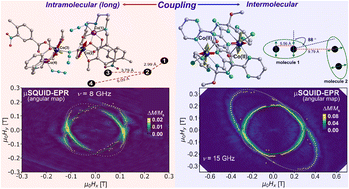
|
Magnetic molecules have been proposed as scaffolds for novel quantum technologies, ranging from quantum sensing and quantum memory to multilevel quantum bits (qudits) and fault-tolerant quantum computation. Integration of magnetic molecules into cutting-edge applications hinges on a deep understanding and tunability of their spin states. To date, the strategic manipulation of the local environment of the ion and careful selection of the magnetic core have enabled the desired tunability and scalability of the spin states. For such goals, however, extracting the anisotropic parameters that dictate the characteristics of the Spin Hamiltonian is challenging, especially for molecules consisting of multiple magnetic cores. We address these challenges by studying two cobalt(II) dinuclear systems, complicated by inherent spinâorbit coupling. We explore the magnetic properties of these systems in two temperature regimes: (i) at sub-Kelvin temperatures employing single crystals at 30 mK using a unique ÎŒSQUID-EPR technique that examines the microwave absorption peaks in the magnetisation data and their variation with field angle and frequency; and (ii) in bulk employing convectional SQUID magnetometry above 2 K i.e., ÏMT(T) and M(H). Unexpectedly, sub-Kelvin temperature investigations reveal a negligible interaction, whereas the SQUID data reveal a much stronger interaction between the Co(II) ions. An understanding of these data is developed based on a strong coupling model and the coupling of two moieties with a spin-effective ground state. |
Sagar Paul, Malay Dolai, Juli
Nanda Goswami, Biswajit Bhattacharya, Franziska Emmerling,
Michael G. B. Drew, Shouvik Chattopadhyay, Rabi Sankar Sarkar, Appu Sunil, Ghenadie Novitchi,
Eufemio Moreno-Pineda, Wolfgang
Wernsdorfer,
From strong to weak interaction: reconciling SQUID and ÎŒSQUID-EPR data in anomalous Co(ii) dimers,
Inorg. Chem. Front., 2025,12, 6460-6472
Ultraslow Relaxation of Toroidal State in Ferrotoroidal Dysprosium Complex

|
Molecular systems are emerging candidates for quantum information science (QIS) due to their unique quantum behaviors and structural tunability, opening avenues for next-generation quantum technologies. While molecular nanomagnets (MNMs) have emerged as promising spin-based qubit candidates, achieving long coherence times and feasible readouts remains challenging. Among molecular nanomagnets, single-molecule toroics (SMTs) stand out as a particularly promising class, offering magnetically silent ground states, along with the unique ability to modulate their intrinsic chirality. Realizing toroidal states in molecular systems remains a significant hurdle, with the design and stabilization of ferrotoroidal (FT) moments posing an even greater level of complexity. Moreover, the anticipated slow relaxation of toroidal states has not been explicitly demonstrated, limiting their viability in molecular quantum devices. In this work, we report a tridecanuclear [Ga7Dy6(N-mdea)6(ClCH2COO)6(NO3)6(OH)12(H2O)6]·3Cl (1) complex, which exhibits an FT ground state. Remarkably, this complex shows slow relaxation of the toroidal states, experimentally observed for the first time, with a quantum tunneling of magnetization (QTM) relaxation time of âŒ3.5 Ă 108 s (âŒ11 years), far surpassing the relaxation times reported for state-of-the-art Dy(III) based single-molecule magnets. The robust FT ground state in complex 1 is unequivocally established by ÎŒSQUID and corroborated by ab initio calculations, marking a major advance in the field of SMTs. This ultraslow relaxation, arising from quenched many-body tunneling processes, lays the foundation for integrating toroidal states into quantum technologies and offers a new design paradigm for molecular complexes in QIS. |
Deepanshu Chauhan, Sagar Paul, Dipanti Borah, Appu Sunil, Wolfgang
Wernsdorfer, Maheswaran Shanmugam, Gopalan Rajaraman,
Ultraslow Relaxation of Toroidal State in Ferrotoroidal Dysprosium Complex,
J. Am. Chem. Soc. 2025
Chemical tuning of quantum spinâelectric coupling in molecular magnets

|
Controlling quantum spins using electric rather than magnetic fields promises substantial architectural advantages for developing quantum technologies. In this context, spins in molecular magnets offer tunability of spinâelectric couplings (SECs) by rational chemical design. Here we demonstrate systematic control of SECs in a family of Mn(II)-containing molecules by varying the coordination environment of the spin centre. The trigonal bipyramidal (tbp) molecular structure with C3 symmetry leads to a substantial molecular electric dipole moment that is directly connected to its magnetic anisotropy. The interplay between these two features gives rise to experimentally observed SECs, which can be rationalized by wavefunction theoretical calculations. Our findings guide strategies for the development of electrically controllable molecular spin qubits for quantum technologies. |
Mikhail V. Vaganov, Nicolas Suaud, François Lambert, Benjamin
Cahier, Christian Herrero, RĂ©gis Guillot, Anne-Laure Barra,
Nathalie Guihéry, Talal Mallah, Arzhang Ardavan, Junjie Liu,
Chemical tuning of quantum spinâelectric coupling in molecular magnets,
Nature Chemistry (2025) in print
Spin-Electric Effect on a Chiral Dysprosium Complex
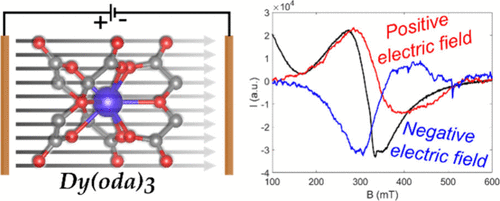
|
The Spin-Electric Effect (SEE) on moleculesâthe influence of external electric fields on molecular spin statesâoffers a compelling route toward low-power molecule-based spintronic applications. However, SEE remains elusive in molecular systems due to typically weak spinâelectric field coupling. In this study, we observe a relevant SEE in a mononuclear lanthanide complex using Electric Field Modulated Electron Paramagnetic Resonance spectroscopy. We reveal a marked anisotropy of the SEE, evidencing that the most perturbed g tensor component is the one perpendicular to the electric field, providing hints for the most convenient experimental configuration to tune ad hoc spin transitions. Ab initio calculations in synergy with the experimental results revealed that molecular symmetry breaking plays a fundamental role. We also point out the crystal field parameters that are most strongly modulated by the presence of an electric field. These parameters are all off-diagonal, indicating effective electric-field-mediated state mixing. |
Leonardo Tacconi, Alberto Cini, Arsen Raza, Lorenzo Tesi, Paolo
Bartolini, Andrea Taschin, Joris van Slageren, Matteo Briganti, Lorenzo
Sorace, Maria Fittipaldi, Mauro Perfetti,
Spin-Electric Effect on a Chiral Dysprosium Complex,
JACS (2025) in print
Electric control of magnetic exchange in a molecular spin triangle

|
Spin-electric effects are crucial for quantum technologies, offering several advantages over standard magnetic field-based spin control. Seeking a mechanism independent of spin-orbit interaction, here we report the detection of a spin-electric effect in the [Cu3(saltag)(py)6]ClO4 spin triangle. The effect is investigated by electron paramagnetic resonance under electric field modulation on single crystals. The anisotropy of the magnetic response to the electric field is addressed, and comprehensive ab initio calculations are performed to elucidate its origin. We demonstrate that when the electric field is applied in the plane of the triangle, the dominant contribution to the observed spin-electric signal arises from a variation of the isotropic exchange interaction. Our combined theoretical and experimental approach demonstrates that, in our system, there is no evidence of antisymmetric exchange (Dzyaloshinskii-Moriya) interaction, confirming that electric-field control of magnetic exchange is achievable in the absence of significant spinâorbit coupling. Moreover, we underscore the crucial role of the bridging ligand, which opens new avenues for chemically optimizing spinâelectric coupling. |
Alberto Cini, Michael Böhme, Benjamin Kintzel, Mauro Perfetti,
Winfried Plass, Roberta Sessoli, Maria Fittipaldi,
Electric control of magnetic exchange in a molecular spin triangle,
Nat. Commun. 16 (2025) 6564
Magnetic Hysteresis in a Dysprosium Bis(amide) Complex
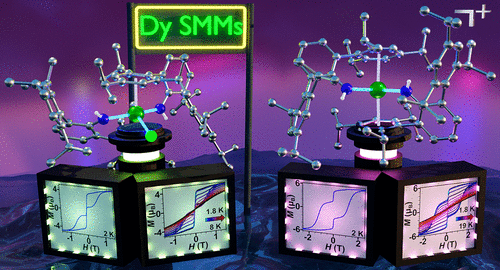
|
The authors present the synthesis and characterization of two mononuclear dysprosium molecules. The first complex is neutral and contains two triarylamide ligands coordinating to a DyIII ion that is additionally ligated to a chloride anion, in the form of (NHAr*)2DyCl (1). Treatment of 1 with Tl[BArF24] prompted the removal of the chloride as TlCl from the first coordination sphere to afford the mononuclear DyIII complex, [(NHAr*)2Dy][BArF24] (2), with a cationic [(NHAr*)2Dy]+ core. 1 and 2 were investigated through single-crystal X-ray diffraction analysis, UV-vis spectroscopy, and SQUID magnetometry. Both compounds are single-molecule magnets with magnetic hysteresis. The determined effective spin-reversal barriers and preattempt times for 1 and 2 are Ueff = 601(2) cmâ1 and 598(2) cmâ1, and Ï0 = 4.2(1) Ă 10â10 s and 3.1(2) Ă 10â10 s, respectively. Ab initio calculations were conducted on both molecules which uncovered the energy of the crystal field states of DyIII and affirmed the effective energy barrier height. Notably, the extrusion of the halide ion has huge ramifications on the magnetic relaxation: While 1 features butterfly hysteresis loops up to 8 K that are closed at zero field at all temperatures probed, 2 exhibits a much higher magnetic blocking temperature of TB = 19.0 K and substantial coercivity of HC = 1.03 T. Remarkably, both the TB and HC observed for 2 constitute a record for mononuclear single-molecule magnets where the metal is either sandwiched by two arene ligands or stabilized by amide functionalities, respectively. |
Florian Benner, Rashmi Jena, Aaron L. Odom, Selvan Demir,
Magnetic Hysteresis in a Dysprosium Bis(amide) Complex,
J. Am. Chem. Soc. 2025, 147, 10, 8156â8167
Making qubits from magnetic molecules
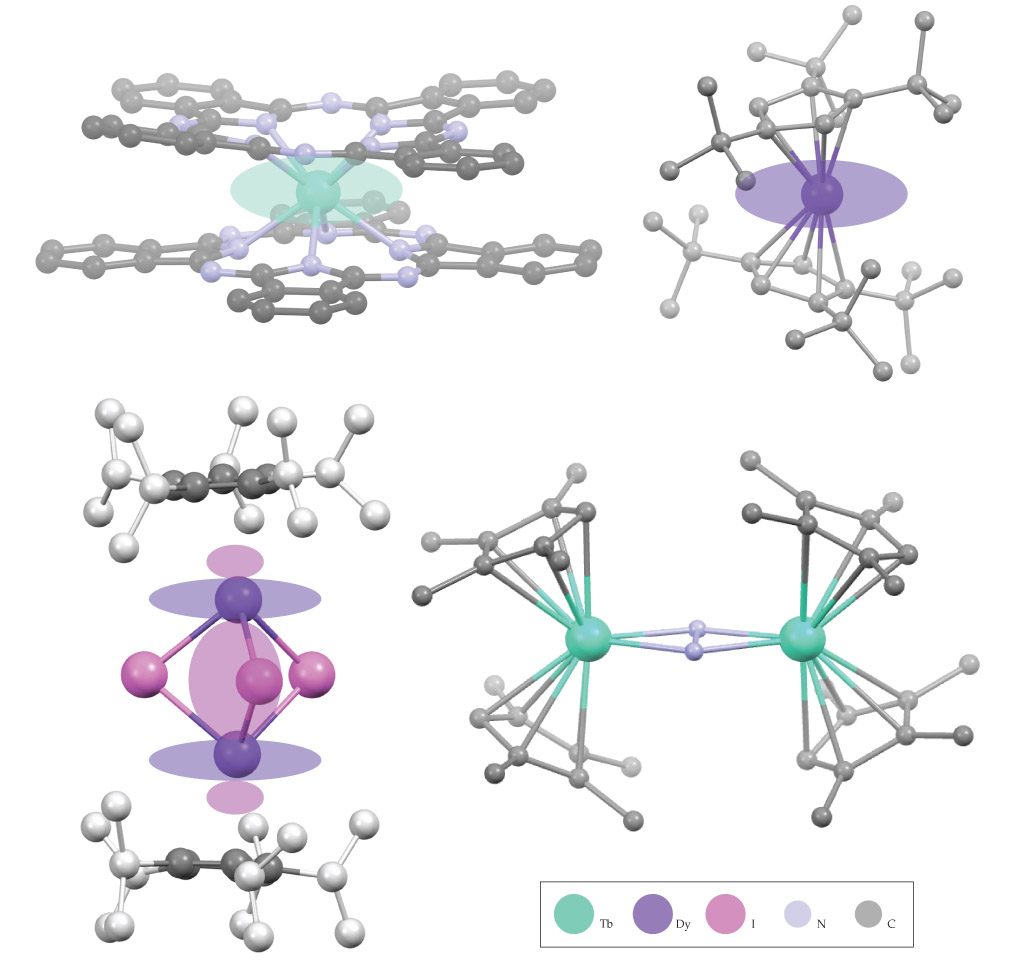
|
Bottom-up synthesis of such molecules provides physicists with a rich playground to study newly discovered quantum effects and a means to store information at the scale of individual atoms. |
Stephen Hill,
Making qubits from magnetic molecules,
Physics Today 2025
Dinuclear Dysprosium Compounds: The Importance of Rigid Bridges
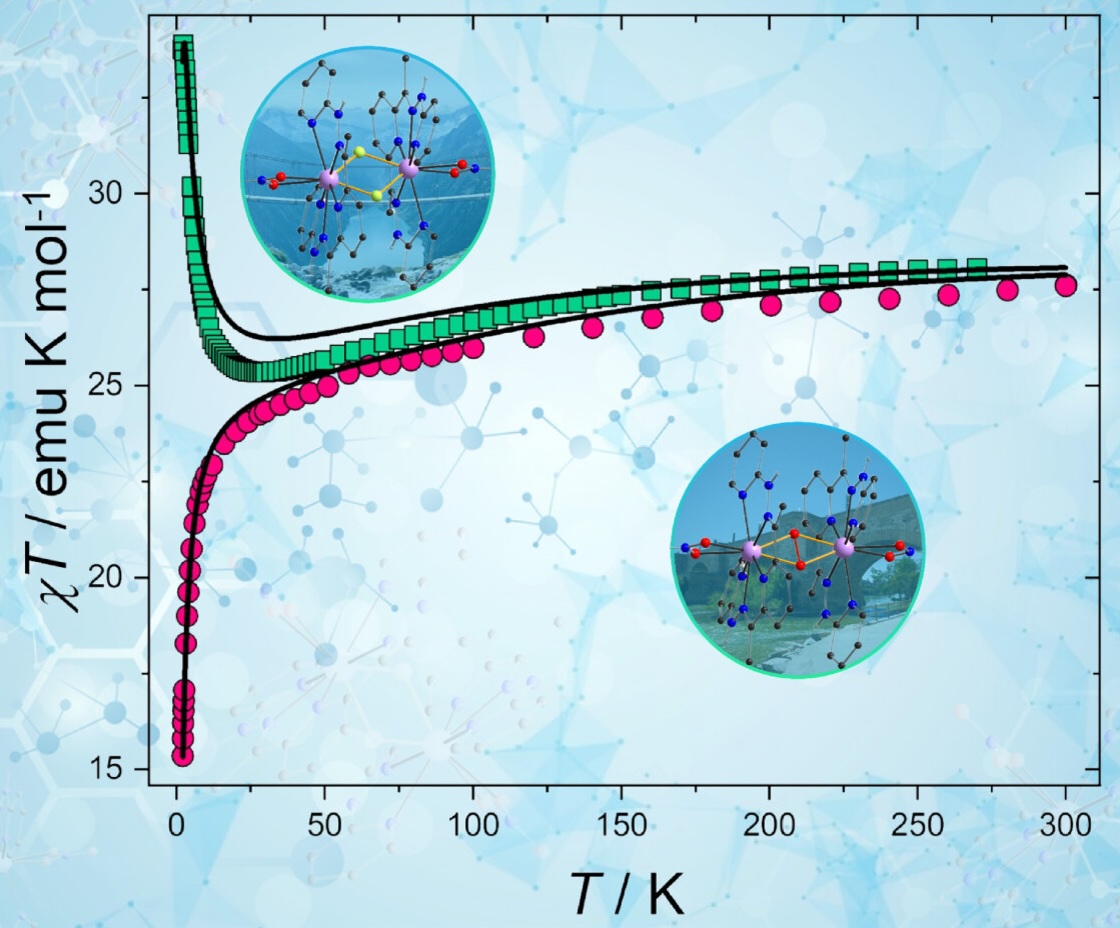
|
The authors report the synthesis, structures and magnetic behaviour of two isostructural dinuclear Dy3+ complexes where the metal ions of a previously reported monomeric building block are connected by a peroxide (O22â) or a pair of fluoride (2ĂFâ) bridges. The nature of the bridge determines the distance between the metal ion dipoles leading to a dipolar coupling in the peroxido bridged compound of only ca. 70â% of that in the bis-fluorido bridged dimer. The sign of the overall coupling between the metals is antiferromagnetic for the peroxido bridged compound and ferromagnetic for the bis-fluorido bridged complex. This in turn influences the magnetisation dynamics. We compare the relaxation characteristics of the dimers with those of the previously reported monomeric building block. The relaxation dynamics for the bis-fluorido system are very fast. On the other hand, comparing the properties of the monomer, the peroxido bridged sample and the corresponding Y-doped sample show that the relaxation properties via a Raman process have very similar parameters. We show that a second dysprosium is important for either tuning or detuning the Single Molecule Magnet (SMM) properties of a system. |
Rouven F. Pfleger, Matteo Briganti, Niels Bonde, Jacques
Ollivier, Jonas Braun, Thomas Bergfeldt, Stergios Piligkos,
Thomas Ruppert, Christopher E. Anson, Mauro Perfetti, Jesper
Bendix, Annie K. Powell,
Dinuclear Dysprosium Compounds: The Importance of Rigid Bridges,
Chem. Eur. J. 2025, 31, e202403002
Alberto Privitera, Alessandro Chiesa, Fabio Santanni, Angelo Carella, Davide Ranieri, Andrea Caneschi, Matthew D. Krzyaniak, Ryan M. Young, Michael R. Wasielewski, Stefano Carretta, Roberta Sessoli,
J. Am. Chem. Soc. 2025, 147, 1, 331â341
https://doi.org/10.1021/jacs.4c10632
Medeina SteponaviÄiĆ«tÄ, Debashis Majee, Bisheng Zhao, Liviu Ungur, Stanislav Presolski,
Ang. Chem. Int. Ed. 2025 https://doi.org/10.1002/anie.202422549
Florian le MardelĂ©, Ivan MohelskĂœ, Jan Wyzula, Milan Orlita, Philippe Turek, Filippo Troiani & Athanassios K. Boudalis,
Nature Communications volume 16, Article number: 1198 (2025)
https://doi.org/10.1038/s41467-025-56453-1
Jonas Braun, Annie K. Powell, Andreas-Neil Unterreiner,
Chem. Eur. J. 2024, 30, e202400977
https://doi.org/10.1002/chem.202400977
Yanhong Wang, Yaling Dou, Prof. Hiroshi Takastu, Prof. Tao Wang, Prof. Hyun-Joo Koo, Prof. Myung-Hwan Whangbo, Prof. Hiroshi Kageyama, Prof. Hongcheng Lu,
Angew. Chem. Int. Ed. 2025, 64, e202415700
https://doi.org/10.1002/anie.202415700
Alberto Privitera, Alessandro Chiesa, Fabio Santanni, Angelo Carella, Davide Ranieri, Andrea Caneschi, Matthew D. Krzyaniak, Ryan M. Young,Michael R. Wasielewski,Stefano Carretta, Roberta Sessoli,
Journal of the American Chemical Society 2025 147 (1), 331-341
DOI: 10.1021/jacs.4c10632
Matteo Mezzadri, Luca Lepori, Alessandro Chiesa and Stefano Carretta,
Quantum Science and Technology, Volume 10, Number 1
DOI 10.1088/2058-9565/ad985e
M. Chizzini,F. Tacchino, A. Chiesa, I. Tavernelli, S. Carretta, P. Santini,
Phys. Rev. A 110, 062602
DOI: https://doi.org/10.1103/PhysRevA.110.062602
Relation between Electrostatic Charge Density and Spin Hamiltonian Models of Ligand Field in Lanthanide Complexes
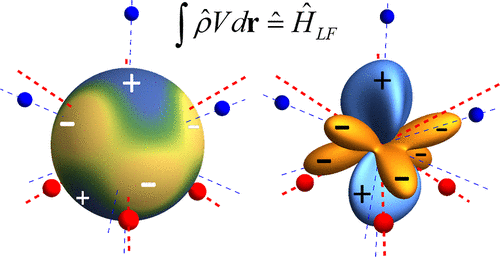
|
Understanding the ligand field interactions in lanthanide-containing magnetic molecular complexes is of paramount importance for understanding their magnetic properties, and simple models for rationalizing their effects are much desired. In this work, the equivalence between electrostatic models, which derive their results from calculating the electrostatic interaction energy of the charge density of the 4f electrons in an electrostatic potential representing the ligands, and the common quantum mechanical effective spin Hamiltonian in the space of the ground J multiplet is formulated in detail. This enables the construction of an electrostatic potential for any given ligand field Hamiltonian and discusses the effects of the ligand field interactions in terms of an interaction of a generalized 4f charge density with the electrostatic potential. Such models often allow for an easier rationalization of the ligand field interactions, and it can be hoped that the results in this work will help us to better understand the effects of ligand field in lanthanide complexes. |
Oliver Waldmann,
Relation between Electrostatic Charge Density and Spin Hamiltonian Models of Ligand Field in Lanthanide Complexes,
Inorg. Chem. 2025
Wantong Huang, Paul Greule, MĂĄtĂ© Stark, Joris van Slageren, Christoph SĂŒrgers, Wolfgang Wernsdorfer, Giorgio Sangiovanni, Christoph Wolf, and Philip Willke,
ACS Nano 2025 19 (1), 1190-1197
DOI: 10.1021/acsnano.4c13172
V. Thangaraj, D. Sartini, D. Borah, D. Chauhan, V. Sharma, L. Sorace, G. Rajaraman, M. Perfetti, M. Shanmugam,
Adv. Sci. 2024, 2415624
https://doi.org/10.1002/advs.202415624
Subhajit Sarkar and Yonatan Dubi,
ACS Nano 2024 18 (41), 27988-27996,
DOI: 10.1021/acsnano.4c05817
E. Moreno-Pineda, W. Wernsdorfer,
Adv Quantum Technol. 2024, 2300367
https://doi.org/10.1002/qute.202300367
Juan BartolomĂ©, Elena BartolomĂ©, Fernando Luis, Enrique BurzurĂ, Agustin CamĂłn, George Filoti, Ayuk M. Ako, Jonas Braun, Valeriu Mereacre, Christopher E. Anson, and Annie K. Powell
Inorganic Chemistry 2024 63 (51), 24262-24273
DOI: 10.1021/acs.inorgchem.4c04191
Kieran Hymas, Alessandro Soncini, Kuduva R. Vignesh, Deepanshu Chauhan, Abinash Swain, Sophie L. Benjamin, Dipanti Borah, Maheswaran Shanmugam, Wolfgang Wernsdorfer, Gopalan Rajaraman, Stuart K. Langley & Keith S. Murray,
npj Quantum Mater. 9, 106 (2024)
https://doi.org/10.1038/s41535-024-00712-9
Lorenzo A. Mariano, Sourav Mondal, Alessandro Lunghi,
Journal of Chemical Theory and Computation 2024 20 (1), 323-332,
DOI: 10.1021/acs.jctc.3c01130
Krishnendu Kundu, Jia Chen, Silas Hoffman, Jonathan Marbey, Dorsa Komijani, Yan Duan, Alejandro Gaita-Ariño, John Stanton, Xiaoguang Zhang, Hai-Ping Cheng, Stephen Hill,
Commun Phys 6, 38 (2023)
https://doi.org/10.1038/s42005-023-01152-w
Isolation of Elusive Fluoflavine Radicals in Two Differing Oxidation States
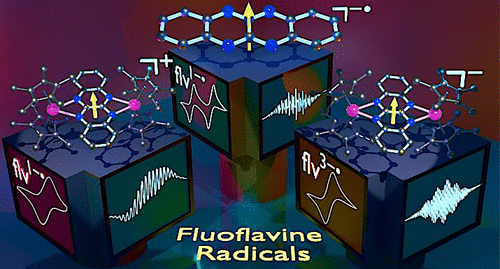
|
Facile access and switchability between multiple oxidation states are key properties of many catalytic applications and spintronic devices yet poorly understood due to inherent complications arising from isolating a redox system in multiple oxidation states without drastic structural changes. Here, the authors present the first isolable, free fluoflavine (flv) radical flv( 1ââą ) as a bottleable potassium compound, [K(crypt-222)](flv âą ), 1 2 Y) , and a new series of organometallic rare earth complexes [(Cp* 2 (ÎŒ-flv z )]X, (where Cp* = pentamethylcyclopentadienyl, X = [Al(OC{CF 3 } 3 ) 4 ] â (z = â1), 2 ; X = 0 (z = â2), 3 ; [K(crypt-222)] (z = â3), + 4 ) comprising the flv ligand in three different oxidation states, two of which are paramagnetic flv 1ââą and flv 3ââą . Excitingly, 1 , 2 , and 4 constitute the first isolable flv 1ââą and flv 3ââą radical complexes and, to date, the only isolated flv radicals of any oxidation state. All compounds are accessible in good crystalline yields and were unambiguously characterized via single-crystal X-ray diffraction analysis, cyclic voltammetry, IR-, UVâvis, and variable-temperature EPR spectroscopy. Remarkably, the EPR spectra for 1 , 2 , and 4 are distinct and a testament to stronger spin delocalization onto the metal centers as a function of higher charge on the flv radical. In-depth analysis of the electron- and spin density via density functional theory (DFT) calculations utilizing NLMO, QTAIM, and spin density topology analysis confirmed the fundamental interplay of metal coordination, ligand oxidation state, aromaticity, covalency, and spin density transfer, which may serve as blueprints for the development of future spintronic devices, single-molecule magnets, and quantum information science at large. |
Florian Benner, Selvan Demir,
Isolation of Elusive Fluoflavine Radicals in Two Differing Oxidation States,
J. Am. Chem. Soc. 2024, 146, 38, 26008â26023
Optical Readout of Single-Molecule Magnets Magnetic Memories with Unpolarized Light
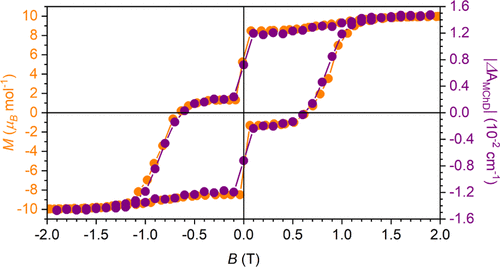
|
Magnetic materials are widely used for many technologies in energy, health, transportation, computation, and data storage. For the latter, the readout of the magnetic state of a medium is crucial. Optical readout based on the magneto-optical Faraday effect was commercialized but soon abandoned because of the need for a complex circular polarization-sensitive readout. Combining chirality with magnetism can remove this obstacle, as chiral magnetic materials exhibit magneto-chiral dichroism, a differential absorption of unpolarized light dependent on their magnetic state. Molecular chemistry allows the rational introduction of chirality into single-molecule magnets (SMMs), ultimate nanoobjects capable of retaining magnetization. Here, we report the first experimental demonstration of optical detection of the magnetic state of an SMM using unpolarized light on a novel air-stable Dy-based chiral SMM featuring a strong single-ion magnetic anisotropy. These findings might represent a paradigm shift in the field of optical data readout technologies. |
Maria Sara Raju, Kevin Paillot, Ivan Breslavetz, Ghenadie
Novitchi, Geert L.J.A. Rikken, Cyrille Train, Matteo Atzori,
Optical Readout of Single-Molecule Magnets Magnetic Memories with Unpolarized Light,
J. Am. Chem. Soc. 2024, 146, 33, 23616â23624
Fault-tolerant computing with single-qudit encoding in a molecular spin
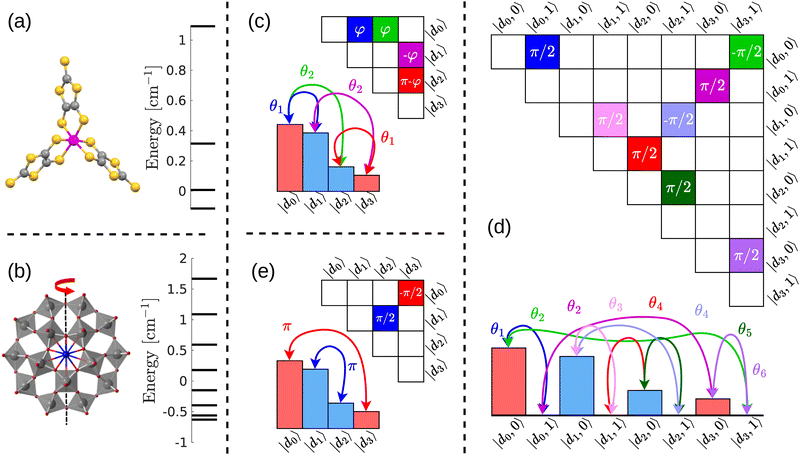
|
We show that molecular spins represent ideal materials to realize a fault-tolerant quantum computer, in which all quantum operations include protection against leading (dephasing) errors. This is achieved by pursuing a qudit approach, in which logical error-corrected qubits are encoded in a single multi-level molecule (a qudit) and not in a large collection of two-level systems, as in standard codes. By preventing such an explosion of resources, this emerging way of thinking about quantum error correction makes its actual implementation using molecular spins much closer. We show how to perform all quantum computing operations (logical gates, corrections and measurements) without propagating errors. We achieve a quasi-exponential error correction with only linear qudit size growth, i.e. a higher efficiency than the standard approach based on stabilizer codes and concatenation. |
Matteo Mezzadri, Alessandro Chiesa,
Luca Lepori, Stefano Carretta,
Fault-tolerant computing with single-qudit encoding in a molecular spin,
Mater. Horiz., 2024, Advance Article
Ab Initio Design of Molecular Qubits with Electric Field Control
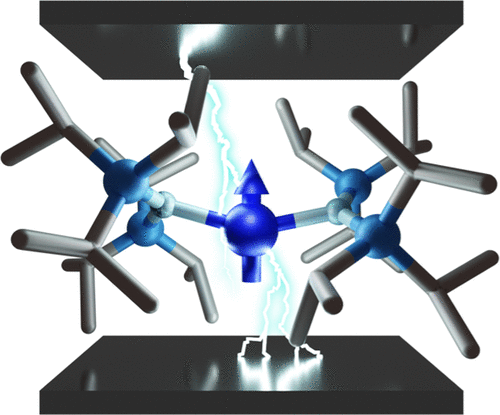
|
Current scalable quantum computers require large footprints and complex interconnections due to the design of superconducting qubits. While this architecture is competitive, molecular qubits offer a promising alternative due to their atomic scale and tuneable properties through chemical design. The use of electric fields to precisely, selectively and coherently manipulate molecular spins with resonant pulses has the potential to solve the experimental limitations of current molecular spin manipulation techniques such as electron paramagnetic resonance (EPR) spectroscopy. EPR can only address a macroscopic ensemble of molecules, defeating the inherent benefits of molecule-based quantum information. Hence, numerous experiments have been performed using EPR in combination with electric fields to demonstrate coherent spin manipulation. In this work, we explore the underlying theory of spin-electric coupling in lanthanide molecules, and outline ab initio methods to design molecules with enhanced electric field responses. We show how structural distortions arising from electric fields generate coupling elements in the crystal field Hamiltonian within a Kramers doublet ground state and demonstrate the impact of molecular geometry on this phenomenon. We use perturbation theory to rationalize the magnetic and electric field orientation dependence of the spin-electric coupling. We use pseudo-symmetry point groups to decompose molecular distortions to understand the role that symmetry has on spin-electric coupling. Finally, we present an analytical electric field model of structural perturbations that provides large savings in computational expense and allows for the investigation of experimentally accessible electric field magnitudes which cannot be accessed using common ab initio methods. |
William T. Morrillo, Herbert I. J. Cumming, Andrea Mattioni, Jakob
K. Staab, Nicholas F. Chilton,
Ab Initio Design of Molecular Qubits with Electric Field Control,
JACS (2024) early view
Stellated cuboctahedron of FeIII

|
A stellated cuboctahedron of FeIII ions can be constructed using p-tert-butylcalix[4]arene (H4TBC[4]) under solvothermal reaction conditions. The topological arrangement of the metal ions leads to significant spin frustration arising from the high symmetry. A crossover between inverse and direct magnetocaloric effects is observed at 10â K for applied-field changes lower than 3 T. |
Lucinda R. B. Wilson,
Angelos B. Canaj,
Daniel J. Cutler,
Laura J. McCormick McPherson,
Simon J. Coles,
Hiroyuki Nojiri,
Marco Evangelisti,
Jürgen Schnack,
Scott J. Dalgarno,
Euan K. Brechin,
Stellated cuboctahedron of FeIII,
Angew. Chem. Int. Ed. 63, 2024, e202405666
Themed collection: Recent progress and perspectives on spin transition compounds

|
The passing of Prof. Philipp Gütlich in September 2022, which is a great loss to the community of spin transition, has urged us to review the current status and development of this field. It was realized that, in many cases, the concept of spin transition is considered of secondary importance within the topics of molecule-based materials and molecular magnetism. Studies of spin transition, especially from the next generation of scientists, have yet to receive the attention they are due. These facts motivated us to produce this special issue which focuses on research of spin transition phenomena in a broad sense, including spin-crossover (SCO), valence tautomerism (VT), electron transfer (ET) and any other related topics. This themed collection showcases the recent progress and new viewpoints of spin transition materials from the perspective of compound synthesis, physical properties, and applications. |
Themed collection:
Recent progress and perspectives on spin transition compounds,
Dalton Trans., 2024,53, 10036-10036
Thermal processes in anisotropic metal complexes induced by non-adiabatic switching of magnetic field
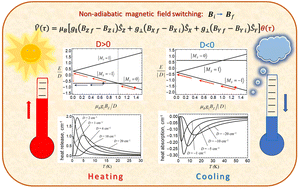
|
In this article the authors analyze the thermal processes in magnetically anisotropic metal complexes under the action of non-adiabatic switching of the magnetic field. Using the non-stationary perturbation theory for the case of sudden perturbation, they show that this field can cause not only heat release, but also heat absorption, interconnected with the axial zero field splitting in a paramagnetic metal complex. As an illustrative example the authors consider the simplest S = 1-complexes having âeasy axisâ and âeasy planeâ types of anisotropy influenced by the magnetic field that is suddenly turned off. They demonstrate that the character of the thermal processes (heat dissipation or absorption) depends on the sign of D and direction of applied field, and so the analysis of these processes can be in principle used as a complementary tool (in addition to SQIUD magnetometry, EPR spectroscopy and INS) for studying magnetic anisotropy. The conditions under which the non-adiabatic switching of the magnetic field gives rise to the heat absorption are revealed. This unusual phenomenon, which can be called ânonadiabatic field switching coolingâ, may have practical applications. |
Andrew Palii and Boris Tsukerblat
Thermal processes in anisotropic metal complexes induced by non-adiabatic switching of magnetic field,
Dalton Trans., 2024, Advance Article
Engineering Clock Transitions in Molecular Lanthanide Complexes
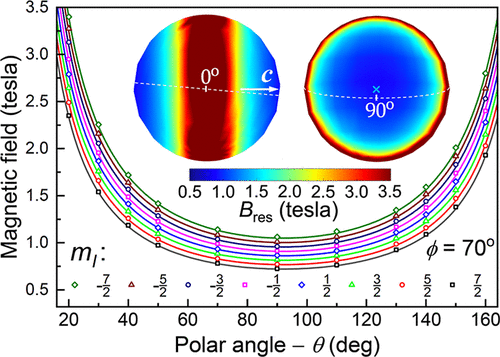
|
Molecular lanthanide (Ln) complexes are promising candidates for the development of next-generation quantum technologies. High-symmetry structures incorporating integer spin Ln ions can give rise to well-isolated crystal field quasi-doublet ground states, i.e., quantum two-level systems that may serve as the basis for magnetic qubits. Recent work has shown that symmetry lowering of the coordination environment around the Ln ion can produce an avoided crossing or clock transition within the ground doublet, leading to significantly enhanced coherence. Here, we employ single-crystal high-frequency electron paramagnetic resonance spectroscopy and high-level ab initio calculations to carry out a detailed investigation of the nine-coordinate complexes, [Ho III L 1 L 2 ], where L 1 = 1,4,7,10-tetrakis(2-pyridylmethyl)-1,4,7,10-tetraaza-cyclododecane and L 2 = F â ( 1 ) or [MeCN] 0 ( 2 ). The pseudo-4-fold symmetry imposed by the neutral organic ligand scaffold (L 1 ) and the apical anionic fluoride ion generates a strong axial anisotropy with an m J = ±8 ground-state quasi-doublet in 1 , where m J denotes the projection of the J = 8 spinâorbital moment onto the ⌠C 4 axis. Meanwhile, off-diagonal crystal field interactions give rise to a giant 116.4 ± 1.0 GHz clock transition within this doublet. We then demonstrate targeted crystal field engineering of the clock transition by replacing F â with neutral MeCN ( 2 ), resulting in an increase in the clock transition frequency by a factor of 2.2. The experimental results are in broad agreement with quantum chemical calculations. This tunability is highly desirable because decoherence caused by second-order sensitivity to magnetic noise scales inversely with the clock transition frequency. |
Robert Stewart, Angelos B. Canaj, Shuanglong Liu, Emma RegincĂłs
MartĂ, Anna Celmina, Gary Nichol, Hai-Ping Cheng, Mark Murrie,
and Stephen Hill,
Engineering Clock Transitions in Molecular Lanthanide Complexes,
JACS 2024
Systematic determination of coupling constants in spin clusters from broken-symmetry mean-field solutions
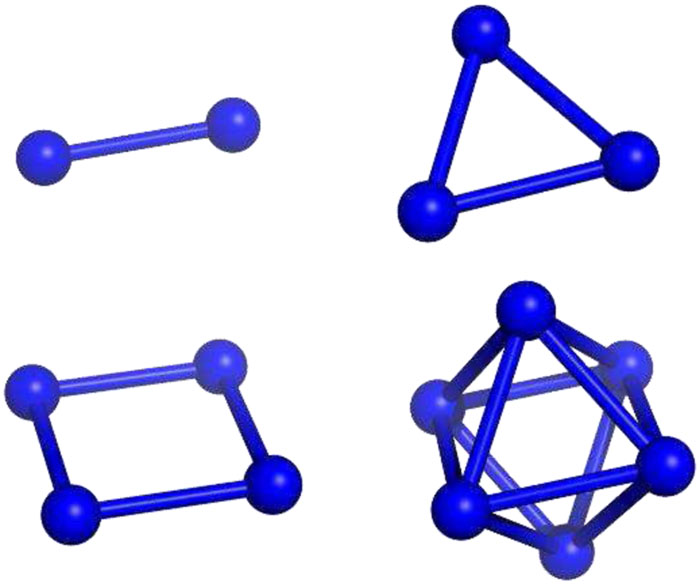
|
Quantum-chemical calculations aimed at deriving magnetic coupling constants in exchange-coupled spin clusters commonly utilize a broken-symmetry (BS) approach. This involves calculating several distinct collinear spin configurations, predominantly by density-functional theory. The energies of these configurations are interpreted in terms of the Heisenberg model to determine coupling constants for spin pairs. However, this energy-based procedure has inherent limitations, primarily in its inability to provide information on isotropic spin interactions beyond those included in the Heisenberg model. Biquadratic exchange or multi-center terms, for example, are usually inaccessible and hence assumed to be negligible. The present work introduces a novel approach employing BS mean-field solutions, specifically HartreeâFock wave functions, for the construction of effective spin Hamiltonians. This expanded method facilitates the extraction of a broader range of coupling parameters by considering not only the energies, but also Hamiltonian and overlap elements between different BS states. The author demonstrates how comprehensive Hamiltonians, including multi-center terms, can be straightforwardly constructed from a complete set of BS solutions. The approach is exemplified for small clusters within the context of the half-filled single-band Hubbard model. This allows to contrast the current strategy against exact results, thereby offering an enriched understanding of the spin-Hamiltonian construction from BS solutions. |
Shadan Ghassemi Tabrizi,
Systematic determination of coupling constants in spin clusters from broken-symmetry mean-field solutions,
J. Chem. Phys. 159, 154106 (2023)
Molecular nanomagnets: a viable path toward quantum information processing?
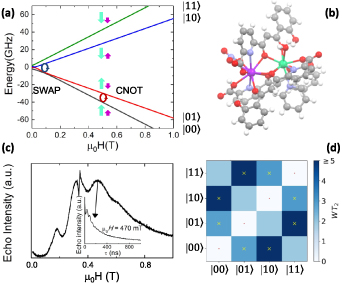
|
Molecular nanomagnets (MNMs), molecules containing interacting spins, have been a playground for quantum mechanics. They are characterized by many accessible low-energy levels that can be exploited to store and process quantum information. This naturally opens the possibility of using them as qudits, thus enlarging the tools of quantum logic with respect to qubit-based architectures. These additional degrees of freedom recently prompted the proposal for encoding qubits with embedded quantum error correction (QEC) in single molecules. QEC is the holy grail of quantum computing and this qudit approach could circumvent the large overhead of physical qubits typical of standard multi-qubit codes. Another important strength of the molecular approach is the extremely high degree of control achieved in preparing complex supramolecular structures where individual qudits are linked preserving their individual properties and coherence. This is particularly relevant for building quantum simulators, controllable systems able to mimic the dynamics of other quantum objects. The use of MNMs for quantum information processing is a rapidly evolving field which still requires to be fully experimentally explored. The key issues to be settled are related to scaling up the number of qudits/qubits and their individual addressing. Several promising possibilities are being intensively explored, ranging from the use of single-molecule transistors or superconducting devices to optical readout techniques. Moreover, new tools from chemistry could be also at hand, like the chiral-induced spin selectivity. In this paper, the authors review the present status of this interdisciplinary research field, discuss the open challenges and envisioned solution paths which could finally unleash the very large potential of molecular spins for quantum technologies. |
A Chiesa, P Santini, E Garlatti, F Luis, S Carretta,
Molecular nanomagnets: a viable path toward quantum information processing?,
2024 Rep. Prog. Phys. 87 034501
How to Cross an Energy Barrier at Zero Kelvin without Tunneling Effect
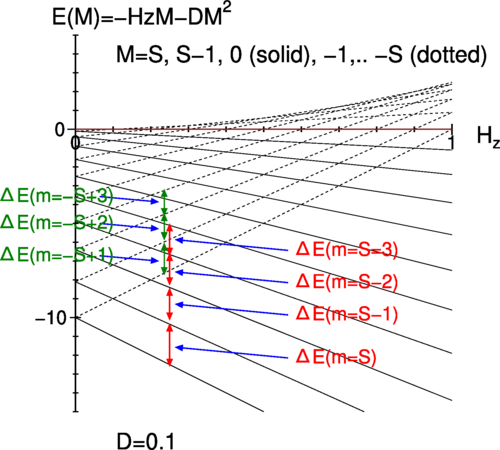
|
This Letter deals with the broad class of magnetic systems having a single or collective spin S with an energy barrier, such as rare-earth elements and their compounds, single molecule magnets with uniaxial anisotropy, and more generally any other anisotropic quantum system made of single or multiple objects with discrete energy levels. Till now, the reversal of the magnetization of such systems at zero kelvin required making use of quantum tunneling with a significant transverse field or transverse anisotropy term, at resonance. Here, the authors show that another very simple method exists. It simply consists in the application of a particular sequence of electromagnetic radiations in the ranges of optical or microwave frequencies, depending on the characteristics of the system (spin and anisotropy values for magnetic systems). This produces oscillations of the Rabi type that pass above the barrier, thus extending these oscillations between the two energy wells with mixtures of all the (2S+1) states. In addition to its basic character, this approach opens up new directions of research in quantum information with possible breakthroughs in the current use of multiple quantum bits. |
Seiji Miyashita and Bernard Barbara,
How to Cross an Energy Barrier at Zero Kelvin without Tunneling Effect,
Phys. Rev. Lett. 131, 066701 (2023)
A Special Issue of Applied Magnetic Resonance in Honor of Professor Takeji Takui on the Occasion of his 80th Birthday

|
This special issue of Applied Magnetic Resonance is dedicated to Takeji Takui, Emeritus Professor of Osaka City University in Japan (currently Osaka Metropolitan University, established in 2022 by merging with Osaka Prefecture University), who celebrated his 80th birthday on October 19th, 2022. |
Kazunobu Sato, Elena Bagryanskaya, Marco Affronte, Stephen
Hill,
A Special Issue of Applied Magnetic Resonance in Honor of Professor Takeji Takui on the Occasion of his 80th Birthday,
Appl. Magn. Reson. 54, 1â6 (2023)
A nested spin structure and single molecule magnet behaviour in an Fe8Dy12 heterometallic cyclic coordination cluster
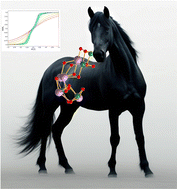
|
The 20-nuclearity compound [Fe8Dy12(tea)8(teaH)12(NO3)12]·8MeCN (where teaH3 = triethanolamine) was synthesised and characterised through single crystal X-ray diffraction and magnetic measurements. The shape of the magnetic hysteresis in the microSQUID measurements was rationalised using the MAGELLAN program. |
Yan Peng, Jonas Braun, Michael Schulze, Hagen Kaemmerer,
Yannik F. Schneider, Christopher E. Anson, Wolfgang Wernsdorfer, Annie
K. Powell,
A nested spin structure and single molecule magnet behaviour in an Fe8Dy12 heterometallic cyclic coordination cluster,
Dalton Trans., 2024,53, 894-897
Vibronic effects on the quantum tunnelling of magnetisation in Kramers single-molecule magnets
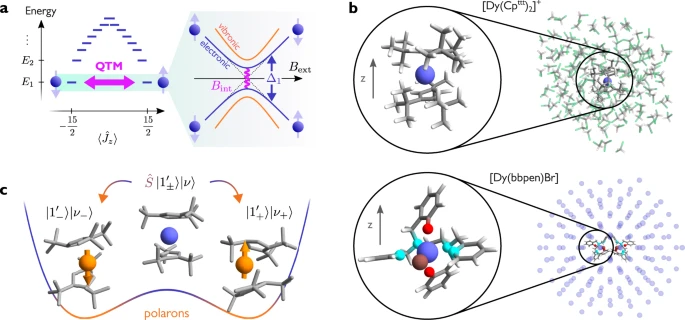
|
Single-molecule magnets are among the most promising platforms for achieving molecular-scale data storage and processing. Their magnetisation dynamics are determined by the interplay between electronic and vibrational degrees of freedom, which can couple coherently, leading to complex vibronic dynamics. Building on an ab initio description of the electronic and vibrational Hamiltonians, the authors formulate a non-perturbative vibronic model of the low-energy magnetic degrees of freedom in monometallic single-molecule magnets. Describing their low-temperature magnetism in terms of magnetic polarons, the authors are able to quantify the vibronic contribution to the quantum tunnelling of the magnetisation, a process that is commonly assumed to be independent of spin-phonon coupling. The authors find that the formation of magnetic polarons lowers the tunnelling probability in both amorphous and crystalline systems by stabilising the low-lying spin states. This work, thus, shows that spin-phonon coupling subtly influences magnetic relaxation in single-molecule magnets even at extremely low temperatures where no vibrational excitations are present. |
Andrea Mattioni, Jakob K. Staab, William J. A. Blackmore, Daniel
Reta, Jake Iles-Smith, Ahsan Nazir, Nicholas F. Chilton,
Vibronic effects on the quantum tunnelling of magnetisation in Kramers single-molecule magnets,
Nature Communications volume 15, Article number: 485 (2024)
Proof-of-Concept Quantum Simulator Based on Molecular Spin Qudits
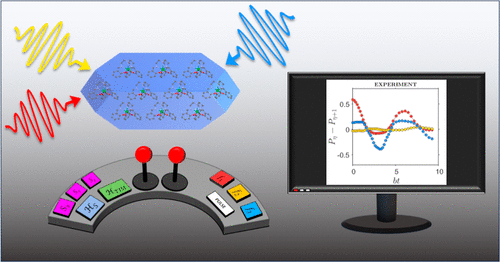
|
The use of d-level qudits instead of two-level qubits can largely increase the power of quantum logic for many applications, ranging from quantum simulations to quantum error correction. Magnetic molecules are ideal spin systems to realize these large-dimensional qudits. Indeed, their Hamiltonian can be engineered to an unparalleled extent and can yield a spectrum with many low-energy states. In particular, in the past decade, intense theoretical, experimental, and synthesis efforts have been devoted to develop quantum simulators based on molecular qubits and qudits. However, this remarkable potential is practically unexpressed, because no quantum simulation has ever been experimentally demonstrated with these systems. Here, the authors show the first prototype quantum simulator based on an ensemble of molecular qudits and a radiofrequency broadband spectrometer. To demonstrate the operativity of the device, the authors have simulated quantum tunneling of the magnetization and the transverse-field Ising model, representative of two different classes of problems. These results represent an important step toward the actual use of molecular spin qudits in quantum technologies. |
Simone Chicco, Giuseppe Allodi, Alessandro Chiesa, Elena
Garlatti, Christian D. Buch, Paolo Santini, Roberto De
Renzi, Stergios Piligkos, Stefano Carretta,
Proof-of-Concept Quantum Simulator Based on Molecular Spin Qudits,
JACS (2023)
Ab initio prediction of key parameters and magneto-structural correlation of tetracoordinated lanthanide single-ion magnets
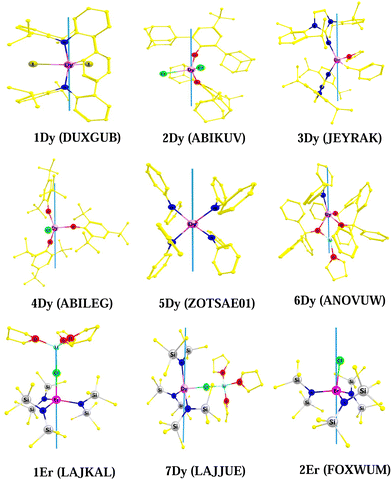
|
Single-molecule magnets (SMMs) have great potential in becoming revolutionary materials for micro-electronic devices. As one type of SMM and holding the performance record, lanthanide single-ion magnets (Ln-SIMs) stand at the forefront of the family. Lowering the coordination number (CN) is an important strategy to improve the performance of Ln-SIMs. Here, we report a theoretical study on a typical group of low-CN Ln-SIMs, i.e. , tetracoordinated structures. Our results are consistent with those of experiments and they identify the same three best Ln-SIMs via a concise criterion, i.e. , the co-existence of long Ï QTM and high U eff . Compared to the record-holding dysprosocenium systems, the best SIMs here possess Ï QTM values that are shorter by several orders of magnitude and U eff values that are lower by âŒ1000 Kelvin (K). These are important reasons for the fact that the tetracoordinated Ln-SIMs are clearly inferior to dysprosocenium. A simple but intuitive crystal-field analysis leads to several routes to improve the performance of a given Ln-SIM, including compression of the axial bond length, widening the axial bond angle, elongation of the equatorial bond length and usage of weaker equatorial donor ligands. Although these routes are not brand-new, the most efficient option and the degree of improvement resulting from it are not known in advance. Consequently, a theoretical magneto-structural study, covering various routes, is carried out for the best Ln-SIM here and the most efficient route is shown to be widening the axial â OâDyâO angle. The most optimistic case, having a â OâDyâO of 180°, could have a Ï QTM (up to 10 3 s) and U eff (âŒ2400 K) close to those of the record-holders. Subsequently, a blocking temperature ( T B ) of 64 K is predicted to be possible for it. A more practical case, with â OâDyâO being 160°, could have a Ï QTM of up to 400 s, U eff of around 2200 K and the possibility of a T B of 57 K. Although having an inherent precision limit, these predictions provide a guide to performance improvement, starting from an existing system. |
Qi-Qi Yang, Yu-Fei Wang, Yu-Xi Wang, Ming-Jing Tanga, Bing Yin,
Ab initio prediction of key parameters and magneto-structural correlation of tetracoordinated lanthanide single-ion magnets,
Phys. Chem. Chem. Phys., 2023,25, 18387-18399
Direct observation of chirality-induced spin selectivity in electron donorâacceptor molecules
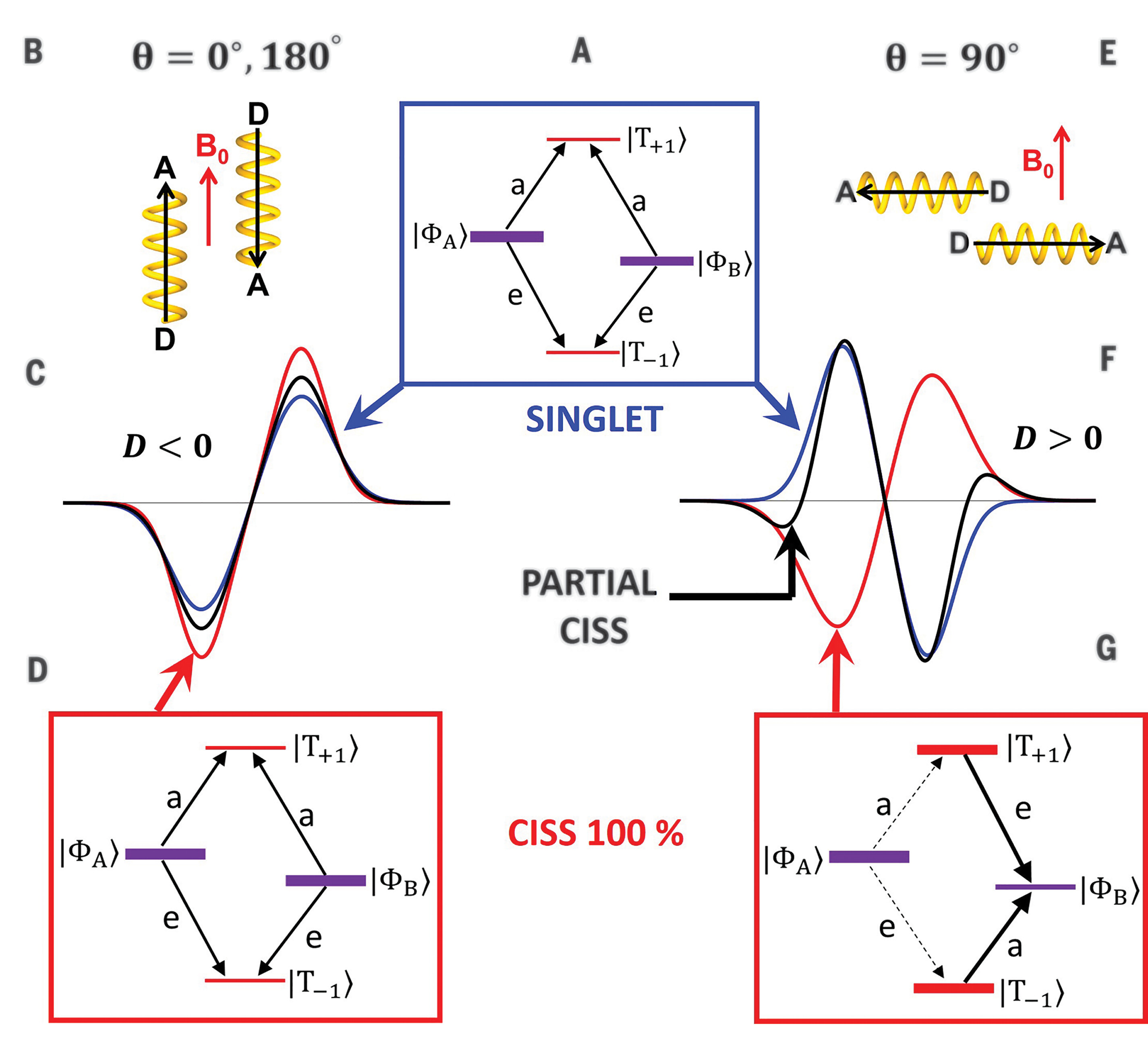
|
Chirality-induced spin selectivity has undergone intensive study in the two decades since its discovery. Essentially, the phenomenon manifests as polarization of electron spin by chiral molecules, although the observations thus far have pertained to samples adsorbed on a solid substrate. The authors report significant chirality-induced spin selectivity signatures during intramolecular electron transfer between donor and acceptor fragments across a chiral bridge in free-floating molecules. The precise tunability and tractability of these systems should enable systematic comparisons with evolving theoretical models. |
Eckvahl, Hannah J.;
Tcyrulnikov, Nikolai A.;
Chiesa, Alessandro;
Bradley, Jillian M.;
Young, Ryan M.;
Carretta, Stefano;
Krzyaniak, Matthew D.;
Wasielewski, Michael R.;
Direct observation of chirality-induced spin selectivity in electron donorâacceptor molecules,
SCIENCE, 12, Oct 2023, Vol 382, Issue 6667, pp. 197-201
Spin Symmetry in Polynuclear Exchange-Coupled Clusters
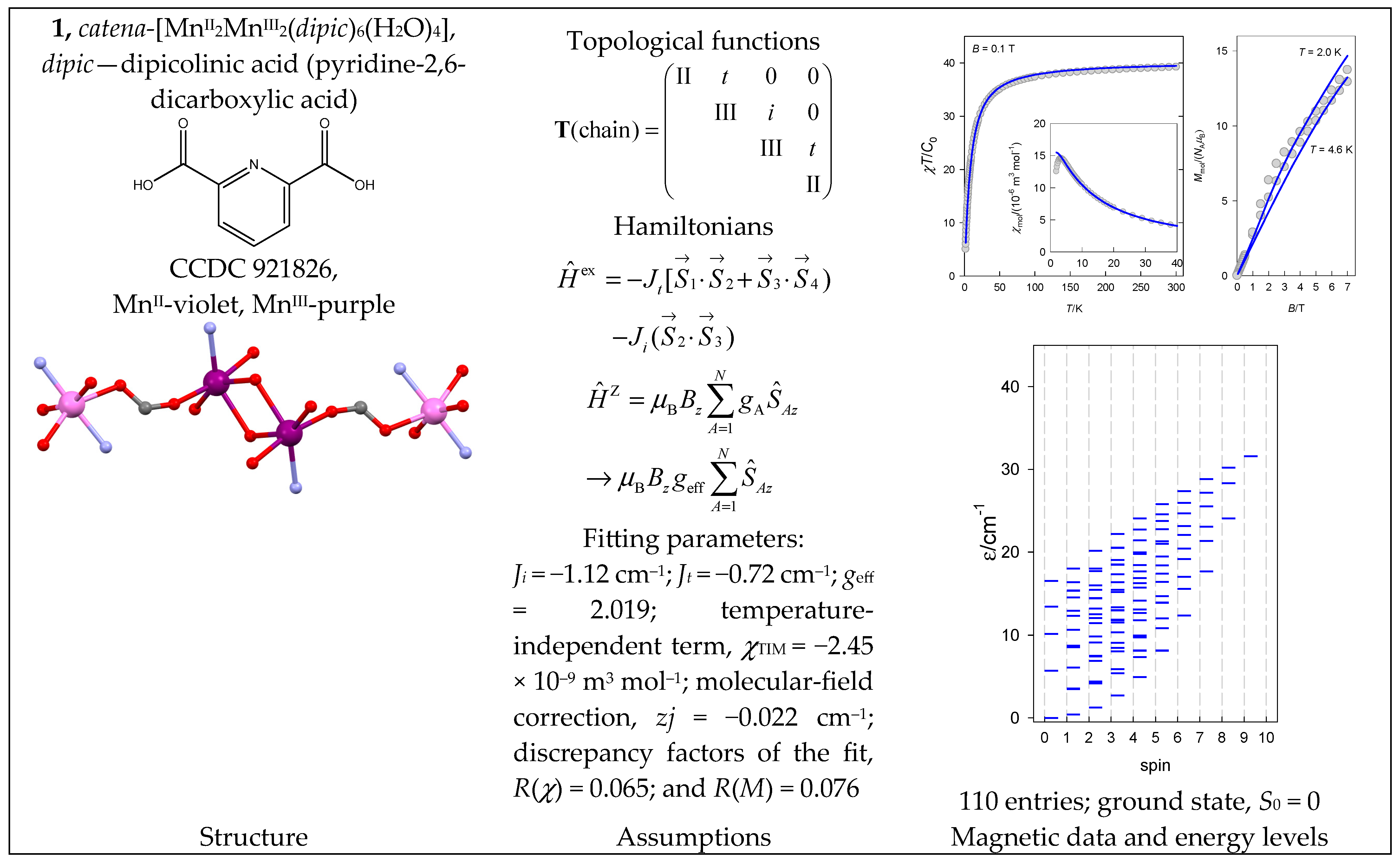
|
The involvement of spin symmetry in the evaluation of zero-field energy levels in polynuclear transition metal and lanthanide complexes facilitates the division of the large-scale Hamiltonian matrix referring to isotropic exchange. This method is based on the use of an irreducible tensor approach. This allows for the fitting of the experimental data of magnetic susceptibility and magnetization in a reasonable time for relatively large clusters for any coupling path. Several examples represented by catena-[AN} and cyclo-[AN] systems were modeled. Magnetic data for 20 actually existing endohedral clusters were analyzed and interpreted. |
BoÄa, Roman, Cyril RajnĂĄk, and JĂĄn TitiĆĄ,
Spin Symmetry in Polynuclear Exchange-Coupled Clusters,
Magnetochemistry 9, no. 11: 226 (2023)
Get under the Umbrella: A Comprehensive Gateway for Researchers on Lanthanide-Based Single-Molecule Magnets

|
In order to help young researchers in Molecular Magnetism, this article proposes a âreview of reviewsâ also known as an âumbrella reviewâ on lanthanide-based monomolecular magnets (4âf-SMM). Bibliographic search techniques are commented together with AI-based tools for bibliographic search, indexing, and summarization. Milestones in 4âf-SMM are identified. Books, book articles, and reviews are contextualized. This article is therefore proposed as a gateway to the 4âf-SMM field. |
Kevin Bernot,
Get under the Umbrella: A Comprehensive Gateway for Researchers on Lanthanide-Based Single-Molecule Magnets,
Eur. J. Inorg. Chem. 2023, e202300336
Increasing the Magnetic Blocking Temperature of Single-Molecule Magnets
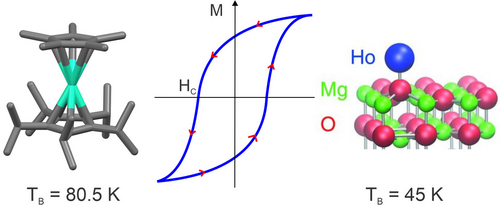
|
Despite three decades of intensive investigation of single-molecule magnets (SMMs) there are still unexplored roads towards increasing their magnetization blocking temperature. In this Review, after short overview of key SMM compounds, the basic strategies for further enhancement of SMM performance for mononuclear and polynuclear complexes are presented. |
Veacheslav Vieru, Silvia GĂłmez-Coca, Eliseo Ruiz, Liviu F. Chibotaru,
Increasing the Magnetic Blocking Temperature of Single-Molecule Magnets,
Angew. Chem. Int. Ed. 2023, e202303146
A trivalent 4f complex with two bis-silylamide ligands displaying slow magnetic relaxation
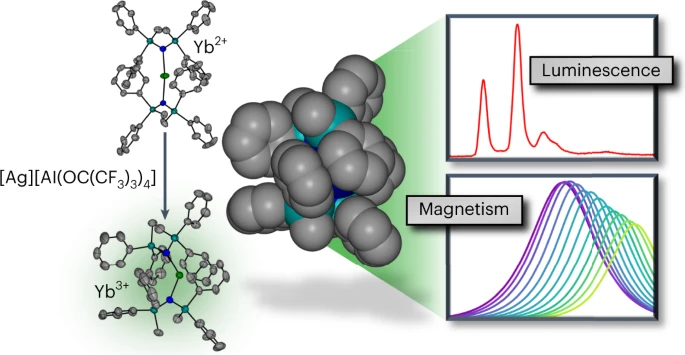
|
The best-performing single-molecule magnets (SMMs) have historically relied on pseudoaxial ligands delocalized across several coordinated atoms. This coordination environment has been found to elicit strong magnetic anisotropy, but lanthanide-based SMMs with low coordination numbers have remained synthetically elusive species. Here we report a cationic 4f complex bearing only two bis-silylamide ligands, Yb(III)[{N(SiMePh2)2}2][Al{OC(CF3)3}4], which exhibits slow relaxation of its magnetization. The combination of the bulky silylamide ligands and weakly coordinating [Al{OC(CF3)3}4]â anion provides a sterically hindered environment that suitably stabilizes the pseudotrigonal geometry necessary to elicit strong ground-state magnetic anisotropy. The resolution of the mJ states by luminescence spectroscopy is supported by ab initio calculations, which show a large ground-state splitting of approximately 1,850âcm-1. These results provide a facile route to access a bis-silylamido Yb(III) complex, and further underline the desirability of axially coordinated ligands with well-localized charges for high-performing SMMs. |
Dylan Errulat, Katie L. M. Harriman, Diogo A. GĂĄlico, Alexandros A. Kitos, Akseli Mansikkamäki, Muralee Murugesu,
A trivalent 4f complex with two bis-silylamide ligands displaying slow magnetic relaxation,
Nature Chemistry volume 15, pages 1100â1107 (2023)
Ratiometric Nanothermometer Based on a Radical Excimer for In Vivo Sensing
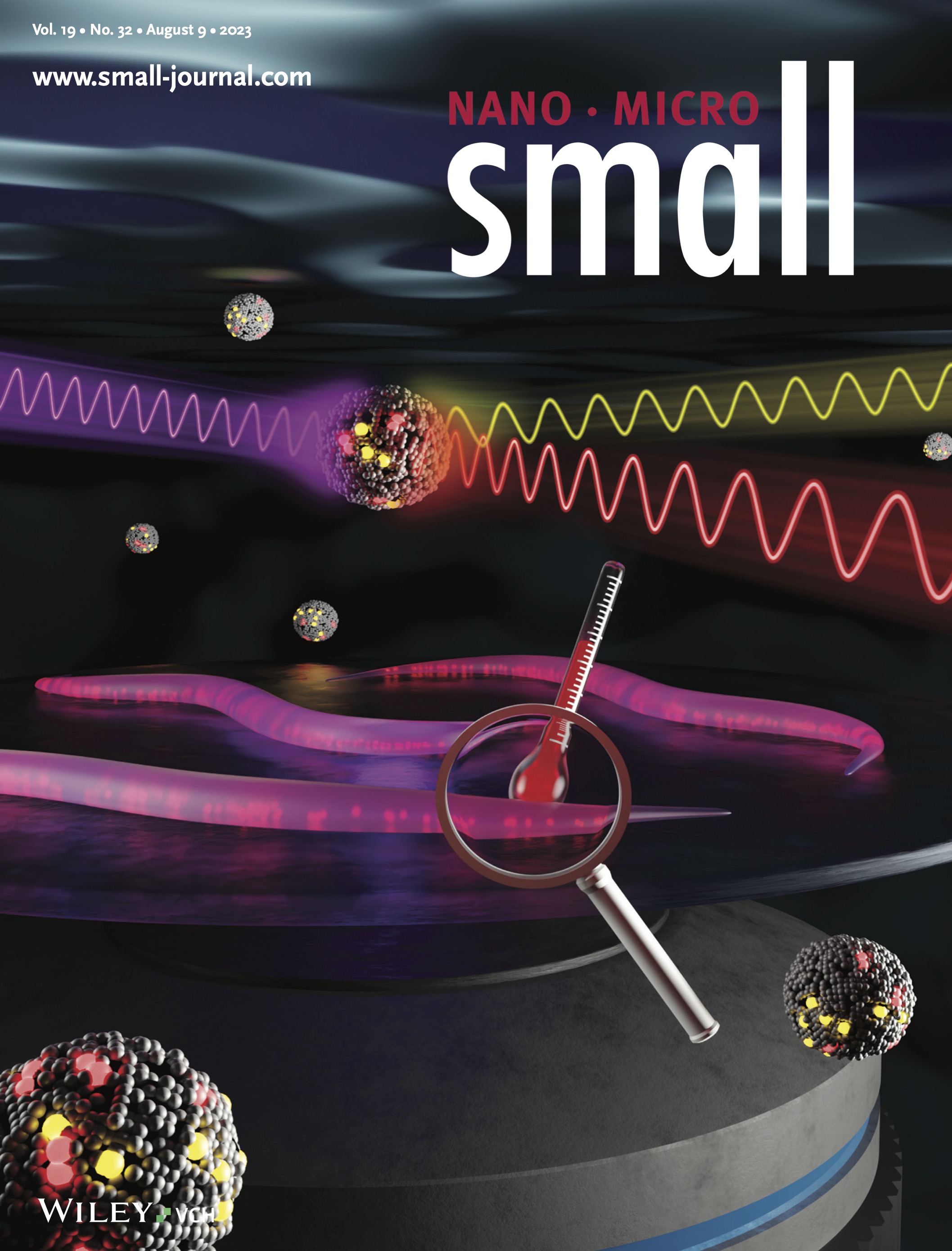
|
Ratiometric fluorescent nanothermometers with near-infrared emission play an important role in in-vivo sensing since they can be used as intracellular thermal sensing probes with high spatial resolution and high sensitivity, to investigate cellular functions of interest in diagnosis and therapy, where current approaches are not effective. Herein, the temperature-dependent fluorescence of organic nanoparticles is designed, synthesized, and studied based on the dual emission, generated by monomer and excimer species, of the tris(2,4,6-trichlorophenyl)methyl radical (TTM) doping organic nanoparticles (TTMd-ONPs), made of optically neutral tris(2,4,6-trichlorophenyl)methane (TTM-αH), acting as a matrix. The excimer emission intensity of TTMd-ONPs decreases with increasing temperatures whereas the monomer emission is almost independent and can be used as an internal reference. TTMd-ONPs show a great temperature sensitivity (3.4% Kâ1 at 328 K) and a wide temperature response at ambient conditions with excellent reversibility and high colloidal stability. In addition, TTMd-ONPs are not cytotoxic and their ratiometric outputs are unaffected by changes in the environment. Individual TTMd-ONPs are able to sense temperature changes at the nano-microscale. In vivo thermometry experiments in Caenorhabditis elegans (C. elegans) worms show that TTMd-ONPs can locally monitor internal body temperature changes with spatio-temporal resolution and high sensitivity, offering multiple applications in the biological nanothermometry field. |
Davide Blasi, Nerea Gonzalez-Pato, Xavier Rodriguez Rodriguez,
Iñigo Diez-Zabala, Sumithra Yasaswini Srinivasan, NĂșria
Camarero, Oriol Esquivias, MĂČnica RoldĂĄn, Judith Guasch, Anna
Laromaine, Pau Gorostiza, Jaume Veciana, Imma Ratera,
Ratiometric Nanothermometer Based on a Radical Excimer for In Vivo Sensing,
Small 2023, 19, 2207806
Formation and characterization of polymetallic {CrxMy} rings in vacuo
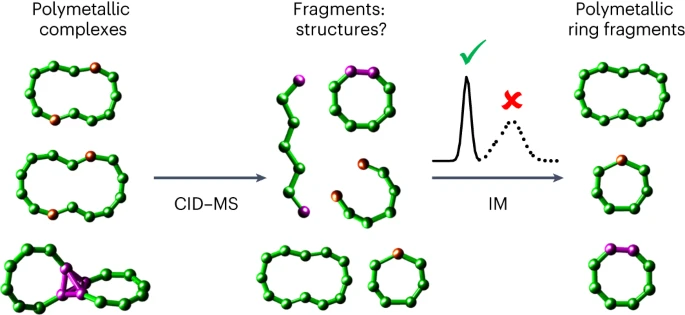
|
Understanding the (dis)assembly mechanisms of large metallosupramolecules is critical in their design, stability and application. The inherent complexity of these structures leads to many potential pathways for combining (or separating) the constituent building blocks, which makes this task difficult. Here we use collision-induced dissociation mass spectrometry to study the disassembly of heterometallic complexes. Collisional activation leads to the formation of a series of previously unknown smaller ring products and we characterize their geometry using ion mobility. The disassembly of both {CrxCu2} hourglass structures (xâ=â10, 12) and of a {Cr12Gd4} cluster shows the formation of rare closed, heptametallic species {Cr6Cu}, {Cr5Cu2} and {Cr5Gd2} as dominant products, as well as other closed ions such as {Cr5Cu}, {Cr10Cu}, {Cr12Cu}, {Cr10}, {Cr12} and {Cr6Gd2}. The collision cross-section of cyclic products and precursors has a linear correlation with ion massâa relationship that does not hold for acyclic systems. As these rings are non-trivial to synthesize individually in solution, we propose the presented workflow to identify and characterize feasible molecules for bulk phase synthesis. |
Geue, Niklas and Timco, Grigore A. and Whitehead, George
F. S. and McInnes, Eric J. L. and Burton, Neil A. and Winpenny,
Richard E. P. and Barran, Perdita E.,
Formation and characterization of polymetallic {CrxMy} rings in vacuo,
Nature Synthesis (2023)
Computational Modelling of Molecular Nanomagnets
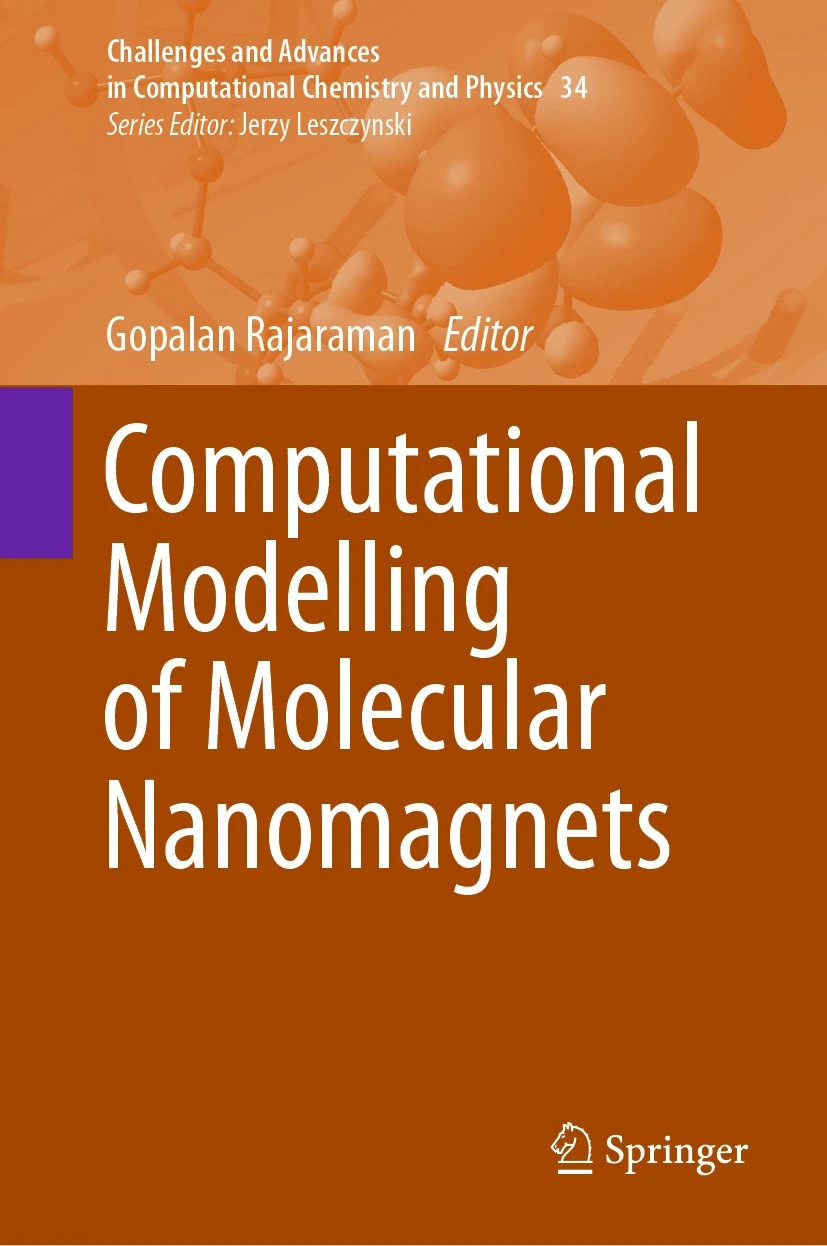
|
Contents: 1 Ab Initio Investigation of Anisotropic Magnetism and Magnetization Blocking in Metal Complexes, Liviu F. Chibotaru 2 Analytical Derivations for the Description of Magnetic Anisotropy in Transition Metal Complexes, RĂ©mi Maurice, Nicolas Suaud, and Nathalie GuihĂ©ry 3 Calculations of Magnetic Exchange in Multinuclear Compounds, Giang Truong Nguyen and Liviu Ungur 4 Exact Diagonalization Techniques for Quantum Spin Systems, Jürgen Schnack 5 Modeling Magnetic Properties of Actinide Complexes, HĂ©lĂšne Bolvin 6 Spin-Phonon Relaxation in Magnetic Molecules: Theory, Predictions and Insights, Alessandro Lunghi 7 Ab Initio Modelling of Lanthanide-Based Molecular Magnets: Where to from Here?, Sourav Dey, Tanu Sharma, Arup Sarkar, and Gopalan Rajaraman 8 Molecular Magnets on Surfaces: In Silico Recipes for a Successful Marriage, Matteo Briganti and Federico Totti 9 Theoretical Approaches for Electron Transport Through Magnetic Molecules, Eliseo Ruiz and Daniel Aravena |
Computational Modelling of Molecular Nanomagnets,
Editor Gopalan Rajaraman, Springer, 2023
Spin polarization effects in trigonal mixed-valence complexes exhibiting double exchange supported by external spin-cores
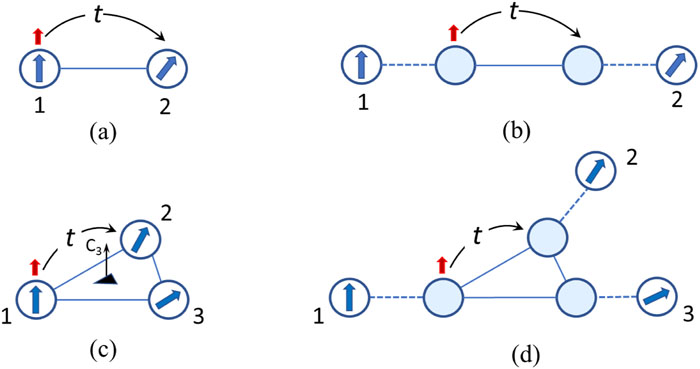
|
The theory of the magnetic coupling between the localized spins, mediated by the mobile excess electron, is generalized to the case of a trigonal, six-center, four-electron molecule with partial valence delocalization. The combination of the electron transfer occurring within the valence-delocalized subsystem and the interatomic exchange producing coupling of the spin of the mobile electron of valence-delocalized fragment with the three localized spins forming the valence-localized subsystem leads to the appearance of a special kind of double exchange (DE), termed the âexternal core double exchangeâ (ECDE), in order to distinguish such DE from the conventional âinternal core double exchangeâ for which the mobile electron is coupled with the spin-cores on the same center via the intra-atomic exchange. The effect of the ECDE on the ground spin state of the considered trigonal molecule is compared with earlier reported effect produced by DE in the four-electron, mixed-valence (MV) trimer. A high diversity of the ground spin states is revealed, depending on the relative magnitudes and signs of the electron transfer and interatomic exchange parameters, with part of these states not appearing to be the ground states in a trigonal trimer exhibiting DE. The authors briefly discuss some examples of trigonal MV systems from the point of view of the possibility to have different combinations of signs of the transfer and exchange parameters and, accordingly, different ground spin states. The tentative role of the considered systems in molecular electronics and spintronics is also noticed. |
Andrew Palii,
Denis Korchagin,
Ksenya Kondrina,
Sergey Aldoshin,
Shmuel Zilberg,
Boris Tsukerblat,
Spin polarization effects in trigonal mixed-valence complexes exhibiting double exchange supported by external spin-cores,
J. Chem. Phys. 158, 194303 (2023)
Molecular nanomagnets with competing interactions as optimal units for qudit-based quantum computation
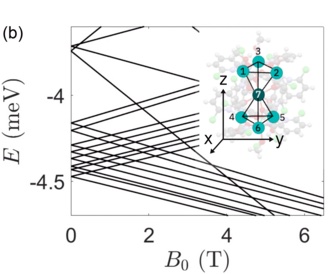
|
Quantum systems displaying many accessible levels could be very powerful units of forthcoming quantum computing architectures. Indeed, the large number of available states could significantly simplify the actual implementation of several algorithms. Here the authors show that artificial molecular spins are particularly suitable to realize such a platform. In particular, multispin molecules with competing interactions provide a large number of low-energy multiplets in which decoherence is strongly suppressed compared to a single spin S and does not increase with the system size. This feature, combined with the proper connectivity between the multiplets, enables the implementation of complex operations with remarkable fidelity, thus fully unleashing the potential of the molecular approach. The authors demonstrate the power of this approach by numerically simulating the implementation of one- and two-qudit gates on realistic molecular systems. |
M. Chizzini, L. Crippa, A. Chiesa, F. Tacchino, F. Petiziol,
I. Tavernelli, P. Santini, and S. Carretta,
Molecular nanomagnets with competing interactions as optimal units for qudit-based quantum computation,
Phys. Rev. Research 4, 043135 (2022)
Strong Axiality in a Dysprosium(III) Bis(borolide) Complex Leads to Magnetic Blocking at 65 K
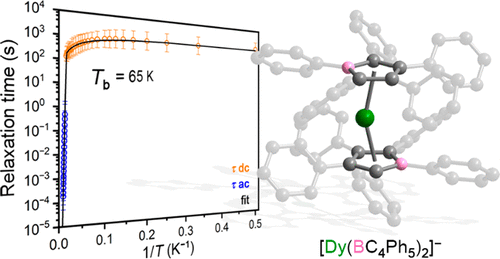
|
Substituted dysprosocenium complexes of the type [Dy(CpR)2]+ exhibit slow magnetic relaxation at cryogenic temperatures and have emerged as top-performing single-molecule magnets. The remarkable properties of these compounds derive in part from the strong axial ligand field afforded by the cyclopentadiene anions, and the design of analogous compounds with even stronger ligand fields is one promising route toward identifying new single-molecule magnets that retain a magnetic memory at even higher temperatures. Here, we report the synthesis and characterization of a dysprosium bis(borolide) compound, [K(18-crown-6)][Dy(BC4Ph5)2] (1), featuring the dysprosocenate anion [Dy(BC4Ph5)2]â with a pseudoaxial coordination environment afforded by two dianionic pentaphenyl borolide ligands. Variable-field magnetization data reveal open magnetic hysteresis up to 66 K, establishing 1 as a top-performing single-molecule magnet among its dysprosocenium analogues. Ac magnetic susceptibility data indicate that 1 relaxes via an Orbach mechanism above âŒ80 K with Ueff = 1500(100) cmâ1 and Ï0 = 10â12.0(9) s, whereas Raman relaxation and quantum tunneling of the magnetization dominate at lower temperatures. Compound 1 exhibits a 100 s blocking temperature of 65 K, among the highest reported for dysprosium-based single-molecule magnets. Ab initio spin dynamics calculations support the experimental Ueff and Ï0 values and enable a quantitative comparison of the relaxation dynamics of 1 and two representative dysprosocenium cations, yielding additional insights into the impact of the crystal field splitting and vibronic coupling on the observed relaxation behavior. Importantly, compound 1 represents a step toward the development of alternatives to substituted dysprosocenium single-molecule magnets with increased axiality. |
Alexandre H. Vincent, Yasmin L. Whyatt, Nicholas F. Chilton, Jeffrey R. Long,
Strong Axiality in a Dysprosium(III) Bis(borolide) Complex Leads to Magnetic Blocking at 65 K,
J. Am. Chem. Soc. 2023, 145, 3, 1572â1579
Dipolar-Coupled Entangled Molecular 4f Qubits
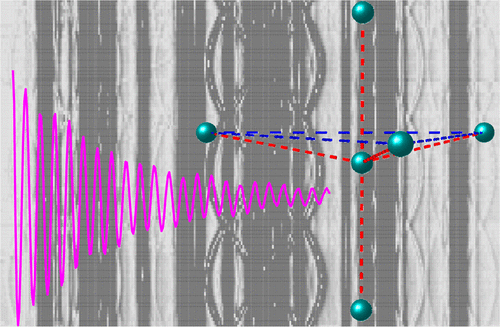
|
The authors demonstrate by use of continuous wave- and pulse-electron paramagnetic resonance spectroscopy on oriented single crystals of magnetically dilute YbIII ions in Yb0.01Lu0.99(trensal) that molecular entangled two-qubit systems can be constructed by exploiting dipolar interactions between neighboring YbIII centers. Furthermore, the authors show that the phase memory time and Rabi frequencies of these dipolar-interaction-coupled entangled two-qubit systems are comparable to the ones of the corresponding single qubits. |
Bela E. Bode, Edoardo Fusco, Rachel Nixon, Christian D. Buch,
HĂžgni Weihe, Stergios Piligkos,
Dipolar-Coupled Entangled Molecular 4f Qubits,
Am. Chem. Soc. 2023, 145, 5, 2877â2883
A {Gd12Na6} Molecular Quadruple-Wheel with a Record Magnetocaloric Effect at Low Magnetic Fields and Temperatures
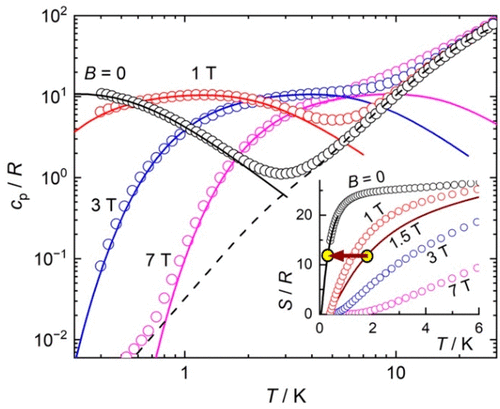
|
Reaction of Gd(OAc)3·4H2O, salicylaldehyde and CH3ONa in MeCN/MeOH affords [Gd12Na6(OAc)25(HCO2)5(CO3)6(H2O)12]·9H2O.0.5MeCN (1·9H2O.0.5MeCN), whose structure describes a quadruple-wheel consisting of two {Na3} and two {Gd6} rings. The magnetic properties of 1 reveal very weak antiferromagnetic interactions between the GdIII ions, which give rise to a record magnetocaloric effect at low applied magnetic fields and low temperatures. The magnetic entropy change reaches âÎSm= 29.3 J kgâ1 Kâ1 for full demagnetization from B = 1 T at T = 0.5 K. |
Thomais G. Tziotzi, David Gracia, Scott J. Dalgarno, Jürgen
Schnack, Marco Evangelisti, Euan K. Brechin, and Constantinos
J. Milios,
A {Gd12Na6} Molecular Quadruple-Wheel with a Record Magnetocaloric Effect at Low Magnetic Fields and Temperatures,
J. Am. Chem. Soc. 2023, 145, 14, 7743â7747
Synthetic Factors Determining the Curvature and Nuclearity of the Giant Mn70 and Mn84 Clusters with a Torus Structure of âŒ4 nm Diameter
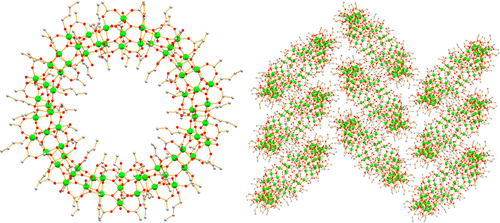
|
Factors determining the nuclearities of giant torus-like Mn70 or Mn84 from hybrid comproportionation/alcoholysis reactions are investigated. Multiple permutations of alcohol and carboxylic acid reveal the product is determined by two competing factors, the alcohol versus acid bulk, the Mn84 tori forming with acids bulkier than acetate. The structures of one Mn84 and two Mn70 tori are described, comprising alternating near-linear Mn3 and distorted-cubane Mn4 units. All crystallize as supramolecular nanotubes but with different packing arrangements. |
Ashlyn R. Hale, Khalil A. Abboud, and George Christou,
Synthetic Factors Determining the Curvature and Nuclearity
of the Giant Mn70 and Mn84 Clusters with a Torus Structure of âŒ4 nm Diameter,
Inorg. Chem. 62 (2023) 6020â6031
What should we investigate to find out whether toroidal systems are good for storage or quantum computing?
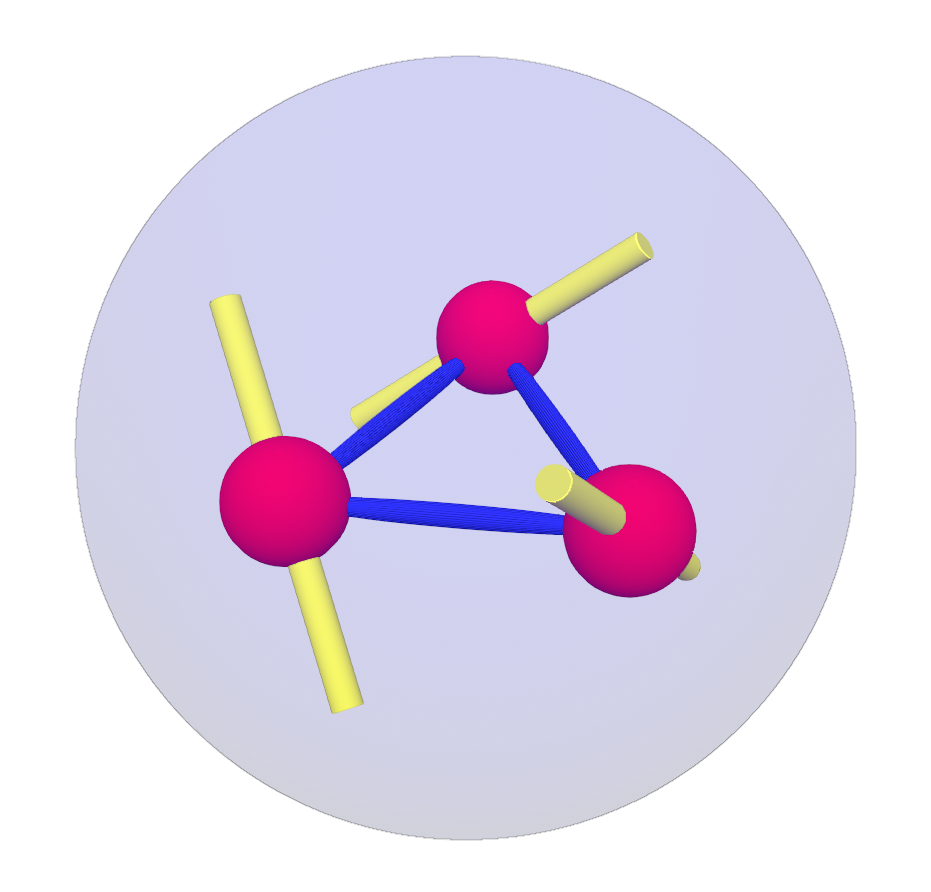
|
Magnetic molecules are investigated with respect to their usability as units in future quantum devices. In view of quantum computing, a necessary prerequisite is a long coherence time of superpositions of low-lying levels. In this article, we investigate by means of numerical simulations whether a toroidal structure of single-ion easy anisotropy axes is advantageous as often conjectured. Our results demonstrate that there is no general advantage of toroidal magnetic molecules, but that arrangements of tilted anisotropy axes perform best in many cases. |
K. Irländer and J. Schnack, Studies of decoherence in strongly anisotropic spin triangles with toroidal or general noncollinear easy axes, Phys. Rev. Research 5, 013192 (2023)
For a related investigation please see
D. Pister, K. Irländer, D. Westerbeck, J. Schnack,
Toroidal magnetic molecules stripped to their basics,
Phys. Rev. Research 4 (2022) 033221
A perfect triangular dysprosium single-molecule magnet with virtually antiparallel Ising-like anisotropy
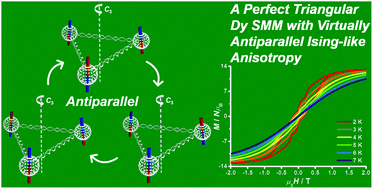
|
The authors report a trinuclear dysprosium single-molecule magnet, [Dy3(Ό3-CO3)(Clbbpen)3](CF3SO3)·6MeCN, which has a perfectly equilateral triangular structure. The Ising-like anisotropy of each Dy(III) site is oriented almost normal to the triangular plane, and magnetic dipole interactions between the spins cause an antiparallel Ising ground state. Crossing of the antiferromagnetic states by the ferromagnetic state occurs at ca. 0.2 T and gives rise to a characteristic step in magnetic hysteresis loops. This molecule thus serves as a perfectly triangular model system to explore frustrated Ising anisotropy. |
Guang Lu, Yang Liu, Wei Deng, Guo-Zhang Huang, Yan-Cong Chen,
Jun-Liang Liu, Zhao-Ping Ni, Marcus Giansiracusa,
Nicholas F. Chilton, Ming-Liang Tong,
A perfect triangular dysprosium single-molecule magnet with virtually antiparallel Ising-like anisotropy,
Inorg. Chem. Front., 2020, 7, 2941-2948
Influence of pressure on a dysprosocenium single-molecule magnet
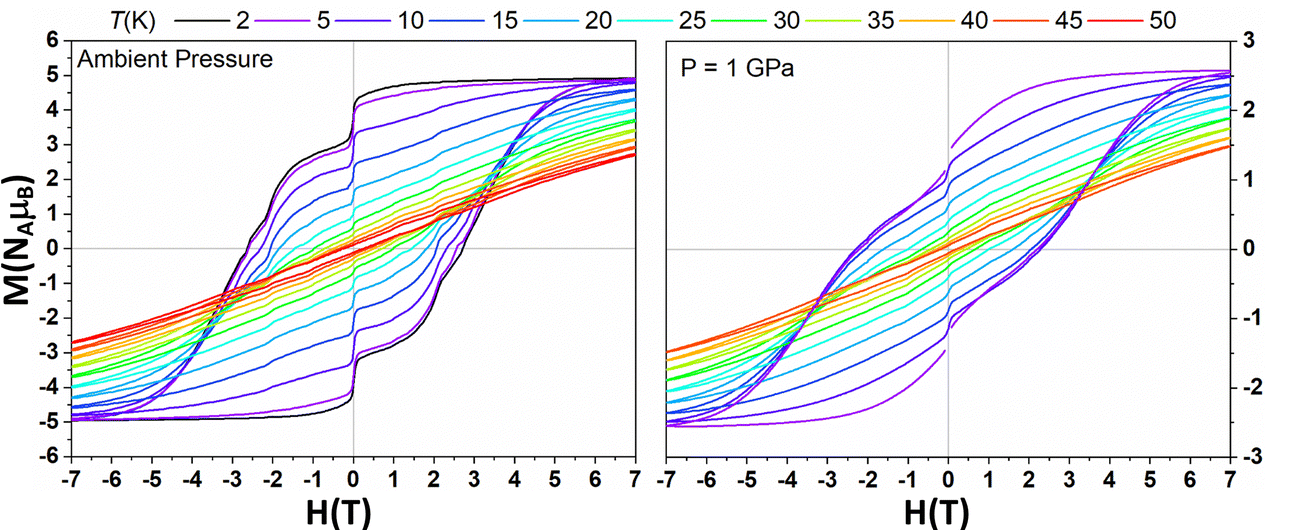
|
The effects of external pressure on a high-performing dysprosocenium single-molecule magnet are investigated using a combination of X-ray diffraction, magnetometry and theoretical calculations. The effective energy barrier (Ueff) decreases from ca. 1300 cmâ1 at ambient pressure to ca. 1125 cmâ1 at 3 GPa. The results indicate that compression < 1.2 GPa has a negligible effect on the Orbach process, but magnetic relaxation > 1 GPa increases via Raman relaxation and/or quantum tunnelling of magnetisation. |
Vijay S. Parmar, Andreas M. Thiel, Rizwan Nabi,
Gemma K. Gransbury, Marie S. Norre, Peter Evans,
Sophie C. Corner, Jonathan M. Skelton, Nicholas
F. Chilton, David P. Mills, Jacob Overgaard,
Influence of pressure on a dysprosocenium single-molecule magnet,
Chem. Commun., 2023,59, 2656-2659
Multiprocessing Quantum Computing through Hyperfine Couplings in Endohedral Fullerene Derivatives
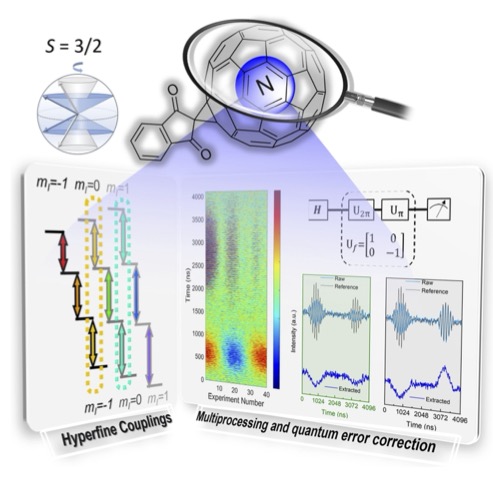
|
Magnetic molecules have shown great potential in quantum information processing due to the chemical tunablity of their quantum behaviors. Chemical derivatives of endohedral nitrogen fullerenes with long coherence time and rich energy levels were synthesized and studied to demonstrate the ability of multiprocessing in quantum information using electron magnetic resonance. After initialization of the 12-levelled spin system, subgroups of spin energy levels coursed by the hyperfine couplings can be selectively manipulated. The cooperatively combining of the parallel calculations enabled quantum error correction, increasing the correct rate by up to 17.82â%. Also, different subgroups of transitions divided by hyperfine coupling can be treated as independent qubits, and multi-task quantum computing were realized by performing Z-gate and X-gate simultaneously, which accelerates the overall gating speed. |
Peng-Xiang Fu, Shen Zhou, Zheng Liu, Cong-Hui Wu, Yu-Hui
Fang, Zhi-Rong Wu, Xing-Quan Tao, Jia-Yue Yuan, Ye-Xin Wang,
Song Gao, Shang-Da Jiang,
Multiprocessing Quantum Computing through Hyperfine Couplings in Endohedral Fullerene Derivatives,
Angew. Chem. Int. Ed. Volume 61, Issue 52, 2022, e202212939
Data-driven design of molecular nanomagnets
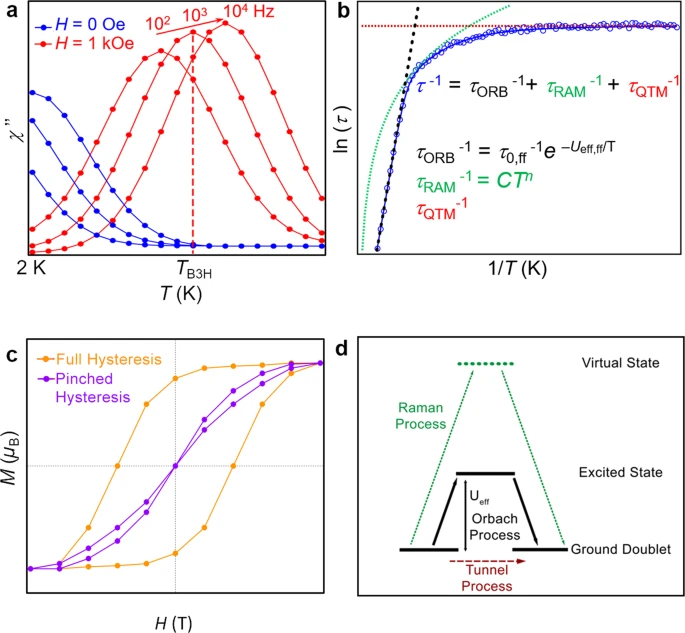
|
Three decades of research in molecular nanomagnets have raised their magnetic memories from liquid helium to liquid nitrogen temperature thanks to a wise choice of the magnetic ion and coordination environment. Still, serendipity and chemical intuition played a main role. In order to establish a powerful framework for statistically driven chemical design, here the authors collected chemical and physical data for lanthanide-based nanomagnets, catalogued over 1400 published experiments, developed an interactive dashboard (SIMDAVIS) to visualise the dataset, and applied inferential statistical analysis. The analysis shows that the Arrhenius energy barrier correlates unexpectedly well with the magnetic memory. Furthermore, as both Orbach and Raman processes can be affected by vibronic coupling, chemical design of the coordination scheme may be used to reduce the relaxation rates. Indeed, only bis-phthalocyaninato sandwiches and metallocenes, with rigid ligands, consistently present magnetic memory up to high temperature. Analysing magnetostructural correlations, the authors offer promising strategies for improvement, in particular for the preparation of pentagonal bipyramids, where even softer complexes are protected against molecular vibrations. |
Yan Duan, Lorena E. Rosaleny, Joana T. Coutinho, Silvia
GimĂ©nez-Santamarina, Allen Scheie, JosĂ© J. BaldovĂ, Salvador
Cardona-Serra & Alejandro Gaita-Ariño,
Data-driven design of molecular nanomagnets,
Nature Communications volume 13, Article number: 7626 (2022)
Computational design of magnetic molecules and their environment using quantum chemistry, machine learning and multiscale simulations
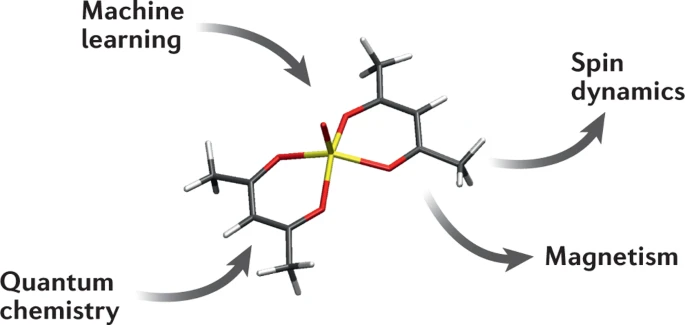
|
Having served as a playground for fundamental studies on the physics of d and f electrons for almost a century, magnetic molecules are now becoming increasingly important for technological applications, such as magnetic resonance, data storage, spintronics and quantum information. All of these applications require the preservation and control of spins in time, an ability hampered by the interaction with the environment, namely with other spins, conduction electrons, molecular vibrations and electromagnetic fields. Thus, the design of a novel magnetic molecule with tailored properties is a formidable task, which does not only concern its electronic structures but also calls for a deep understanding of the interaction among all the degrees of freedom at play. This Review describes how state-of-the-art ab initio computational methods, combined with data-driven approaches to materials modelling, can be integrated into a fully multiscale strategy capable of defining design rules for magnetic molecules. |
Alessandro Lunghi, Stefano Sanvito,
Computational design of magnetic molecules and their environment using quantum chemistry, machine learning and multiscale simulations,
Nat. Rev. Chem. 6, 761â781 (2022)
Modular Approach to Creating Functionalized Surface Arrays of Molecular Qubits
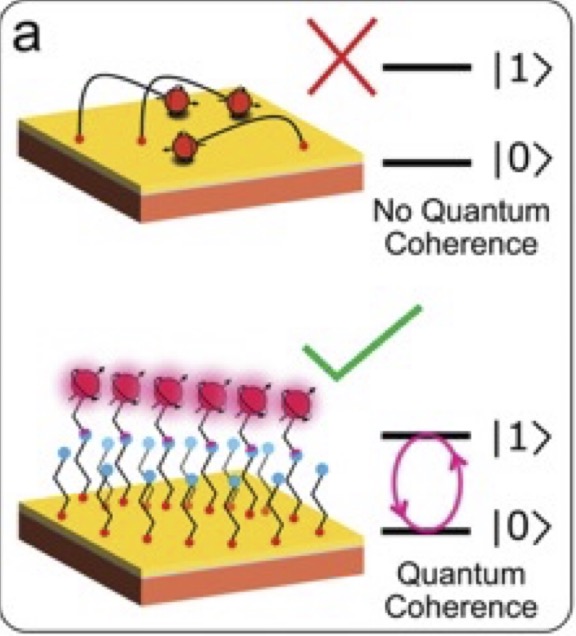
|
The quest for developing quantum technologies is driven by the promise of exponentially faster computations, ultrahigh performance sensing, and achieving thorough understanding of many-particle quantum systems. Molecular spins are excellent qubit candidates because they feature long coherence times, are widely tunable through chemical synthesis, and can be interfaced with other quantum platforms such as superconducting qubits. A present challenge for molecular spin qubits is their integration in quantum devices, which requires arranging them in thin films or monolayers on surfaces. However, clear proof of the survival of quantum properties of molecular qubits on surfaces has not been reported so far. Furthermore, little is known about the change in spin dynamics of molecular qubits going from the bulk to monolayers. Here, a versatile bottom-up method is reported to arrange molecular qubits as functional groups of self-assembled monolayers (SAMs) on surfaces, combining molecular self-organization and click chemistry. Coherence times of up to 13 ”s demonstrate that qubit properties are maintained or even enhanced in the monolayer. |
Lorenzo Tesi, Friedrich Stemmler, Mario Winkler, Sherri
S. Y. Liu, Saunak Das, Xiuming Sun, Michael Zharnikov, Sabine
Ludwigs, Joris van Slageren,
Modular Approach to Creating Functionalized Surface Arrays of Molecular Qubits,
Advanced Materials (2023) early view
{ScnGdn} Heterometallic Rings: Tunable Ring Topology for Spin-Wave Excitations
|
|
Data carriers using spin waves in spintronic and magnonic logic devices offer operation at low power consumption and free of Joule heating yet requiring noncollinear spin structures of small sizes. Heterometallic rings can provide such an opportunity due to the controlled spin-wave transmission within such a confined space. Here, the authors present a series of {ScnGdn} (n = 4, 6, 8) heterometallic rings, which are the first ScâLn clusters to date, with tunable magnetic interactions for spin-wave excitations. By means of time- and temperature-dependent spin dynamics simulations, the authors are able to predict distinct spin-wave excitations at finite temperatures. Such a new model is previously unexploited, especially due to the interplay of antiferromagnetic exchange, dipoleâdipole interaction, and ring topology at low temperatures, rendering the importance of the latter to spin-wave excitations. |
Hao-Lan Zhang, Yuan-Qi Zhai, Hiroyuki Nojiri, Christian
Schröder, Hung-Kai Hsu, Yi-Tsu Chan, Zhendong Fu, and Yan-Zhen
Zheng,
{ScnGdn} Heterometallic Rings: Tunable Ring Topology for Spin-Wave Excitations,
J. Am. Chem. Soc. 2022, 144, 33, 15193â15202
Flourination for better single-molecule magnets
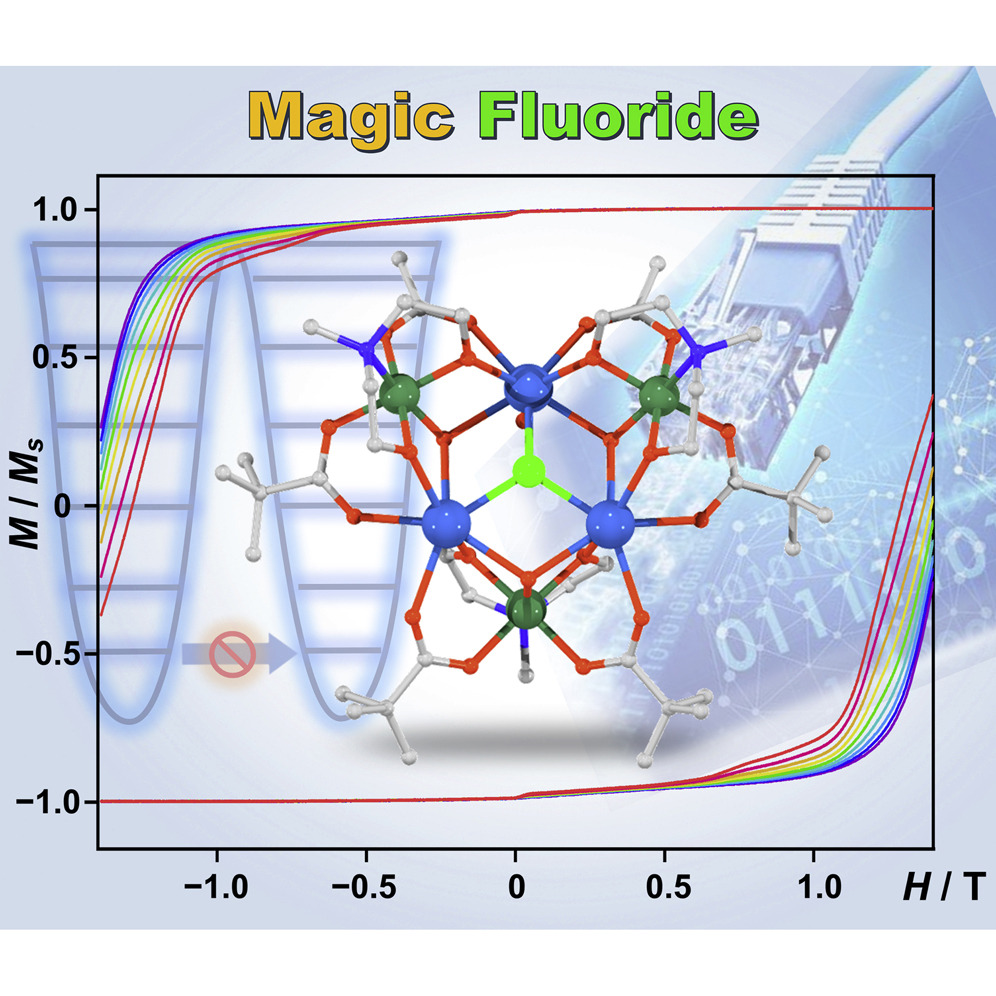
|
High-density magnetic material for rapid retrieval and writing of data should have a hard hysteresis loop with large coercive field and remanence at zero-field. However, for single-molecule magnets (SMMs), a hard hysteresis loop is difficult to achieve due to the quantum tunneling of the magnetization (QTM), especially at zero-field. Here the authors show the creation of a large ground magnetic momentum is crucial to suppress the QTM at zero-field for SMMs with mixed 3d transition metal and lanthanide ions. The recipe is to introduce the magic fluorido bridge between the lanthanide ions. The authors believe this work offers a solid strategy to suppress QTM, which can markedly enhance the relaxation time of SMMs. |
Bo-Kai Ling, Yuan-Qi Zhai, Peng-Bo Jin, Hong-Fan Ding,
Xu-Feng Zhang, Yi Lv, Zhendong Fu,Jiewei Deng, Michael Schulze,
Wolfgang Wernsdorfer, Yan-ZhenZheng,
Suppression of zero-field quantum tunneling of magnetization by a fluorido bridge for a "very hard" 3d-4f single-molecule magnet,
Matter, Volume 5, Issue 10, 2022, Pages 3485-3498
see also
Yan Ma, Yuan-Qi Zhai, Qian-Cheng Luo, You-Song Ding, Yan-Zhen Zheng,
Ligand Fluorination to Mitigate the Raman Relaxation
of DyIII Single-Molecule Magnets: A Combined Terahertz,
Far-IR and Vibronic Barrier Model Study,
Ang. Chem. Int. Ed., Volume 61, Issue 26, 2022, e202206022
Synthesis, Structure, and Magnetic Properties of an Fe36 Dimethylarsinate Cluster: The Largest âFerric Wheelâ
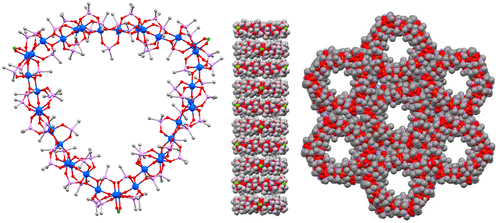
|
The synthesis and characterization of a high-nuclearity FeIII /O/arsinate cluster is reported within the salt [Fe36 O12 (OH)6 (O2 AsMe2 )63 (O2 CH)3 (H2 O)6 ](NO3 )12 (1). The compound was prepared from the reaction of Fe(NO3)3·9H 2O, dimethylarsinic acid (Me2AsO2 H), and triethylamine in a 1:2:4 molar ratio in acetonitrile. The Fe36 cation of 1 is an unprecedented structural type consisting of nine Fe 4 butterfly units of two types, three {FeIII4(ÎŒ3-O)2} units A , and six {FeIII4(ÎŒ3-O)(ÎŒ3-OH)} units B , linked by multiple bridging Me2AsO2â groups into an Fe36 triangular wheel/loop with C3 crystallographic and D3 virtual symmetry that looks like a guitar plectrum. The unusual structure has been rationalized on the basis of the different curvatures of units A and B, the presence of intra-Fe36 hydrogen bonding, and the tendency of Me2 AsO2â groups to favor ÎŒ3-bridging modes. The cations stack into supramolecular nanotubes parallel to the crystallographic c axis and contain badly disordered solvent and NO3â anions. The cation of 1 is the highest-nuclearity âferric wheelâ to date and also the highest-nuclearity Fe/O cluster of any structural type with a single contiguous Fe/O core. Variable-temperature direct-current magnetic susceptibility data and alternating-current in-phase magnetic susceptibility data indicate that the cation of 1 possesses an S=0 ground state and dominant antiferromagnetic interactions. The Fe2 pairwise Ji,j couplings were estimated by the combined use of a magnetostructural correlation for high-nuclearity FeIII/oxo clusters and density functional theory calculations using broken-symmetry methods and the Greenâs function approach. The three methods gave satisfyingly similar Ji,j values and allowed the identification of spin-frustration effects and the resulting relative spin-vector alignments and thus rationalization of the S = 0 ground state of the cation. |
Kenneth Hong Kit Lee, Lucas Aebersold, Juan E. Peralta, Khalil
A. Abboud, and George Christou,
Synthesis, Structure, and Magnetic Properties of an Fe36 Dimethylarsinate Cluster: The Largest âFerric Wheelâ,
Inorg. Chem. 2022, 61, 43, 17256â17267
Modern quantum chemistry with [Open]Molcas
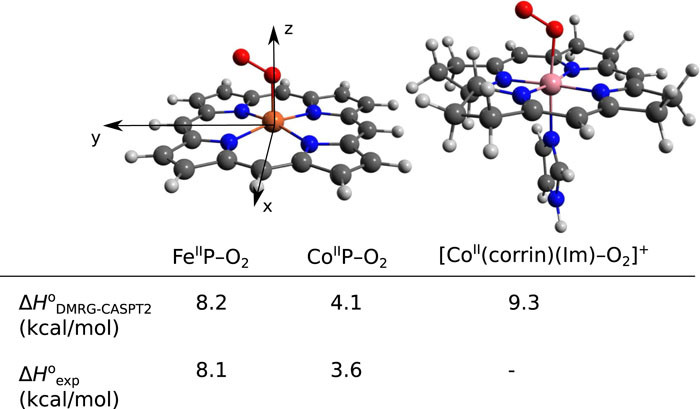
|
MOLCAS/OpenMolcas is an ab initio electronic structure program providing a large set of computational methods from HartreeâFock and density functional theory to various implementations of multiconfigurational theory. This article provides a comprehensive overview of the main features of the code, specifically reviewing the use of the code in previously reported chemical applications as well as more recent applications including the calculation of magnetic properties from optimized density matrix renormalization group wave functions. |
Francesco Aquilante, Jochen Autschbach, Alberto
Baiardi, Stefano Battaglia, Veniamin A. Borin,
Liviu F. Chibotaru, Irene Conti, Luca De Vico,
Mickaël Delcey, Ignacio Fdez. Galvån, Nicolas
Ferré, Leon Freitag, Marco Garavelli, Xuejun
Gong, Stefan Knecht, Ernst D. Larsson,
Roland Lindh, Marcus Lundberg, Per Ă
ke
Malmqvist, Artur Nenov, Jesper Norell,
Michael Odelius, Massimo Olivucci, Thomas
B. Pedersen, Laura Pedraza-GonzĂĄlez, Quan
M. Phung, Kristine Pierloot, Markus Reiher,
Igor Schapiro, Javier Segarra-MartĂ, Francesco
Segatta, Luis Seijo, Saumik Sen,
Dumitru-Claudiu Sergentu, Christopher J. Stein,
Liviu Ungur, Morgane Vacher, Alessio
Valentini, and Valera Veryazov,
Modern quantum chemistry with [Open]Molcas,
J. Chem. Phys. 152, 214117 (2020)
see also
OpenMolcas: From Source Code to Insight, J. Chem. Theory Comput. 2019, 15, 11, 5925â5964
Molcas 8: New capabilities for multiconfigurational quantum chemical calculations across the periodic table,
Computational Chemistry 37, 2016, 506-541
The Role of Magnetic Dipole-Dipole Coupling in Quantum Single-Molecule Toroics
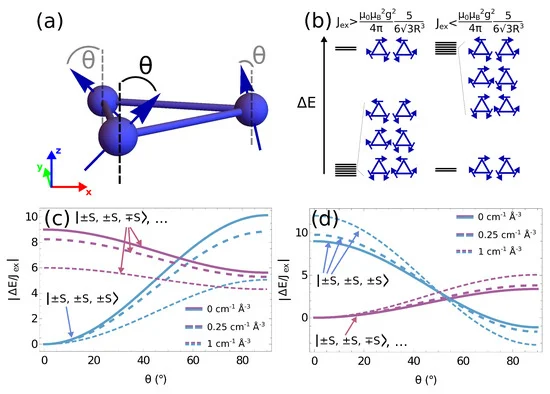
|
For single-molecule toroics (SMTs) based on noncollinear Ising spins, intramolecular magnetic dipole-dipole coupling favours a head-to-tail vortex arrangement of the semi-classical magnetic moments associated with a toroidal ground state. However, to what extent does this effect survive beyond the semi-classical Ising limit? Here, we theoretically investigate the role of dipolar interactions in stabilising ground-state toroidal moments in quantum Heisenberg rings with and without on-site magnetic anisotropy. For the prototypical triangular SMT with strong on-site magnetic anisotropy, we illustrate that, together with noncollinear exchange, intramolecular magnetic dipole-dipole coupling serves to preserve ground-state toroidicity. In addition, we investigate the effect on quantum tunnelling of the toroidal moment in Kramers and non-Kramers systems. In the weak anisotropy limit, we find that, within some critical ion-ion distances, intramolecular magnetic dipole-dipole interactions, diagonalised over the entire Hilbert space of the quantum system, recover ground-state toroidicity in ferromagnetic and antiferromagnetic odd-membered rings with up to seven sites, and are further stabilised by Dzyaloshinskii-Moriya coupling. |
Kieran Hymas and Alessandro Soncini, The Role of Magnetic Dipole-Dipole Coupling in Quantum Single-Molecule Toroics, Magnetochemistry 2022, 8(5), 58
For a related investigation please see
D. Pister, K. Irländer, D. Westerbeck, J. Schnack,
Toroidal magnetic molecules stripped to their basics,
Phys. Rev. Research 4 (2022) 033221
Importance of an Axial LnIII-F Bond across the Lanthanide Series and Single-Molecule Magnet Behavior in the Ce and Nd Analogues
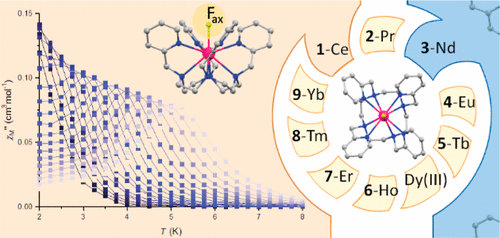
|
The recently reported compound [Dy III LF](CF 3 SO 3 ) 2 ·H 2 O (L = 1,4,7,10-tetrakis(2-pyridylmethyl)-1,4,7,10-tetraaza-cyclododecane) displays a strong axial magnetic anisotropy, due to the short axial DyâF bond, and single-molecule magnet (SMM) behavior. Following our earlier [Dy III LF] 2+ work, herein we report the systematic structural and magnetic study of a family of [Ln III LF](CF 3 SO 3 ) 2 ·H 2 O compounds (Ln(III) = 1 -Ce, 2 -Pr, 3 -Nd, 4 -Eu, 5 -Tb, 6 -Ho, 7 -Er, 8 -Tm, and 9 -Yb). From this series, the Ce(III) and Nd(III) analogues show slow relaxation of the magnetization under an applied direct current magnetic field, which is modeled using a Raman process. Complete active space self-consistent field theoretical calculations are employed to understand the relaxation pathways in 1 -Ce and 3 -Nd and also reveal a large tunnel splitting for 5 -Tb. Additional computational studies on model compounds where we remove the axial F â ligand, or replace F â with I â , highlight the importance of the F â ligand in creating a strong axial crystal field for 1 -Ce and 3 -Nd and for promoting the SMM behavior. Importantly, this systematic study provides insight into the magnetic properties of these lighter lanthanide ions. |
Emma RegincĂłs MartĂ, Angelos B. Canaj, Tanu Sharma, Anna
Celmina, Claire Wilson, Gopalan Rajaraman, Mark Murrie,
Importance of an Axial LnIII-F Bond across the Lanthanide Series and Single-Molecule Magnet Behavior in the Ce and Nd Analogues,
Inorg. Chem. 2022, 61, 26, 9906â9917
Ultrahard magnetism from mixed-valence dilanthanide complexes with metal-metal bonding
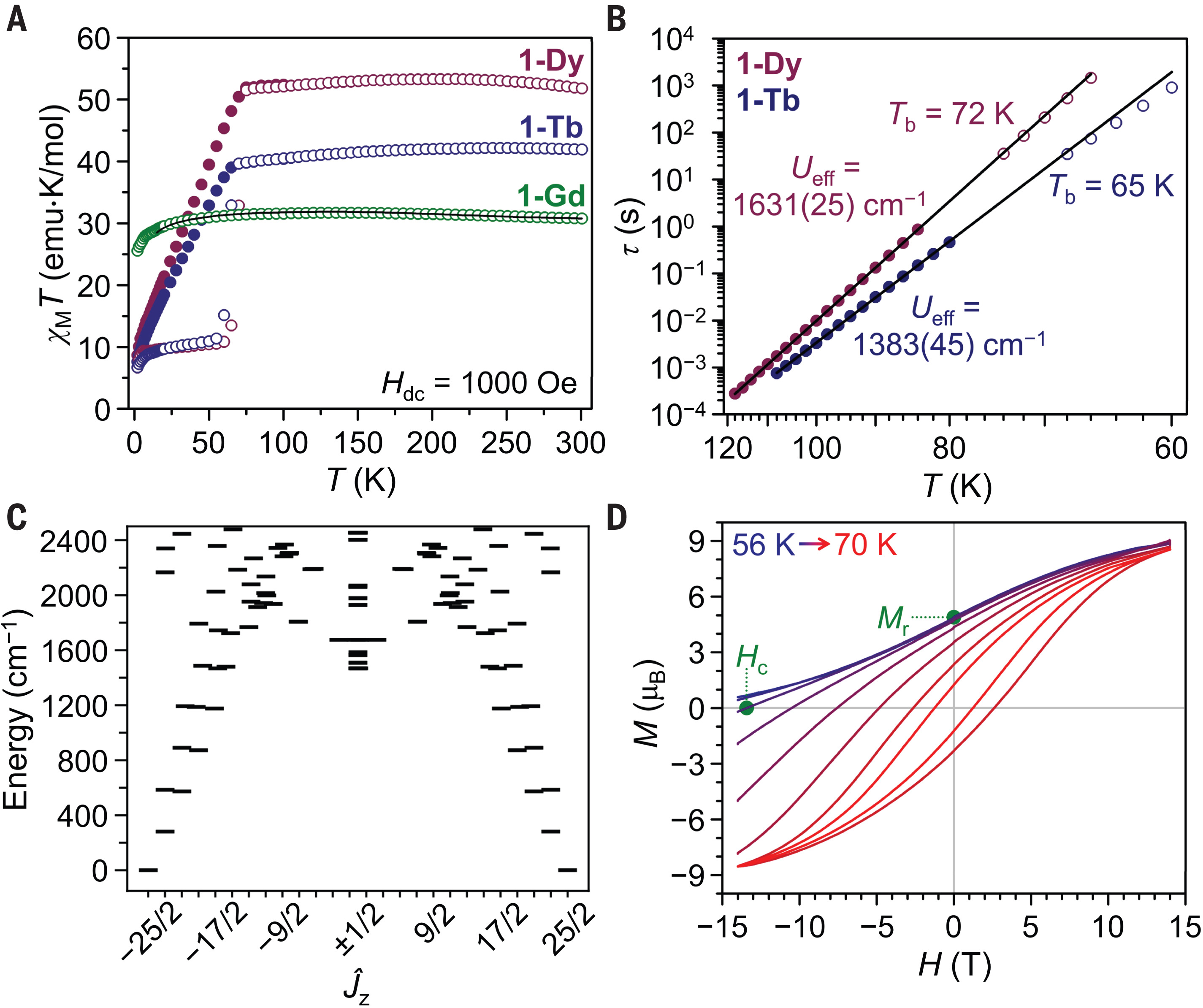
|
Lanthanide coordination compounds have attracted attention for their persistent magnetic properties near liquid nitrogen temperature, well above alternative molecular magnets. The authors report that introducing metal-metal bonding can enhance coercivity. Reduction of iodide-bridged terbium or dysprosium dimers resulted in a single electron bond between the metals, which enforced alignment of the other valence electrons. The resultant coercive fields exceeded 14 tesla below 50 and 60 kelvin for the terbium and dysprosium compounds, respectively. |
COLIN A. GOULD, K. RANDALL MCCLAIN, DANIEL RETA, JON
G. C. KRAGSKOW, AVID A. MARCHIORI, ELLA LACHMAN, XEUN-SANG CHOI,
JAMES G. ANALYTIS, R. DAVID BRITT, NICHOLAS F. CHILTON, BENJAMIN
G. HARVEY, JEFFREY R. LONG,
Ultrahard magnetism from mixed-valence dilanthanide complexes with metal-metal bonding,
SCIENCE, 13 Jan 2022, Vol 375, Issue 6577, pp. 198-202
Analysis of vibronic coupling in a 4f molecular magnet with FIRMS
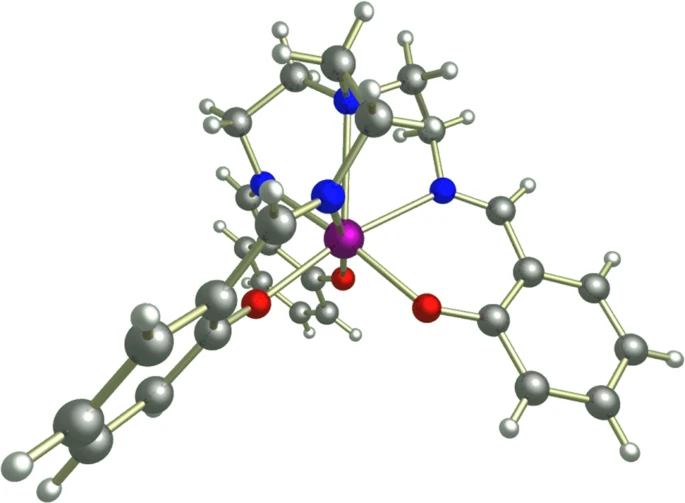
|
Vibronic coupling, the interaction between molecular vibrations and electronic states, is a fundamental effect that profoundly affects chemical processes. In the case of molecular magnetic materials, vibronic, or spin-phonon, coupling leads to magnetic relaxation, which equates to loss of magnetic memory and loss of phase coherence in molecular magnets and qubits, respectively. The study of vibronic coupling is challenging, and most experimental evidence is indirect. Here the authors employ far-infrared magnetospectroscopy to directly probe vibronic transitions in [Yb(trensal)] (where H3trensalâ=â2,2,2-tris(salicylideneimino)trimethylamine). The authors find intense signals near electronic states, which they show arise due to an âenvelope effectâ in the vibronic coupling Hamiltonian, which they calculate fully ab initio to simulate the spectra. The authors subsequently show that vibronic coupling is strongest for vibrational modes that simultaneously distort the first coordination sphere and break the C3 symmetry of the molecule. With this knowledge, vibrational modes could be identified and engineered to shift their energy towards or away from particular electronic states to alter their impact. Hence, these findings provide new insights towards developing general guidelines for the control of vibronic coupling in molecules. |
Jon G. C. Kragskow, Jonathan Marbey, Christian D. Buch, Joscha
Nehrkorn, Mykhaylo Ozerov, Stergios Piligkos, Stephen Hill,
Nicholas F. Chilton,
Analysis of vibronic coupling in a 4f molecular magnet with FIRMS,
Nature Communications volume 13, Article number: 825 (2022)
Exchange-induced spin polarization in a single magnetic molecule junction
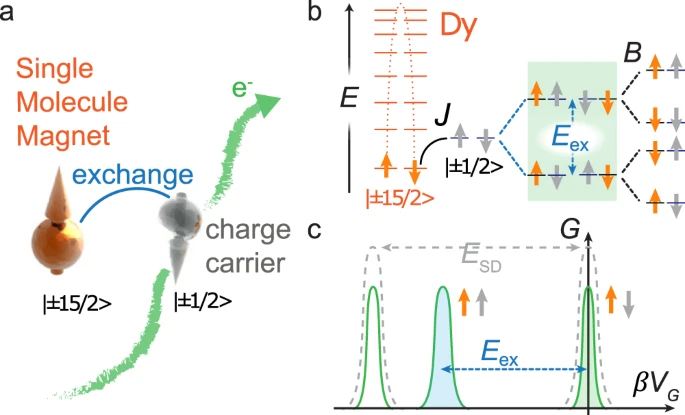
|
Many spintronic devices rely on the presence of spin-polarized currents at zero magnetic field. This is often obtained by spin exchange-bias, where an element with long-range magnetic order creates magnetized states and displaces the hysteresis loop. Here the authors demonstrate that exchange-split spin states are observable and usable in the smallest conceivable unit: a single magnetic molecule. The authors use a redox-active porphyrin as a transport channel, coordinating a dysprosium-based single-molecule-magnet inside a graphene nano-gap. Single-molecule transport in magnetic field reveals the existence of exchange-split channels with different spin-polarizations that depend strongly on the field orientation, and comparison with the diamagnetic isostructural compound and milikelvin torque magnetometry unravels the role of the single-molecule anisotropy and the molecular orientation. These results open a path to using spin-exchange in molecular electronics, and offer a method to quantify the internal spin structure of single molecules in multiple oxidation states. |
Tian Pei, James O. Thomas, Simen Sopp, Ming-Yee Tsang, Nicola
Dotti, Jonathan Baugh, Nicholas F. Chilton, Salvador
Cardona-Serra, Alejandro Gaita-Ariño, Harry L. Anderson, Lapo
Bogani,
Exchange-induced spin polarization in a single magnetic molecule junction,
Nature Communications volume 13, Article number: 4506 (2022)
Magnetic cooling: a molecular perspective
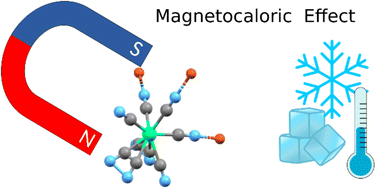
|
The magnetocaloriceffect is considered as an energy-efficient and environmentally friendly technique which can take cooling technology to the next level. Apart from its commercial application at room temperature, magnetic refrigeration is an up-and-coming solution for the cryogenic regime, especially as an alternative to He3 systems. Molecular magnets reveal advantageous features for ultra-low cooling which are competitive with intermetallic and lanthanide alloys. Here, we present a guide to the current status of magnetocaloric effect research of molecular magnets with a theoretical background focused on the inverse magnetocaloric effect and an overview of recent results and developments, including the rotating magnetocaloric effect. |
Piotr Konieczny, Wojciech Sas, Dominik Czernia, Aleksandra
Pacanowska, Magdalena Fitta, Robert PeĆka,
Magnetic cooling: a molecular perspective,
Dalton Trans., 2022,51, 12762-12780
Isolation of the elusive bisbenzimidazole Bbim3âË radical anion and its employment in a metal complex
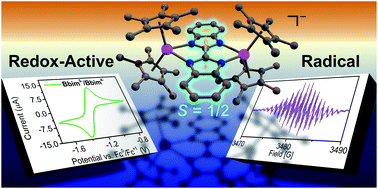
|
The discovery of singular organic radical ligands is a formidable challenge due to high reactivity arising from the unpaired electron. Matching radical ligands with metal ions to engender magnetic coupling is crucial for eliciting preeminent physical properties such as conductivity and magnetism that are crucial for future technologies. The metal-radical approach is especially important for the lanthanide ions exhibiting deeply buried 4f-orbitals. The radicals must possess a high spin density on the donor atoms to promote strong coupling. Combining diamagnetic 89Y (I = 1/2) with organic radicals allows for invaluable insight into the electronic structure and spin-density distribution. This approach is hitherto underutilized, possibly owing to the challenging synthesis and purification of such molecules. Herein, evidence of an unprecedented bisbenzimidazole radical anion (Bbim3âË) along with its metalation in the form of an yttrium complex, [K(crypt-222)][(Cp*2Y)2(ÎŒ-BbimË)] is provided. Access of BbimBbim3âË was feasible through double-coordination to the Lewis acidic metal ion and subsequent one-electron reduction, which is remarkable as Bbim2- was explicitly stated to be redox-inactive in closed-shell complexes. Two molecules containing Bbim2â (1) and BbimBbim3âË (2), respectively, were thoroughly investigated by X-ray crystallography, NMR and UV/Vis spectroscopy. Electrochemical studies unfolded a quasi-reversible feature and emphasize the role of the metal centre for the Bbim redox-activity as neither the free ligand nor the Bbim2- complex led to analogous CV results. Excitingly, a strong delocalization of the electron density through the Bbim3âË ligand was revealed via temperature-dependent EPR spectroscopy and confirmed through DFT calculations and magnetometry, rendering Bbim3âË an ideal candidate for single-molecule magnet design. |
Florian Benner and Selvan Demir,
Isolation of the elusive bisbenzimidazole Bbim3â. radical anion and its employment in a metal complex,
Chem. Sci., 2022,13, 5818-5829
[Co5Tp*4(Me2bta)6]: A Highly Symmetrical Pentanuclear Kuratowski Complex Featuring Tris(pyrazolyl)borate and Benzotriazolate Ligands
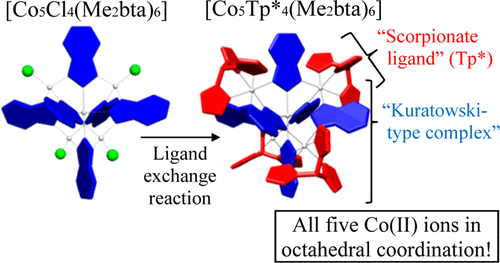
|
The pentanuclear Co(II) complex [Co 5 Tp* 4 (Me 2 bta) 6 ] containing N-donor ligands (5,6-dimethyl benzotriazolate; Me 2 bta 6 ) and N-donor capping ligands (tris(3,5-dimethyl-1-pyrazolyl)borate; Tp*) was prepared by a simple and efficient ligand exchange reaction from [Co 5 Cl 4 (Me 2 bta) 6 ] and tetra- n -butyl ammonium tris(3,5-dimethyl-1-pyrazolyl)borate. Compared to the precursor complex [Co 5 Cl 4 (Me 2 bta) 6 ], which contains one Co(II) ion in octahedral and four Co(II) ions in tetrahedral coordination geometry, the title compound features all five Co(II) ions in an octahedral coordination environment while keeping a high complex symmetry. This results in modified properties including improved solubility and distinct magnetic behavior as compared to the precursor complex. The molecular structure and phase purity of the compound was verified by XRPD, UVâvis, ESI-MS, IR, and NMR measurements. Thermal stability of the compound was determined via TGA. The magnetic properties of here reported novel complex [Co 5 Tp* 4 (Me 2 bta) 6 ] as well as its precursor [Co 5 Cl 4 (Me 2 bta) 6 ] were examined in detail via ESR and SQUID measurements, which indicated weak anti-ferromagnetic exchange interactions between high-spin Co(II) centers at T < 20 and 50 K, respectively. |
Tamas W. Werner, Stephan Reschke, Hana Bunzen, Hans-Albrecht
Krug von Nidda, Joachim Deisenhofer, Alois Loidl, and Dirk
Volkmer,
[Co5Tp*4(Me2bta)6]: A Highly Symmetrical Pentanuclear Kuratowski Complex Featuring Tris(pyrazolyl)borate and Benzotriazolate Ligands,
Inorg. Chem. 2016, 55, 3, 1053â1060
Spin-Electric Coupling with Anisotropy-Induced Vanishment and Enhancement in Molecular Ferroelectrics
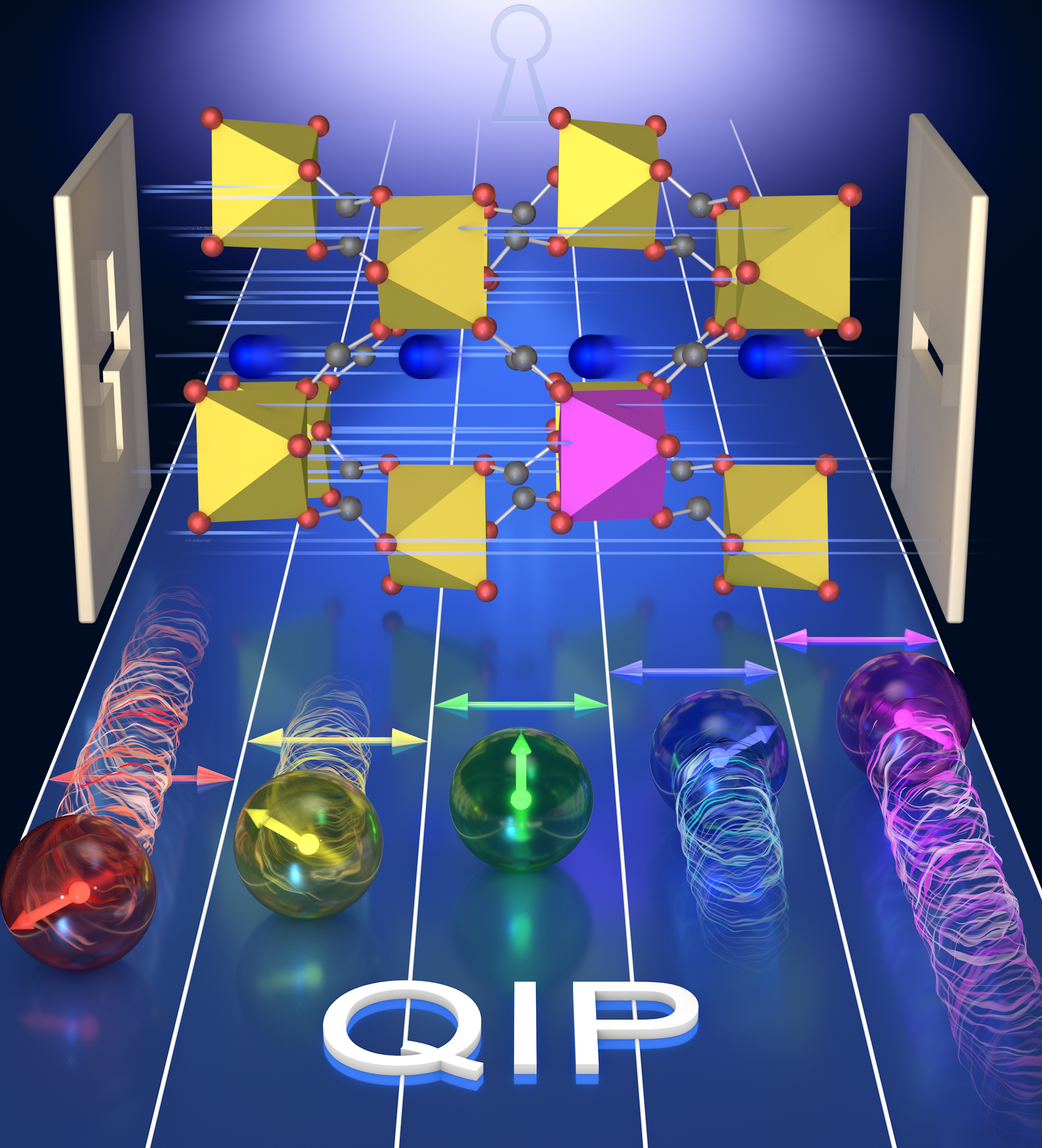
|
Manipulating quantum properties by electric fields using spin-electric coupling (SEC) effects promises spatial addressability. While several studies about inorganic materials showing the SEC functionality have been reported, the vastly tunable crystal structures of molecular ferroelectrics provide a range of rationally designable materials yet to be exploited. In this work, Mn2+-doped molecular ferroelectrics are chosen to experimentally demonstrate the feasibility of achieving the quantum coherent SEC effect in molecular ferroelectrics for the first time. The electric field pulse applied between Hahn-echo pulses in electron paramagnetic resonance (EPR) experiments causes controllable phase shifts via manipulating of the zero-field splitting (ZFS) of the Mn(II) ions. Detailed investigations of the aMn crystal showed unexpected SEC vanishment and enhancement at different crystal orientations, which were elucidated by studying the spin Hamiltonian and magnetic anisotropy. With the enhanced SEC efficiency being achieved (0.68 Hz m/V), this work discovers an emerging material library of molecular ferroelectrics to implement coherent quantum control with selective and tunable SEC effects toward highly scalable quantum gates. |
Yu-Hui Fang, Zheng Liu, Shen Zhou, Peng-Xiang Fu, Ye-Xin Wang,
Zi-Yu Wang, Zhe-Ming Wang, Song Gao, and Shang-Da Jiang,
Spin-Electric Coupling with Anisotropy-Induced Vanishment and Enhancement in Molecular Ferroelectrics,
J. Am. Chem. Soc. 2022, 144, 19, 8605â8612
A Complete Ab Initio View of Orbach and Raman SpinâLattice Relaxation in a Dysprosium Coordination Compound
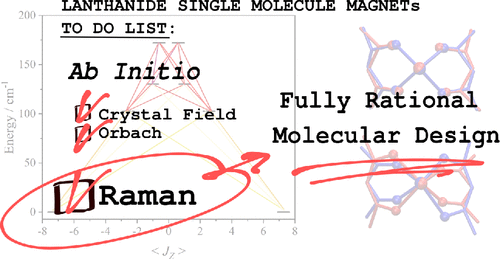
|
The unique electronic and magnetic properties of lanthanide molecular complexes place them at the forefront of the race toward high-temperature single-molecule magnets and magnetic quantum bits. The design of compounds of this class has so far being almost exclusively driven by static crystal field considerations, with an emphasis on increasing the magnetic anisotropy barrier. Now that this guideline has reached its maximum potential, a deeper understanding of spin-phonon relaxation mechanisms presents itself as key in order to drive synthetic chemistry beyond simple intuition. In this work, we compute relaxation times fully ab initio and unveil the nature of all spin-phonon relaxation mechanisms, namely Orbach and Raman pathways, in a prototypical Dy single-molecule magnet. Computational predictions are in agreement with the experimental determination of spin relaxation time and crystal field anisotropy, and show that Raman relaxation, dominating at low temperature, is triggered by low-energy phonons and little affected by further engineering of crystal field axiality. A comprehensive analysis of spin-phonon coupling mechanism reveals that molecular vibrations beyond the ionâs first coordination shell can also assume a prominent role in spin relaxation through an electrostatic polarization effect. Therefore, this work shows the way forward in the field by delivering a novel and complete set of chemically sound design rules tackling every aspect of spin relaxation at any temperature. |
Matteo Briganti, Fabio Santanni, Lorenzo Tesi, Federico Totti,
Roberta Sessoli, Alessandro Lunghi,
A Complete Ab Initio View of Orbach and Raman SpinâLattice Relaxation in a Dysprosium Coordination Compound,
J. Am. Chem. Soc. 2021, 143, 34, 13633â13645
A 9.2-GHz clock transition in a Lu(II) molecular spin qubit arising from a 3,467-MHz hyperfine interaction
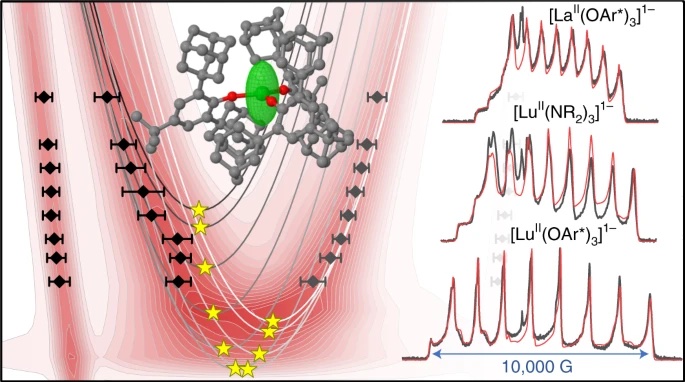
|
Spins in molecules are particularly attractive targets for next-generation quantum technologies, enabling chemically programmable qubits and potential for scale-up via self-assembly. Here we report the observation of one of the largest hyperfine interactions for a molecular system, Aisoâ=â3,467â±â50âMHz, as well as a very large associated clock transition. This is achieved through chemical control of the degree of s-orbital mixing into the spin-bearing d orbital associated with a series of spin-Âœ La(II) and Lu(II) complexes. Increased s-orbital character reduces spinâorbit coupling and enhances the electronânuclear Fermi contact interaction. Both outcomes are advantageous for quantum applications. The former reduces spinâlattice relaxation, and the latter maximizes the hyperfine interaction, which, in turn, generates a 9-GHz clock transition, leading to an increase in phase memory time from 1.0â±â0.4 to 12â±â1âÎŒs for one of the Lu(II) complexes. These findings suggest strategies for the development of molecular quantum technologies, akin to trapped ion systems. |
Krishnendu Kundu, Jessica R. K. White, Samuel A. Moehring, Jason
M. Yu, Joseph W. Ziller, Filipp Furche, William J. Evans,
Stephen Hill,
A 9.2-GHz clock transition in a Lu(II) molecular spin qubit arising from a 3,467-MHz hyperfine interaction,
Nature Chemistry 14, 392â397 (2022)
see also: Eric J. L. McInnes, Molecular spins clock in,
Nature Chemistry volume 14, 361â362 (2022)
Ultra-narrow optical linewidths in rare-earth molecular crystals
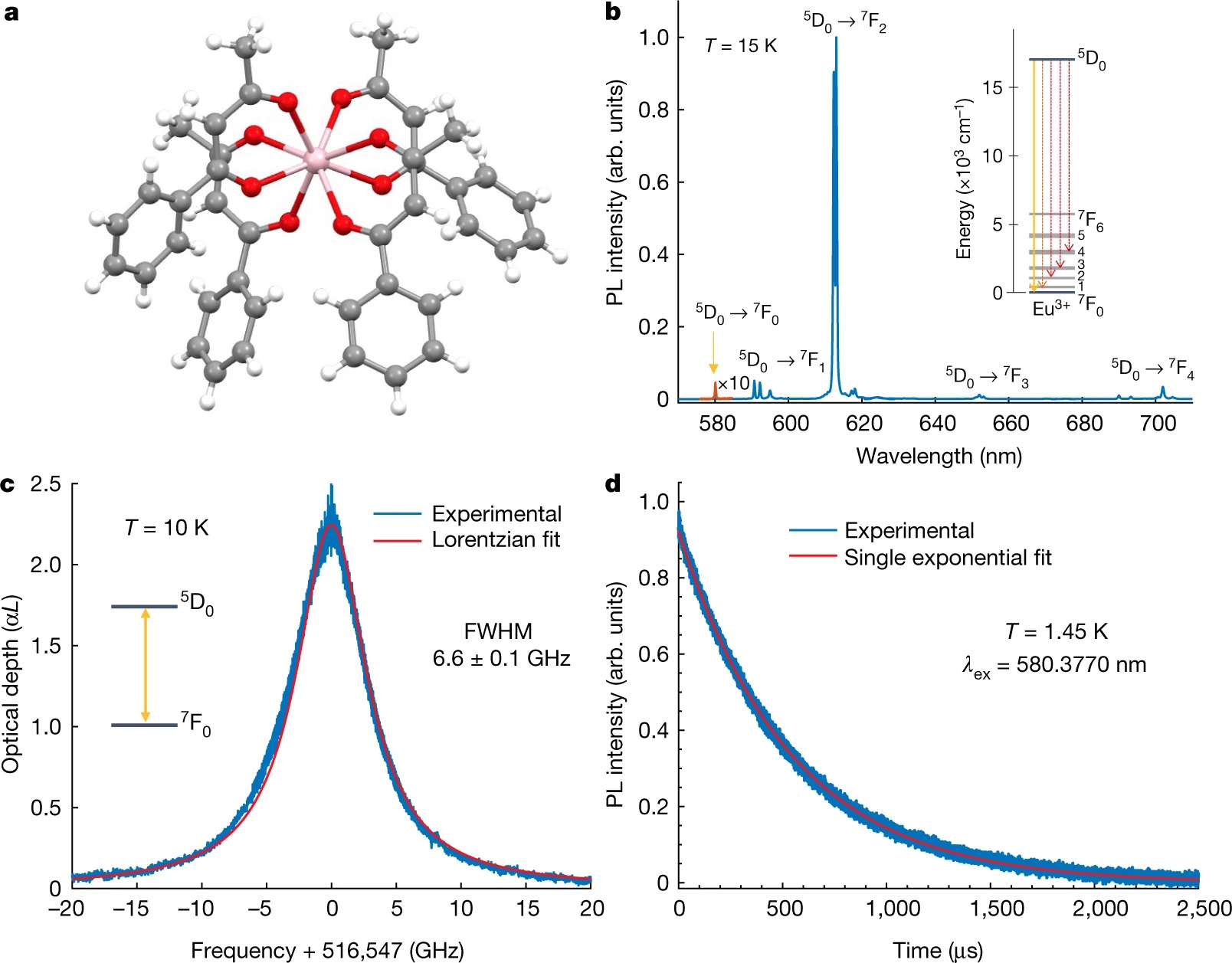
|
Rare-earth ions (REIs) are promising solid-state systems for building lightâmatter interfaces at the quantum level. This relies on their potential to show narrow optical and spin homogeneous linewidths, or, equivalently, long-lived quantum states. This enables the use of REIs for photonic quantum technologies such as memories for light, opticalâmicrowave transduction and computing. However, so far, few crystalline materials have shown an environment quiet enough to fully exploit REI properties. This hinders further progress, in particular towards REI-containing integrated nanophotonics devices. Molecular systems can provide such capability but generally lack spin states. If, however, molecular systems do have spin states, they show broad optical lines that severely limit optical-to-spin coherent interfacing. Here the authors report on europium molecular crystals that exhibit linewidths in the tens of kilohertz range, orders of magnitude narrower than those of other molecular systems. The authors harness this property to demonstrate efficient optical spin initialization, coherent storage of light using an atomic frequency comb, and optical control of ionâion interactions towards implementation of quantum gates. These results illustrate the utility of rare-earth molecular crystals as a new platform for photonic quantum technologies that combines highly coherent emitters with the unmatched versatility in composition, structure and integration capability of molecular materials. |
Diana Serrano, Senthil Kumar Kuppusamy, BenoĂźt Heinrich, Olaf
Fuhr, David Hunger, Mario Ruben, Philippe Goldner,
Ultra-narrow optical linewidths in rare-earth molecular crystals,
Nature 603, 241â246 (2022)
Ultrahard magnetism from mixed-valence dilanthanide complexes with metal-metal bonding
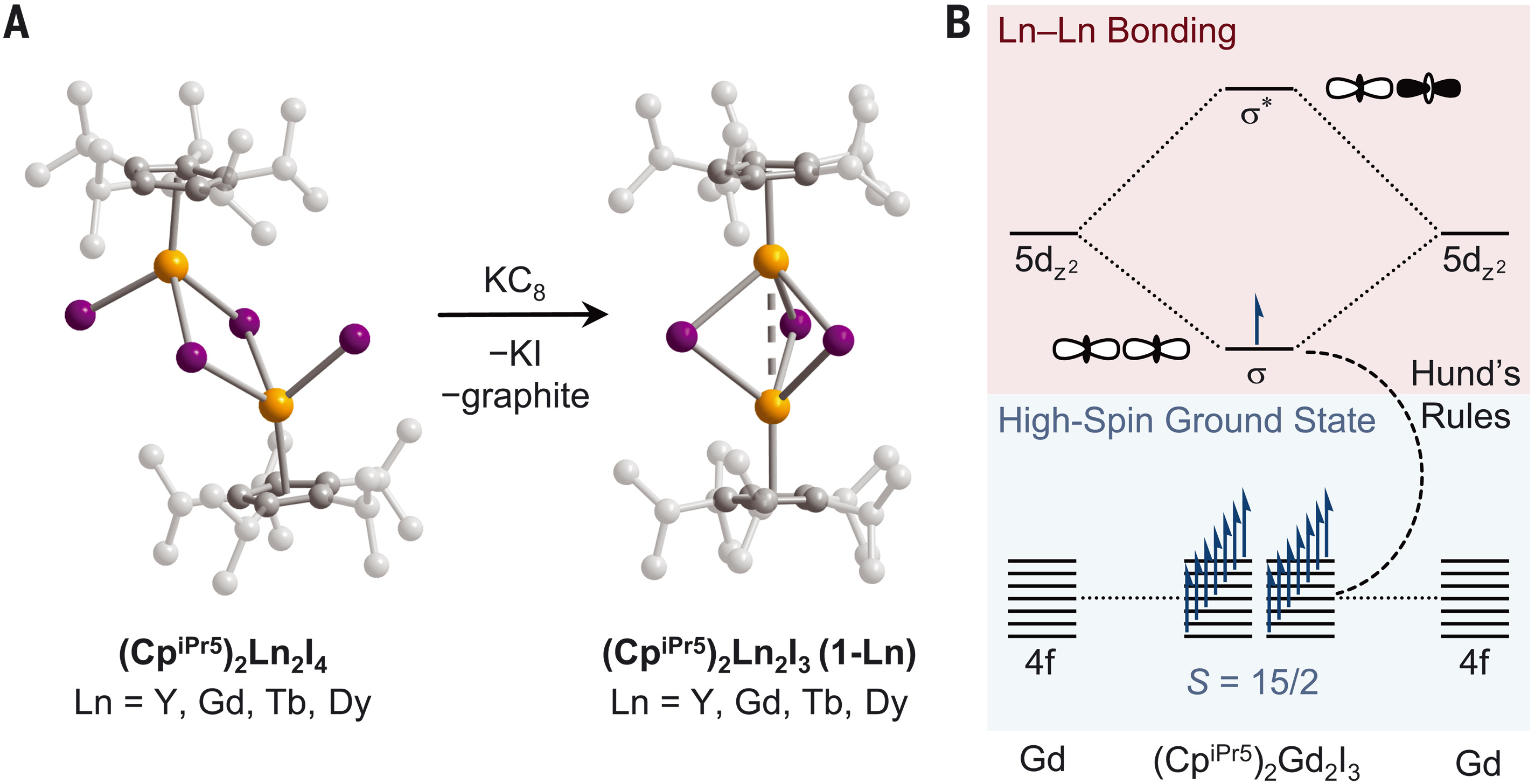
|
Metal-metal bonding interactions can engender outstanding magnetic properties in bulk materials and molecules, and examples abound for the transition metals. Extending this paradigm to the lanthanides, in this article the authors report mixed-valence dilanthanide complexes (CpiPr5)2Ln2I3 (Ln is Gd, Tb, or Dy; CpiPr5, pentaisopropylcyclopentadienyl), which feature a singly occupied lanthanide-lanthanide Ï-bonding orbital of 5dz2 parentage, as determined by structural, spectroscopic, and computational analyses. Valence delocalization, wherein the d electron is equally shared by the two lanthanide centers, imparts strong parallel alignment of the Ï-bonding and f electrons on both lanthanides according to Hundâs rules. The combination of a well-isolated high-spin ground state and large magnetic anisotropy in (CpiPr5)2Dy2I3 gives rise to an enormous coercive magnetic field with a lower bound of 14 tesla at temperatures as high as 60 kelvin. |
COLIN A. GOULD, RANDALL MCCLAIN, DANIEL RETA, JON
G. C. KRAGSKOW, DAVID A. MARCHIORI, ELLA LACHMAN, XEUN-SANG
CHOI, JAMES G. ANALYTIS, R. DAVID BRITT, NICHOLAS F. CHILTON,
BENJAMIN G. HARVEY, JEFFREY R. LONG,
Ultrahard magnetism from mixed-valence dilanthanide complexes with metal-metal bonding,
SCIENCE 375, 198-202 (2022)
Hierarchical Assembly of Coordination Macromolecules with Atypical Geometries: Gd 44 Co 28 Crown and Gd 95 Co 60 Cage

|
The discovered giant clusters are always highly symmetric owing to the spontaneous assembly of one or two basic units. The authors report the Gd 44 Co 28 crown and Gd 95 Co 60 cage, formulated as [Gd 44 Co 28 (IDA) 20 (OH) 72 (CO 3 ) 12 (OAc) 28 (H 2 O) 64 ]â (ClO 4 ) 24 and [Na 4 Gd 95 Co 60 (IDA) 40 (OH) 150 (CO 3 ) 40 (OAc) 58 (H 2 O) 164 ]ââ â(ClO 4 ) 41 (H 2 IDA=iminodiacetic acid), respectively, by providing a library containing multiple low-nuclearity units. The heart-like units and crown-like tetramer found in both compounds indicate unprecedented assembly levels, leading to an atypical geometry characteristic compared to the giant clusters directly assembled by regular units. These two clusters not only significantly increase the size of LnâCo clusters but also exhibit the enhanced magnetic entropy change at ultra-low temperatures. This work provided an effective way to fabricate cluster compounds with giant size and geometry complexity simultaneously. |
Ming-Hao Du, Dong-Hui Wang, Ling-Wei Wu, Lin-Peng Jiang,
Jun-Ping Li, La-Sheng Long, Lan-Sun Zheng,
Xiang-Jian Kong,
Hierarchical Assembly of Coordination Macromolecules with Atypical Geometries: Gd
44
Co
28
Crown and Gd
95
Co
60
Cage,
Angew. Chem. Int. Ed. (2022) in print
High-Performance Luminescence Thermometer with Field-Induced Slow Magnetic Relaxation Based on a Heterometallic Cyanido- Bridged 3dâ4f Complex
|
|
The 1:1:1 reaction of DyCl 3 ·6H 2 O, K 3 [Co(CN) 6 ] and bpyO 2 in H 2 O has provided access to a complex with formula [DyCo(CN) 6 (bpyO 2 ) 2 (H 2 O) 3 ]·4H 2 O ( 1 ) in a very good yield, while [DyFe(CN) 6 (bpyO 2 ) 2 (H 2 O) 3 ]·4H 2 O ( 2 ) was also precipitated (also in a high yield) using K 3 [Fe(CN) 6 ] instead of K 3 [Co(CN) 6 ]. Their structures have been determined by single-crystal X-ray crystallography and characterized based on elemental analyses and IR spectra. Combined direct current (dc) and alternating current (ac) magnetic susceptibility revealed slow magnetic relaxation upon application of a dc field. ÎŒ-SQUID measurements and CASSCF calculations revealed high-temperature relaxation dynamics for both compounds. Low-temperature magnetic studies show the relaxation characteristics for 1 , while for compound 2 the dynamics corresponds to an antiferromagnetically coupled Dy···Fe pair. High-resolution optical studies have been carried out to investigate the performance of compounds 1 and 2 as luminescence thermometers. For 1 , a maximum thermal sensitivity of 1.84% K â1 at 70 K has been calculated, which is higher than the acceptable sensitivity boundary of 1% K â1 for high-performance luminescence thermometers in a broad range of temperature between 40 and 140 K. Further optical studies focused on the chromaticity diagram of compound 1 revealed a temperature shift from warm white (3200 K) at 10 K toward a more natural white color near 4000 K at room temperature. |
Vassilis Tangoulis, Vassilis Nastopoulos, Nikos Panagiotou,
Anastasios Tasiopoulos, Grigorios Itskos, Modestos Athanasiou,
Eufemio Moreno-Pineda, Wolfgang Wernsdorfer, Michael Schulze,
Ondrej Malina,
High-Performance Luminescence Thermometer with Field-Induced Slow Magnetic Relaxation Based on a Heterometallic Cyanido- Bridged 3dâ4f Complex,
Inorg. Chem. (2022) in print
Implementation of Quantum Level Addressability and Geometric Phase Manipulation in Aligned Endohedral Fullerene Qudits
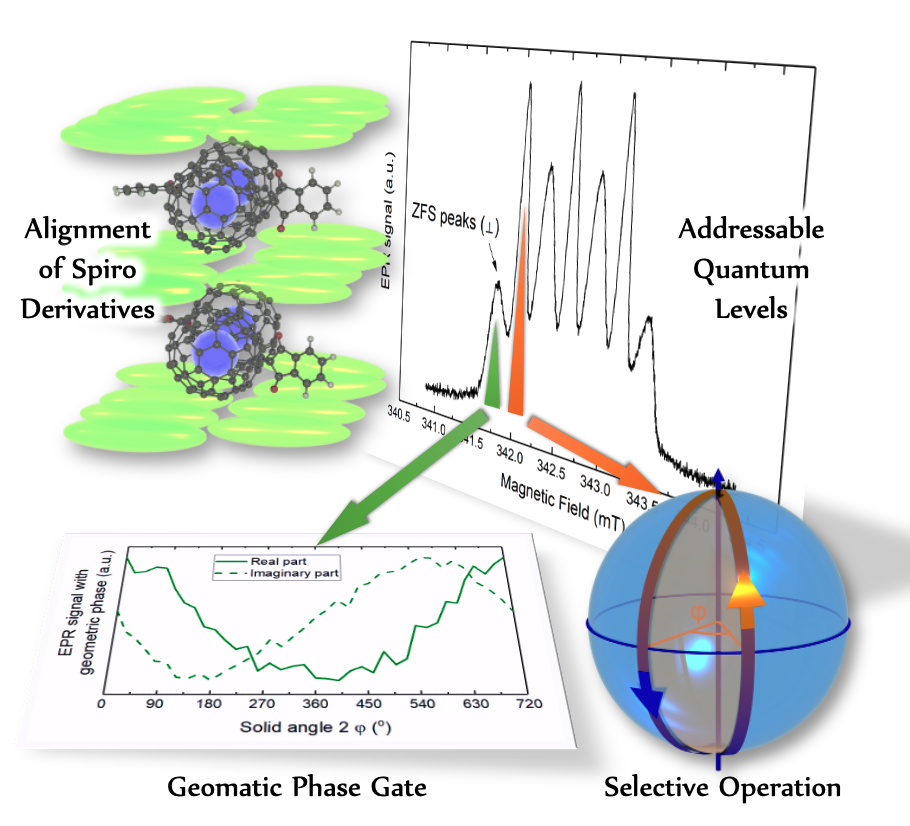
|
Endohedral nitrogen fullerenes have been proposed as building blocks for quantum information processing due to their long spin coherence time. However, addressability of the individual electron spin levels in such a multiplet system of 4S3/2 has never been achieved because of the molecular isotropy and transition degeneracy among the Zeeman levels. Herein, by molecular engineering, the authors lifted the degeneracy by zero-field splitting effects and made the multiple transitions addressable by a liquid-crystal-assisted method. The endohedral nitrogen fullerene derivatives with rigid addends of spiro structure and large aspect ratios of regioselective bis-addition improve the ordering of the spin ensemble. These samples empower endohedral-fullerene-based qudits, in which the transitions between the 4 electron spin levels were respectively addressed and coherently manipulated. The quantum geometric phase manipulation, which has long been proposed for the advantages in error tolerance and gating speed, was implemented in a pure electron spin system using molecules for the first time. |
Dr. Shen Zhou, Jiayue Yuan, Zi-Yu Wang, Kun Ling, Peng-Xiang Fu,
Yu-Hui Fang, Dr. Ye-Xin Wang, Dr. Zheng Liu, Prof. Kyriakos
Porfyrakis, Prof. G. Andrew D. Briggs, Prof. Song Gao,
Prof. Shang-Da Jiang,
Implementation of Quantum Level Addressability and Geometric Phase Manipulation in Aligned Endohedral Fullerene Qudits,
Angew. Chem. Int. Ed. (2021) early view
Heterospin frustration in a metal-fullerene-bonded semiconductive antiferromagnet
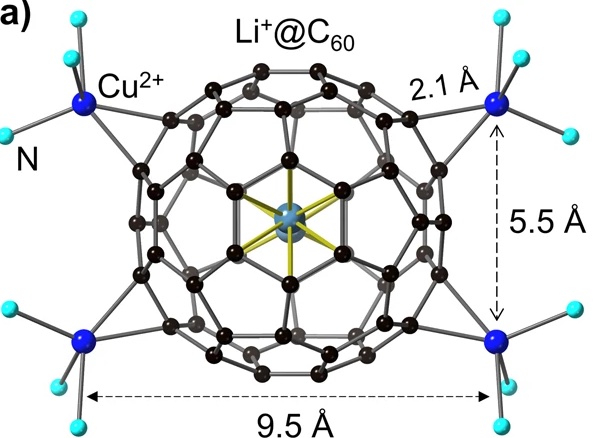
|
Lithium-ion-encapsulated fullerenes (Li+@C60) are 3D superatoms with rich oxidative states. Here the authors show a conductive and magnetically frustrated metalâfullerene-bonded framework {[Cu4(Li@C60)(L)(py)4](NTf2)(hexane)}n (1) (Lâ=â1,2,4,5-tetrakis(methanesulfonamido)benzene, py = pyridine, NTf2â = bis(trifluoromethane)sulfonamide anion) prepared from redox-active dinuclear metal complex Cu2(L)(py)4 and lithium-ion-encapsulated fullerene salt (Li+@C60)(NTf2â). Electron donor Cu2(L)(py)2 bonds to acceptor Li+@C60 via eight CuâC bonds. CuâC bond formation stems from spontaneous charge transfer (CT) between Cu2(L)(py)4 and (Li+@C60)(NTf2â) by removing the two-terminal py molecules, yielding triplet ground state [Cu2(L)(py)2]+(Li+@C60âąâ), evidenced by absorption and electron paramagnetic resonance (EPR) spectra, magnetic properties and quantum chemical calculations. Moreover, Li+@C60âąâ radicals (Sâ=âÂœ) and Cu2+ ions (Sâ=âÂœ) interact antiferromagnetically in triangular spin lattices in the absence of long-range magnetic ordering to 1.8âK. The low-temperature heat capacity indicated that compound 1 is a potential candidate for an Sâ=âÂœ quantum spin liquid (QSL). |
Yongbing Shen, Mengxing Cui, Shinya Takaishi, Hideyuki Kawasoko,
Kunihisa Sugimoto, Takao Tsumuraya, Akihiro Otsuka, Eunsang
Kwon, Takefumi Yoshida, Norihisa Hoshino, Kazuhiko Kawachi,
Yasuhiko Kasama, Tomoyuki Akutagawa, Tomoteru Fukumura,
Masahiro Yamashita,
Heterospin frustration in a metal-fullerene-bonded semiconductive antiferromagnet,
Nature Communications volume 13, Article number: 495 (2022)
Iron oxides at large scales

|
Dissolution of FeBr3 in a mixture of acetonitrile and 3,4-lutidine in the presence of an amine results in the formation of an [Fe30] molecular metal oxide containing alternating layers of tetrahedral and octahedral FeIII ions. Mass spectrometry suggests the cluster is formed quickly and remains stable in solution, while magnetic measurements and DFT calculations reveal competing antiferromagnetic exchange interactions. |
Alice E. Dearle, Daniel J. Cutler,
Marco Coletta, Edward Lee, Sourav Dey, Sergio Sanz, Hector
W. L. Fraser, Gary S. Nichol, Gopalan Rajaraman, Jürgen
Schnack, Leroy Cronin, Euan K. Brechin,
An [FeIII30] molecular metal oxide,
Chem. Commun., 2022,58, 52-55
A rare earth metallocene containing a 2,2âČ-azopyridyl radical anion
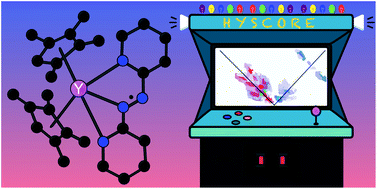
|
Introducing spin onto organic ligands that are coordinated to rare earth metal ions allows direct exchange with metal spin centres. This is particularly relevant for the deeply buried 4f-orbitals of the lanthanide ions that can give rise to unparalleled magnetic properties. For efficacy of exchange coupling, the donor atoms of the radical ligand require high-spin density. Such molecules are extremely rare owing to their reactive nature that renders isolation and purification difficult. Here, we demonstrate that a 2,2âČ-azopyridyl (abpy) radical (S = 1/2) bound to the rare earth metal yttrium can be realized. This molecule represents the first rare earth metal complex containing an abpy radical and is unambigously characterized by X-ray crystallography, NMR, UV-Vis-NIR, and IR spectroscopy. In addition, the most stable isotope 89Y with a natural abundance of 100% and a nuclear spin of Âœ allows an in-depth analysis of the yttriumâradical complex via EPR and HYSCORE spectroscopy. Further insight into the electronic ground state of the radical azobispyridine-coordinated metal complex was realized through unrestricted DFT calculations, which suggests that the unpaired spin density of the SOMO is heavily localized on the azo and pyridyl nitrogen atoms. The experimental results are supported by NBO calculations and give a comprehensive picture of the spin density of the azopyridyl ancillary ligand. This unexplored azopyridyl radical anion in heavy element chemistry bears crucial implications for the design of molecule-based magnets particularly comprising anisotropic lanthanide ions. |
Francis Delano IV, Ernesto Castellanos, John McCracken, Selvan Demir,
A rare earth metallocene containing a 2,2âČ-azopyridyl radical anion,
Chem. Sci., 2021,12, 15219-15228
Organometallic lanthanide bismuth cluster single-molecule magnets
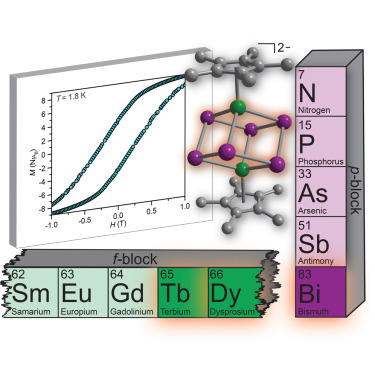
|
Single-molecule magnets (SMMs) are molecules that can retain magnetic polarization in the absence of an external magnetic field and embody the ultimate size limit for spin-based information storage and processing. Multimetallic lanthanide complexes lacking magnetic exchange coupling enable fast relaxation pathways that attenuate the full potential of these species. Employment of diamagnetic heavy main group elements with diffuse orbitals may lead to unprecedented strong coupling. Herein, two bismuth-cluster-bridged lanthanide complexes, [K(THF)4]2[Cpâ2Ln2Bi6] (Cpâ = pentamethylcyclopentadienyl; 1-Ln, Ln = Tb, Dy), were synthesized via a solution organometallic approach. The neutral [Ln2Bi6] heterometallocubane core features lanthanide centers that are bridged by a rare Bi66â Zintl ion, which supports strong ferromagnetic interactions between lanthanides. This affords the rare observation of magnetic blocking and open hysteresis loops for superexchange-coupled SMMs comprising solely lanthanide ions. Both compounds constitute the first SMMs containing bismuth donors paving the way for promising synthetic targets for quantum computation. |
Peng Zhang, Florian Benner, Nicholas F. Chilton, Selvan Demir,
Organometallic lanthanide bismuth cluster single-molecule magnets,
Chem (2021)
Electronic control of strong magnetic anisotropy in Co-based single-molecule magnets
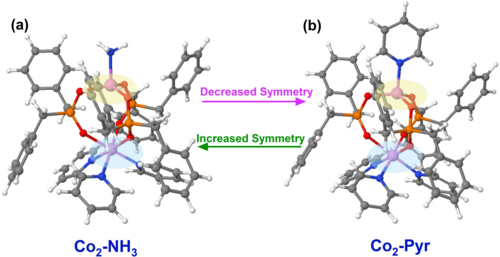
|
The observation of large swings in the magnetic anisotropy in ligated Co2 dimers has motivated further calculations on single-center Co qubits in quasitetrahedral and quasioctahedral symmetries. In all cases results of the authors indicate that it is the creation of an unquenched orbital moment due to a half-occupied frontier state at the Co center that directly drives large changes in the magnetic anisotropy barriers regardless of whether it is through symmetry breaking, a change in the charge state, or orbital energy reordering. While these observations are computationally demonstrated through the results on both monomers and dimers, the origin of orbital reordering at the Fermi level is not describable in terms of single physical changes. For example, in ligated Co2 the appearance of an unquenched orbital moment in one of the Co centers is correlated with a change from antiferromagnetic to ferromagnetic ordering at an energy that is uncharacteristically high for such transitions. Because this raises the spector of electromagnetically switchable quantum devices that operate at higher temperatures relative to that of the first-generation magnetic qubits, the authors carefully discuss subtle details associated with single-center qubits in realistic atomistic environments. |
Zahra Hooshmand, Jie-Xiang Yu, Hai-Ping Cheng, and Mark R. Pederson,
Electronic control of strong magnetic anisotropy in Co-based single-molecule magnets,
Phys. Rev. B 104, 134411 (2021)
Generalized Heisenberg-Type Magnetic Phenomena in Coordination Polymers with Nickel-Lanthanide Dinuclear Units
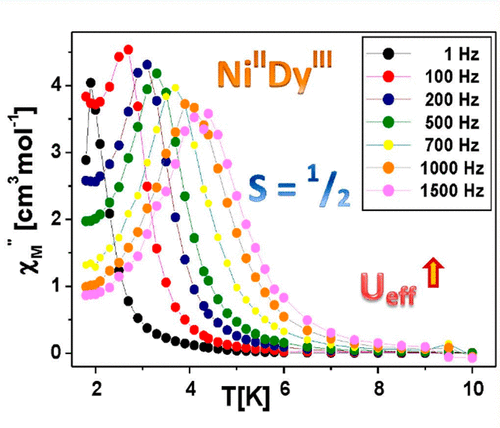
|
A new family of 3d-4f coordination polymers with the molecular formula [NiIILnIII(L)(dca)2(NO3)]n [Ln = Eu (1), Gd (2), Tb (3), Dy (4), and Ho (5); H2L = N,NâČ-bis(2-hydroxy-3-methoxy-5-methylbenzyl)homopiperazine; dca = dicyanamide] has been synthesized in search for new single-molecule magnet (SMM) materials containing highly anisotropic lanthanides. The magnetic properties of these materials have been established by DC and AC magnetometry and explained quantitatively by comprehensive phenomenological modeling based on a generalized Heisenberg-type model, hypothesized previously based on first-principles calculations. Single-crystal X-ray diffraction has shown that the compounds are isostructural, with lanthanide atoms occupying a nine-coordination site with muffin-like geometry and individual NiIIâLnIII units linked by dca anions. Other than the paramagnetic compound 1, 2â5 exhibit intra-unit ferromagnetic 3dâ4f interactions, favorable for a large spin ground state. A slow field-induced relaxation of magnetization has been observed in compound 4 (only), displaying a substantial energy barrier of Ueff/kB = 26.2(5) K, below 6 K. This is attributed to an easy-plane anisotropy and is consistent with the relaxation in systems with a Kramers ground state doublet and hyperfine interactions. |
MichaĆ Antkowiak, Mithun Chandra Majee, Manoranjan Maity,
Dhrubajyoti Mondal, Michalina Kaj, Monika LesiĂłw, Alina BieĆko,
Leeor Kronik, Muktimoy Chaudhury, and Grzegorz Kamieniarz,
Generalized Heisenberg-Type Magnetic Phenomena in Coordination Polymers with NickelâLanthanide Dinuclear Units,
J. Phys. Chem. C 2021, 125, 20, 11182â11196
Inorganic Approach to Stabilizing Nanoscale Toroidicity in a Tetraicosanuclear Fe18Dy6 Single Molecule Magnet
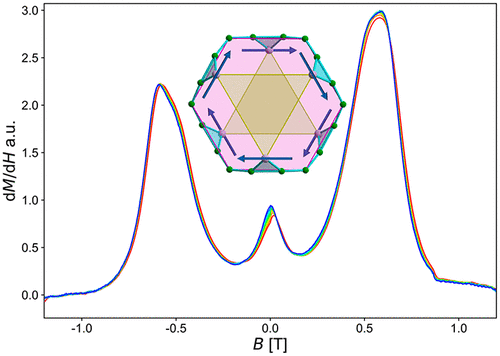
|
Cyclic coordination clusters (CCCs) are proving to provide an extra dimension in terms of exotic magnetic behavior as a result of their finite but cyclized chain structures. The Fe18Dy6 CCC is a Single Molecule Magnet with the highest nuclearity among Ln containing clusters. The three isostructural compounds [Fe18Ln6(Ό-OH)6(ampd)12(Hampd)12(PhCO2)24](NO3)6·38MeCN for Ln = DyIII (1), LuIII (2), or YIII (3), where H2ampd = 2-amino-2-methyl-1,3-propanediol, are reported. These can be described in terms of the cyclization of six {Fe3Ln(ΌOH)(ampd)2(Hampd)2(PhCO2)4}+ units with six nitrate counterions to give the neutral cluster. The overall structure consists of two giant Dy3 triangles sandwiching a strongly antiferromagnetically coupled Fe18 ring, leading to a toroidal arrangement of the anisotropy axis of the Dy ions, making this the biggest toroidal arrangement on a molecular level known so far. |
Hagen Kaemmerer, Amer Baniodeh, Yan Peng, Eufemio
Moreno-Pineda, Michael Schulze, Christopher E. Anson, Wolfgang
Wernsdorfer, Jürgen Schnack, and Annie K. Powell,
Inorganic Approach to Stabilizing Nanoscale Toroidicity in a Tetraicosanuclear Fe18Dy6 Single Molecule Magnet,
J. Am. Chem. Soc. 142 (2020) 14838
Cooperative Effects in Heterometallic Complexes
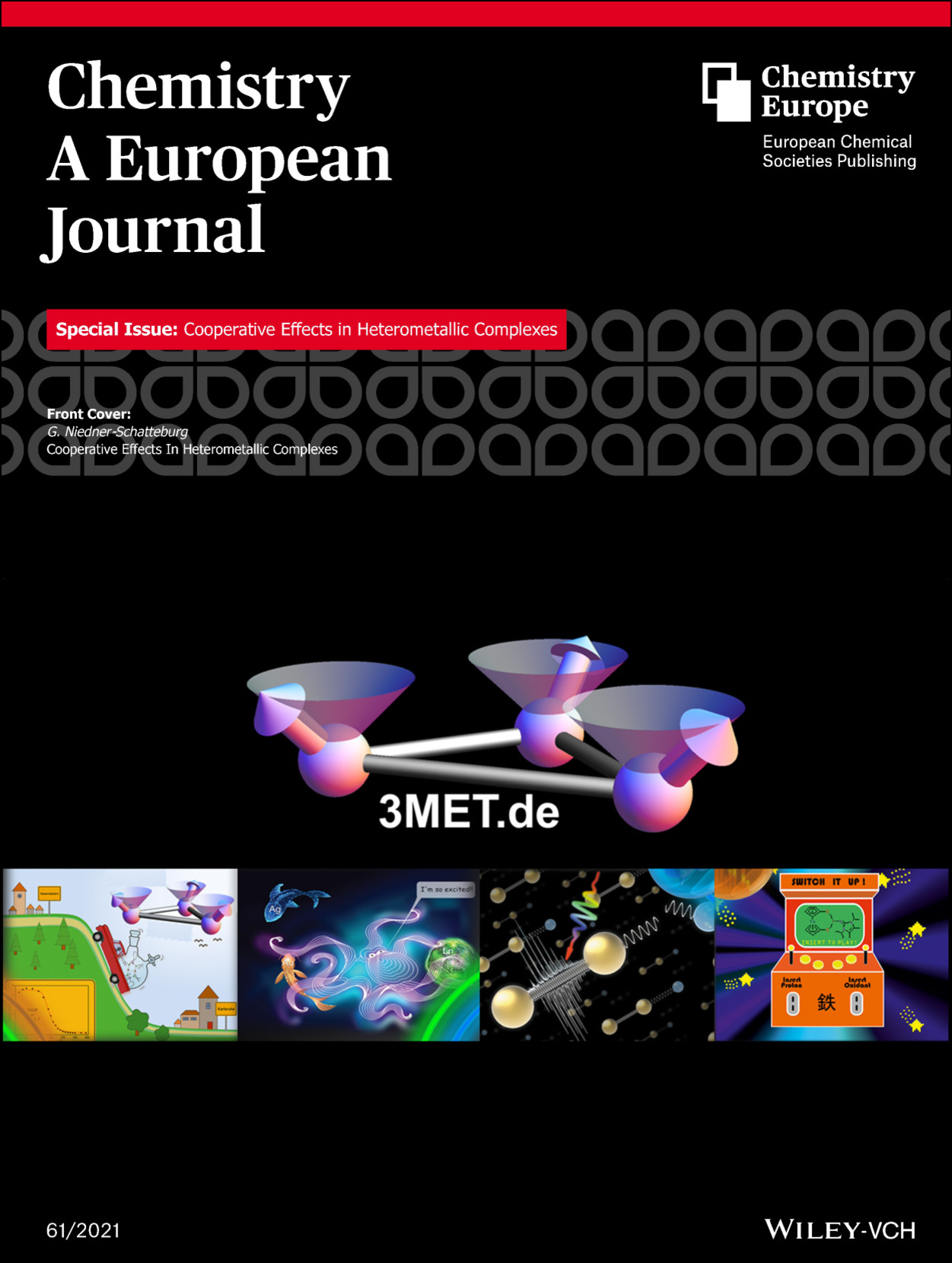
|
This special issue on âCooperative effects in heterometallic
complexesâ documents research focused on the synthesis,
physicochemical characterization, and theoretical description of
ligand-stabilized homo- and heterobimetallic complexes
containing only a few metal atoms â typically three. The authors call
them 3MET complexes in short - also to reflect the title of the
transregional collaborative research center 3MET.de founded in
2009 and located at the TU Kaiserslautern (TUK) and at the
Karlsruhe Institute of Technology (KIT).
Both fully coordinated and coordinatively unsaturatedspecies are of interest. In such 3MET complexes, the metalcenters are often bound by way of bridging ligands, whichfacilitate controlled variation of metal-to-metal distances andrelative orientations in order to characterize the correspondingstructure/property relations at a fundamental level. This in turnallows us to elucidate how metalâmetal interactions in multi-nuclear complexes and clusters comprising transition-metaland/or lanthanide atoms contribute to determining theirproperties. It also enables the identification of optimal systemsand properties for future applications in the contexts ofphotoactive materials, optoelectronics, magnetic informationstorage, quantum computing, and selective catalysis. The 3MET consortium classifies cooperative effects accord-ing to three overall categories: 1) Functional cooperativity: Metal atom A and metal atom B comprise individual function-alities. The complex AB combines these and enables a novelfunctionality. 2) Enthalpic cooperativity: typically three metalcenters interacting with a substrate may together significantlychange the pathway of a rearrangement and thereby reduce itsoverall activation barrier. This constitutes enthalpic cooperativ-ity if the joint decrease of the barrier is larger than that due tothe separate metal centers. More generally, three bodyenthalpic cooperativity is present if the total enthalpy of thethree-body system is determined by more than pairwisecontributions of its components. 3) Entropic cooperativity: inbiochemistry, this effect is known as allosteric interaction: pre-orientation of a substrate (by active centers A and B) facilitatesits activation (by a third center C). Such effects are also of relevance, e.g., on surfaces in the case of deposited complexes. |
Special Issue: Cooperative Effects in Heterometallic Complexes,
Chemistry - A European Journal, Volume 27, Issue 61 (2021)
Pages: 15014-15271
High nuclearity polyoxometalates
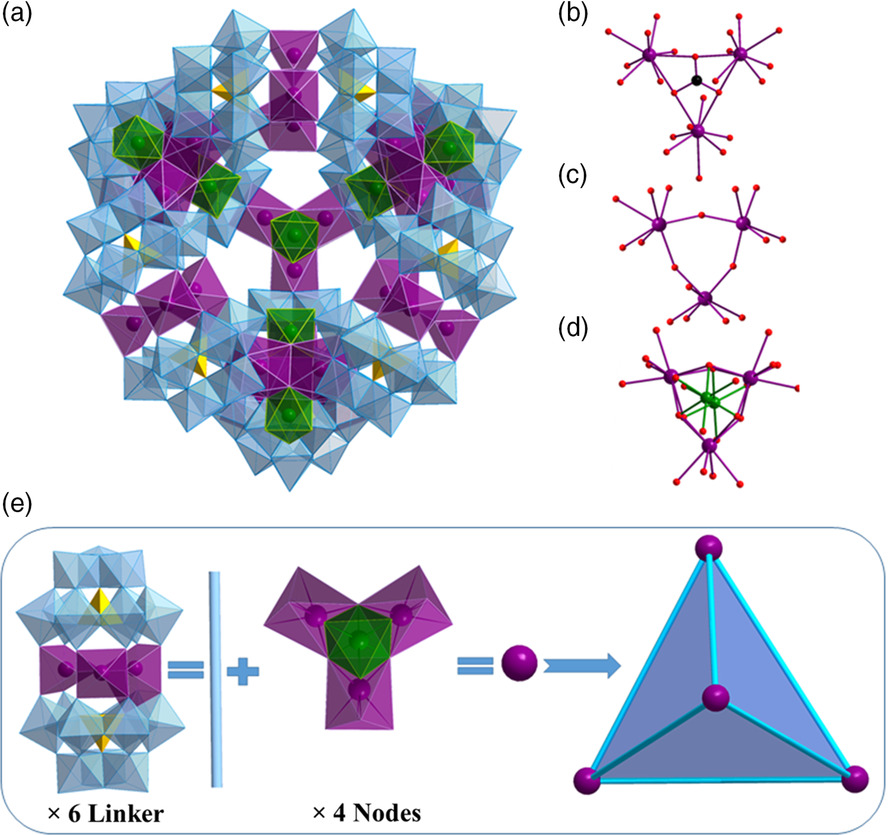
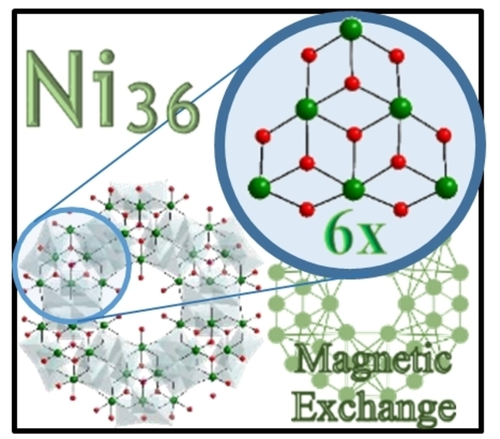
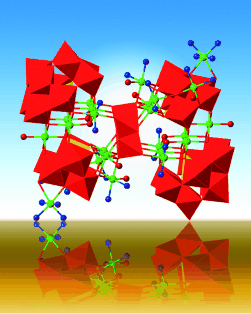
|
The syntheses and structures of a family of five new Ln/3d cluster containing polyoxometalates (POMs) [{(GeW9O34)2LnIII3(CO3)(OH2)3}6
{3MII2LnIII3(ÎŒ3-OH)6(OH2)6}4]50â
{Ln30M8}, where Lnâ=âGd or Y, and Mâ=âZn,
Mn, Co, are presented. This structural motif of a giant
tetrahedron contains {LnIII3} and
{MII2LnIII3}-cluster
units which are well-isolated within the diamagnetic
polyoxotungstate system. The magnetic properties of
{Gd30Mn8}, {Y30Mn8}
and {Gd30Zn8} can be successfully modeled
using a Heisenberg approach. Investigation of their
magnetocaloric effect (MCE) reveals that this can be tuned
through variation of the 3d metal ion. This is the first such
systematic study on heterometallic 3d-4f- POM clusters. The
{Gd30Zn8} analogue illustrates
a
promising
way
forward
to
magnetic
cooling
at
sub-Kelvin
temperatures.
Masooma Ibrahim, Yan Peng, Eufemio Moreno-Pineda, Christopher E. Anson, Jürgen Schnack, Annie K. Powell, Gd3 Triangles in a Polyoxometalate Matrix: Tuning Molecular Magnetocaloric Effects in {Gd30M88} Polyoxometalate/Cluster Hybrids Through Variation of M2+, small structures, Volume2, Issue10, October 2021, 2100052 The 36-NiII-containing 54-tungsto-6-silicate, [Ni36(OH)18(H2O)36(SiW9O34)6]6â (Ni36) was discovered and shown to contain more nickel centers than any other polyoxometalate (POMs) known to date. Polyanion Ni36 comprises six equivalent {NiII6SiW9} units which are linked by NiâOâW bridges forming a macrocyclic assembly. Magnetic studies indicate antiferromagnetic communication between the six {Ni6} subunits. Electrochemical studies indicate that the first reduction is reversible and associated to the WVI/V couple while the second reduction is irreversible and associated to the NiII/0 couple. Joydeb Goura, Bassem S. Bassil, Xiang Ma, Ananthu Rajan, Eufemio Moreno-Pineda, Jürgen Schnack, Masooma Ibrahim, Annie K. Powell, Mario Ruben, Jingjing Wang, Laurent Ruhlmann, Ulrich Kortz, NiII36-Containing 54-Tungsto-6-Silicate: Synthesis, Structure, Magnetic and Electrochemical Studies, Chemistry - A European Journal (2021) Early view
Degradation of multilacunary precursors
and the structure-directing effect of trilacunary Keggin
{B-α-PW9O34} fragments under hydrothermal
conditions in the presence of nickel ions result in formation
of the largest Ni-substituted poly(polyoxotungstate)s known to
date, which contain 20â22 Ni centers. The picture shows the
X-ray structure of Ni22-substituted polyanion [H6Ni22X4W34(OH)4O136(H2O)6-(enMe)10]4â
(enMe=1,2-diaminopropane).
Xin-Xiong Li, Shou-Tian Zheng, Jie Zhang, Wei-Hui
Fang, Guo-Yu Yang, Juan Modesto Clemente-Juan,
High-Nuclearity Ni-Substituted Polyoxometalates: A Series of Poly(polyoxotungstate)s Containing 20â22 Nickel Centers,
Chemistry - A European Journal (2021) Early view
|
Magnetic anisotropies of Ho(iii) and Dy(iii) single-molecule magnets experimentally determined via polarized neutron diffraction
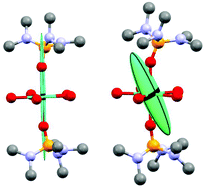
|
The authors present the magnetic anisotropy of two isostructural pentagonal-bipyramidal complexes, [Ln(H2O)5(HMPA)2]I3·2HMPA (HMPA = hexamethylphosphoramide, Ln = Dy, Ho). Using ac magnetic susceptibility measurements, we find magnetic relaxation barriers of 600 K and 270 K for the Dy- and Ho-compounds, respectively. This difference is supported by polarized neutron diffraction (PND) measured at 5 K and 1 T which provides the first experimental evidence that the transverse elements in the magnetic anisotropy of the Ho-analogue are significant, whereas the Dy-analogue has a near-axial magnetic anisotropy with vanishing transverse contributions. The coordination geometries of the two complexes are highly similar, and we attribute the loss of strong magnetic axiality as expressed in the atomic susceptibility tensors from PND, as well as the smaller relaxation barrier in the Ho-complex compared to the Dy-complex, to the less favorable interaction of the pentagonal bipyramidal crystal field with the characteristics of the Ho(III) 4f-charge distribution. |
Emil A. Klahn, Andreas M. Thiel, Rasmus B. Degn, Iurii
Kibalin, Arsen Gukassov, Claire Wilson, Angelos
B. Canaj, Mark Murrie, Jacob Overgaard,
Magnetic anisotropies of Ho(iii) and Dy(iii) single-molecule magnets experimentally determined via polarized neutron diffraction,
Dalton Trans., 2021, Advance Article
A dissymmetric [Gd2] coordination molecular dimer hosting six addressable spin qubits
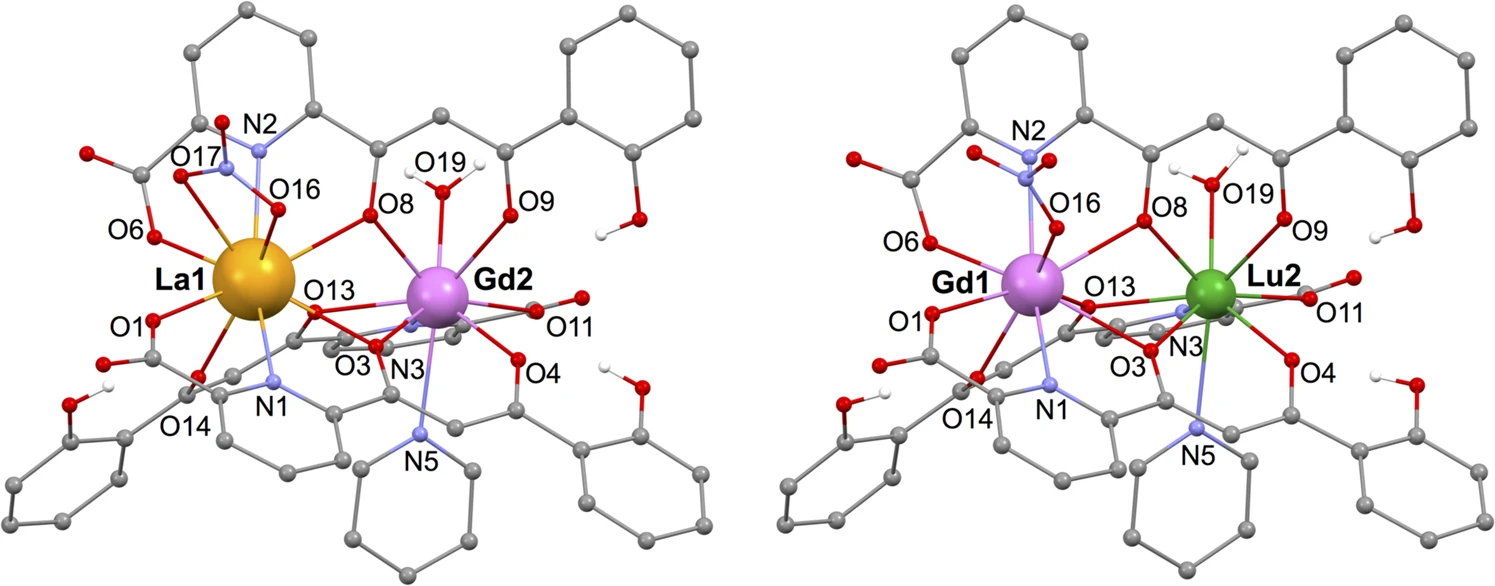
|
Artificial magnetic molecules can host several spin qubits, which could then implement small-scale algorithms. In order to become of practical use, such molecular spin processors need to increase the available computational space and warrant universal operations. Here, the authors design, synthesize and fully characterize dissymetric molecular dimers hosting either one or two Gadolinium(III) ions. The strong sensitivity of Gadolinium magnetic anisotropy to its local coordination gives rise to different zero-field splittings at each metal site. As a result, the [LaGd] and [GdLu] complexes provide realizations of distinct spin qudits with eight unequally spaced levels. In the [Gd2] dimer, these properties are combined with a Gd-Gd magnetic interaction, sufficiently strong to lift all level degeneracies, yet sufficiently weak to keep all levels within an experimentally accessible energy window. The spin Hamiltonian of this dimer allows a complete set of operations to act as a 64-dimensional all-electron spin qudit, or, equivalently, as six addressable qubits. Electron paramagnetic resonance experiments show that resonant transitions between different spin states can be coherently controlled, with coherence times TM of the order of 1âmicrosecond limited by hyperfine interactions. Coordination complexes with embedded quantum functionalities are promising building blocks for quantum computation and simulation hybrid platforms. |
Fernando Luis, Pablo J. Alonso, Olivier Roubeau, VerĂłnica
Velasco, David Zueco, David AguilĂ , JesĂșs I. MartĂnez, LeonĂ
A. Barrios, Guillem AromĂ,
A dissymmetric [Gd2] coordination molecular dimer hosting six addressable spin qubits,
Commun Chem 3, 176 (2020)
Measuring molecular magnets for quantum technologies
|
|
Single-molecule magnets (SMMs) have been proposed for applications in high-density storage, quantum simulation, quantum computing and spintronics applications. Bulk magnetometric and spectroscopic techniques of molecular systems have allowed the observation of remarkable quantum effects in SMMs, such as the observation of an energy barrier, the reversal of the magnetization and quantum tunnelling of the magnetization. Over the past 10 years, scanning tunnelling microscopy of SMMs and single-molecule devices architectures, such as spin valves and spin transistors, have shed light onto the quantum properties of SMMs at the single-molecule level. More recently, new techniques, where the spin degrees of freedom in SMMs can be read out by photons, are being studied. Here, the authors review key techniques allowing the observation of quantum effects, important for the initialization, control and readout of the states of the SMMs, ultimately leading to the implementation of SMMs in technological applications. |
Eufemio Moreno-Pineda, Wolfgang Wernsdorfer,
Measuring molecular magnets for quantum technologies,
Nat. Rev. Phys. (2021)
Principal component analysis of diffuse magnetic neutron scattering: a theoretical study
|
|
The authors present a theoretical study of the potential of principal component (PC) analysis to analyse magnetic diffuse neutron scattering data on quantum materials. To address this question, the authors simulate the scattering function S(q) for a model describing a cluster magnet with anisotropic spinâspin interactions under different conditions of applied field and temperature. The authors find high dimensionality reduction and that the algorithm can be trained with surprisingly small numbers of simulated observations. Subsequently, observations can be projected onto the reduced-dimensionality space defined by the learnt PCs. Constant-field temperature scans correspond to trajectories in this space which show characteristic bifurcations at the critical fields corresponding to ground-state phase boundaries. Such plots allow the ground-state phase diagram to be accurately determined from finite-temperature measurements. |
Robert Twyman, Stuart J. Gibson, James Molony, Jorge
Quintanilla,
Principal component analysis of diffuse magnetic neutron scattering: a theoretical study,
J. Phys.: Condens. Matter 33, 324002 (2021)
Point-group selection rules and universal momentum-transfer dependencies for inelastic neutron scattering on molecular spin clusters
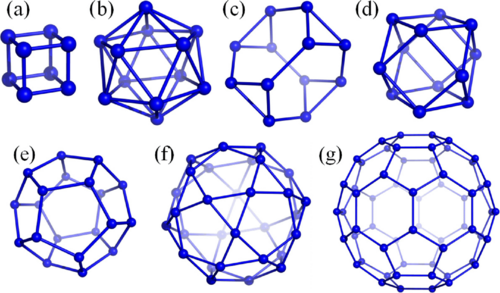
|
Recent significant progress in inelastic neutron scattering (INS) has rendered this technique even more useful for the characterization of magnetic systems, including molecular spin clusters. By so-called four-dimensional INS on single-crystal probes, excitation spectra can be recorded in large portions of momentum-transfer (Q) and energy-transfer (E) space. Spin-selection rules permit certain transitions between different spin multiplets. Additional selection rules can be imposed by point-group symmetry but were not discussed yet. As most synthetic spin clusters with interesting magnetic properties have high molecular symmetry, a clear understanding of this issue will be helpful for interpreting INS spectra. Here the author discusses point-group INS selection rules for magnetically isotropic or anisotropic spin clusters. Rings and a number of spin polyhedra with cubic or icosahedral symmetry are chosen as illustrative and relevant examples. These systems exhibit a significant number of point-group selection rules in isotropic spin models, and most of them maintain a smaller number of selection rules in anisotropic spin models. The author also explains how the Q dependence of certain excitations depends exclusively on the point-group symmetry of the states involved in the transition, an aspect that had thus far only been detailed for spin rings. The author provides the universal Q-dependent intensity functions (and their powder-averaged forms) for a set of polyhedra (cube, icosahedron, truncated tetrahedron, cuboctahedron, dodecahedron, icosidodecahedron, and truncated icosahedron). Overall, these results help to disentangle the relevant dynamical information contained in INS spectra from those features that are entirely determined by molecular symmetry. |
Shadan Ghassemi Tabrizi,
Point-group selection rules and universal momentum-transfer dependencies for inelastic neutron scattering on molecular spin clusters,
Phys. Rev. B 103, 214422
Spectral Addressability in a Modular Two Qubit System
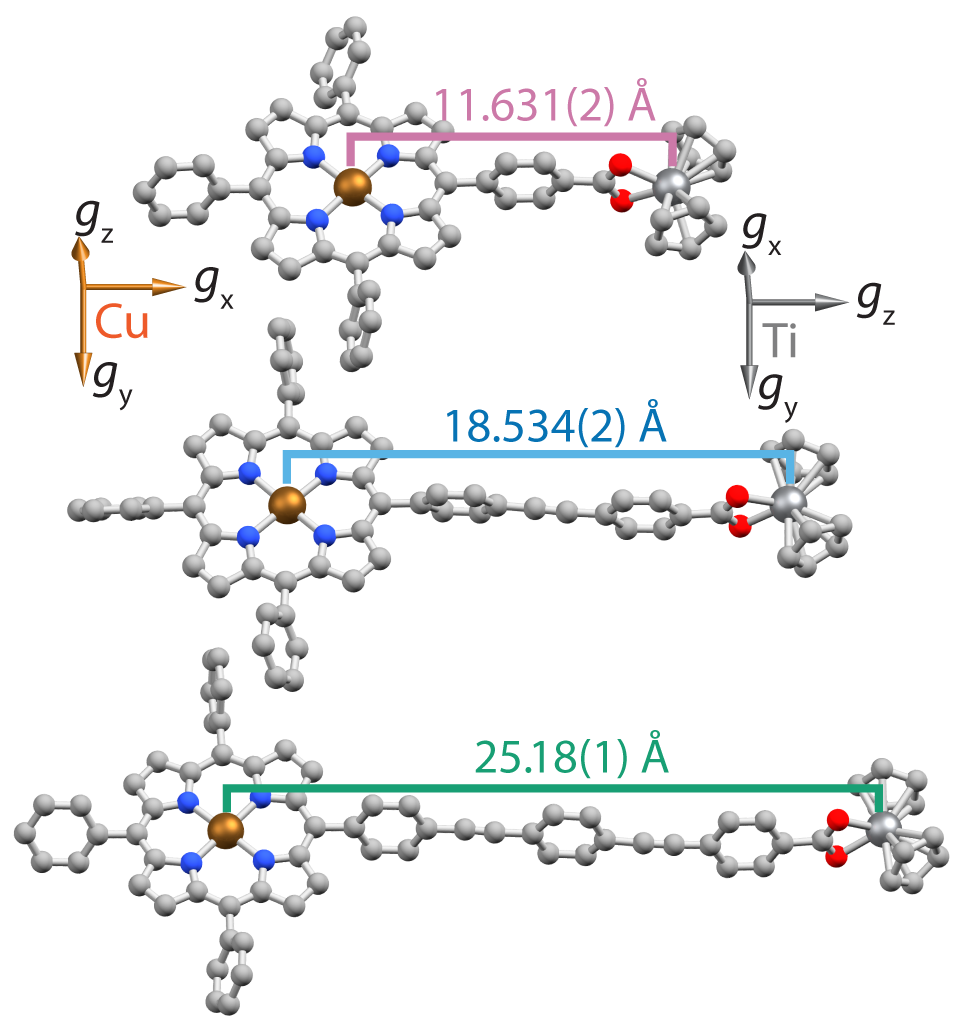
|
Electron spins in molecular transition metal complexes are a highly tunable platform for the creation of quantum bits (qubits) from the bottom-up. To leverage this control in systems of multiple qubits, we need to be able to address each qubit independently and understand their impact on one another as a function of their spatial relationship. To this end, we designed and synthesized a series of molecules bearing two spectrally-resolved qubits, a d1 Ti3+ and a d9 Cu2+ center, in a rigid ligand framework that enforces 1.2-2.5 nm distances between them. Through a combination of pulse EPR spectroscopy, control of matrix effects, and comparison to the monometallic analogues, we disentangle the many contributions to decoherence of the qubit state. Despite their magnetic interactions, the proximity of a second qubit's electron spin does not limit coherence of the first due to commensurate relaxation rates and different resonance frequencies. Quantum state tomography, however, can detect the impact of the second qubit on the coherent evolution of the qubit's quantum state. These findings point to the power of chemical synthesis to create complex designer quantum systems and will guide future development of multifunctional systems of many qubits. |
von Kugelgen, S.; Krzyaniak, M. D.; Gu, M.; Puggioni, D.;
Rondinelli, J. M.; Wasielewski, M. R.; Freedman, D. E.,
Spectral Addressability in a Modular Two Qubit System,
J. Am. Chem. Soc. 2021, 143 (21), 8069â8077
Optically addressable molecular spins for quantum information processing
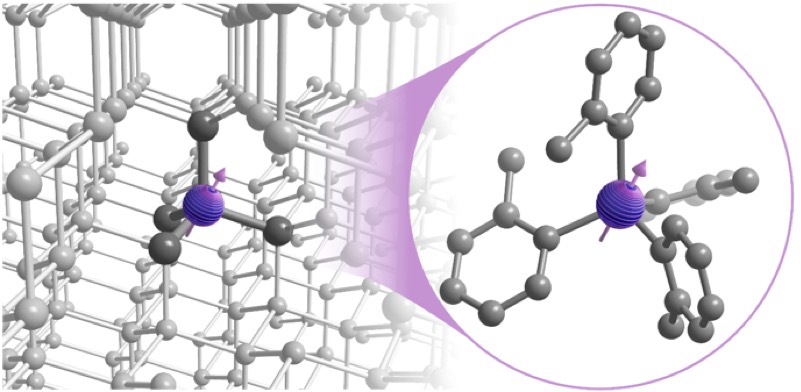
|
Molecular spins provide a chemically tunable platform to design quantum bits (qubits) from the bottom up. However, molecular qubits typically lack mechanisms to optically control the ground state spin, which would be a transformative capability for this modular and scalable class of qubits. In this work, we design spin-triplet molecular systems where the electronic structure enables optical initialization and readout of the ground state spin, similar to optically addressable defect-based systems. In doing so, we target pseudo tetrahedral CrR4, where R is an aryl-type ligand. The pseudo-tetrahedral aryl ligand field minimizes the ground state zero-field splitting in these d2, Cr4+ compounds. Additionally, the strong-field aryl donors generate the desired excited state structure where the first excited state is a spin-singlet. With this cumulative electronic structure, we demonstrate optical spin initialization and readout, as well as coherent spin manipulation with each Cr4+ compound. Moreover, we highlight that minor ligand modifications modulate the resulting spin and optical properties. Our results illustrate that these synthetically flexible Cr4+ systems offer a platform to realize designer optically addressable molecular spins for quantum technologies. |
Bayliss, S. L.; Laorenza, D. W.; Mintun, P. J.; Kovos, B. D.;
Freedman, D. E.; Awschalom, D. D.,
Optically addressable molecular spins for quantum information processing,
Science, 2020, 370, 1309-1312
The Limit of Spin Lifetime in Solid-State Electronic Spins
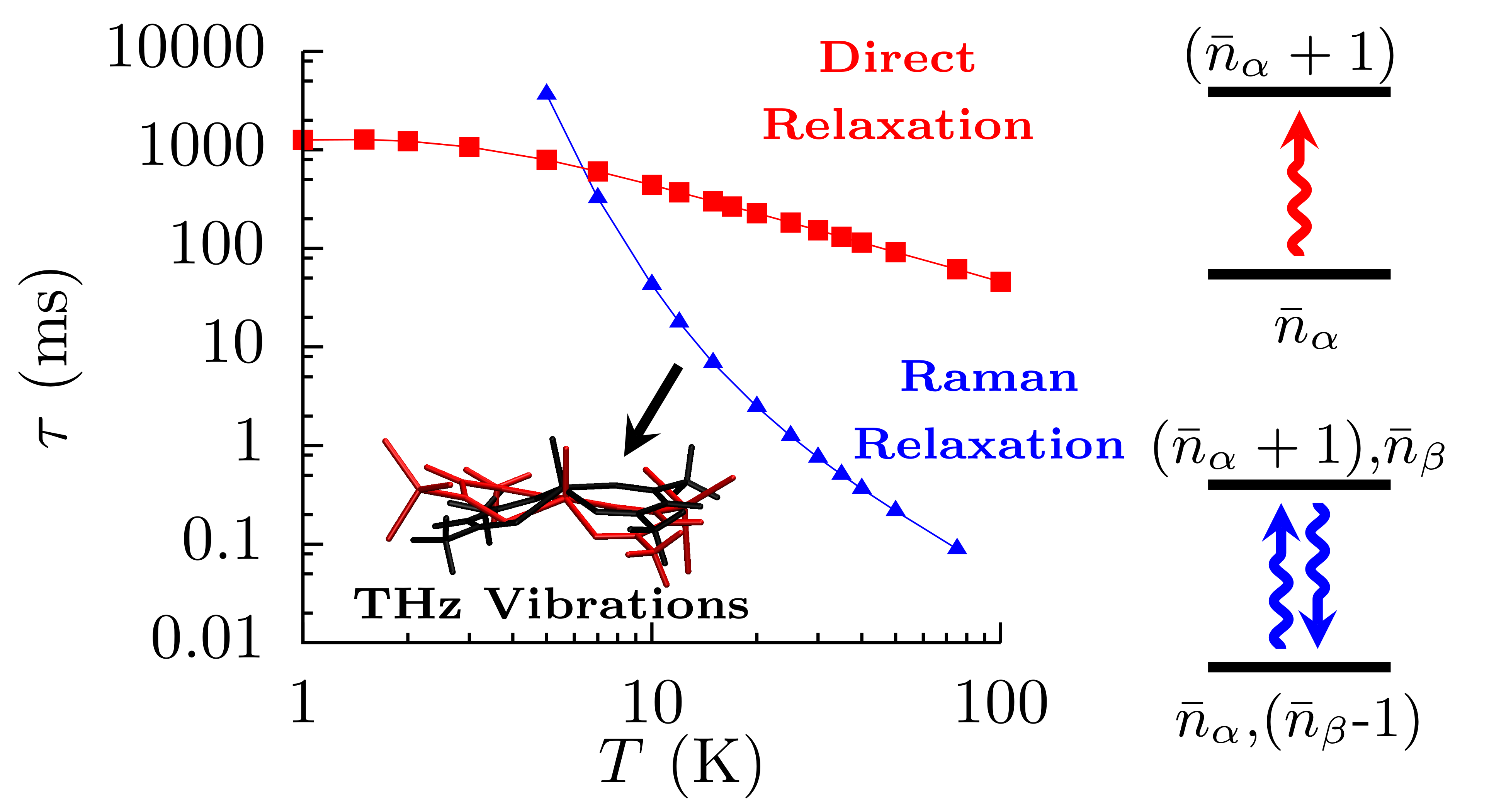
|
Achieving a full chemical control of spin lifetime is a central challenge in molecular magnetism, as it determines our ability to manipulate spin for technological applications. However, the success in this area is hindered but the lack of understanding of the details of spin-lattice relaxation. One of the biggest obstacles in the field is represented by the phenomenological nature of current spin relaxation theories, which were derived under strong approximations and for solid-state impurities. In this contribution, the authors completed the development of a fully-ab initio computational strategy, inclusive of both direct and Raman relaxation mechanisms, to predict spin-lattice relaxation time in S=1/2 systems. The method is parameter-free and is based on a combination of periodic-density functional theory calculations, used to determine lattice vibrations, and wave-function theory, which is used to determine all the spin-lattice coupling coefficients. Moreover, a machine-learning strategy is presented as a mean to speed up simulations of orders of magnitude, making simulations feasible for realistic systems. Results show that the direct mechanism drives relaxation at low-temperature and at very high fields, while at high-temperature Raman mechanism is the main responsible for relaxation. A physically inspired formula for the fitting of relaxation time as a function of temperature is proposed and used to provide a robust interpretation of experimental results. Importantly, it is shown that phonons in the THz frequency window are responsible for relaxation at high-temperature, offering a new rationale for the chemical control of relaxation time. |
A. Lunghi, S. Sanvito,
The Limit of Spin Lifetime in Solid-State Electronic Spins,
Journal of Physical Chemistry Letters 11 (15), 6273-6278, 2020
Substantial Ï-aromaticity in the anionic heavy-metal cluster [Th@Bi12]4â
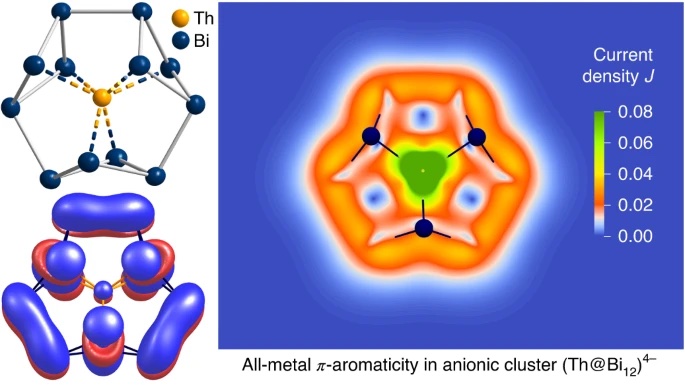
|
The concept of aromaticity was originally defined as a property of unsaturated, cyclic planar organic molecules like benzene, which gain stability by the inherent delocalization of 4nâ+â2 Ï-electrons over the ring atoms. Since then, Ï-aromaticity has been observed for a large variety of organic and inorganic non-metal compounds, yet, for molecules consisting only of metal atoms, it has remained restricted to systems with three to five atoms. Here, the authors present the straightforward synthesis of a metal 12-ring that exhibits 2Ï-aromaticity and has a ring current much stronger than that of benzene (6Ï) and equivalent to that of porphine (26Ï), despite these organic molecules having (much) larger numbers of Ï-electrons. Highly reducing reaction conditions allowed access to the heterometallic anion [Th@Bi12]4â, with interstitial Th4+ stabilizing a Bi128â moiety. The results show that it is possible to design and generate substantial Ï-aromaticity in large metal rings, and the authors hope that such Ï-aromatic heavy-metal cycles will eventually find use in cluster-based reactions. |
Armin R. Eulenstein, Yannick J. Franzke, Niels Lichtenberger,
Robert J. Wilson, H. Lars Deubner, Florian Kraus, Rodolphe
Clérac, Florian Weigend, Stefanie Dehnen,
Substantial Ï-aromaticity in the anionic heavy-metal cluster [Th@Bi12]4â,
Nature Chemistry volume 13, pages 149â155 (2021)
A reaction-coordinate perspective of magnetic relaxation
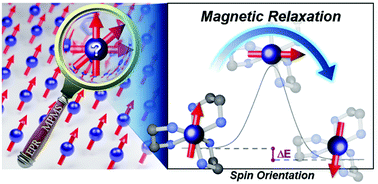
|
Understanding and utilizing the dynamic quantum properties of metal ions is the frontier of many next generation technologies. One property in particular, magnetic relaxation, is a complicated physical phenomenon that is scarcely treated in undergraduate coursework. Consequently, principles of magnetic relaxation are nearly impenetrable to starting synthetic chemists, who ultimately design the molecules that fuel new discoveries. In this Tutorial Review, the authors describe a new paradigm for thinking of magnetic relaxation in metal complexes in terms of a simple reaction-coordinate diagram to facilitate access to the field. They cover the main mechanisms of both spinâlattice (T1) and spinâspin (T2) relaxation times within this conceptual framework and how molecular and environmental design affects these times. Ultimately, the authors show that many of the scientific methods used by inorganic chemists to study and manipulate reactivity are also useful for understanding and controlling magnetic relaxation. They also describe the cutting edge of magnetic relaxation within this paradigm. |
Cassidy E. Jackson, Ian P. Moseley, Roxanna
Martinez, Siyoung Sung, Joseph M. Zadrozny,
A reaction-coordinate perspective of magnetic relaxation,
Chem. Soc. Rev., 2021, Advance Article
Single-Molecule Magnets: From Mn12-ac to dysprosium metallocenes, a travel in time
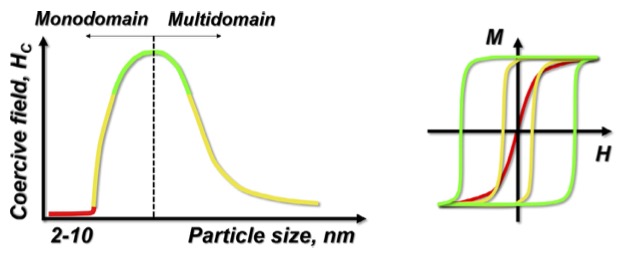
|
The discovery of the first Single-Molecule Magnet, Mn12-ac, in 1993 changed the perspective of how information can be stored. The current bit, occupying few hundreds of nanometers in present devices, would be minimized to tens of angstroms at molecular level. However, until a couple of years these materials could only operate at temperatures near to the absolute zero. From 1993 to date, the field of Single-Molecule Magnets (SMMs) has continuously evolved thanks to the close collaboration of chemists and physicists obtaining materials already operating above the liquid nitrogen temperature. This long journey, however, has involved the study of many different routes towards high performance SMMs, being each of them essential in order to deeply understand the quantum dynamics behind these molecules. An era of high spin 3d metal clusters was the beginning of everything, but it went through highly anisotropic low coordinate 3d compounds, lanthanide based magnets, radical bridged compounds and 3d-4f mixed systems, among others, to end up in the current state of the art dysprosium metallocenes. Furthermore, after the magnetic studies in bulk, SMM based hybrid systems are emerging for future application devices, which also involve very interesting multifunctionalities. All in all, this work aims to explain how these materials work and show the trajectory and some of the major advances that have been made during recent years in this field. |
Andoni Zabala-Lekuona, Jose Manuel Seco, Enrique Colacio,
Single-Molecule Magnets: From Mn12-ac to dysprosium metallocenes, a travel in time,
Coordination Chemistry Reviews,
Volume 441, 15 August 2021, 213984
Tuning the Ferrotoroidic Coupling and Magnetic Hysteresis in Double-Triangle Complexes {Dy3MIIIDy3} via the MIII-linker
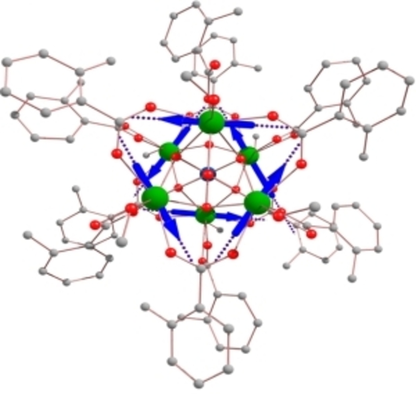
|
The authors present the syntheses, structures, magnetic data and theoretical analyses for two families of heptanuclear clusters, wherein two staggered dysprosium(III) triangles are linked by various M(III) d-/p-block ions. The families differ in the counter-anion and are of formulae [DyIII6MIII(OH)8(o-tol)12(MeOH)5(NO3)]ââ â4MeOH and [DyIII6MIII(OH)8(o-tol)12(MeOH)6]Clââ â6MeOH (M=Cr, Mn, Fe, Co, Al; o-tol=o-toluate). The authors find that variation of the central metal ion M is crucial in tuning the toroidal moments on the triangular units, with diamagnetic M linking ions enhancing the ferrotoroidic coupling. By detailed simulation and analysis of various magnetic measurements, including sub-kelvin microSquid hysteresis loops, the authors identified the specific signature of the M linking ionsâ modulation of toroidal properties, including the mechanism whereby anisotropic, paramagnetic M ions lead to hysteresis profiles with larger remnant magnetisations and broader coercive fields. |
Jared M. Ashtree, Ivana Borilovic, Kuduva R. Vignesh,
Abinash Swain, Sarah H. Hamilton, Yasmin L. Whyatt, Sophie
L. Benjamin, Wasinee Phonsri, Craig M. Forsyth,
Wolfgang Wernsdorfer, Alessandro Soncini,
Gopalan Rajaraman, Stuart K. Langley, Keith
S. Murray,
Tuning the Ferrotoroidic Coupling and Magnetic Hysteresis in Double-Triangle Complexes {Dy3MIIIDy3} via the MIII-linker,
Eur. J. Inorg. Chem., Volume 2021, Issue 5, February 5, 2021
Pages 435-444
A giant spin molecule with ninety-six parallel unpaired electrons
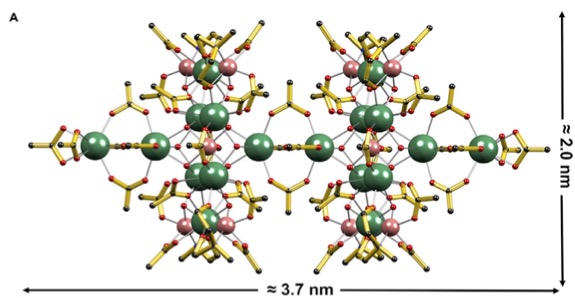
|
Unpaired electrons which are essential for organic radicals and magnetic materials are hard to align parallel, especially with increasing of number of spins. Here, the authors show that the antiferromagnetic interaction in the largest Cr(III)-RE (rare earth) cluster {Cr10RE18} leads to 96 parallel electronic spins, forming a ground state spin of 48 for RE = Gd. This is so far the third largest ground state spin achieved in one molecule. Moreover, by using classical Monte Carlo simulations, the exchange coupling constants can be determined. Spin dynamics simulation reveals that the strong Zeeman effect of 18 Gd(III) ions stabilizes the ground ferrimagnetic state and hinder the magnetization reversal of these spins. In addition, the dysprosium(III) analog is an exchange-biasing single-molecule magnet. The authors believe that the ferrimagnetic approach and analytical protocol established in their work can be applied generally in constructing and analyzing giant spin molecules. |
LeiQin, Hao-LanZhang, Yuan-Qi Zhai, Hiroyuki Nojiri, Christian Schröder,
Yan-Zhen Zheng,
A giant spin molecule with ninety-six parallel unpaired electrons,
iScience, Volume 24, Issue 4, 23 April 2021, 102350
In Quest of Molecular Materials for Quantum Cellular Automata: Exploration of the Double Exchange in the Two-Mode Vibronic Model of a Dimeric Mixed Valence Cell
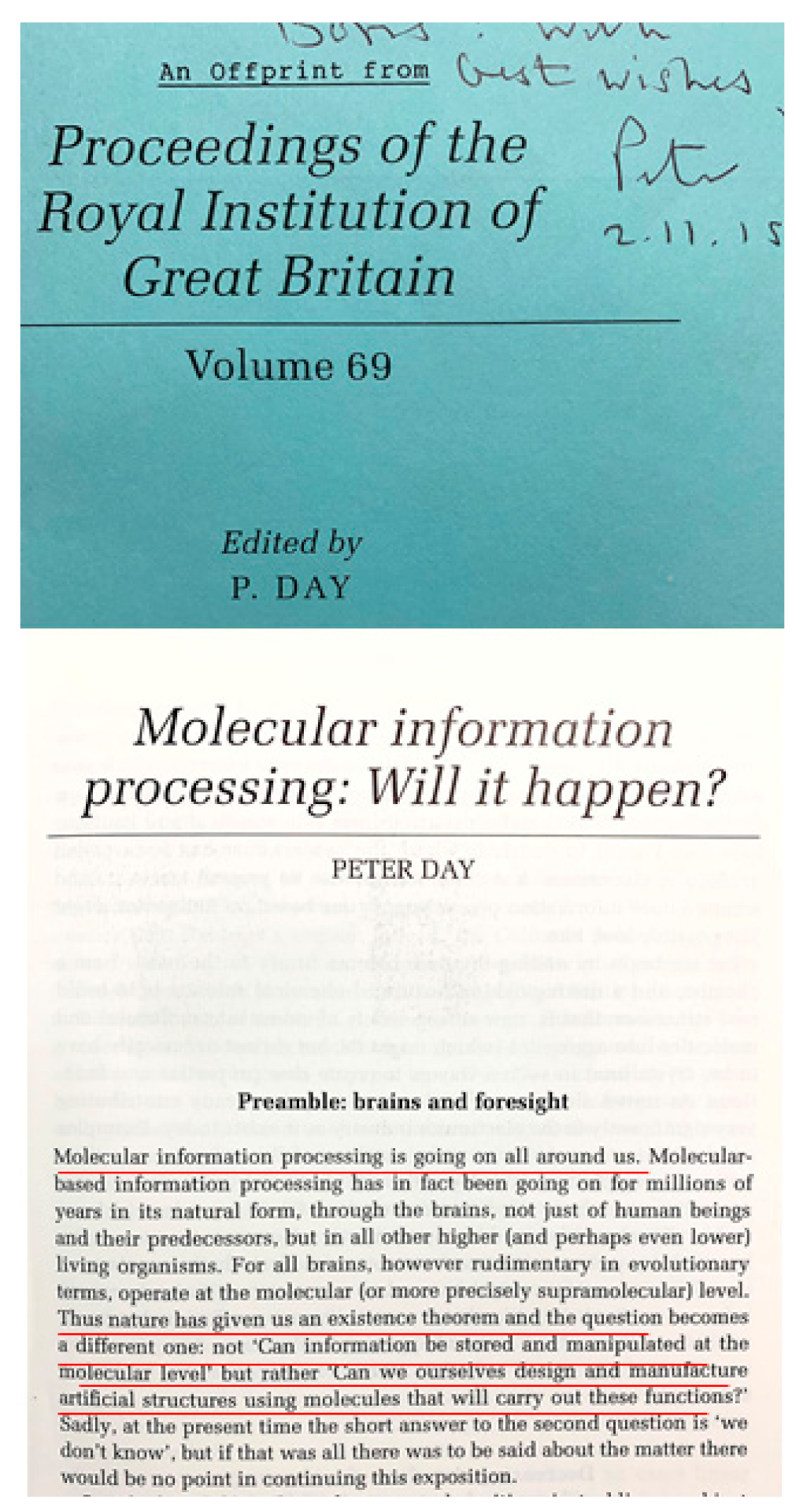
|
In this article, the authors apply the two-mode vibronic model to the study of the dimeric molecular mixed-valence cell for quantum cellular automata. As such, the authors consider a multielectron mixed valence binuclear d2âd1âtype cluster, in which the double exchange, as well as the Heisenberg-Dirac-Van Vleck exchange interactions are operative, and also the local (breathing) and intercenter vibrational modes are taken into account. The calculations of spin-vibronic energy spectra and the cell-cell-response function are carried out using quantum-mechanical two-mode vibronic approach based on the numerical solution of the dynamic vibronic problem. The obtained results demonstrate a possibility of combining the function of molecular QCA with that of spin switching in one electronic device and are expected to be useful from the point of view of the rational design of such multifunctional molecular electronic devices. |
Boris Tsukerblat, Andrew Palii, Sergey Aldoshin,
In Quest of Molecular Materials for Quantum Cellular Automata: Exploration of the Double Exchange in the Two-Mode Vibronic Model of a Dimeric Mixed Valence Cell,
Magnetochemistry 2021, 7(5), 66
See Special Issue "Perspectives on Molecular MaterialsâA Tribute to Professor Peter Day",
Magnetochemistry 2021
Mixed-valence clusters: Prospects for single-molecule magnetoelectrics
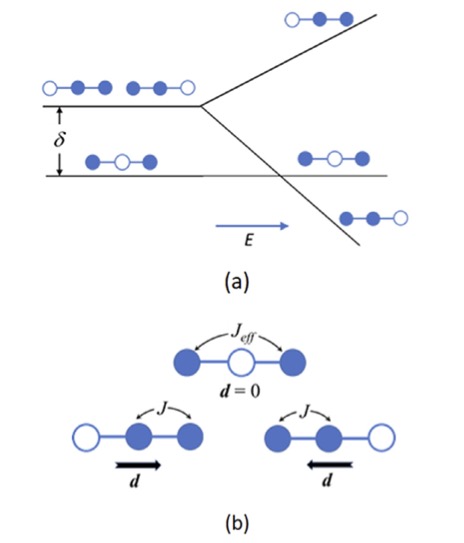
|
In this review the authors summarize the results of recent studies of the mechanisms of magnetoelectric effect in mixed-valence molecules. Consideration of fairly different systems and emerging situations is united by a common physical concept of spin-dependent electric polarizability in a wide class of such systems. In many-electron dimers, which are on the borderline between the Robin and Day classes II and III, the electric field suppresses ferromagnetic double-exchange and induces electric dipole moment, while the antiferromagnetic Heisenberg-type exchange remains unaffected. This leads to stabilization of the low-spin states thus giving rise to the spin-switching effect. A short and to a large extent qualitative discussion of the role of the vibronic coupling that is inherent for mixed valence systems is given as well. In trigonal trimers with two delocalized excess electrons, the electric field suppresses the first-order electron transfer, and under some conditions also leads to the spin-switching effect. Magnetoelectric coupling of quite different nature occurs in linear two-electron trimers (such as linear triferrocenium complexes) and also in two-electron clusters of higher complexity such as polyoxoanion [GeV14O40]8â. In these systems electric field is shown to effectively approach the two remote electrons, thus forcing them to interact. This allows to enable/disable the exchange interaction by turning on/off the electric field. We also discuss a possibility to control spin-states in the two-electron square-planar systems acting as cells in molecular quantum cellular automata devices. Spin-singlets and spin-triplets exhibit different electric polarizabilities, which allows to control the spin-states by using polarized driver-cell. Finally, the authors briefly discuss the feasibility of the electric field control of mixed valence molecules and also give some additional examples of clusters exhibiting magnetoelectrical effect. |
Andrew Palii, Sergey Aldoshin, Boris Tsukerblat,
Mixed-valence clusters: Prospects for single-molecule magnetoelectrics,
Coordination Chemistry Reviews,
Volume 426, 1 January 2021, 213555
Mononuclear Dysprosium Alkoxide and Aryloxide SingleâMolecule Magnets
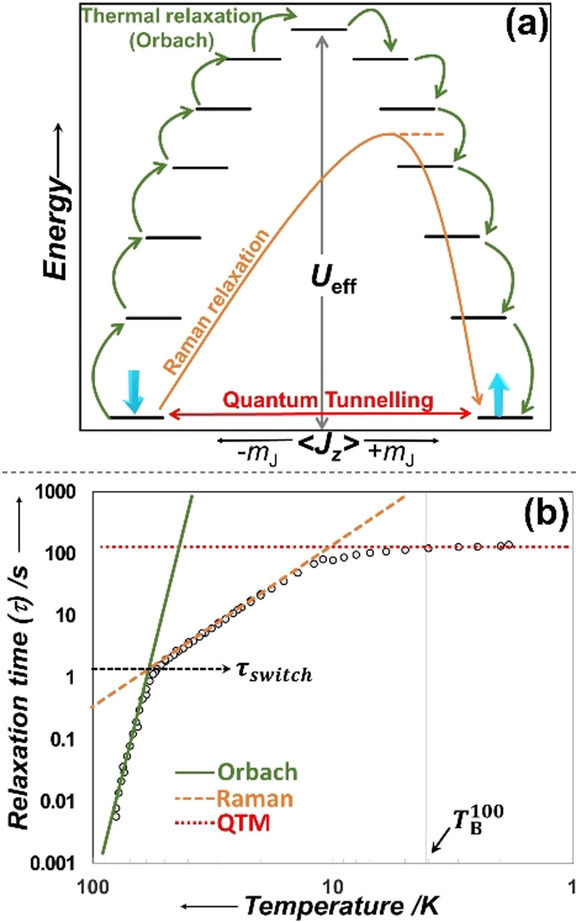
|
Recent studies have shown that mononuclear lanthanide (Ln) complexes can be highâperforming singleâmolecule magnets (SMMs). Recently, there has been an influx of mononuclear Ln alkoxide and aryloxide SMMs, which have provided the necessary geometrical control to improve SMM properties and to allow the intricate relaxation dynamics of Ln SMMs to be studied in detail. Here nonâaqueous Ln alkoxide and aryloxide chemistry applied to the synthesis of lowâcoordinate mononuclear Ln SMMs are reviewed. The focus is on mononuclear DyIII alkoxide and aryloxide SMMs with coordination numbers up to eight, covering synthesis, solidâstate structures and magnetic attributes. Brief overviews are also provided of mononuclear TbIII, HoIII, ErIII and YbIII alkoxide and aryloxide SMMs. |
Vijay S. Parmar, David P. Mills, Richard E. P. Winpenny,
Mononuclear Dysprosium Alkoxide and Aryloxide SingleâMolecule Magnets,
Chem. Eur. J. (2021) Early view
The Synthesis and Characterisation of a Molecular SeaâSerpent: Studies of a {Cr24Cu7} Chain
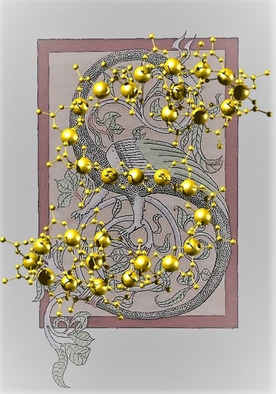
|
A finite chain of thirtyâone paramagnetic centers is reported, synthesized by reaction of hydrated chromium fluoride, copper carbonate and pivalic acid in the presence of 1,4,7,10âtetrazacyclododecane (cyclen). Magnetic studies show predominantly antiâferromagnetic exchange leading to a high density of lowâlying spin states and large saturation field. |
Rajeh Alotaibi, Jonathan M. Fowler, Selena J. Lockyer,
Grigore A. Timco, David Collison, Jürgen Schnack, Richard E. P. Winpenny,
The Synthesis and Characterisation of a Molecular SeaâSerpent: Studies of a {Cr24Cu7} Chain,
Angew. Chem. Int. Ed. 60 (2021) 9489
Strong Coupling and Slow Relaxation of the Magnetization for an Air-Stable [Co4] Square with Both Tetrazine Radicals and Azido Bridges
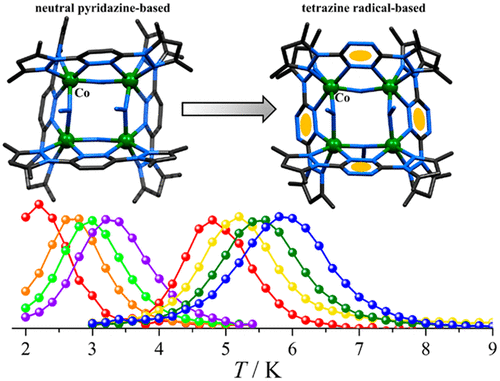
|
Derivatives of 3,6-substituted tetrazine with parallel coordination sites have served as promising coding ligands for the most common motif of square structures and their anion radical forms have proved to be capable of transmitting robust magnetic interactions. In light of the pre-programmed ability and redox-activity of these ligands, herein we report the synthesis, structures and magnetic studies of the azido-bpztz co-bridged molecular squares [MII4(bpztz·-)4(N3)4] (MII = Zn2+, 1; Co2+, 2; bpztz = 3,6-bis(3,5-dimethyl-pyrazolyl)-1,2,4,5-tetrazine, TOC as below). Interestingly, the rare cis-bridging mode of tetrazine radicals dictated by the EO-azido bridges provided a pleasant molecular magnetic anisotropy for single molecule magnets and as a result, strong magnetic interactions between metal spin centers and the radicals (J = -64.7 cm-1) were realized in 2. Remarkably, high-performance single-molecule magnet behavior with an effective energy barrier of 92 K of 2 under a zero-dc field was observed, which is the first example of a cis-tetrazine radical bridged [Co4] square and among the highest relaxation barriers for reported polynuclear transition-metal compounds. |
Zhilin Guo, Yi-Fei Deng, Zoe Pikramenou, Kim R. Dunbar, and
Yuan-Zhu Zhang,
Strong Coupling and Slow Relaxation of the Magnetization for an Air-Stable [Co4] Square with Both Tetrazine Radicals and Azido Bridges,
Inorg. Chem. 2021, in print
Complete mapping of the thermoelectric properties of a single molecule
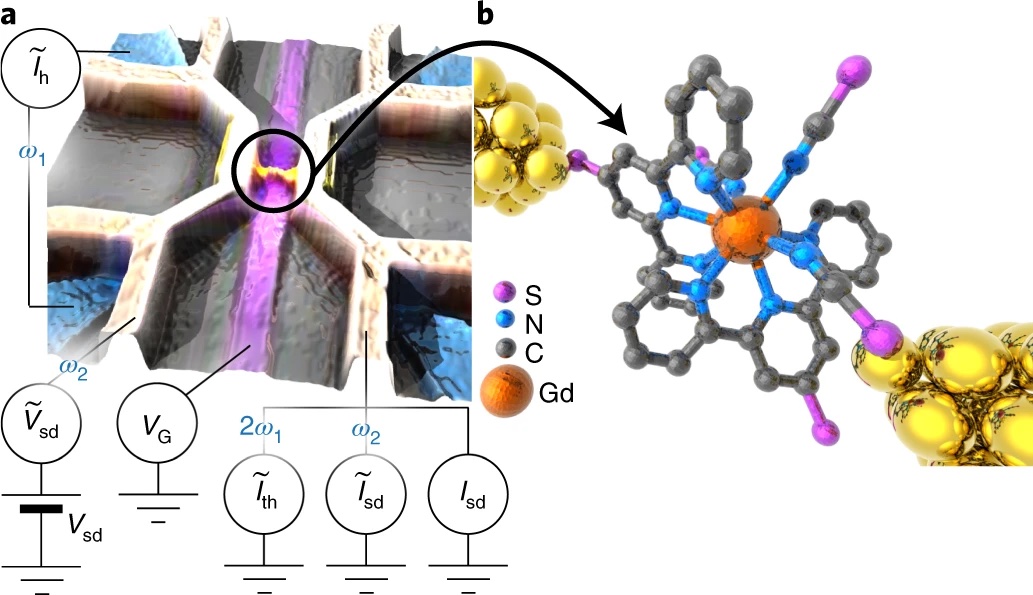
|
Theoretical studies suggest that mastering the thermocurrent through single molecules can lead to thermoelectric energy harvesters with unprecedentedly high efficiencies. This can be achieved by engineering molecule length, optimizing the tunnel coupling strength of molecules via chemical anchor groups or by creating localized states in the backbone with resulting quantum interference features. Empirical verification of these predictions, however, faces considerable experimental challenges and is still awaited. Here the authors use a novel measurement protocol that simultaneously probes the conductance and thermocurrent flow as a function of bias voltage and gate voltage. They find that the resulting thermocurrent is strongly asymmetric with respect to the gate voltage, with evidence of molecular excited states in the thermocurrent Coulomb diamond maps. These features can be reproduced by a rate-equation model only if it accounts for both the vibrational coupling and the electronic degeneracies, thus giving direct insight into the interplay of electronic and vibrational degrees of freedom, and the role of spin entropy in single molecules. Overall these results show that thermocurrent measurements can be used as a spectroscopic tool to access molecule-specific quantum transport phenomena. |
Pascal Gehring, Jakub K. Sowa, Chunwei Hsu, Joeri de Bruijckere,
Martijn van der Star, Jennifer J. Le Roy, Lapo Bogani, Erik
M. Gauger, Herre S. J. van der Zant,
Complete mapping of the thermoelectric properties of a single molecule,
Nat. Nanotechnol. (2021)
Next Generation Multifunctional Nano-Science of Advanced Metal Complexes with Quantum Effect and Nonlinearity
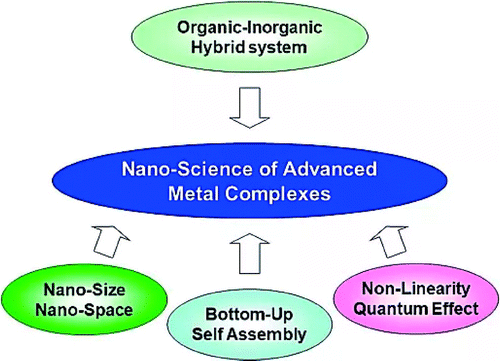
|
The author's research target can be described as "Next Generation Multifunctional Nano-Science of Advanced Metal Complexes with Quantum Effect and Nonlinearity". His work encompasses four important key areas: (1) inorganic-organic hybrid systems, (2) nano-size and nano-space, (3) bottom-up and self-assembly, and (4) nonlinearity and quantum effect. Among them, nonlinearity and quantum effect are the most important for nano-science of advanced metal complexes. The author has been working on these two topics (nonlinearity and quantum effect) simultaneously for more than 40 years. As for quantum effect, he has focused on Haldane gap systems, single-chain magnets (SCMs), single-molecule magnets (SMMs), Kondo resonance on SMMs, photo-switchable SMMs, metallic conducting SMMs, SMMs encapsulated into single-walled carbon nanotube (SWCNT), and metal-organic framework (MOF)-spintronics for spin qubits, for pursuing high-density memory devices and quantum computing. As for nonlinearity, he has focused on quasi-one-dimensional halogen-bridged metal complexes (MX-Chains; M = Pt, Pd, and Ni; X = Cl, Br, and I) with nonlinear excitons such as solitons and polarons, strongly electron-correlated Ni(III) complexes with gigantic third-order optical nonlinearity, and phase transitions and charge fluctuations between Pd(III) averaged states (= Mott insulator) and Pd(II)-Pd(IV) mixed-valence states (= charge density wave states), for pursuing optical communication, optical switching, and optical computing. In this review article, the above main topics (quantum effect and nonlinearity) will be described according to the author's research history of more than 40 years, Future perspectives for the two topics will be proposed. |
Masahiro Yamashita,
Next Generation Multifunctional Nano-Science of Advanced Metal Complexes with Quantum Effect and Nonlinearity,
Bulletin of the Chemical Society of Japan, 2021, Vol.94, No.1
Quantum Phase Interference in the Excited Triplet of C70
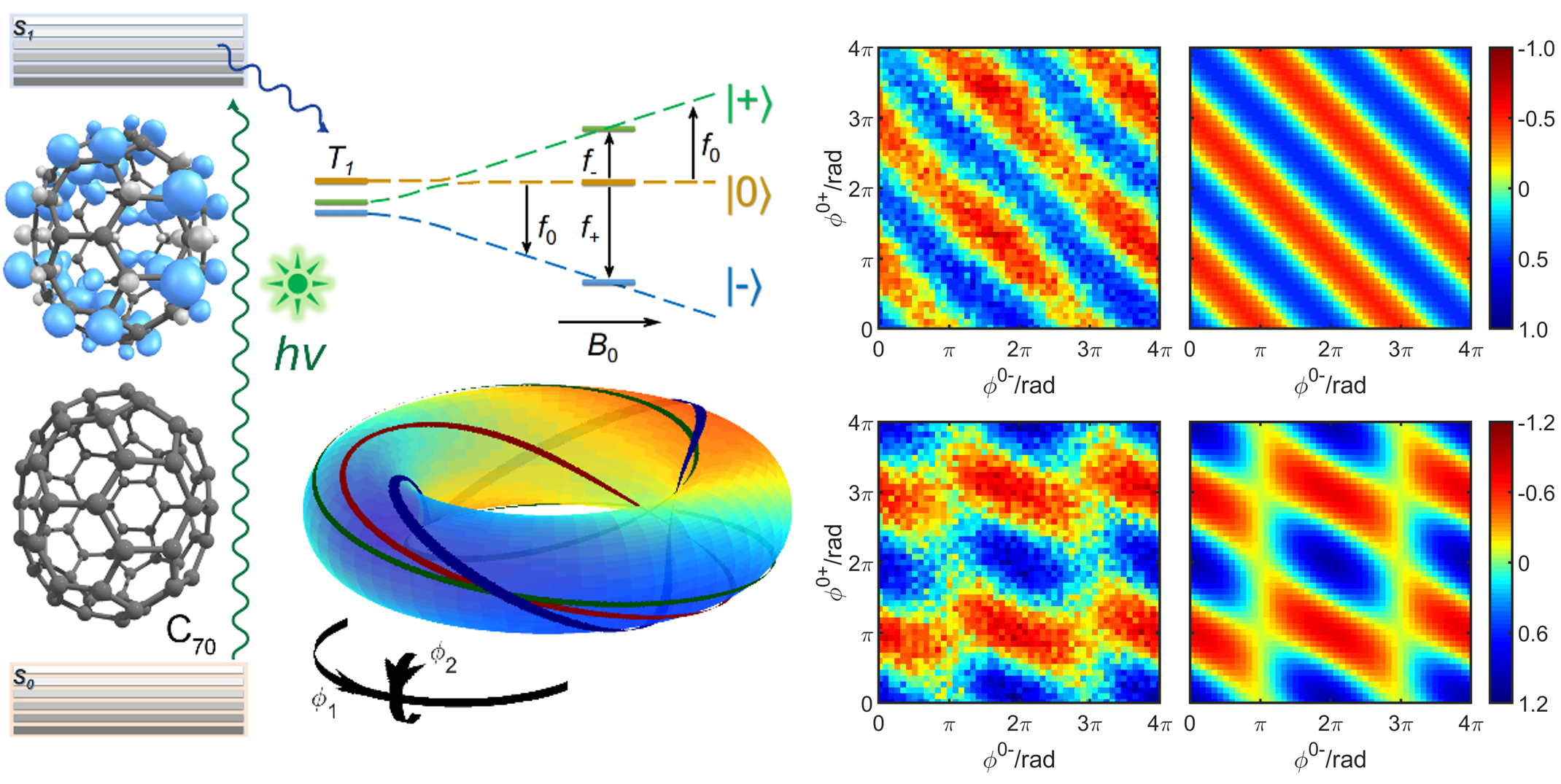
|
High spin magnetic molecules are promising candidates for quantum information processing because their intrinsic multiplicity facilitates information storage and computational operations. However, due to the absence of suitable sublevel splittings, their susceptibility to environmental disturbances and limitation from the selection rule, the arbitrary control of the quantum state of a molecular electron multiplet has not been realized. Here Prof. ShangDa Jiang and Prof. Song Gaoâs group exploited the photoexcited triplet of C70 as a molecular electron spin qutrit with pulsed electron paramagnetic resonance. They prepared the system into 3-level superposition states characteristic of a qutrit and validated them by the tomography of their density matrices. To further elucidate the coherence of the operation and the nature of the system as a qutrit, they demonstrated the quantum phase interference in the superposition. The interference pattern is further interpreted as a map of possible evolution paths in the space of phase factors, representing the quantum nature of the 3-level system. |
Ye-Xin Wang, Zheng Liu, Yu-Hui Fang, Shen Zhou, Shang-Da Jiang, Song Gao,
Coherent manipulation and quantum phase interference in a fullerene-based electron triplet molecular qutrit,
npj Quantum Inf 7, 32 (2021)
SpinâElectric Coupling in a Cobalt(II)âBased Spin Triangle Revealed by Electric FieldâModulated ESR
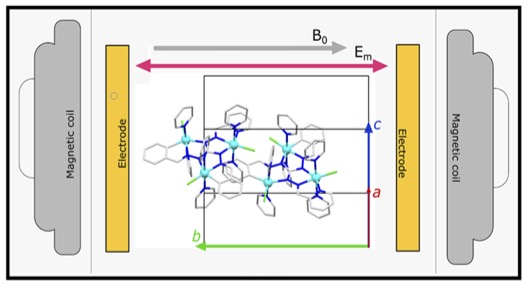
|
The authors report on a cobalt(II)âbased spin triangle showing a significant spinâelectric coupling. In analogy with a previously investigated modification, the intraâtriangle antiferromagnetic interaction leads to spin frustration. The two expected energy degenerate ground doublets are, however, separated by a few wavenumbers, as a consequence of magnetic anisotropy and deviations from threefold symmetry. At variance with the previously investigated modification, the Co3 planes of symmetryârelated molecules are almost parallel, allowing for the determination of the spinâelectric properties on single crystals by electric fieldâmodulated electron spin resonance spectroscopy (EFMâESR). The spinâelectric effect detected when the electric field is applied in the Co3 plane was revealed by a shift in the resonance field. Its value is comparable to what was determined for a Cu3 triangle despite the antiferromagnetic interaction being 20 times larger for the latter. |
Benjamin Kintzel, Maria Fittipaldi, Michael Böhme, Alberto Cini, Lorenzo Tesi, Axel Buchholz, Roberta Sessoli, Winfried Plass,
SpinâElectric Coupling in a Cobalt(II)âBased Spin Triangle Revealed by Electric FieldâModulated ESR,
Angew. Chem. Int. Ed. (2021) accepted
Direct spectroscopic observation of Berry-phase interference in the Ni4 single-molecule magnet
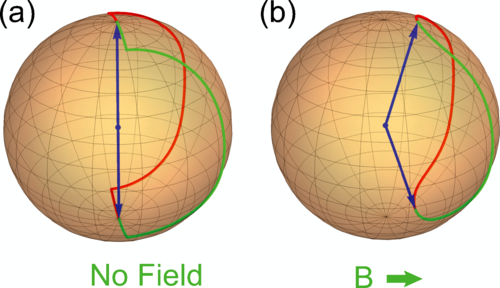
|
Berry-phase effects in spin systems lead to the suppression of tunneling effects when different tunneling paths interfere destructively. Such effects have been seen in several single-molecule magnets (SMMs) through measurements of magnetization dynamics, where the experimental signal may arise from the contributions of numerous energy levels. Here the authors present experimental measurements of Berry-phase interference effects that are determined through electron-spin resonance on a fourfold symmetric SMM. Specifically, the authors measure transitions between tunnel-split excited states in the Ni4 SMM in the presence of a transverse field in the hard plane of the crystalline sample. By using a home-built rotation apparatus, the direction of the sample can be changed in situ so that the field direction can be swept through the entire hard plane of the sample. When the field is in certain directions in the plane, the authors observe a splitting of the transition, a hallmark of Berry-phase interference. The experimental results are well reproduced by numerical simulations, and fitting of the data provides information about the effects of dipolar interactions and sample misalignment. |
Brendan C. Sheehan, Robert Kwark, Charles A. Collett, Thomaz
A. Costa, Rafael A. AllĂŁo Cassaro, and Jonathan R. Friedman,
Direct spectroscopic observation of Berry-phase interference in the
Ni4 single-molecule magnet,
Phys. Rev. B 102, 224428 (2020)
Understanding magnetic relaxation in single-ion magnets with high blocking temperature
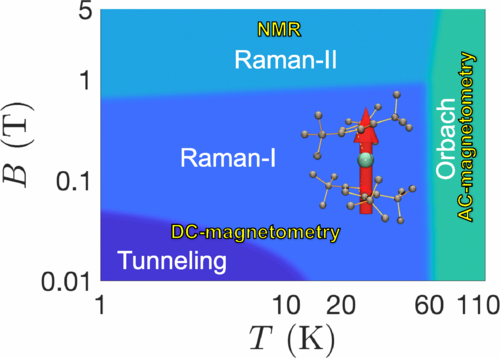
|
The recent discovery of single-ion magnets with magnetic hysteresis above liquid-nitrogen temperatures placed these compounds among the best candidates to realize high-density storage devices. Starting from a prototypical dysprosocenium molecule, showing hysteresis up to 60 K, the authors derive here a general recipe to design high-blocking-temperature rare-earth single-ion magnets. The complex magnetic relaxation is unraveled by combining magnetization and nuclear magnetic resonance measurements with inelastic neutron scattering experiments and ab initio calculations, thus disentangling the different mechanisms and identifying the key ingredients behind slow relaxation. |
A. Chiesa, F. Cugini, R. Hussain, E. Macaluso, G. Allodi,
E. Garlatti, M. Giansiracusa, C. A. P. Goodwin, F. Ortu,
D. Reta, J. M. Skelton, T. Guidi, P. Santini, M. Solzi, R. De
Renzi, D. P. Mills, N. F. Chilton, and S. Carretta,
Understanding magnetic relaxation in single-ion magnets with high blocking temperature,
Phys. Rev. B 101, 174402 (2020)
Blocking like it's hot: a synthetic chemistsâ path to high-temperature lanthanide single molecule magnets
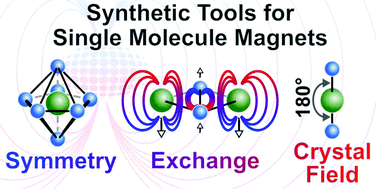
|
Progress in the synthesis, design, and characterisation of single-molecule magnets (SMMs) has expanded dramatically from curiosity driven beginnings to molecules that retain magnetization above the boiling point of liquid nitrogen. This is in no small part due to the increasingly collaborative nature of this research where synthetic targets are guided by theoretical design criteria. This article aims to summarize these efforts and progress from the perspective of a synthetic chemist with a focus on how chemistry can modulate physical properties. A simple overview is presented of lanthanide electronic structure in order to contextualize the synthetic advances that have led to drastic improvements in the performance of lanthanide-based SMMs from the early 2000s to the late 2010s. |
Conrad A. P. Goodwin,
Blocking like it's hot: a synthetic chemistsâ path to high-temperature lanthanide single molecule magnets,
Dalton Trans., 2020,49, 14320-14337
Secondary metal coordination using a tetranuclear complex as ligand leading to hexanuclear complexes with enhanced thermal barriers for electron transfer

|
Post-synthesis of the paramagnetic square-shaped complex {[(Tp*Me)Fe(ÎŒ-CN)2(CN)][Co(dmbpy)2]}2(BPh4)2·6MeCN·H2O [ 1, Tp*Me = tris(3,4,5-trimethylpyrazole)-borate; dmbpy = 4,4âČ-dimethyl-2,2âČ-bipyridine)] by grafting transition metal(II) thiocyanates via its terminal cyano groups afforded three hexanuclear [Fe2Co2M2] clusters (M = Zn, 2; Co, 3; Cd, 4). The peripheral metal complex units serving as excellent electron acceptors were found to help stabilize the low-temperature state of FeII,LS-CoIII,LS within the complex core. As a result, the desolvated complexes 2 to 4 underwent reversible and sharp thermally induced electron-transfer behavior with the transition temperatures (T1/2) up to 312, 296 and 365 K, respectively, demonstrating an effective means of manipulating thermal barriers of the celebrated cyano-bridged square core. |
Shihao Liu, Yi-Fei Deng, Zi-Yi Chen, Lingyi Meng, Xiaoyong
Chang, Zhiping Zheng, and Yuan-Zhu Zhang,
Secondary metal coordination using a tetranuclear complex as ligand leading to hexanuclear complexes with enhanced thermal barriers for electron transfer,
CCS Chemistry
Recent progress on cyano-bridged transition-metal-based single-molecule magnets and single-chain magnets
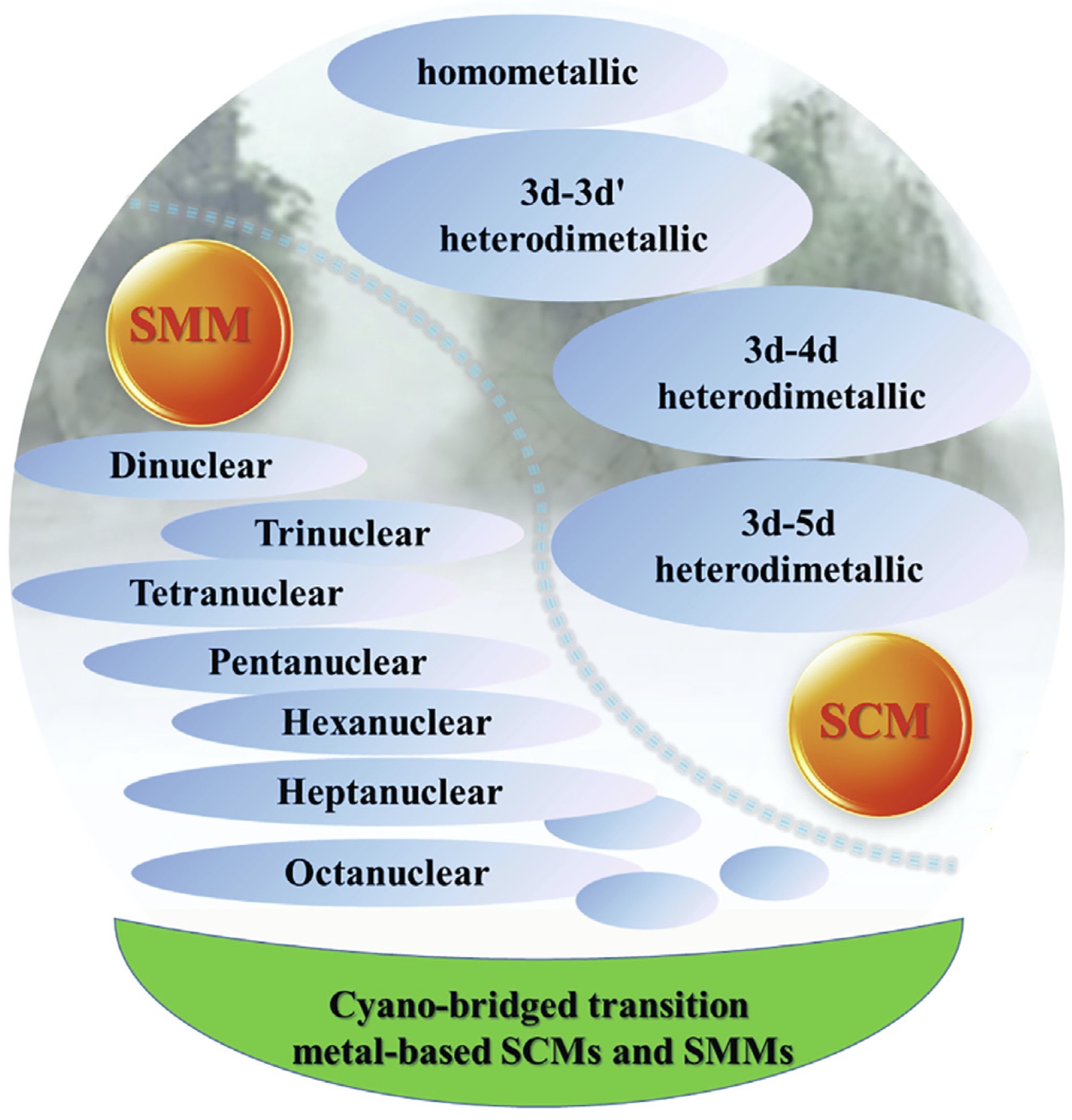
|
Novel functional molecular-based magnetic materials, especially some members of the Prussian blue family, have gained significant attention over the past few decades as they can be used beneficially in a variety of scientific fields. Herein, the authors survey the latest developments in cyano-bridged transition-metal-based single-molecule magnets (SMMs) and single-chain magnets (SCMs) research. The cyanide ligand, which has a strong affinity for transition metals, is a popular bridging ligand to construct a variety of molecular-magnetic materials, depending on the type of co-ligand. This review mainly focuses on research into structural topologies and the corresponding SMMs or SCMs. The first section provides a brief introduction into SMM and SCM behavior and important principles and strategies for constructing diverse magnetic materials. The remaining sections provide overviews of significant achievements reported in recent years. In the final section the authors conclude by presenting perspectives on cyanometallate-based SMMs and SCMs and by providing some new insight into this promising area. |
Jin-Hua Wang, Zhao-Yang Li, Masahiro Yamashita, Xian-He Bu,
Recent progress on cyano-bridged transition-metal-based single-molecule magnets and single-chain magnets,
Coord. Chem. Rev. 428, 213617 (2021)
Observation of the asphericity of 4f-electron density and its relation to the magnetic anisotropy axis in single-molecule magnets
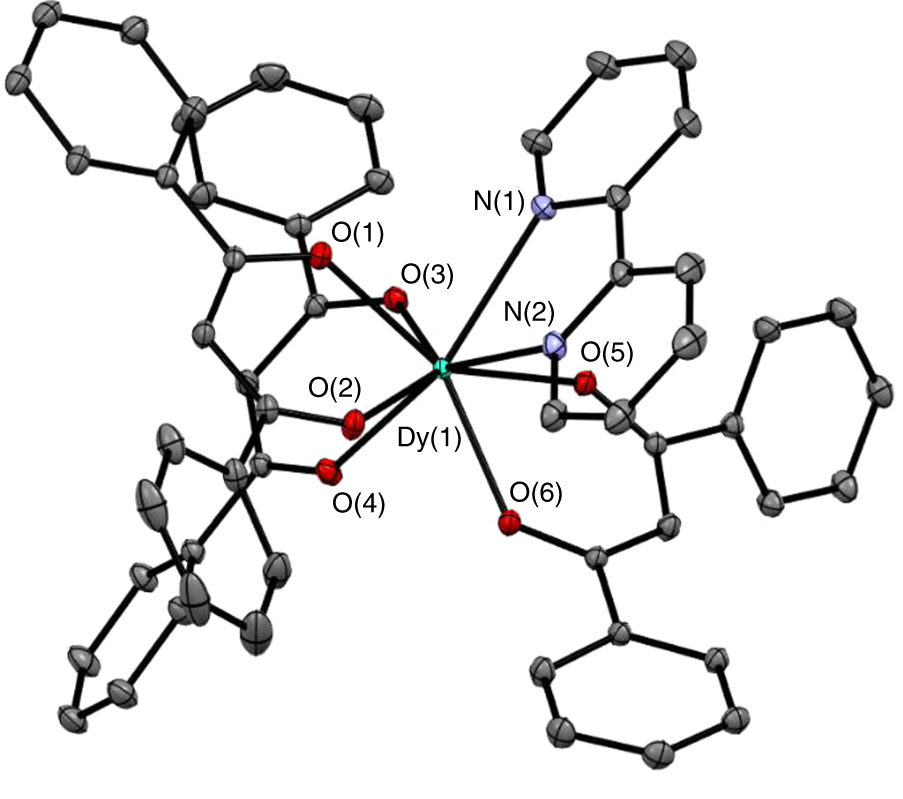
|
The distribution of electrons in the 4f orbitals of lanthanide ions is often assigned a crucial role in the design of single-molecule magnets, which maintain magnetization in zero external field. Optimal spatial complementarity between the 4f-electron density and the ligand field is key to maximizing magnetic anisotropy, which is an important factor in the ability of lanthanide complexes to display single-molecule magnet behaviour. Here the authors have experimentally determined the electron density distribution in two dysprosium molecular complexes by interpreting high-resolution synchrotron X-ray diffraction with a multipole model. The ground-state 4f-electron density is found to be an oblate ellipsoid, as is often deduced from a simplified Sievers model that assumes a pure |+/-15/2> ground-state doublet for the lanthanide ion. The large equatorial asymmetryâdetermined by a model wavefunction was found to contain considerable MJ mixing of |+/-11/2> and only 81% of |+/-15/2>. The experimental molecular magnetic easy axes were recovered, and found to deviate by 13.1° and 8.7° from those obtained by ab initio calculations. |
Chen Gao, Alessandro Genoni, Song Gao, Shangda Jiang, Alessandro
Soncini, Jacob Overgaard,
Observation of the asphericity of 4f-electron density and its relation to the magnetic anisotropy axis in single-molecule magnets,
Nature Chemistry 12, 213â219(2020)
compare also
Emil DamgaardâMĂžller, Lennard Krause, Kasper Tolborg,
Giovanni Macetti, Dr. Alessandro Genoni, Jacob
Overgaard,
Quantification of the Magnetic Anisotropy of a
SingleâMolecule Magnet from the Experimental Electron
Density,
Angew. Chem. Int. Ed. 59, 21203-21209 (2020)
Molecular Nanomagnets as Qubits with Embedded Quantum-Error Correction
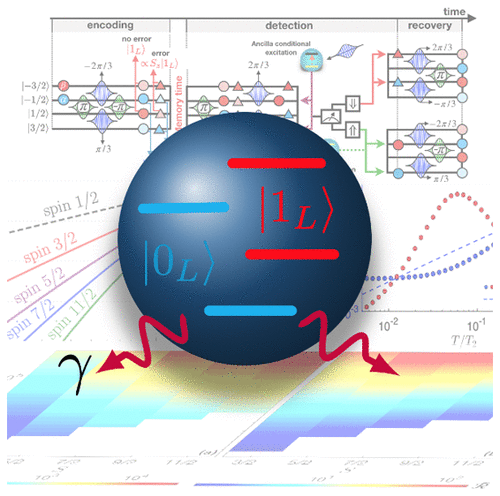
|
The authors show that molecular nanomagnets have a potential advantage in the crucial rush toward quantum computers. Indeed, the sizable number of accessible low-energy states of these systems can be exploited to define qubits with embedded quantum error correction. The authors derive the scheme to achieve this crucial objective and the corresponding sequence of microwave/radiofrequency pulses needed for the error correction procedure. The effectiveness of our approach is shown already with a minimal S = 3/2 unit corresponding to an existing molecule, and the scaling to larger spin systems is quantitatively analyzed. |
A. Chiesa, E. Macaluso, F. Petiziol, S. Wimberger, P. Santini,
and S. Carretta,
Molecular Nanomagnets as Qubits with Embedded Quantum-Error Correction,
Phys. Chem. Lett. 2020, 11, 20, 8610â8615
Modulating magnetic anisotropy in Ln(III) single-ion magnets using an external electric field
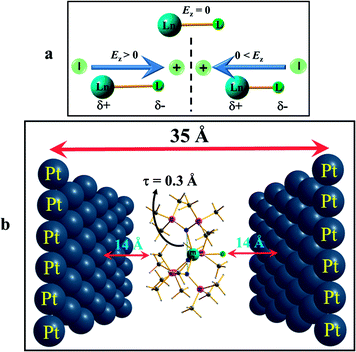
|
Single-molecule magnets have potential uses in several nanotechnology applications, including high-density information storage devices, the realisation of which lies in enhancing the barrier height for magnetisation reversal (Ueff). However, Ln(III) single-ion magnets (SIMs) that have been reported recently reveal that the maximum value of Ueff values that can be obtained by modulating the ligand fields has already been achieved. Here, the authors have explored, using a combination of DFT and ab initio CASSCF calculations, a unique way to enhance the magnetisation reversal barrier using an oriented external electric field in three well-known Ln(III) single-ion magnets: [Dy(Py)5(OtBu)2]+ (1), [Er{N(SiMe3)2}3Cl]â (2) and [Dy(CpMe3)Cl] (3). The study reveals that, for apt molecules, if the appropriate direction and values of the electric fields are chosen, the barrier height can be enhanced by twice that of the limit set by the ligand field. The application of an electric field along the equatorial direction was found to be suitable for oblate shaped Dy(III) complexes and an electric field along the axial direction was found to enhance the barrier height for a prolate Er(III) complex. For complexes 2 and 3, the external electric field was able to magnify the barrier height to 2â3 times that of the original complexes. However, a moderate enhancement was noticed after application of the external electric field in the case of complex 1. This novel non-chemical fine-tuning approach to modulate magnetic anisotropy is expected to yield a new generation of SIMs. |
Arup Sarkar, Gopalan Rajaraman,
Modulating magnetic anisotropy in Ln(III) single-ion magnets using an external electric field,
Chem. Sci., 2020,11, 10324-10330
Metal-organic magnets with large coercivity and ordering temperatures up to 242°C
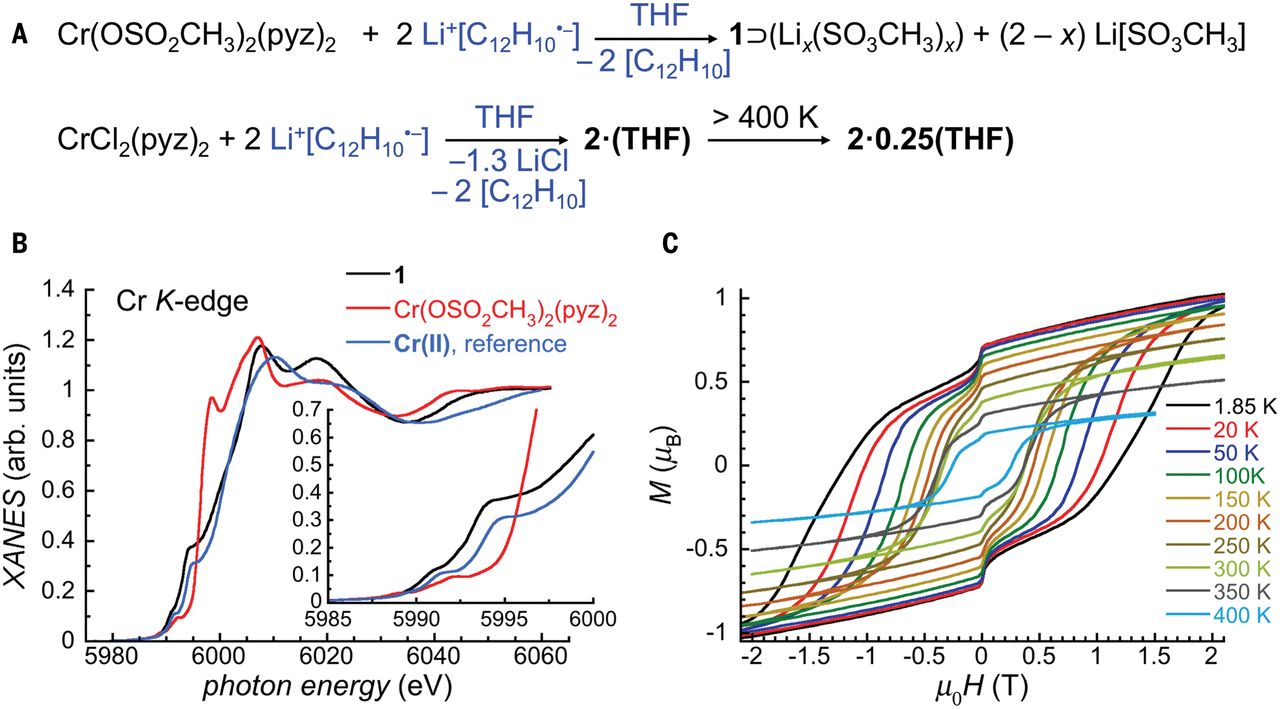
|
Magnets derived from inorganic materials (e.g., oxides, rare-earthâbased, and intermetallic compounds) are key components of modern technological applications. Despite considerable success in a broad range of applications, these inorganic magnets suffer several drawbacks, including energetically expensive fabrication, limited availability of certain constituent elements, high density, and poor scope for chemical tunability. A promising design strategy for next-generation magnets relies on the versatile coordination chemistry of abundant metal ions and inexpensive organic ligands. Following this approach, we report the general, simple, and efficient synthesis of lightweight, molecule-based magnets by postsynthetic reduction of preassembled coordination networks that incorporate chromium metal ions and pyrazine building blocks. The resulting metal-organic ferrimagnets feature critical temperatures up to 242°C and a 7500-oersted room-temperature coercivity. |
Panagiota Perlepe, Itziar Oyarzabal, Aaron Mailman, Morgane Yquel,
Mikhail Platunov, Iurii Dovgaliuk,Mathieu RouziĂšres, Philippe
NĂ©grier, Denise Mondieig, Elizaveta A. Suturina, Marie-Anne
Dourges, SĂ©bastien Bonhommeau, Rebecca A. Musgrave, Kasper
S. Pedersen, Dmitry Chernyshov, Fabrice Wilhelm, Andrei Rogalev,
Corine MathoniÚre, Rodolphe Clérac,
Metal-organic magnets with large coercivity and ordering temperatures up to 242°C,
Science 370, 587-592 (2020)
Enhancing Magnetic Hysteresis in Single-Molecule Magnets by Ligand Functionalization
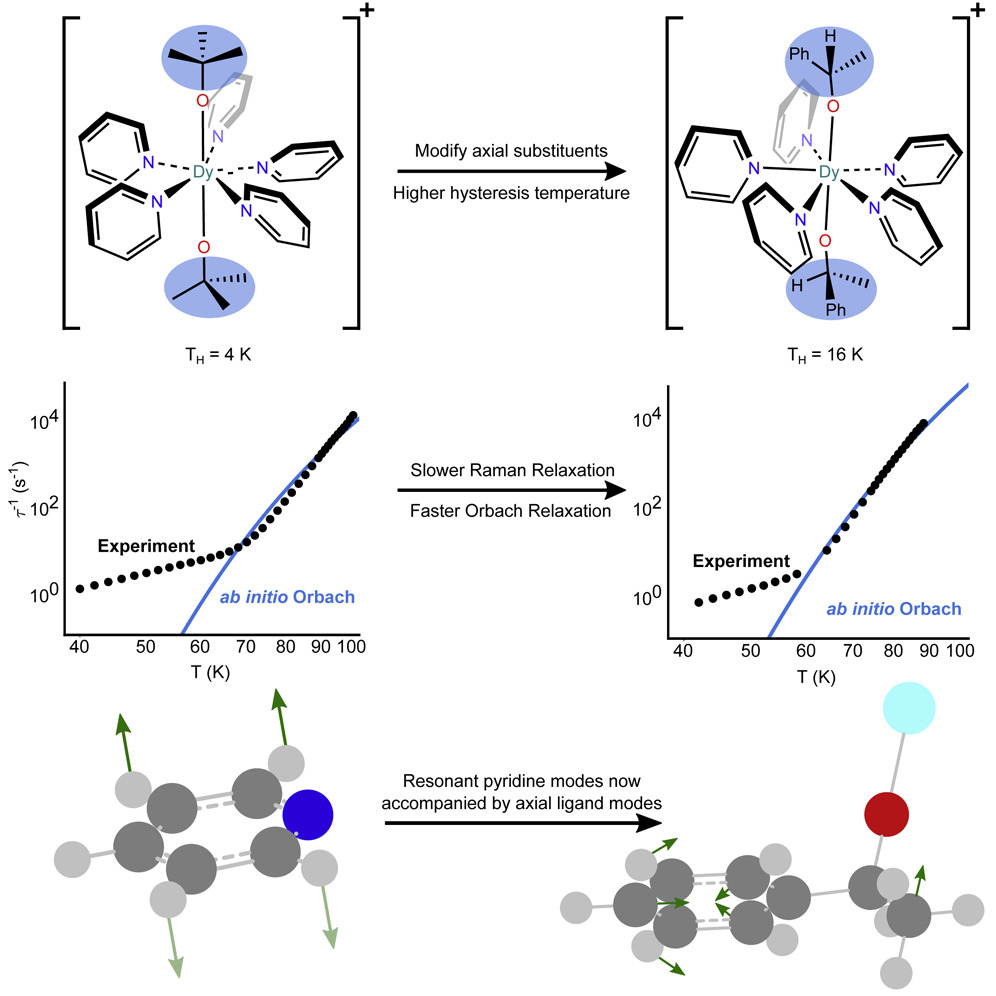
|
Design criteria for dysprosium(III) single-molecule magnets (SMMs) with large thermal energy barriers to magnetic reversal have been established and proven, and the challenge to enhance performance is in understanding and controlling electron-vibration coupling that is the origin of magnetic reversal. The authors have prepared an SMM, [Dy(L)2(py)5][BPh4] (HL = (S)-(-)-1-phenylethanol), based on the archetype [Dy(OtBu)2(py)5][BPh4]. Both compounds have similarly large energy barriers of Ueff = 1,130(20) cmâ1 and Ueff = 1,250(10) cmâ1, and yet the new SMM shows magnetic hysteresis at a far higher temperature of 22 K cf. TH = 4 K for the archetype. Ab initio calculation of the electron-vibration coupling and spin dynamics shows that substitution of the alkoxide ligand in fact enhances relaxation over the energy barrier for the new SMM compared with to the precursor, in agreement with experiment, and that the higher temperature of magnetic hysteresis likely owes to reduced quantum tunneling at low temperatures. |
Ke-Xin Yu, Jon G.C. Kragskow, You-Song Ding, Yuan-QiZhai, Daniel
Reta, Nicholas F. Chilton, Yan-Zhen Zheng,
Enhancing Magnetic Hysteresis in Single-Molecule Magnets by Ligand Functionalization,
Chem, Volume 6, Issue 7, 9 July 2020, Pages 1777-1793
Molecule-based magnetic materials constructed from paramagnetic organic ligands and two different metal ions
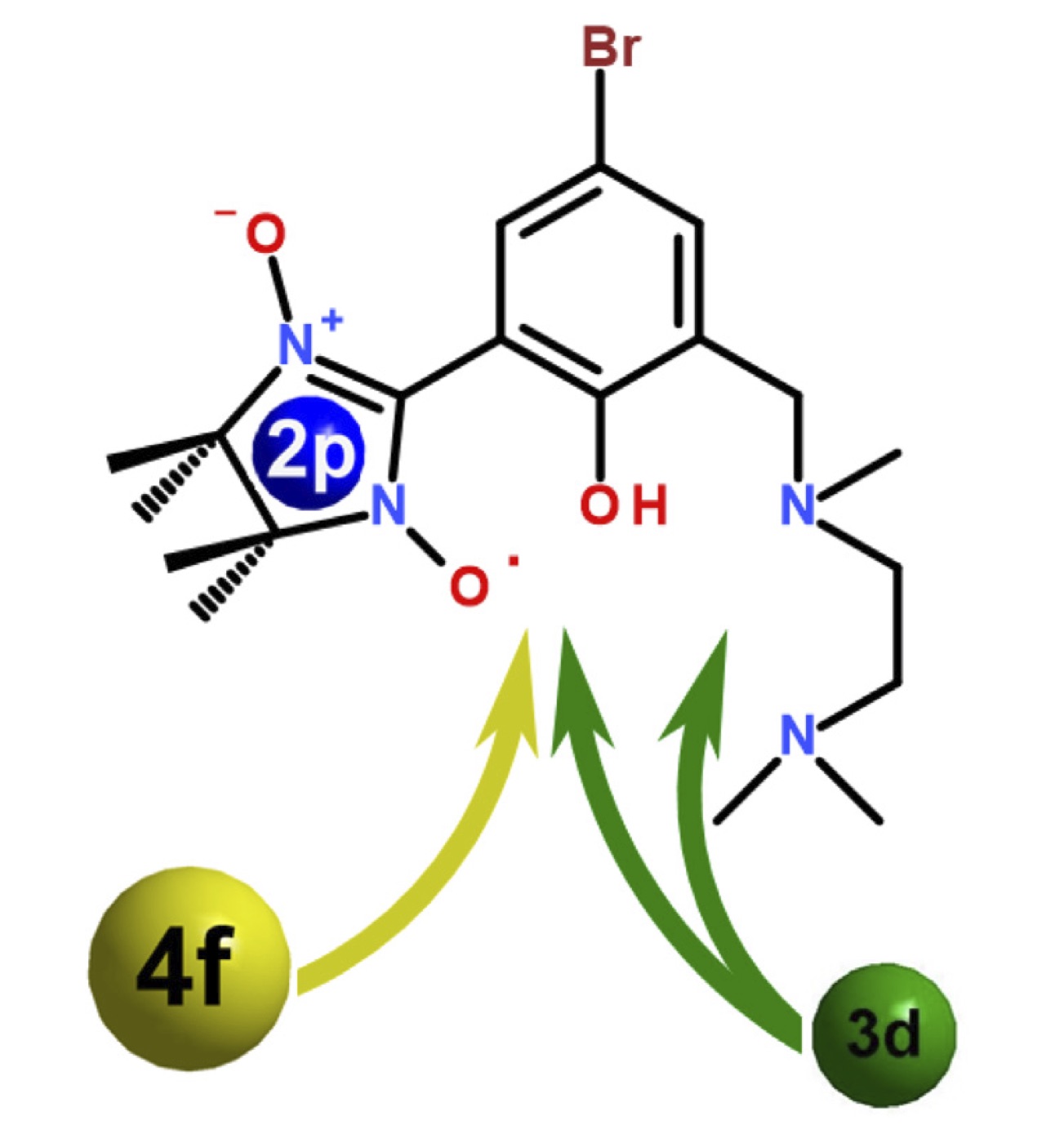
|
This paper reviews the most representative examples of polynuclear complexes containing three spin carriers: a paramagnetic organic ligand (nitronyl-nitroxide, imino-nitroxide, TEMPO, verdazyl and TCNQradical dot-radicals) and two different metal ions (3d-3dâ, 3d-4f), focusing on their magnetic properties. The synthetic approaches leading to such compounds are presented. These compounds show a rich structural variety, ranging from discrete species to coordination polymers with various dimensionalities and spin topologies. The general synthetic strategies leading to such compounds are discussed and illustrated. Some 2p-3d-4f complexes have relevance in the field of molecular nanomagnets (Single Molecule Magnets and Single Chain Magnets). |
Maria G.F. Vaz, Marius Andruh,
Molecule-based magnetic materials constructed from paramagnetic organic ligands and two different metal ions,
Coordination Chemistry Reviews 427, 2021, 213611
Engineering macrocyclic high performance pentagonal bipyramidal Dy(iii) single-ion magnets
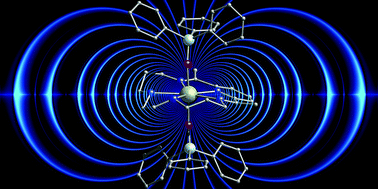
|
The authors generate a new air-stable pseudo-D5h Dy(III) Single-Molecule Magnet (Ueff = 1108 K, TB = 14 K) by combining a weak equatorial ligand field from a macrocyclic LN5 ligand with a strong axial ligand field. Based on their synthetic blueprint, they use ab initio calculations to show the vast scope for macrocyclic engineering of magnetic anisotropy. |
Angelos B. Canaj, Sourav Dey, Claire Wilson, Oscar CĂ©spedes, Gopalan
Rajaraman and Mark Murrie,
Engineering macrocyclic high performance pentagonal bipyramidal Dy(iii) single-ion magnets,
Chem. Commun., 2020, Advance Article
Constructing clock-transition-based two-qubit gates from dimers of molecular nanomagnets
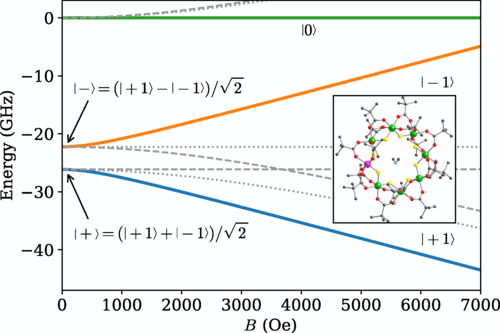
|
A good qubit must have a coherence time long enough for gate operations to be performed. Avoided level crossings allow for clock transitions in which coherence is enhanced by the insensitivity of the transition to fluctuations in external fields. Because of this insensitivity, it is not obvious how to effectively couple qubits together while retaining clock-transition behavior. Here the authors present a scheme for using a heterodimer of two coupled molecular nanomagnets, each with a clock transition at zero magnetic field, in which all of the gate operations needed to implement one- and two-qubit gates can be implemented with pulsed radio-frequency radiation. The authors show that given realistic coupling strengths between the nanomagnets in the dimer, good gate fidelities can be achieved. The authors identify the primary sources of error in implementing gates and discuss how these may be mitigated, and investigate the range of coherence times necessary for such a system to be a viable platform for implementing quantum computing protocols. |
Charles A. Collett, Paolo Santini, Stefano Carretta, and
Jonathan R. Friedman,
Constructing clock-transition-based two-qubit gates from dimers of molecular nanomagnets,
Phys. Rev. Research 2, 032037(R) (2020)
Magnetocaloric and barocaloric effects of metal complexes for solid state cooling: Review, trends and perspectives
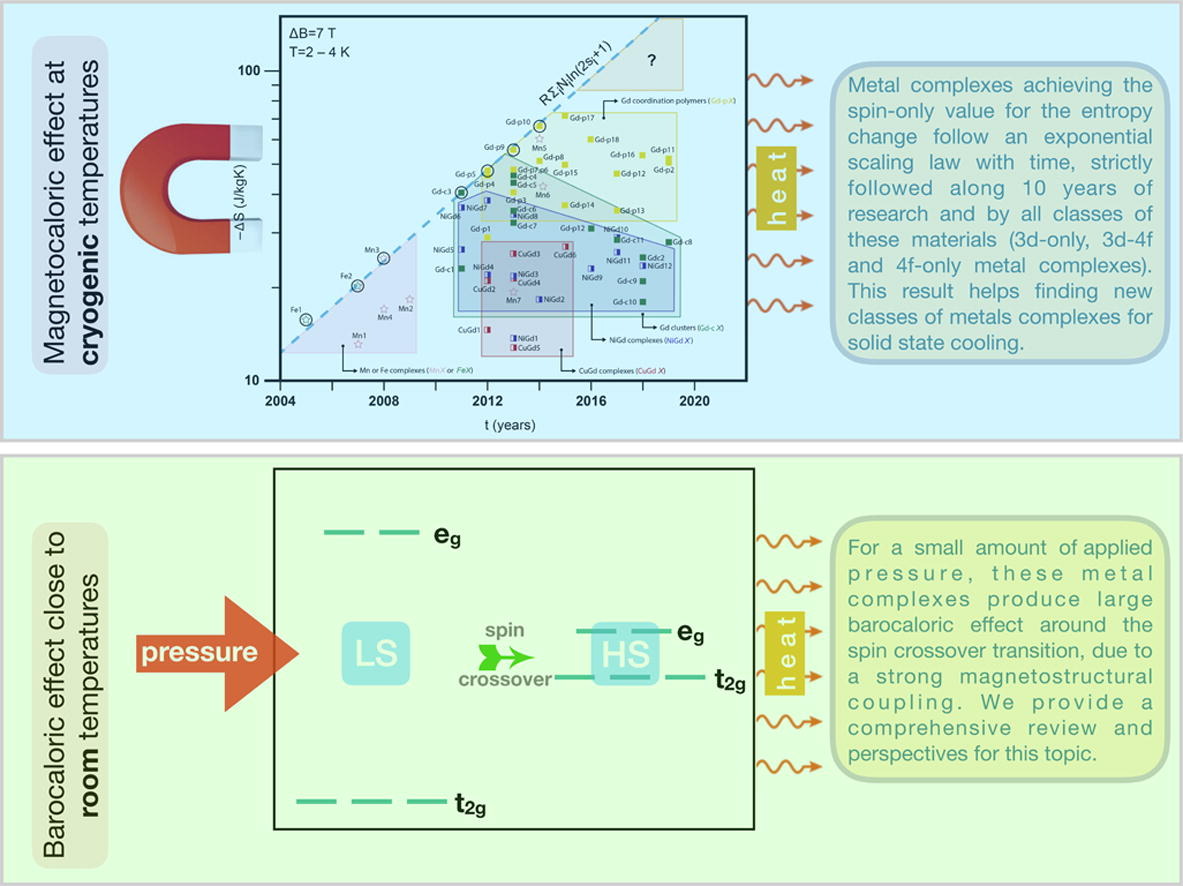
|
Solid state refrigeration is a viable alternative for the conventional gas-compression technology due to the environmental friendliness of its materials, energy efficiency, and low noise. Research in this field is focused on the development of advanced prototypes and smart materials. This Review focuses on a special family of quantum materials: metal complexes. The author introduces the fundamentals of caloric effects and magnetism of these complexes, discussing their applications at different ranges of temperature, based on different physical mechanisms. At cryogenic temperatures (close to temperature of liquid He), some metal complexes present a huge value of magnetic entropy change, ranging from c.a. 10 J/kgK to c.a. 70 J/kgK (for 7 T of magnetic field change). These values make some metal complexes appealing as cryogenic coolant materials. The author also presents a comprehensive collection of results from the literature, organized on a chart as a function of time, for different classes of metal complexes; those with 3d-3d magnetic interactions, 3d-4f coupling, and 4f-4f interactions. The author observed that those materials that achieved the maximum value of entropy change, i.e., the spin-only value, follow an exponential scaling law with time. This result helps to predict a new class of metal complexes and further outcomes for the field. On the other hand, for a small amount of applied pressure, these materials produce large barocaloric effect around the spin crossover transition (this transition occurs in a wide range of temperature, even close to room temperature). Thus, the author introduces the SCO mechanism and comprehensively review this topic, along with the recent theoretical models and experimental results. The recent results of barocaloric effect are considered enormously significant (56 J/kgK for 0.9 kbar of pressure change, close to room temperature), even in comparison with traditional metallic barocaloric materials. Perspectives for this subject, with discussions about new mechanisms for the models (as the Jahn-Teller distortion and orbital contribution), are also presented. |
Mario S.Reis,
Magnetocaloric and barocaloric effects of metal complexes for solid state cooling: Review, trends and perspectives,
Coordination Chemistry Reviews,
Volume 417, 15 August 2020, 213357
Exploring the Magnetic Properties of the Largest Single-Molecule Magnets
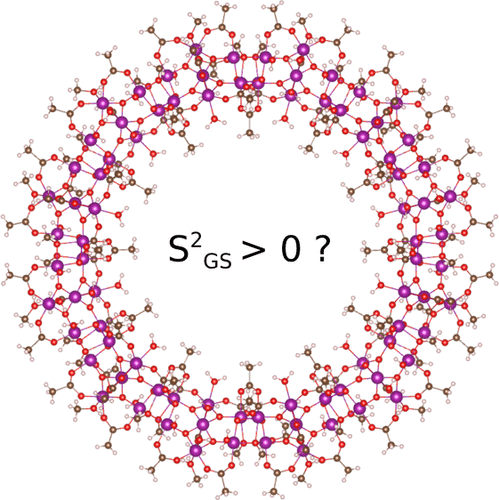
|
The giant {Mn70} and {Mn84} wheels are the largest nuclearity single-molecule magnets synthesized to date, and understanding their magnetic properties poses a challenge to theory. Starting from first-principles calculations, the authors explore the magnetic properties and excitations in these wheels using effective spin Hamiltonians. They find that the unusual geometry of the superexchange pathways leads to weakly coupled {Mn7} subunits carrying an effective S = 2 spin. The spectrum exhibits a hierarchy of energy scales and massive degeneracies, with the lowest-energy excitations arising from Heisenberg-ring-like excitations of the {Mn7} subunits around the wheel. The authors further describe how weak longer-range couplings can select the precise spin ground-state of the Mn wheels out of the nearly degenerate ground-state band. |
Henry F. Schurkus, Dianteng Chen, Matthew J. O'Rourke, Hai-Ping
Cheng, Garnet Kin-Lic Chan,
Exploring the Magnetic Properties of the Largest Single-Molecule Magnets,
J. Phys. Chem. Lett. 2020, 11, 10, 3789-3795
Modelling the properties of magnetic clusters with complex structures: how symmetry can help us
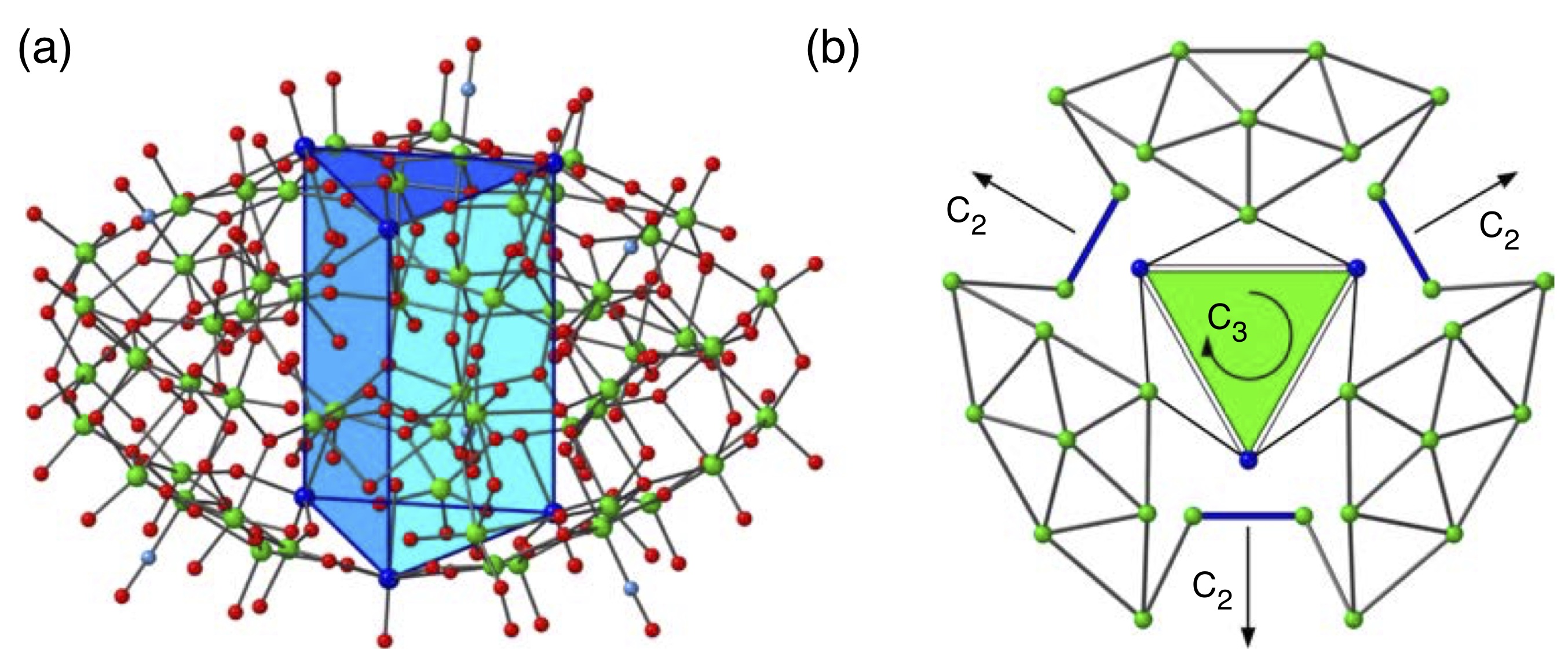
|
The purpose of this article is to answer the question of how symmetry helps us to investigate and understand the properties of nanoscopic magnetic clusters with complex structures. The systems of choice will be the three types of polyoxometalates (POMs): (1) POMs containing localised spins; (2) reduced mixed-valence (MV) POMs; (3) partially delocalised POMs in which localised and delocalised subunits coexist and interact. The theoretical tools based on various kinds of symme- try are the following: (1) irreducible tensor operator (ITO) approach based on the so-called "spin-symmetry" and MAGPACK program; (2) group-theoretical assignment of the exchange multiplets based on spin- and point symmetries; (3) group-theoretical classification of the delocalised electronic and electron-vibrational states of MV POMs; (4) general approach (based on spin symmetry) to evaluate the energy levels of large MV clusters and the corresponding MVPACK program; (5) computational approach (employing point symmetry) to solve multidimensional non-adiabatic vibronic problems in the nanoscopic systems realized as VIBPACK software. We made it our goal to avoid a conventional deductive style of presentation. On the contrary, we first consider specially selected complex POMs and then show by what methods and in what way the theoretical problems arising in the description of the properties of these molecules can be properly solved. |
Boris Tsukerblat, Andrew Paliib, Juan Modesto Clemente-Juan, Eugenio Coronado,
Modelling the properties of magnetic clusters with complex structures: how symmetry can help us,
INTERNATIONAL REVIEWS IN PHYSICAL CHEMISTRY 2020, VOL. 39, NO. 2, 217-265
Unbiased evaluation of zero-field splitting D parameter in high-spin molecules from DC magnetic data with incomplete powder averaging
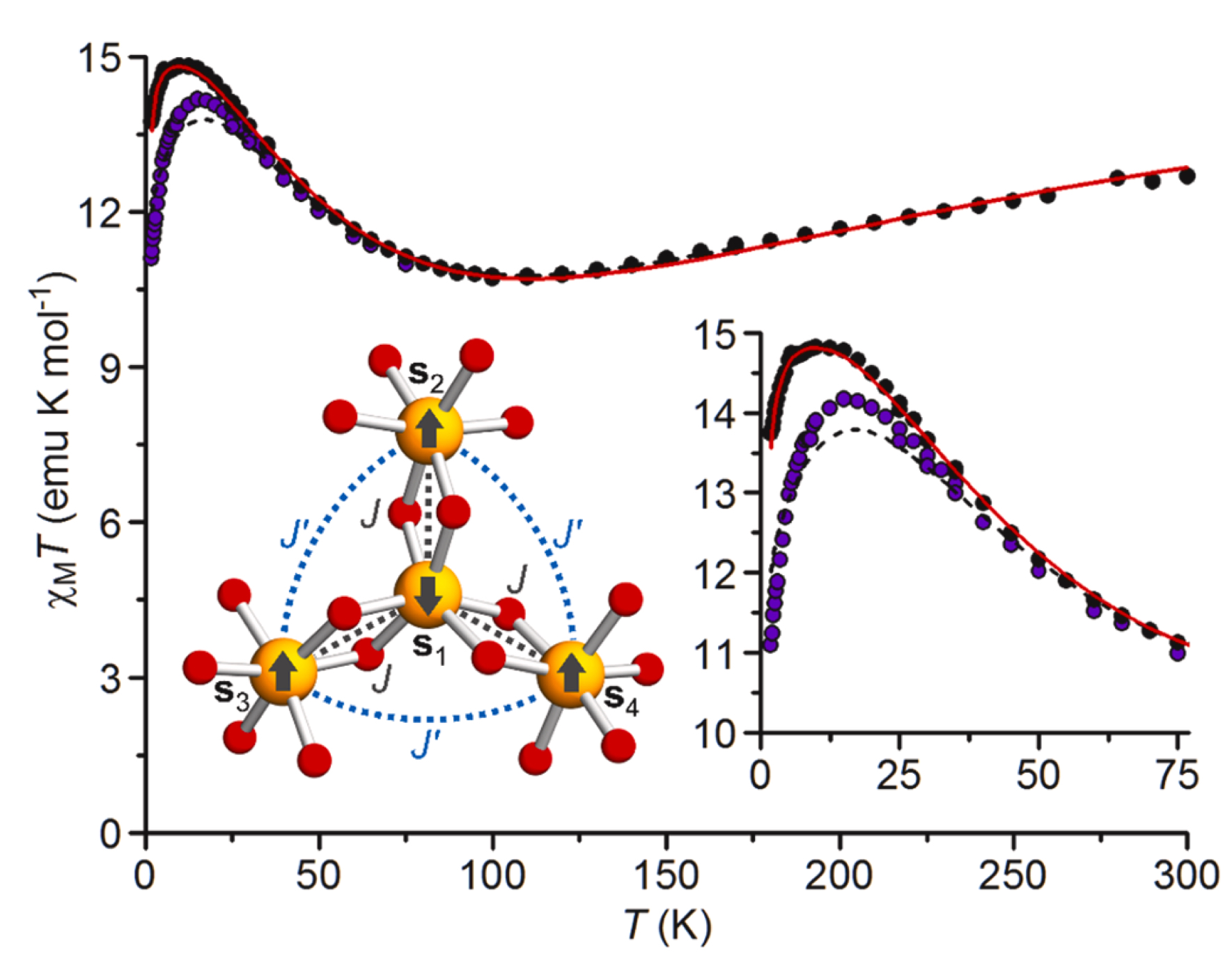
|
A simple scheme is presented to account for preferential orientation effects in the DC magnetic response of polycrystalline samples of anisotropic high-spin molecules, like single-molecule magnets. A single additional least-squares parameter is introduced in the fitting of isothermal magnetization vs. field data to describe the leading part of a non-spherical distribution of anisotropy axes. The procedure is shown to afford an accurate D parameter and is potentially applicable whenever complete powder averaging cannot be achieved. |
Andrea Cornia, Anne-Laure Barra, Giordano Poneti, Erik Tancini, RobertaSessoli,
Unbiased evaluation of zero-field splitting D parameter in
high-spin molecules from DC magnetic data with incomplete powder
averaging,
JMMM 510 (2020) 166713
Single-Molecule Toroic Design through Magnetic Exchange Coupling
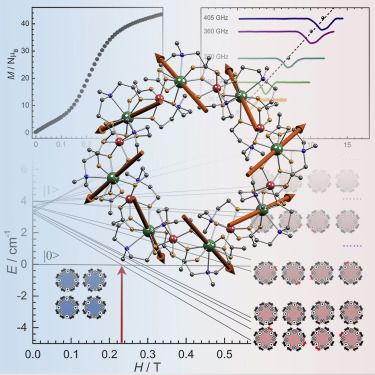
|
The big data era calls for larger capacity of our hard drive, which in turn depends on the number of magnetic units that store bits of 1 or 0. However, as the density of these units increases, flipping one unit without affecting another becomes more difficult because of undesired magnetic perturbations from the reading/writing heads. Single-molecule toroics (SMTs) that exploit vortex-like magnetic structures are insensitive to homogeneous magnetic fields and hence are promising for next-generation ultra-dense information storage. However, the synthesis of such molecular materials is challenging. Here, we show by using ferromagnetic interactions that this target can be realized in a 16-membered heterometallic cluster {Fe8Dy8}, which shows a stable 4-fold degenerated magnetic toroidal ground state at low temperatures. This is significantly distinguished from the most studied dipole-dipole interaction-based SMTs and demonstrates a promising strategy for the next generation of SMT design. |
Hao-Lan Zhang, Yuan-Qi Zhai, Lei Qin, Liviu Ungur, Hiroyuki Nojiri, Yan-Zhen Zheng,
Single-Molecule Toroic Design through Magnetic Exchange Coupling,
Matter, Volume 2, Issue 6, 3 June 2020, Pages 1481-1493
Vibrational coherences in manganese single-molecule magnets after ultrafast photoexcitation
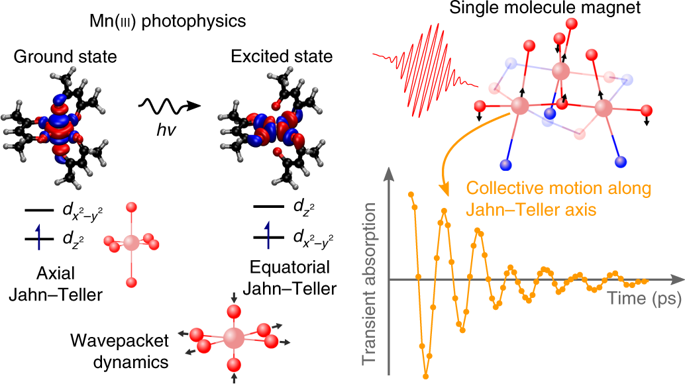
|
Magnetic recording using femtosecond laser pulses has recently been achieved in some dielectric media, showing potential for ultrafast data storage applications. Single-molecule magnets (SMMs) are metal complexes with two degenerate magnetic ground states and are promising for increasing storage density, but remain unexplored using ultrafast techniques. Here the authors have explored the dynamics occurring after photoexcitation of a trinuclear μ3-oxo-bridged Mn(III)-based SMM, whose magnetic anisotropy is closely related to the Jahn-Teller distortion. Ultrafast transient absorption spectroscopy in solution reveals oscillations superimposed on the decay traces due to a vibrational wavepacket. Based on complementary measurements and calculations on the monomer Mn(acac)3, we conclude that the wavepacket motion in the trinuclear SMM is constrained along the Jahn-Teller axis due to the μ3-oxo and ”-oxime bridges. The results provide new possibilities for optical control of the magnetization in SMMs on femtosecond timescales and open up new molecular-design challenges to control the wavepacket motion in the excited state of polynuclear transition-metal complexes. |
Florian Liedy, Julien Eng, Robbie McNab, Ross Inglis, Thomas
J. Penfold, Euan K. Brechin, J. Olof Johansson,
Vibrational coherences in manganese single-molecule magnets after ultrafast photoexcitation,
Nature Chemistry volume 12, pages452-458(2020)
Dysprosiacarboranes: A New Type of Organometallic Single-Molecule Magnet
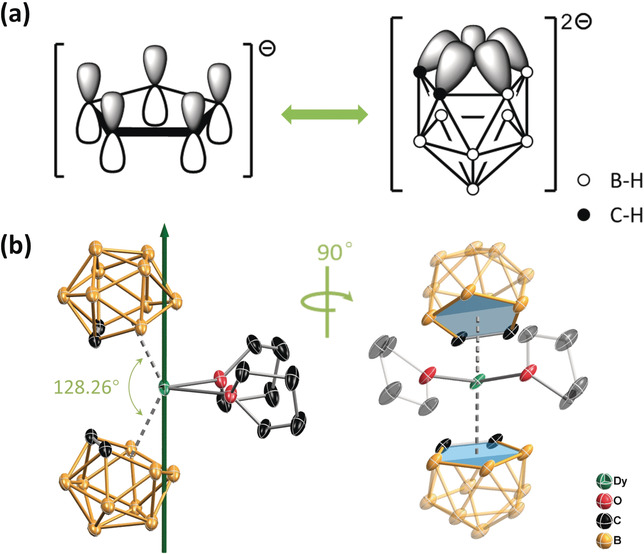
|
The dicarbollide ion, nido-C2B9H112- is isoelectronic with cyclopentadienyl. Here the authors make dysprosiacarboranes, namely [(C2B9H11)2Ln(THF)2][Na(THF)5] (Ln = Dy, 1Dy ) and [(THF)3(μ-H)3Li]2[{η5-C6H4(CH2)2C2B9H9 }Dy{η2:η5-C6H4 (CH2)2C2B9H9}2Li] 3Dy and show that dicarbollide ligands impose strong magnetic axiality on the central Dy(III) ion. The effective energy barrier ( U eff ) for loss of magnetisation can be varied by the substitution pattern on the dicarbollide. This is demonstrated by comparing complexes of nido-C2B9H112- and nido-[o-xylylene-C2B9H92- which show U eff of 430(5) K and 804(7) K, respectively. The blocking temperature defined by the open hysteresis temperature of 3Dy reaches 6.8 K. Moreover, the linear complex [Dy(nido-C2B9H11)2]- is predicted to have comparable properties with linear [Dy(CpMe3)2]+ complex. As such, carboranyl ligands and its derivatives may open a new type of organometallic ligands for high-performance single-molecule magnets. |
Peng-Bo Jin, Yuan-Qi Zhai, Ke-Xin Yu, Richard
E. P. Winpenny, Yan-Zhen Zheng,
Dysprosiacarboranes: A New Type of Organometallic
Single-Molecule Magnet,
Angew. Chem. Int. Ed., Volume59, Issue 24
June 8, 2020, Pages 9350-9354
Decoherence in Molecular Electron Spin Qubits: Insights from Quantum Many-Body Simulations
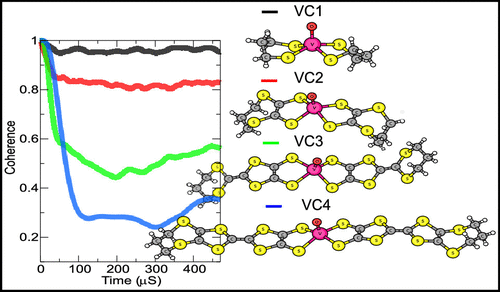
|
Quantum states are described by wave functions whose phases cannot be directly measured but which play a vital role in quantum effects such as interference and entanglement. The loss of the relative phase information, termed decoherence, arises from the interactions between a quantum system and its environment. Decoherence is perhaps the biggest obstacle on the path to reliable quantum computing. Here we show that decoherence occurs even in an isolated molecule, although not all phase information is lost, via a theoretical study of a central electron spin qubit interacting with nearby nuclear spins in prototypical magnetic molecules. The residual coherence, which is molecule-dependent, provides a microscopic rationalization for the nuclear spin diffusion barrier proposed to explain experiments. The contribution of nearby molecules to the decoherence has a nontrivial dependence on separation, peaking at intermediate distances. Molecules that are far away affect only the long-time behavior. Because the residual coherence is simple to calculate and correlates well with the coherence time, it can be used as a descriptor for coherence in magnetic molecules. This work will help establish design principles for enhancing coherence in molecular spin qubits and serve to motivate further theoretical work. |
Jia Chen, Cong Hu, John F. Stanton, Stephen Hill, Hai-Ping
Cheng, Xiao-Guang Zhang,
Decoherence in Molecular Electron Spin Qubits: Insights from Quantum Many-Body Simulations,
J. Phys. Chem. Lett. 2020, 11, XXX, 2074-2078
see also:
P. Vorndamme, J. Schnack,
Decoherence of a singlet-triplet superposition state
under dipolar interactions of an uncorrelated environment,
Phys. Rev. B 101, 075101 (2020)
Adjustable coupling and in situ variable frequency electron paramagnetic resonance probe with loop-gap resonators for spectroscopy up to X-band
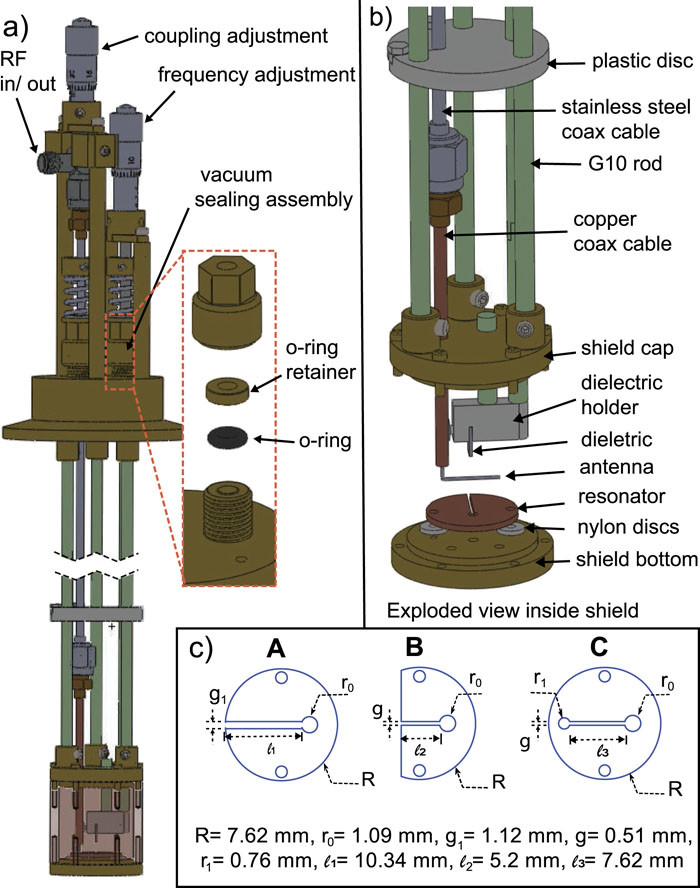
|
In standard electron paramagnetic resonance (EPR) spectroscopy, the frequency of an experiment is set and the spectrum is acquired using the magnetic field as the independent variable. There are cases in which it is desirable instead to fix the field and tune the frequency such as when studying avoided level crossings. The have designed and tested an adjustable frequency and variable coupling EPR probe with loop-gap resonators (LGRs) that works at a temperature as low as 1.8 K. The frequency is tuned by adjusting the height of a dielectric piece of sapphire inserted into the gap of an LGR; coupling of the microwave antenna is varied with the height of the antenna above the LGR. Both coupling antenna and dielectric are located within the cryogenic sample chamber, but their motion is controlled with external micrometers located outside the cryostat. The frequency of the LGR (approx. 4 GHz) can be adjusted by more than 1 GHz (>25%). To cover a wide range of frequencies, different LGRs can be designed to cover frequencies up to X-band. The authors demonstrate the operation of their probe by mapping out avoided crossings for the Ni4 molecular nanomagnet to determine the tunnel splittings with high precision. |
G. Joshi, J. Kubasek, I. Nikolov, B. Sheehan,
T. A. Costa, R. A. Allao Cassaro, Jonathan R. Friedman,
Adjustable coupling and in situ variable frequency
electron paramagnetic resonance probe with loop-gap
resonators for spectroscopy up to X-band,
Review of Scientific Instruments 91,
023104 (2020)
There is nothing wrong with being soft: using sulfur ligands to increase axiality in a Dy(III) single-ion magnet
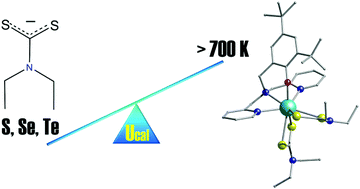
| A new air-stable sulfur-ligated Dy(III) single-ion magnet has been successfully isolated with Ueff = 638 K and hysteresis loops open up to 7 K. In silico studies show that the S co-ligands significantly boost the axiality and that Te- and Se-donors have the potential to further enhance the magnetic properties. |
Angelos B. Canaj, Sourav Dey, Oscar Cespedes, Claire Wilson,
Gopalan Rajaraman, Mark Murrie,
There is nothing wrong with being soft: using sulfur ligands to increase axiality in a Dy(III) single-ion magnet,
Chem. Commun., 2020, Advance Article
Quantum units from the topological engineering of molecular graphenoids
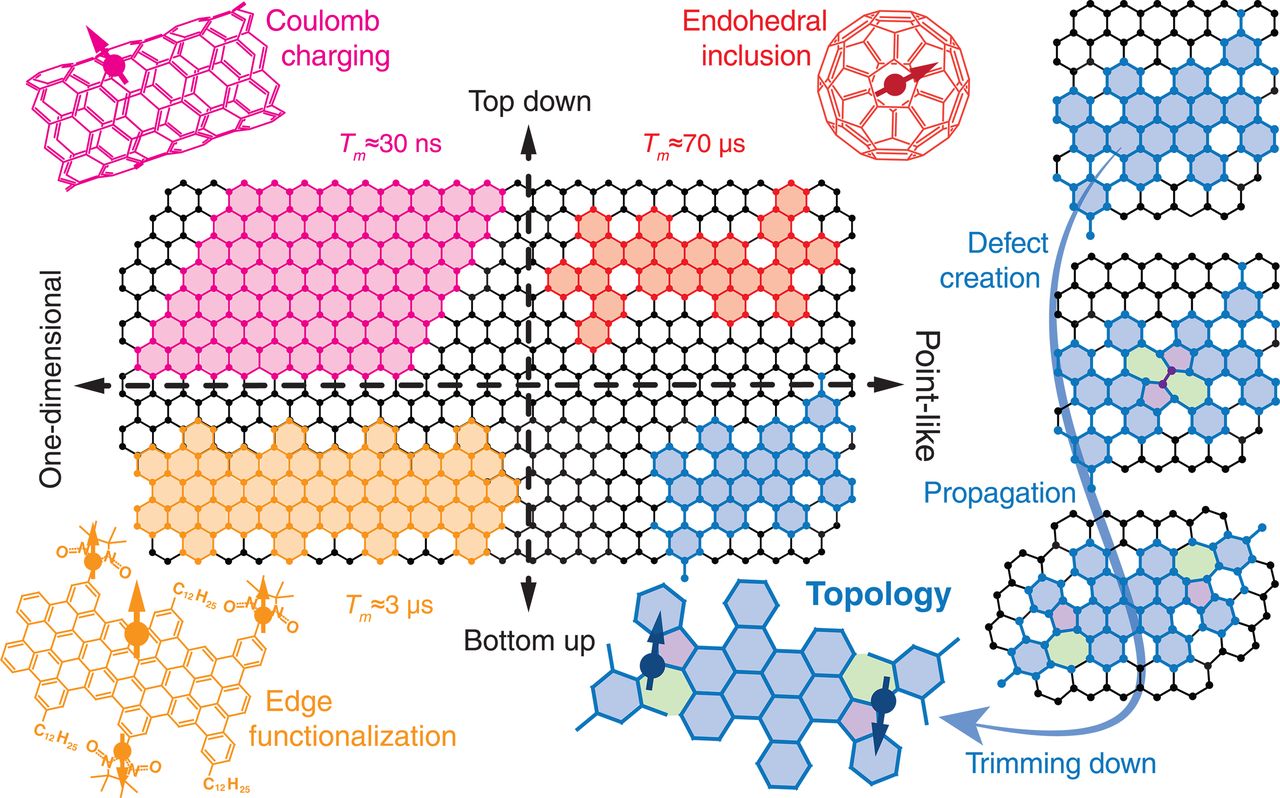
| Robustly coherent spin centers that can be integrated into devices are a key ingredient of quantum technologies. Vacancies in semiconductors are excellent candidates, and theory predicts that defects in conjugated carbon materials should also display long coherence times. However, the quantum performance of carbon nanostructures has remained stunted by an inability to alter the sp2-carbon lattice with atomic precision. Here, the authors demonstrate that topological tailoring leads to superior quantum performance in molecular graphene nanostructures. They unravel the decoherence mechanisms, quantify nuclear and environmental effects, and observe spin-coherence times that outclass most nanomaterials. These results validate long-standing assumptions on the coherent behavior of topological defects in graphene and open up the possibility of introducing controlled quantum-coherent centers in the upcoming generation of carbon-based optoelectronic, electronic, and bioactive systems. |
Federico Lombardi, Alessandro Lodi, Ji Ma, Junzhi Liu,
Michael Slota, Akimitsu Narita, William K. Myers, Klaus
Müllen, Xinliang Feng, Lapo Bogani,
Quantum units from the topological engineering of molecular graphenoids,
Science, Vol. 366, Issue 6469, pp. 1107-1110 (2019)
Machine learning guided design of single-molecule magnets for magnetocaloric applications
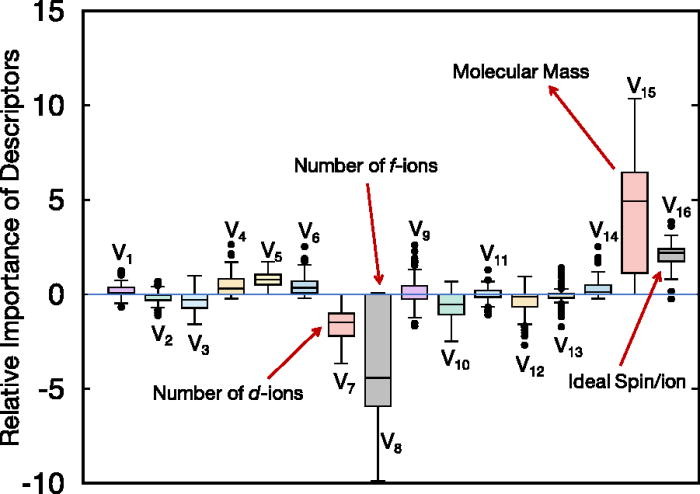
| The authors present a data-driven approach to predict entropy changes in small magnetic fields in single-molecule magnets (SMMs) relevant to their application as magnetocaloric refrigerants. They construct a database of SMMs with a representation scheme incorporating aspects related to dimensionality, structure, local coordination environment, ideal total spin of magnetic ions, ligand type, and linking chemistry. They train machine learning models for predicting the entropy change as a function of structure and chemistry and use the models to arrive at the entropy change for hypothetical molecules. They also identify key descriptors that affect the entropy change, thus providing insights into designing tailored SMMs with improved magnetocaloric properties. |
Ludwig Holleis, B. S. Shivaram, and Prasanna
V. Balachandran,
Machine learning guided design of single-molecule magnets for magnetocaloric applications,
Appl. Phys. Lett. 114, 222404 (2019)
Molecular magnetism: from chemical design to spin control in molecules, materials and devices
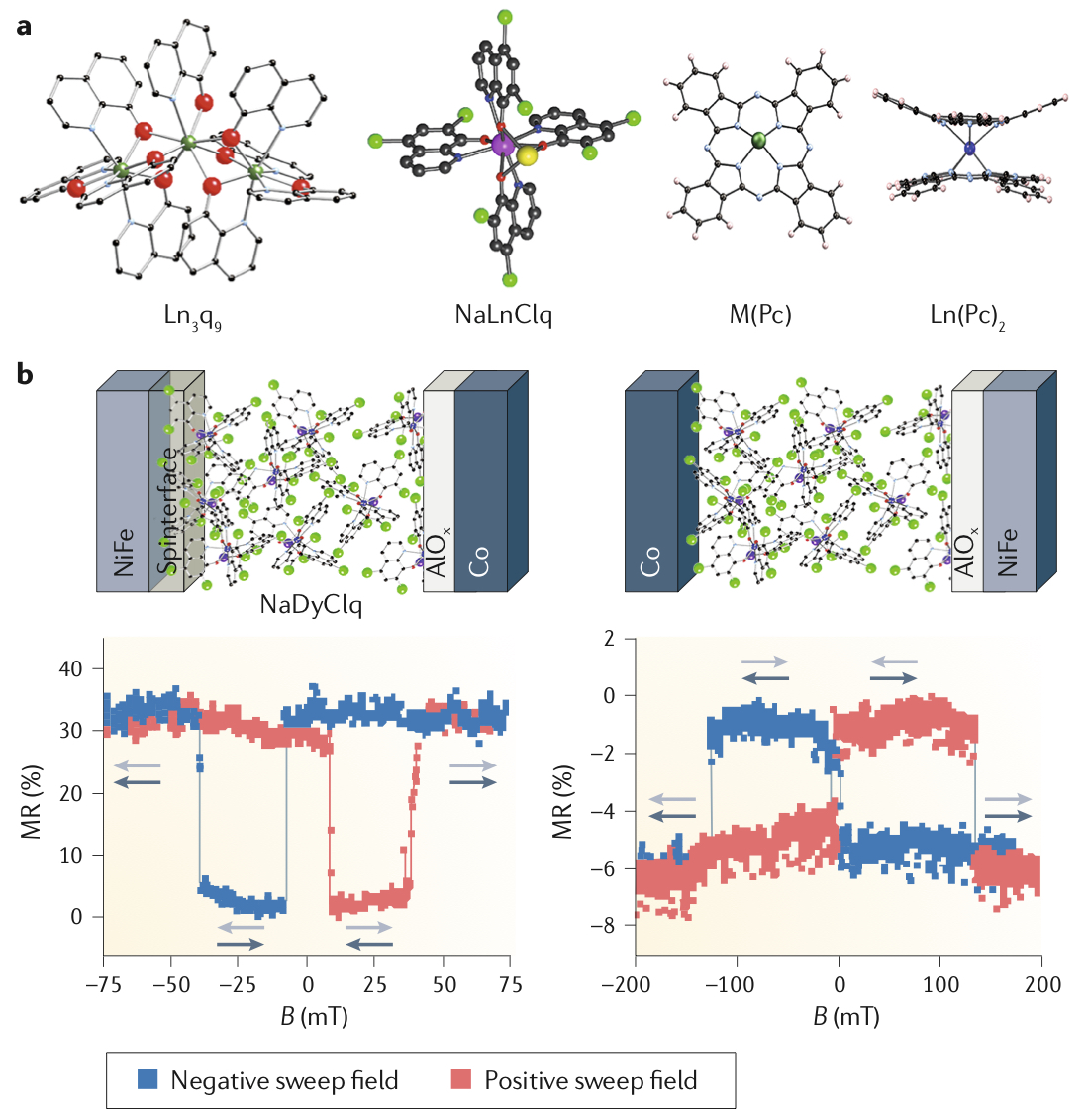
| The field of molecular magnetism is rapidly evolving towards the use of magnetic molecules and molecule-based magnetic materials in physics-driven and nanotechnology-driven fields, in particular molecular spintronics, quantum technologies, metal-organic frameworks (MOFs) and 2D materials. In molecular spintronics, the goal is the development of a new generation of spintronic devices based on molecular materials or, in the longer term, on one or a few molecules. In the area of quantum technologies, the milestones reached in the design of molecular spin qubits with long quantum coherence times and in the implementation of quantum operations have raised expectations for the use of molecular spin qubits in quantum computation. MOFs and 2D materials are two classes of materials for which magnetism has been, until very recently, an elusive property; molecular materials with attractive properties and functionalities are now starting to be developed in both areas. In MOFs, single-molecule magnets and spin crossover complexes can be integrated into the nodes of the framework, within the pores or both, sometimes giving rise to smart magnetic materials or to hybrid materials exhibiting synergistic combinations of properties. 2D molecular-based magnets can provide a platform to study magnetism in the 2D limit and exhibit superior properties compared with their inorganic analogues in terms of chemical stability and tunability. |
Eugenio Coronado,
Molecular magnetism: from chemical design to spin control in molecules, materials and devices,
Nature Reviews Materials (2019)
Uncertainty estimates for magnetic relaxation times and magnetic relaxation parameters
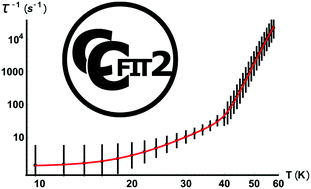
| The use of alternating current (AC) magnetometry to measure magnetic relaxation times is one of the most fundamental measurements for characterising single-molecule magnets (SMMs). These measurements, performed as a function of frequency, temperature and magnetic field, give vital information on the underlying magnetic relaxation process(es) occurring in the material. The magnetic relaxation times are usually fitted to model functions derived from spin-phonon coupling theories that allow characterisation of the mechanisms of magnetic relaxation. The parameters of these relaxation models are then often compared between different molecules in order to find trends with molecular structure that may guide the field to the next breakthrough. However, such meta-analyses of the model parameters are doomed to over-interpretation unless uncertainties in the model parameters can be quantified. Here we determine a method for obtaining uncertainty estimates in magnetic relaxation times from AC experiments, and provide a program called CC-FIT2 for fitting experimental AC data as well as the resulting relaxation times, to obtain relaxation parameters with accurate uncertainties. Applying our approach to three archetypal families of high-performance dysprosium(III) SMMs shows that accounting for uncertainties has a significant impact on the uncertainties of relaxation parameters, and that larger uncertainties appear to correlate with crystallographic disorder in the compounds studied. We suggest that this type of analysis should become routine in the community. |
Daniel Reta and Nicholas F. Chilton,
Uncertainty estimates for magnetic relaxation times and magnetic relaxation parameters,
Phys. Chem. Chem. Phys., 2019, Advance Article
No time to read a book? Read this!
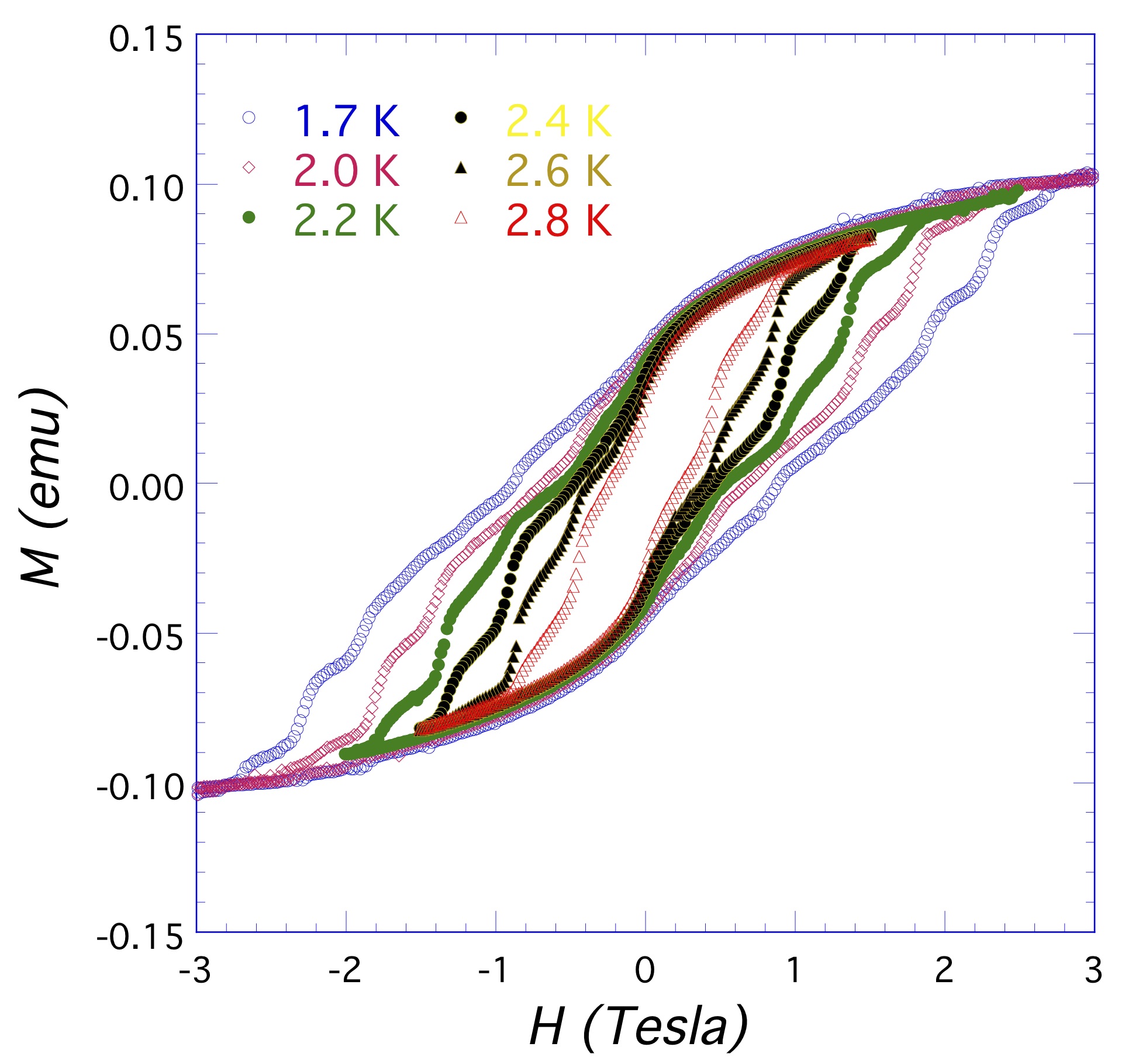
| Two reviews cover the fascination of magnetic molecules from the perspective of physicists. The articles treat single molecules magnets, low-dimensional magnets, spin crossovers, magnetic wheels as well as other compounds. Phenomena such as slow relaxation of magnetization, magnetization tunneling, physical properties depending on frustration, magnetocalorics and quantum phase transitions are discussed. A rich bibliography is provided. |
Stephen J. Blundell,
Molecular Magnets,
Contemporary Physics 48 (2008) 275-290
Jürgen Schnack,
Large magnetic molecules and what we learn from them,
Contemporary Physics 60 (2019) 127-144
Origin of Spin-Dependent Tunneling Through Chiral Molecules
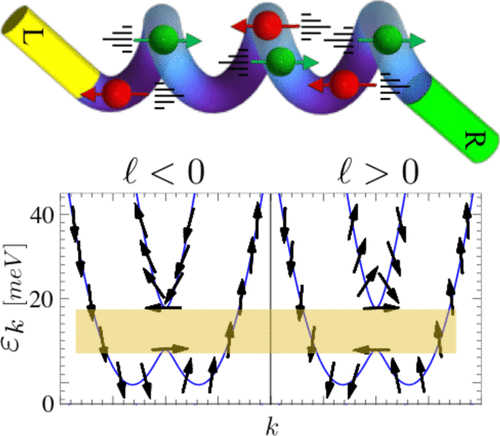
| The functionality of many biological systems depends on reliable electron transfer with minimal heating. Interestingly, nature realizes electron transport via insulating molecules, in contrast to man-made electronic devices which are based on metals and semiconductors. The high efficiency of electron transfer through these organic molecules is unexpected for tunneling-based transport, and it is one of the most compelling questions in the field. Furthermore, it has been shown that the electron tunneling probability is strongly spin-dependent. Here, the authors demonstrate that the chiral structure of these molecules gives rise to robust coherent electron transfer. The authors introduce spin into the analysis of tunneling through organic helical molecules and show that they support strong spin filtering accompanied by enhanced transmission. Thus, the study resolves two key questions posed by transport measurements through organic molecules. |
Karen Michaeli, Ron Naaman,
Origin of Spin-Dependent Tunneling Through Chiral Molecules,
J. Phys. Chem. C 2019, 123, 27, 17043-17048
Air-stable redox-active nanomagnets with lanthanide spins radical-bridged by a metal-metal bond
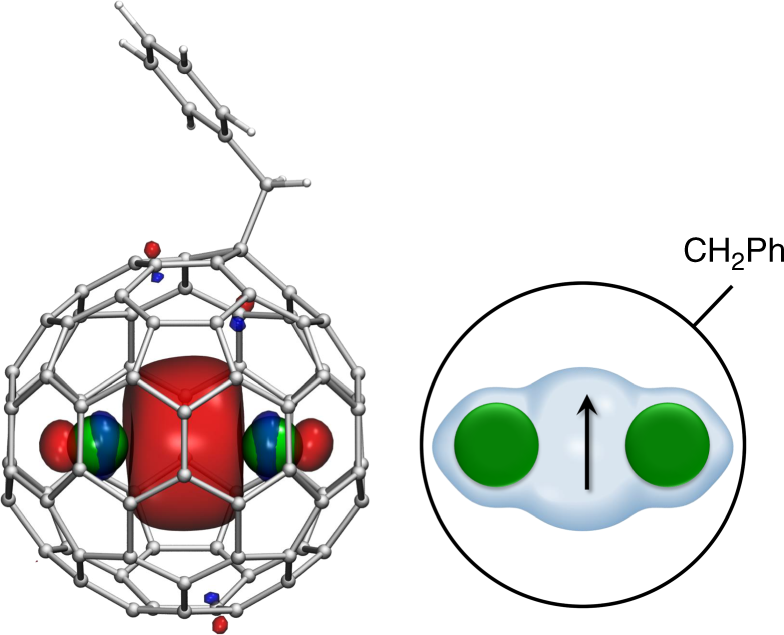
| Engineering intramolecular exchange interactions between magnetic metal atoms is a ubiquitous strategy for designing molecular magnets. For lanthanides, the localized nature of 4f electrons usually results in weak exchange coupling. Mediating magnetic interactions between lanthanide ions via radical bridges is a fruitful strategy towards stronger coupling. In this work we explore the limiting case when the role of a radical bridge is played by a single unpaired electron. We synthesize an array of air-stable Ln2@C80(CH2Ph) dimetallofullerenes (Ln2=Y2, Gd2, Tb2, Dy2, Ho2, Er2, TbY, TbGd) featuring a covalent lanthanide-lanthanide bond. The lanthanide spins are glued together by very strong exchange interactions between 4f moments and a single electron residing on the metal-metal bonding orbital. Tb2@C80(CH2Ph) shows a gigantic coercivity of 8.2 Tesla at 5 K and a high 100-s blocking temperature of magnetization of 25.2 K. The Ln-Ln bonding orbital in Ln2@C80(CH2Ph) is redox active, enabling electrochemical tuning of the magnetism. |
Fupin Liu, Georgios Velkos, Denis S. Krylov, Lukas Spree, Michal
Zalibera, Rajyavardhan Ray, Nataliya A. Samoylova, Chia-Hsiang
Chen, Marco Rosenkranz, Sandra Schiemenz, Frank Ziegs,
Konstantin Nenkov, Aram Kostanyan, Thomas Greber, Anja
U. B. Wolter, Manuel Richter, Bernd Büchner, Stanislav
M. Avdoshenko & Alexey A. Popov,
Air-stable redox-active nanomagnets with lanthanide spins radical-bridged by a metal-metal bond,
Nature Communicationsvolume 10, Article number: 571 (2019)
Rare "Janus"-faced {FeII7} single-molecule magnet exhibiting intramolecular ferromagnetic interactions
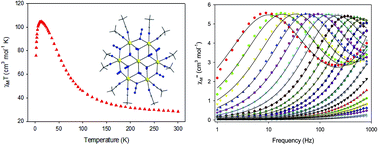
| A rare disk-like single-molecule magnet (SMM) exclusively bridged by end-on azides with a spin ground state of S=14 was prepared by the reaction of a divalent Fe(II) precursor with Me3SiN3 under basic conditions. AC magnetic susceptibility studies revealed unusual, "Janus"-faced SMM behavior for the dried and pristine forms of the compound attributed to solvation/de-solvation effects of the coordinated MeCN ligands which leads to alterations in the crystal field and symmetry of the metal ions. DFT calculations confirmed the ferromagnetic nature of the interactions between the FeII spin carriers with the zero-field splitting parameters D=-0.2323 cm-1 and E/D=0.027. The results have important implications for the future study of single-molecule magnets incorporating volatile solvent molecules in the first coordination sphere of the metal ions and their effect on the relaxation dynamics. |
Dimitris I. Alexandropoulos, Kuduva R. Vignesh, Theocharis
C. Stamatatos, Kim R. Dunbar, Rare "Janus"-faced {FeII7} single-molecule magnet exhibiting intramolecular ferromagnetic interactions,
Chem. Sci., 2019,10, 1626-1633
Chemistry and Quantum Mechanics in 2019: Give Us Insight and Numbers
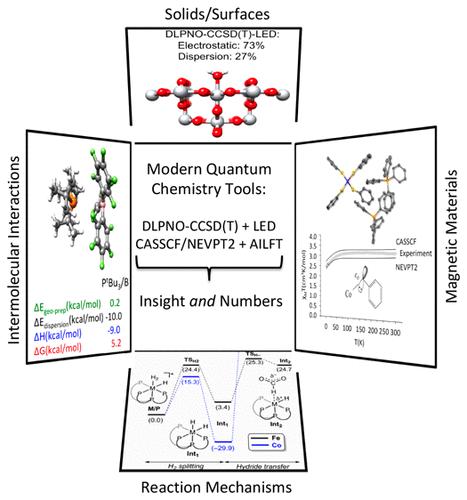
| This Perspective revisits Charles Coulson's famous statement from 1959 "give us insight not numbers" in which he pointed out that accurate computations and chemical understanding often do not go hand in hand. The authors argue that today, accurate wave function based first-principle calculations can be performed on large molecular systems, while tools are available to interpret the results of these calculations in chemical language. This leads us to modify Coulson's statement to "give us insight and numbers". Examples from organic, inorganic, organometallic and surface chemistry as well as molecular magnetism illustrate the points made. |
Frank Neese, Mihail Atanasov, Giovanni Bistoni, Dimitrios
Maganas, Shengfa Ye,
Chemistry and Quantum Mechanics in 2019: Give Us Insight and Numbers,
J. Am. Chem. Soc.201914172814-2824
A linear cobalt(II) complex with maximal orbital angular momentum from a non-Aufbau ground state
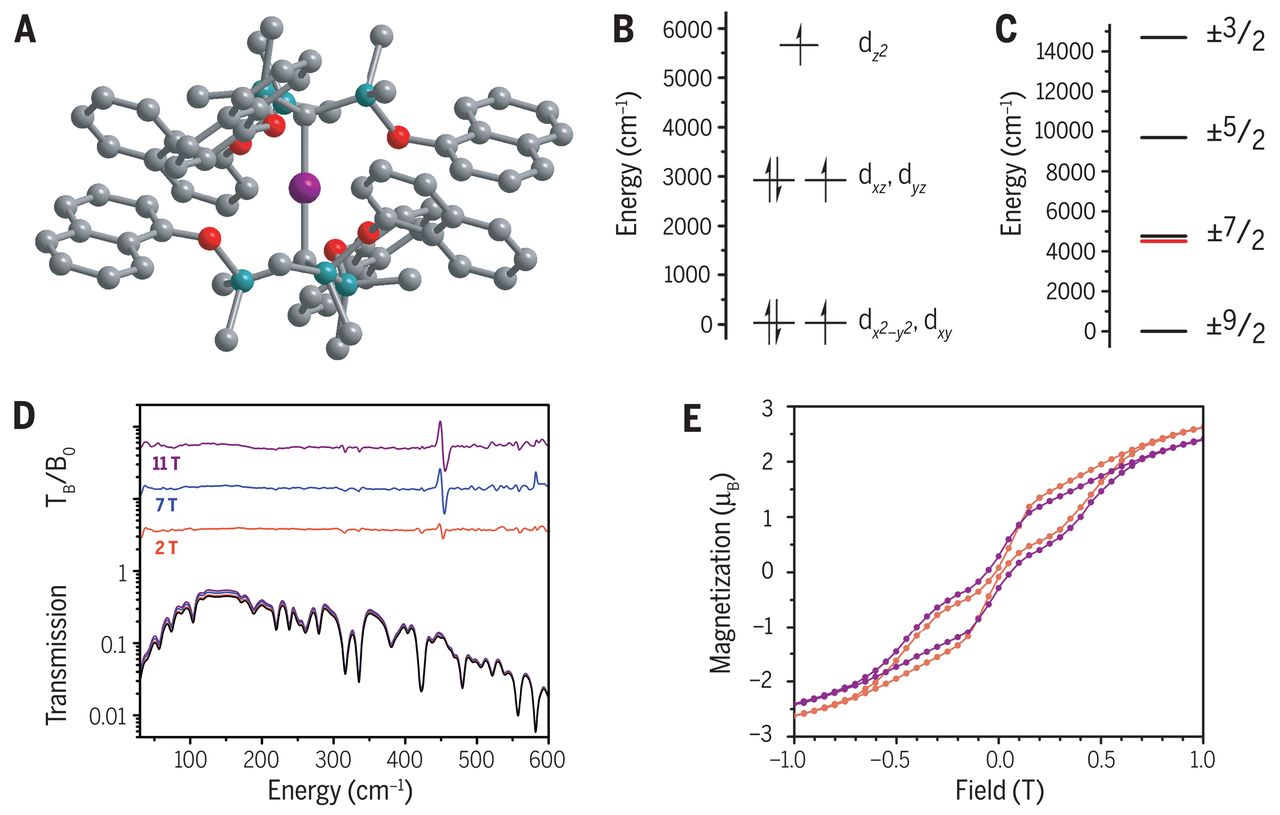
| Orbital angular momentum is a prerequisite for magnetic anisotropy, although in transition metal complexes it is typically quenched by the ligand field. By reducing the basicity of the carbon donor atoms in a pair of alkyl ligands, the authors synthesized a cobalt(II) dialkyl complex, Co(C(SiMe2ONaph)3)2 (where Me is methyl and Naph is a naphthyl group), wherein the ligand field is sufficiently weak that interelectron repulsion and spin-orbit coupling play a dominant role in determining the electronic ground state. Assignment of a non-Aufbau (dx2-y2, dxy)3(dxz, dyz)3(dz2)1 electron configuration is supported by dc magnetic susceptibility data, experimental charge density maps, and ab initio calculations. Variable-field far-infrared spectroscopy and ac magnetic susceptibility measurements further reveal slow magnetic relaxation via a 450-wave number magnetic excited state. |
Philip C. Bunting, Mihail Atanasov, Emil Damgaard-Moller,
Mauro Perfetti, Iris Crassee, Milan Orlita, Jacob
Overgaard, Joris van Slageren, Frank Neese, Jeffrey R. Long,
A linear cobalt(II) complex with maximal orbital angular momentum from a non-Aufbau ground state,
Science 21 Dec 2018, Vol. 362, Issue 6421, eaat7319
First-principles many-body models for electron transport through molecular nanomagnets
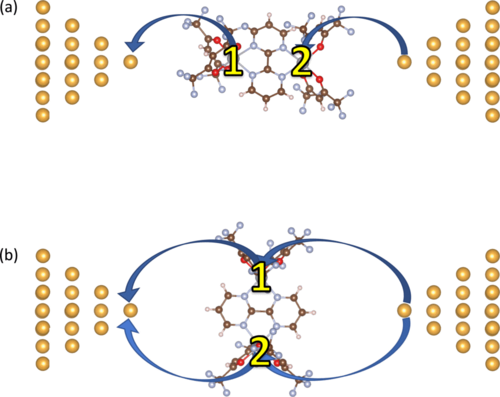
| Impressive advances in the field of molecular spintronics allow one to study electron transport through individual magnetic molecules embedded between metallic leads in the purely quantum regime of single electron tunneling. Besides fundamental interest, this experimental setup, in which a single molecule is manipulated by electronic means, provides the elementary units of possible forthcoming technological applications, ranging from spin valves to transistors and qubits for quantum information processing. Theoretically, while for weakly correlated molecular junctions established first-principles techniques do enable the system-specific description of transport phenomena, methods of similar power and flexibility are still lacking for junctions involving strongly correlated molecular nanomagnets. Here the authors propose an efficient scheme based on the ab initio construction of material-specific Hubbard models and on the master-equation formalism. The authors apply this approach to a representative case, the {Ni2} molecular spin dimer, in the regime of weak molecule-electrode coupling, the one relevant for quantum-information applications. The approach allows to study in a realistic setting many-body effects such as current suppression and negative differential conductance. The authors think that this method has the potential for becoming a very useful tool for describing transport phenomena in strongly correlated molecules. |
A. Chiesa, E. Macaluso, P. Santini, S. Carretta, and
E. Pavarini,
First-principles many-body models for electron transport through molecular nanomagnets,
Phys. Rev. B 99, 235145 (2019)
161Dy Time-Domain Synchrotron Mössbauer Spectroscopy for Investigating Single-Molecule Magnets Incorporating Dy Ions
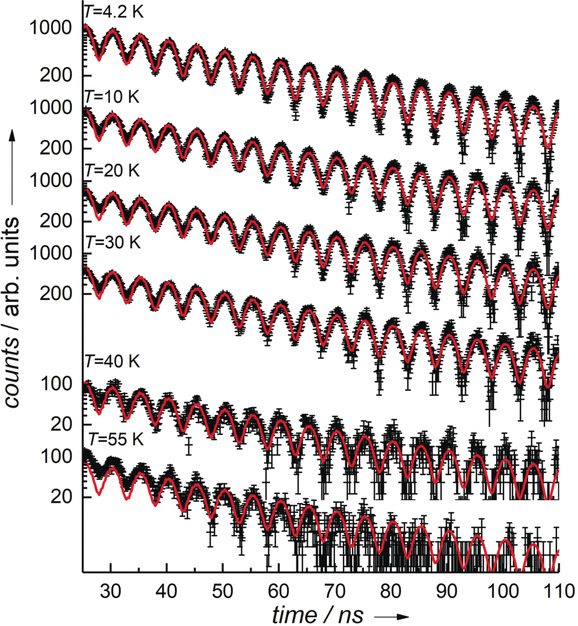
| Time-domain synchrotron Mössbauer spectroscopy (SMS) based on the Mössbauer effect of 161Dy has been used to investigate the magnetic properties of a DyIII-based single-molecule magnet (SMM). The magnetic hyperfine field of [Dy(Cy3PO)2(H2O)5]Br3 2(Cy3PO) 2H2O 2EtOH is with B=582.3T significantly larger than that of the free-ion DyIII with a 6H15/2 ground state. This difference is attributed to the influence of the coordinating ligands on the Fermi contact interaction between the s and 4f electrons of the DyIII ion. This study demonstrates that 161Dy SMS is an effective local probe of the influence of the coordinating ligands on the magnetic structure of Dy-containing compounds. |
Dipl.-Phys. Lena Scherthan, Dr. Sebastian F. M. Schmidt,
Dipl.-Biophys. Hendrik Auerbach, Dipl.-Phys. Tim
Hochdörffer, Dr. Juliusz A. Wolny, Dr. Wenli Bi, Dr. Jiyong
Zhao, Dr. Michael Y. Hu, Dr. Tom Toellner, Dr. E. Ercan Alp,
Dr. Dennis E. Brown, Dr. Christopher E. Anson, Prof. Annie
K. Powell, Prof. Volker Schünemann,
161Dy Time-Domain Synchrotron Mössbauer Spectroscopy for Investigating Single-Molecule Magnets Incorporating Dy Ions,
Angew. Chem. Int. Ed. 58, 2019, 3444-3449
Insight into D6h Symmetry: Targeting Strong Axiality in Stable Dysprosium(III) Hexagonal Bipyramidal SingleâIon Magnets
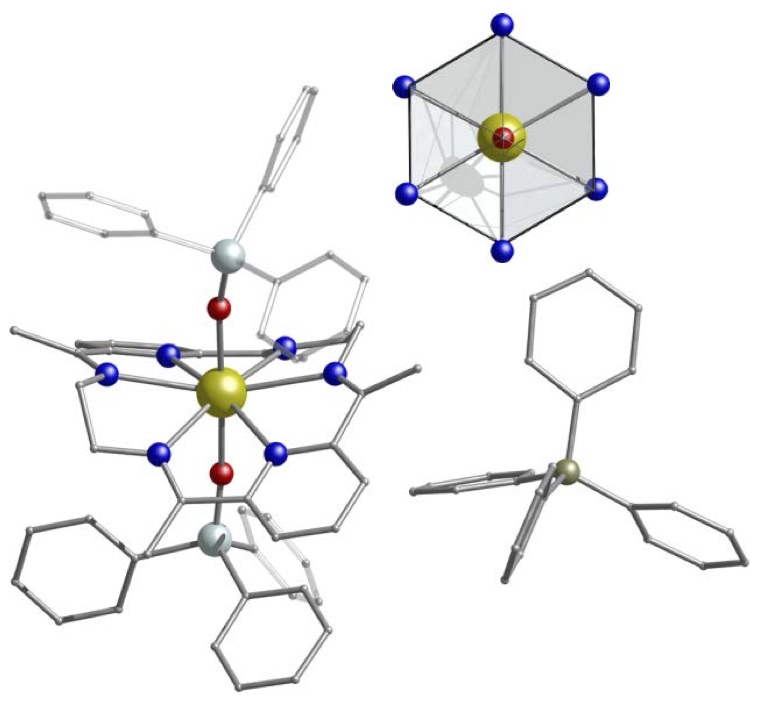
| Following a novel synthetic strategy where the strong uniaxial ligand field generated by the Ph3SiO- (Ph3SiO- = anion of triphenylsilanol) and the 2,4-di-tBu-PhO- (2,4-di-tBu-PhO- = anion of 2,4-di-tert-butylphenol) ligands combined with the weak equatorial field of the ligand LN6, leads to [DyIII(LN6)(2,4-di-tBu-PhO)2](PF6) (1), [DyIII(LN6)(Ph3SiO)2](PF6) (2) and [DyIII(LN6)(Ph3SiO)2](BPh4) (3) hexagonal bipyramidal dysprosium(III) single-molecule magnets (SMMs) with high anisotropy barriers of Ueff = 973 K for 1, Ueff = 1080 K for 2 and Ueff = 1124 K for 3 under zero applied dc field. Ab initio calculations predict that the dominant magnetization reversal barrier of these complexes expands up to the 3rd Kramers doublet, thus revealing for the first time the exceptional uniaxial magnetic anisotropy that even the six equatorial donor atoms fail to negate, opening up the possibility to other higher-order symmetry SMMs. |
Mark Murrie, Angelos Canaj, Sourav Dey, Emma Regincos Marti,
Claire Wilson, Gopalan Rajaraman,
Insight into D6h Symmetry: Targeting Strong Axiality in Stable Dysprosium(III) Hexagonal Bipyramidal Single-Ion Magnets,
Angew. Chem. Int. Ed. (2019) accepted article
Quantum hardware simulating four-dimensional inelastic neutron scattering
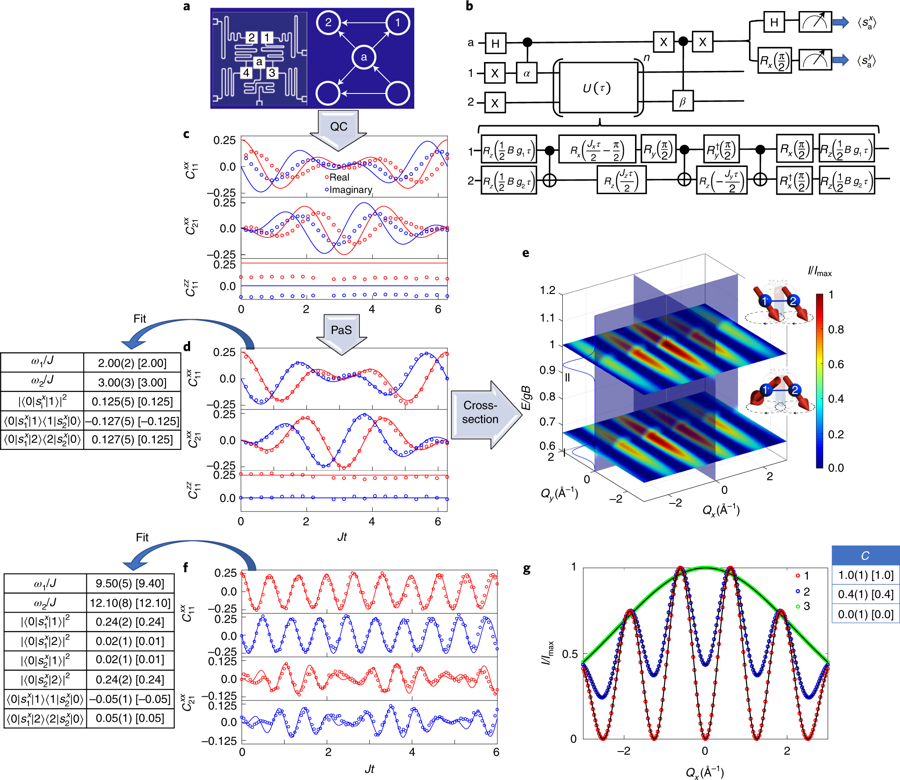
| Magnetic molecules, modelled as finite-size spin systems, are test-beds for quantum phenomena1 and could constitute key elements in future spintronics devices, long-lasting nanoscale memories or noise-resilient quantum computing platforms. Inelastic neutron scattering is the technique of choice to probe them, characterizing molecular eigenstates on atomic scales. However, although large magnetic molecules can be controllably synthesized, simulating their dynamics and interpreting spectroscopic measurements is challenging because of the exponential scaling of the required resources on a classical computer. Here, the authors show that quantum computers have the potential to efficiently extract dynamical correlations and the associated magnetic neutron cross-section by simulating prototypical spin systems on a quantum hardware. |
A. Chiesa, F. Tacchino, M. Grossi, P. Santini, I. Tavernelli,
D. Gerace, S. Carretta,
Quantum hardware simulating four-dimensional inelastic neutron scattering,
Nature Physics 15, 455-459 (2019)
Giant Barocaloric Effect at the Spin Crossover Transition of a Molecular Crystal
|
| The first experimental evidence for a giant, conventional barocaloric effect (BCE) associated with a pressure-driven spin crossover transition near room temperature is provided. Magnetometry, neutron scattering, and calorimetry are used to explore the pressure dependence of the SCO phase transition in polycrystalline samples of protonated and partially deuterated [FeL2][BF4]2 [L=2,6-di(pyrazol-1-yl)pyridine] at applied pressures of up to 120 MPa (1200 bar). The data indicate that, for a pressure change of only 0-300 bar (0-30 MPa), an adiabatic temperature change of 3 K is observed at 262 K or 257 K in the protonated and deuterated materials, respectively. This BCE is equivalent to the magnetocaloric effect (MCE) observed in gadolinium in a magnetic field change of 0-1 Tesla. The work confirms recent predictions that giant, conventional BCEs will be found in a wide range of SCO compounds. |
Steven P. Vallone, Anthony N. Tantillo, Antonio M. dos Santos,
Jamie J. Molaison, Rafal Kulmaczewski, Antonin Chapoy, Pezhman
Ahmadi, Malcolm A. Halcrow, Karl G. Sandeman,
Giant Barocaloric Effect at the Spin Crossover Transition of a Molecular Crystal,
Adv. Mater. 2019, 1807334
After MAGPACK there comes VIBPACK
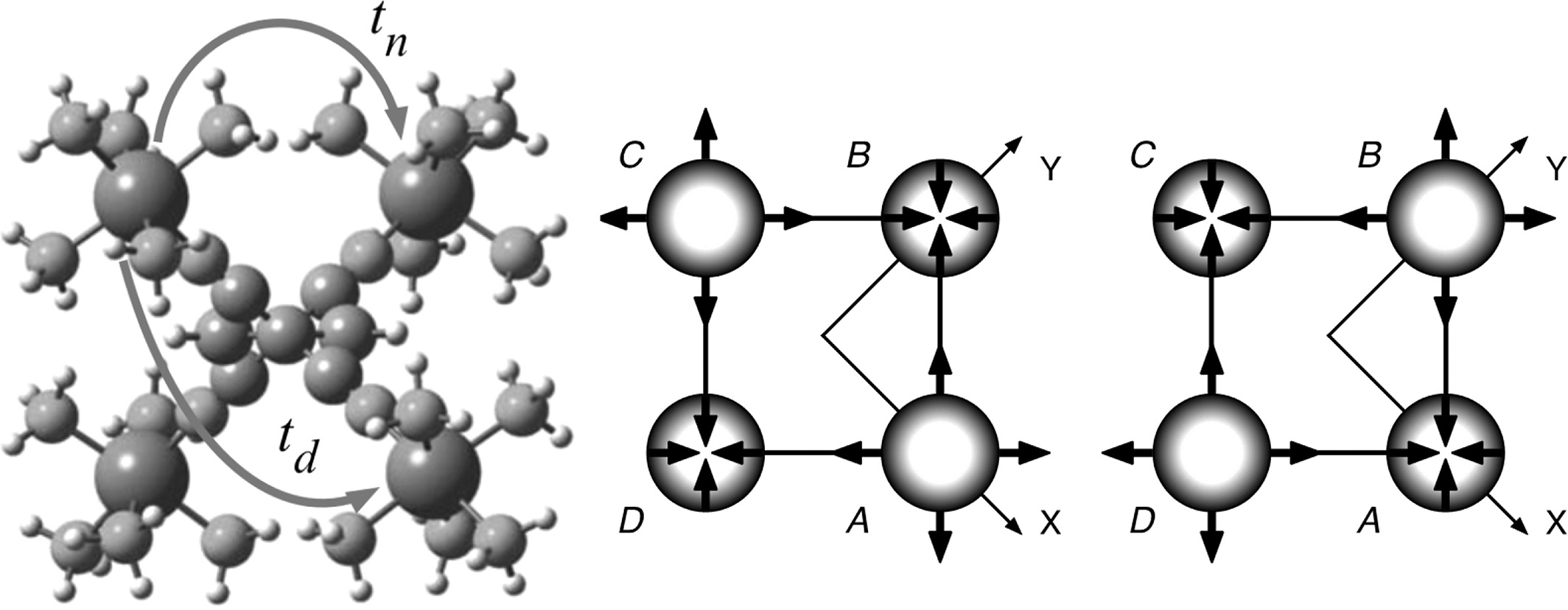
| A FORTRAN code based on a new powerful and efficient computational approach to solve multidimensional dynamic Jahn-Teller and pseudo Jahn-Teller problems is presented. This symmetry-assisted approach constituting a theoretical core of the program is based on the full exploration of the point symmetry of the electronic and vibrational states. The authors also report some selected examples of increasing complexity aimed to display the theoretical background as well as the advantages and capabilities of the program to evaluate of the energy pattern, magnetic and optical properties of large multimode vibronic systems. |
Juan M. Clemente-Juan, Andrew Palii, Boris Tsukerblat, Eugenio
Coronado,
VIBPACK: A package to treat multidimensional electron-vibrational molecular problems with application to magnetic and optical properties,
Journal of Computational Chemistry 2018, 39, 1815-1827
Neutron Scattering in Coordination Chemistry
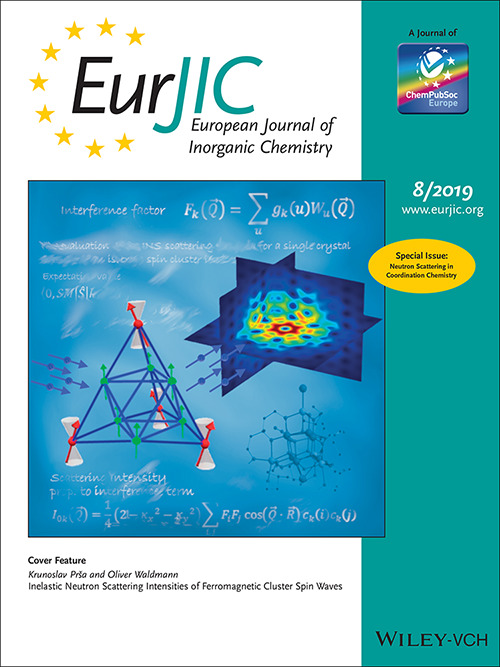
|
The application of four dimensional inelastic neutron scattering
to coordination chemistry is demonstrated in a special issue of
the European Journal of Inorganic Chemistry
by the guest editors John A. Stride, Wendy L. Queen, and
Antonio Romerosa.
See e.g. the following articles.
Elena Garlatti, Alessandro Chiesa, Tatiana Guidi, Giuseppe
Amoretti, Paolo Santini, Stefano Carretta,
Unravelling the Spin Dynamics of Molecular Nanomagnets with Four-Dimensional Inelastic Neutron Scattering,
Eur. J. Inorg. Chem. 2019 (2019) 1106-1118
Krunoslav Prša, Oliver Waldmann, Inelastic Neutron Scattering Intensities of Ferromagnetic Cluster Spin Waves, Eur. J. Inorg. Chem. 2019 (2019) 1128-1141 |
Electric field modulation of magnetic exchange in molecular helices
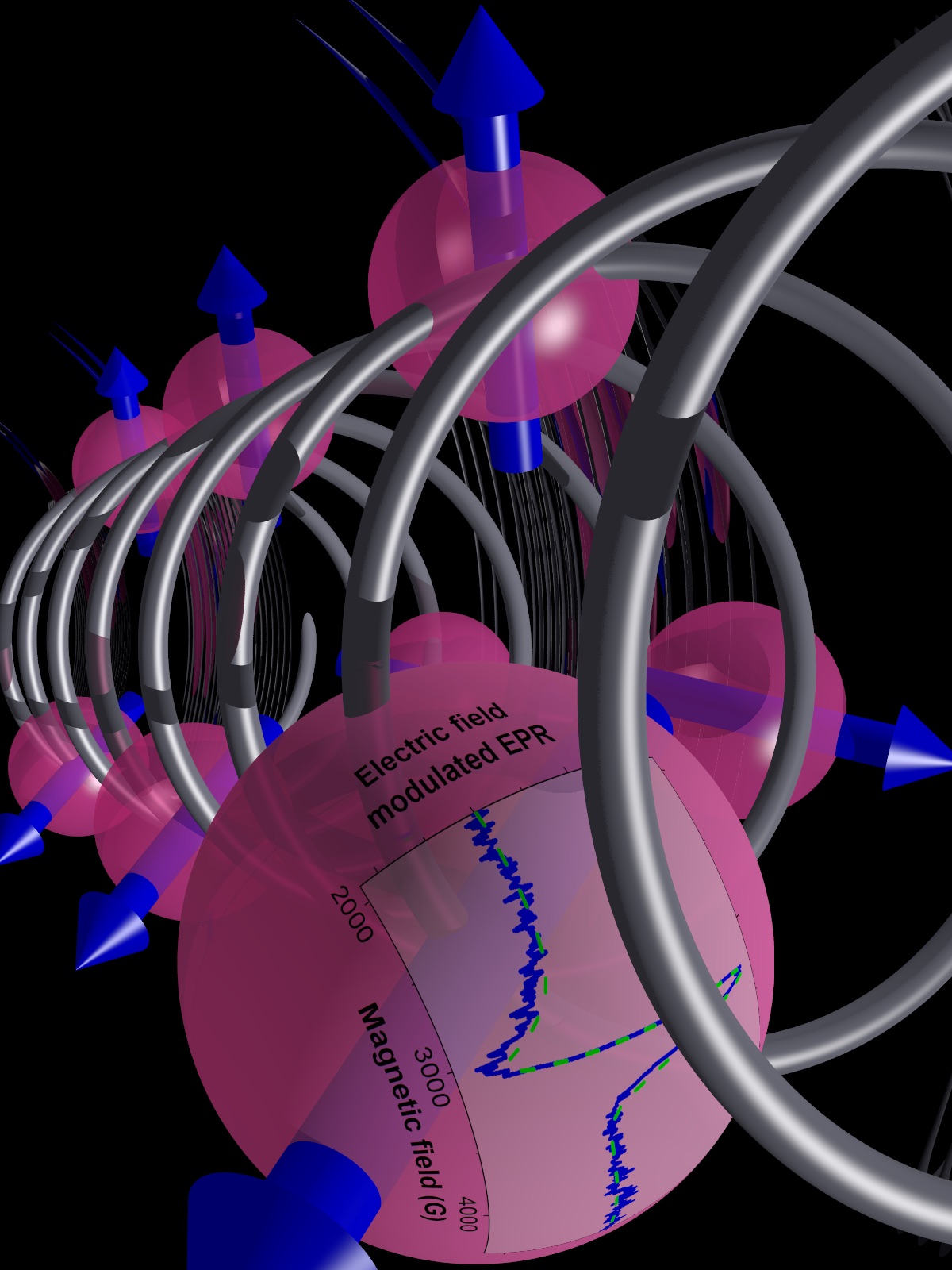
| The possibility to operate on magnetic materials through the application of electric rather than magnetic fields - promising faster, more compact and energy efficient circuits - continues to spur the investigation of magnetoelectric effects. Symmetry considerations, in particular the lack of an inversion centre, characterize the magnetoelectric effect. In addition, spin-orbit coupling is generally considered necessary to make a spin system sensitive to a charge distribution. However, a magnetoelectric effect not relying on spin-orbit coupling is appealing for spin-based quantum technologies. Here, we report the detection of a magnetoelectric effect that we attribute to an electric field modulation of the magnetic exchange interaction without atomic displacement. The effect is visible in electron paramagnetic resonance absorption of molecular helices under electric field modulation and confirmed by specific symmetry properties and spectral simulation. |
Maria Fittipaldi, Alberto Cini, Giuseppe Annino, Alessandro
Vindigni, Andrea Caneschi, Roberta Sessoli,
Electric field modulation of magnetic exchange in molecular helices,
Nature Materials, volume 18, pages329-334 (2019)
Cages on a plane: a structural matrix for molecular 'sheets'
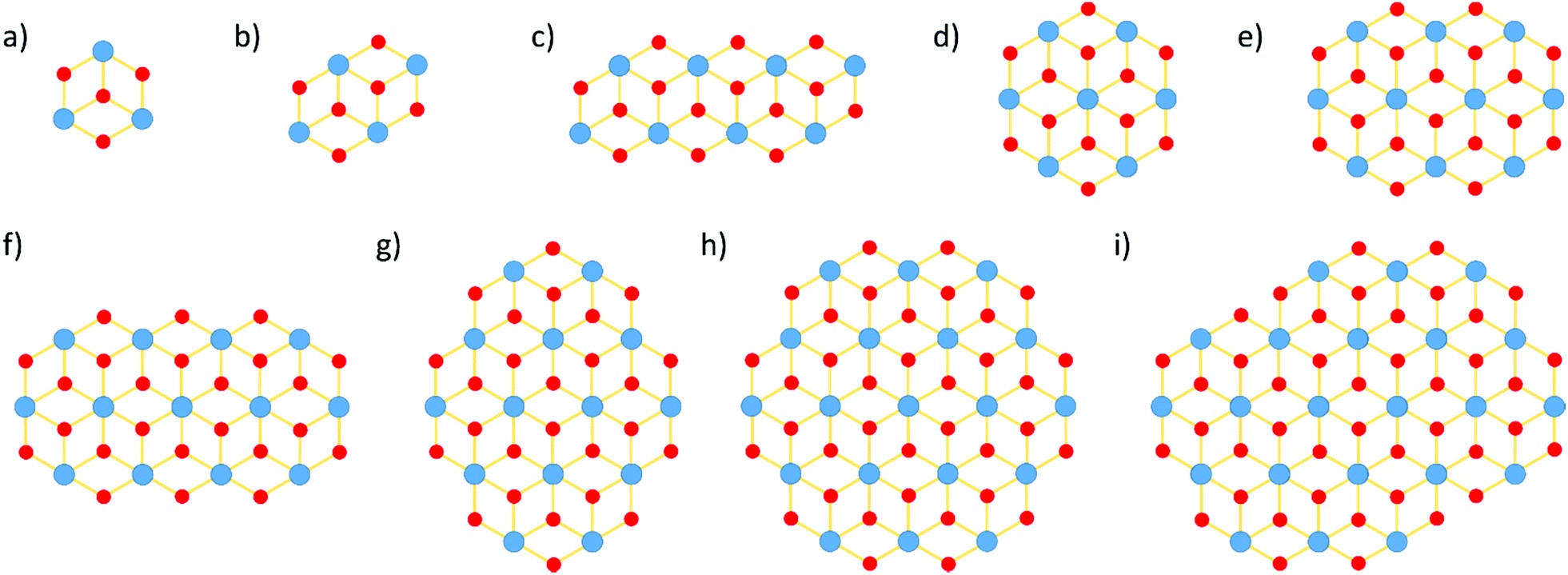
| A family of heterometallic Anderson-type 'wheels' of general formula [MIII2MII5(hmp)12]4+ (MIII = Cr or Al and MII = Ni or Zn, Hhmp = 2-pyridinemethanol) has been extended by the authors to include MIII = Cr or Al and MII = Co, Fe, Mn or Cu, affording five new species of formulae [Cr2Co5(hmp)12](ClO4)4 (1), [Cr2Fe5(hmp)12](ClO4)4 (2), [Cr2Mn5(hmp)12](ClO4)4 (3), [Cr2Cu5(hmp)12](ClO4)2(NO3)2 (4) and [Al2Co5(hmp)12](ClO4)4 (5). As per previous family members, the metallic skeleton common to the cations of 1-5 describes a centred hexagon with the two MIII sites disordered around the outer wheel, with the exception of compound 4 where the CuII sites are localised. A structurally related, but enlarged planar disc possessing a [MIII6MII] hexagon capped on each edge by a CuII ion can be formed, but only when MIII = Al and MII = Cu. In [AlIII6CuII7(OH)12(hmp)12](ClO4)6(NO3)2 (6) the Anderson moiety contains a central, symmetry-imposed octahedral CuII ion surrounded by a wheel of AlIII ions. Solid-state dc susceptibility and magnetisation measurements reveal the presence of competing exchange interactions in 1-5, and very weak antiferromagnetic exchange between the CuII ions in 6 which may be intra- and/or intermolecular in nature. |
Hector W. L. Fraser, Gary S. Nichol, Amgalanbaatar
Baldansuren, Eric J. L. McInnes, Euan K. Brechin,
Cages on a plane: a structural matrix for molecular 'sheets',
Dalton Trans., 2018, 47, 15530-15537
Switchable cobalt coordination polymers: Spin crossover and valence tautomerism
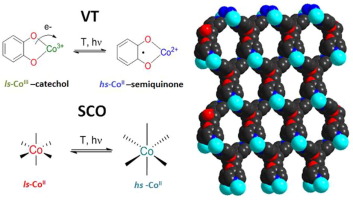
| Electronically labile, or switchable, cobalt coordination polymers exhibit reversible spin crossover (SCO) or valence tautomeric (VT) transitions upon the application of an external stimulus, such as temperature variation. Spin crossover transitions at pseudo-octahedral cobalt(II) centers with an appropriate ligand field involve a heating-induced transition from the low-spin to high-spin electronic configurations. Valence tautomeric transitions are most commonly observed for cobalt-dioxolene systems, which undergo an intramolecular electron transfer and concomitant spin transition at the cobalt center, from low-spin-cobalt(III)-catecholate at low temperature to high-spin-cobalt(II)-semiquinonate upon heating. The VT transition can also be induced by light, while the cobalt(II) SCO transition cannot. Incorporation of these switchable moieties into coordination polymers (CPs) is generally achieved using polytopic nitrogen-donor linking ligands. All but one of the switchable cobalt CPs that have been structurally characterized are 1D chains, most of which exhibit VT transitions rather than SCO. There is a single example of a switchable 2D cobalt CP where VT cobalt-dioxolene moieties are linked by a tetratopic nitrogen-donor bridging ligand. Efforts to confer the VT properties to compounds suitable for applications as materials or in devices have mainly focused on the incorporation of the 1D chain VT CPs into nano- and microparticles, in which the VT transition is generally maintained. Valence tautomeric nanoparticles synthesized from 1D chain CPs have been grafted on to gold surfaces as self-assembled monolayers. |
Olga Drath, Colette Boskovic,
Switchable cobalt coordination polymers: Spin crossover and valence tautomerism,
Coordination Chemistry Reviews, Volume 375, 2018, Pages 256-266
Electric Field Control of Spins in Molecular Magnets
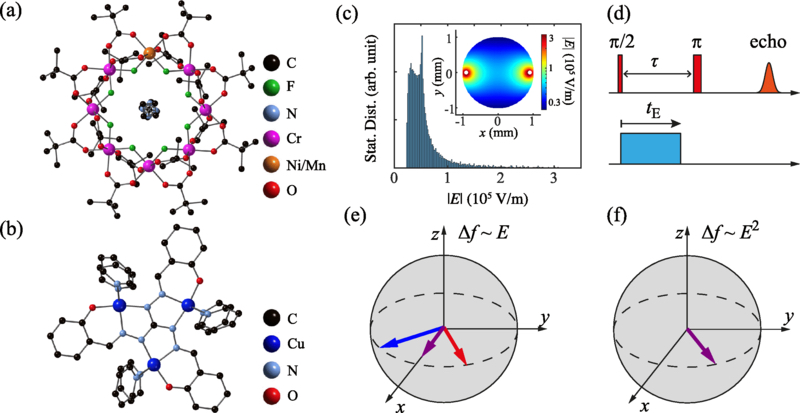
| Coherent control of individual molecular spins in nanodevices is a pivotal prerequisite for fulfilling the potential promised by molecular spintronics. By applying electric field pulses during time-resolved electron spin resonance measurements, the authors measure the sensitivity of the spin in several antiferromagnetic molecular nanomagnets to external electric fields. They find a linear electric field dependence of the spin states in {Cr7Mn}, an antiferromagnetic ring with a ground-state spin of S=1, and in a frustrated {Cu3} triangle.Conversely, the antiferromagnetic ring {Cr7Ni}, isomorphic with {Cr7Mn} but with S=1/2, does not exhibit a detectable effect. The authors propose that the spin-electric field coupling may be used for selectively controlling individual molecules embedded in nanodevices. |
Junjie Liu, Jakub Mrozek, William K. Myers, Grigore A. Timco,
Richard E.P. Winpenny, Benjamin Kintzel, Winfried Plass, and
Arzhang Ardavan,
Electric Field Control of Spins in Molecular Magnets,
Phys. Ref. Lett. 122, 037202 (2019)
Insights into Magnetic Interactions in a Monodisperse Gd12Fe14 Metal Cluster
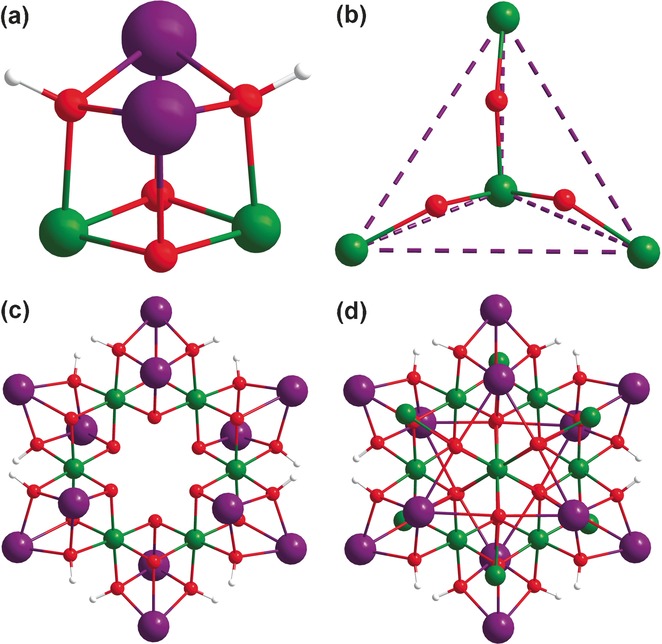
| The largest Ln-Fe metal cluster {Gd12Fe14} and the core-shell monodisperse metal cluster of {Gd12Fe14}@SiO2 were prepared. Experimental and theoretical studies on the magnetic properties reveal that encapsulation of one cluster into one silica nanosphere not only effectively decreases intermolecular magnetic interactions but also significantly increases the zero-field splitting effect of the outer layer Fe3+ ions. |
Xiu-Ying Zheng, Hui Zhang, Zhenxing Wang, Pengxin Liu,
Ming-Hao Du, Ying-Zi Han, Rong-Jia Wei, Zhong-Wen Ouyang,
Xiang-Jian Kong, Gui-Lin Zhuang,
La-Sheng Long, Lan-Sun Zheng,
Insights into Magnetic Interactions in a Monodisperse Gd12Fe14 Metal Cluster,
Angew. Chem. Int. Ed. 56, 11475-11479 (2017)
Molecular electronic spin qubits from a spin-frustrated trinuclear copper complex
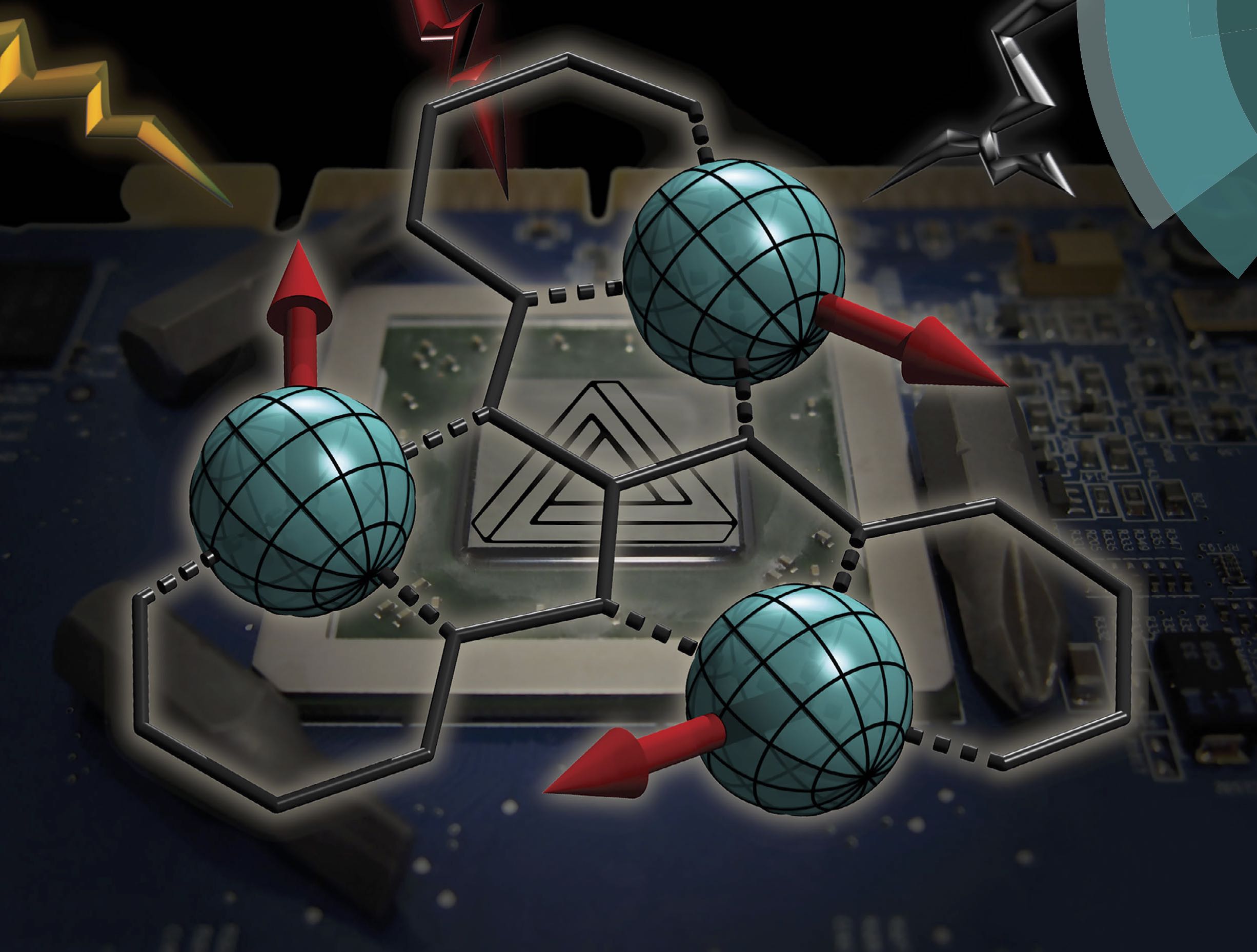
| A new trinuclear copper(II) complex was synthesized and characterized by experimental as well as theoretical methods. This complex exhibits a strong antiferromagnetic coupling (J = -298 cm-1) between the copper(II) ions, mediated by the N-N diazine bridges of the tritopic ligand, leading to a spin-frustrated system. This compound shows a T2 coherence time of 340 ns in frozen pyridine solution, which extends to 591 ns by changing the solvent to pyridine-d5. Hence, the presented compound is a promising candidate as a building block for molecular spintronics. |
Benjamin Kintzel, Michael Böhme, Junjie Liu, Anja
Burkhardt, Jakub Mrozek, Axel Buchholz, Arzhang Ardavan, Winfried Plass,
Molecular electronic spin qubits from a spin-frustrated trinuclear copper complex,
Chem. Commun., 2018,54, 12934-12937
Element specific determination of the magnetic properties of two macrocyclic tetranuclear 3d-4f complexes with a Cu3Tb core by means of X-ray magnetic circular dichroism (XMCD)
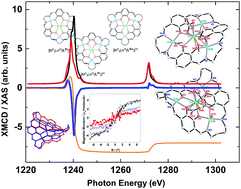
| We apply X-ray magnetic circular dichroism to study the internal magnetic structure of two very promising star shaped macrocyclic complexes with a CuII3TbIII core. These complexes are rare examples prepared with a macrocyclic ligand that show indications of SMM (Single Molecule Magnet) behavior, and they differ only in ring size: one has a propylene linked macrocycle, [CuII3TbIII(LPr)(NO3)2(MeOH)(H2O)2](NO3) 3H2O (nickname: Cu3Tb(LPr)), and the other has the butylene linked analogue, [CuII3TbIII(LBu)(NO3)2(MeOH)(H2O)](NO3) 3H2O (nickname: Cu3Tb(LBu)). We analyze the orbital and spin contributions to the Cu and Tb ions quantitatively by applying the spin and orbital sum rules concerning the L2 (M4)/L3 (M5) edges. In combination with appropriate ligand field simulations, we demonstrate that the Tb(III) ions contribute with high orbital magnetic moments to the magnetic anisotropy, whereas the ligand field determines the easy axis of magnetization. Furthermore, we confirm that the Cu(II) ions in both molecules are in a divalent valence state, the magnetic moments of the three Cu ions appear to be canted due to 3d-3d intramolecular magnetic interactions. For Cu3Tb(LPr), the corresponding element specific magnetization loops reflect that the Cu(II) contribution to the overall magnetic picture becomes more important as the temperature is lowered. This implies a low value for the 3d-4f coupling. |
K. Balinski, L. Schneider, J. Wöllermann, A. Buling,
L. Joly, C. Piamonteze, H. L. C. Feltham, S. Brooker,
A. K. Powell, B. Delley and K. Kuepper,
Element specific determination of the magnetic properties of two macrocyclic tetranuclear 3d-4f complexes with a Cu3Tb core by means of X-ray magnetic circular dichroism (XMCD),
Phys. Chem. Chem. Phys., 2018, g20, 21286-21293
Along similar lines compare
A. Alhassanat, C. Gamer, A. Rauguth, A. A. Athanasopoulou,
J. Sutter, C. Luo, H. Ryll, F. Radu, A. A. Sapozhnik,
T. Mashoff, E. Rentschler, and H. J. Elmers,
Element-specific magnetic properties of mixed 3d-4f metallacrowns,
Phys. Rev. B 98, 064428 (2018)
Novel Magnetic Nanostructures
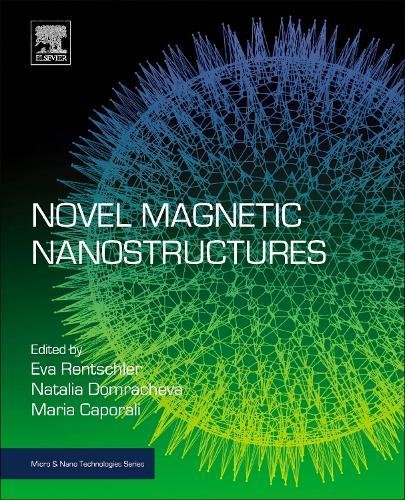
| A sharp increase in research activity in the field of magnetic nanostructures prompted us to present new scientific results obtained in the last decade. Magnetic nanoscale materials are the key to the future of the storage industry. The demand for higher density of information storage and the emergence of completely new technologies call for entirely new types of magnetic nanostructures. This book provides the latest research on novel magnetic nanostructures, including molecular nanomagnets, magnetic dendrimers, self-assembling magnetic nanoparticles, nanoparticles with spin-crossover properties, multifunctional nanostructures, and much more. Nanomagnets based on d- and f-block coordination compounds as single-molecule magnets demonstrate properties that are suitable for quantum information processing. The book reviews the synthesis, design, characterization, and detection of unusual properties in new magnetic nanostructures. It discusses the physical properties and potential industry-oriented applications such as magnetic data storage, magnetic sensors, magnetic tunnel junctions, spintronics, and biomedical applications. This book is primarily intended for graduate students, but will be of great interest also to all scientists and engineers working in field of magnetic nanoscale materials. |
Editor(s): Natalia Domracheva, Maria Caporali, Eva Rentschler,
Novel Magnetic Nanostructures,
Elsevier, 2018, ISBN 9780128135945,
The race goes on: record for ground state spin now at S=91
|
| After the successful synthesis and characterization of a toric cluster with S=60 (see npj Quantum Materials 3 (2018) 10 and below on this page) a new cluster was produced featuring an S=91 ground state. The detailed analysis of magnetic interactions in such giant molecules is difficult both because the synthesis of such compounds is challenging and the number of energy levels increases exponentially with the magnitude and number of spins. The authors isolated a {Ni21Gd20} nanocage with a large number of energy levels (approx 5 x 1030) and used quantum Monte Carlo (QMC) simulations to perform a detailed analysis of magnetic interactions. Based on magnetization measurements above 2 K, the QMC simulations predicted very weak ferromagnetic interactions that would give a record S=91 spin ground state. Low-temperature measurements confirm the spin ground state but suggest a more complex picture due to the single ion anisotropy; this has also been modeled using the QMC approach. The high spin and large number of low-lying states lead to a large low-field magnetic entropy for this material. |
Wei-Peng Chen, Jared Singleton, Lei Qin, Agustin Camon, Larry
Engelhardt, Fernando Luis, Richard E. P. Winpenny & Yan-Zhen
Zheng,
Quantum Monte Carlo simulations of a giant {Ni21Gd20} cage with a S=91 spin ground state,
Nature Communications 9, Article number: 2107 (2018)
Hyperfine-Interaction-Driven Suppression of Quantum Tunneling at Zero Field in a Holmium(III) Single-Ion Magnet
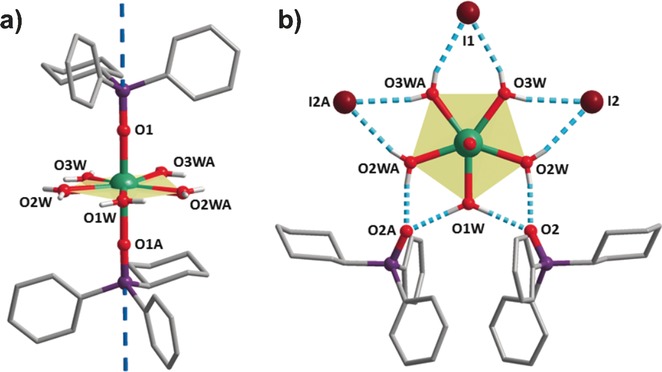
| An extremely rare non-Kramers holmium(III) single-ion magnet (SIM) is reported to be stabilized in the pentagonal-bipyramidal geometry by a phosphine oxide with a high energy barrier of 237(4)/cm. The suppression of the quantum tunneling of magnetization (QTM) at zero field and the hyperfine structures originating from field-induced QTMs can be observed even from the field-dependent alternating-current magnetic susceptibility in addition to single-crystal hysteresis loops. These dramatic dynamics were attributed to the combination of the favorable crystal-field environment and the hyperfine interactions arising from 165Ho (I=7/2) with a natural abundance of 100 %. |
Yan-Cong Chen, Jun-Liang Liu, Wolfgang Wernsdorfer, Dan Liu, Liviu F. Chibotaru, Xiao-Ming Chen, Ming-Liang Tong,
Hyperfine-Interaction-Driven Suppression of Quantum Tunneling at Zero Field in a Holmium(III) Single-Ion Magnet,
Angew. Chem. Int. Ed. 56, 2017, 4996-5000
See also:
Jun-Liang Liu, Yan-Cong Chen, Ming-Liang Tong,
Symmetry strategies for high performance lanthanide-based single-molecule magnets,
Chem. Soc. Rev., 2018, 47, 2431-2453
Modeling Spin Interactions in a Triangular Cobalt(II) Complex with Triaminoguanidine Ligand Framework: Synthesis, Structure, and Magnetic Properties
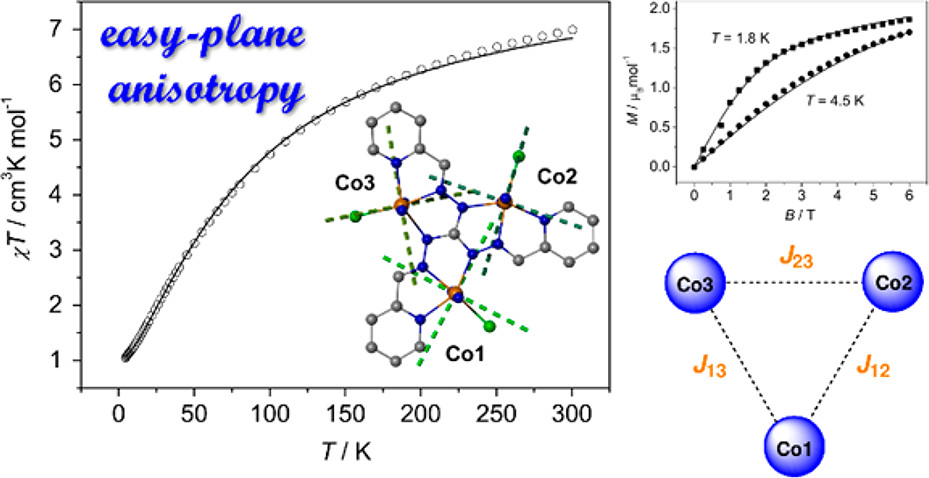
| The new tritopic triaminoguanidine-based ligand 1,2,3-tris[(pyridine-2-ylmethylidene)amino]guanidine (H2pytag) was synthesized. The reaction of a mixture of cobalt(II) chloride and cobalt(II) perchlorate with the ligand H2pytag in pyridine solution leads to the formation of the trinuclear cobalt(II) complex [Co3(pytag)(py)6Cl3]ClO4. Three octahedrally coordinated high-spin cobalt(II) ions are linked through the bridging triaminoguanidine backbone of the ligand leading to an almost equilateral triangular arrangement. The magnetic properties of the complex were investigated by magnetic measurements, variable-temperature, variable-field magnetic circular dichroism (MCD) spectroscopy, and density functional theory as well as ab initio calculations. A rather strong antiferromagnetic exchange interaction between the cobalt(II) centers of ca. -12/cm is determined together with a strong local anisotropy. The single-ion anisotropy of all three cobalt(II) centers is found to be easy-plane, which coincides with the tritopic ligand plane. MCD measurements and theoretical investigations demonstrate the presence of rhombic distortion of the local Co surrounding. |
Daniel Plaul, Michael Böhme, Serghei Ostrovsky, Zbigniew
Tomkowicz, Helmar Görls, Wolfgang Haase, Winfried Plass,
Modeling Spin Interactions in a Triangular Cobalt(II) Complex with Triaminoguanidine Ligand Framework: Synthesis, Structure, and Magnetic Properties,
Inorg. Chem., 2018, 57 (1), pp 106-119
See also:
Eike T. Spielberg, Aksana Gilb, Daniel Plaul, Daniel Geibig,
David Hornig, Dirk Schuch, Axel Buchholz, Arzhang Ardavan,
Winfried Plass,
A Spin-Frustrated Trinuclear Copper Complex Based on Triaminoguanidine with an Energetically Well-Separated Degenerate Ground State,
Inorg. Chem., 2015, 54 (7), pp 3432-3438
Robust and Selective Switching of an FeIII Spin-Crossover Compound on Cu2N/Cu(100) with Memristance Behavior
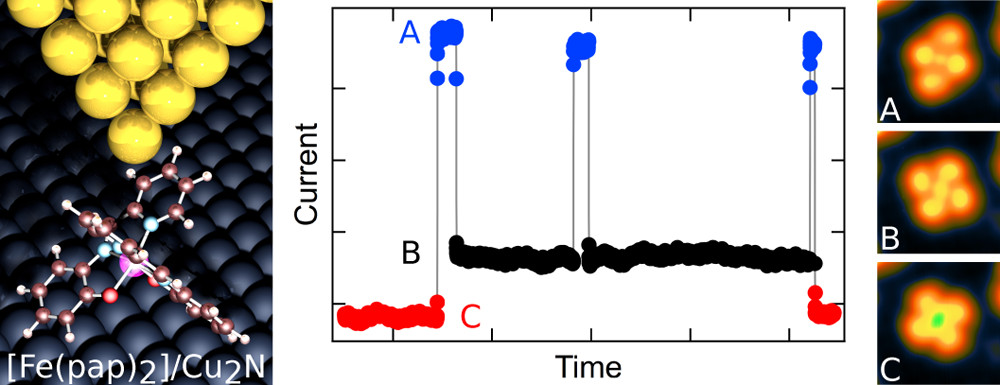
| The switching between two spin states makes spin-crossover molecules on surfaces very attractive for potential applications in molecular spintronics. Using scanning tunneling microscopy, the successful deposition of [Fe(pap)2]+ (pap = N-2-pyridylmethylidene-2-hydroxyphenylaminato) molecules on Cu2N/Cu(100) surface is evidenced. The deposited FeIII spin-crossover compound is controllably switched between three different states, each of them exhibiting a characteristic tunneling conductance. The conductance is therefore employed to readily read the state of the molecules. A comparison of the experimental data with the results of density functional theory calculations reveals that all Fe(pap)2 molecules are initially in their high-spin state. The two other states are compatible with the low-spin state of the molecule but differ with respect to their coupling to the substrate. As a proof of concept, the reversible and selective nature of the switching is used to build a two-molecule memory. |
Torben Jasper-Toennies, Manuel Gruber, Sujoy Karan, Hanne
Jacob, Felix Tuczek , Richard Berndt,
Robust and Selective Switching of an FeIII Spin-Crossover Compound on Cu2N/Cu(100) with Memristance Behavior,
Nano Lett. 2017, 11, 6613-6619
Highly Ordered Surface Self-Assembly of Fe4 Single Molecule Magnets
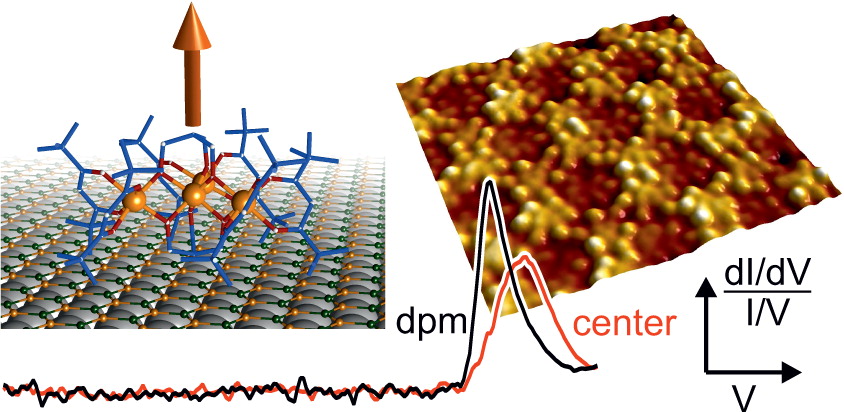
| Single molecule magnets (SMMs) have attracted considerable attention due to low-temperature magnetic hysteresis and fascinating quantum effects. The investigation of these properties requires the possibility to deposit well-defined monolayers or spatially isolated molecules within a well-controlled adsorption geometry. Here the authors present a successful fabrication of self-organized arrays of Fe4 SMMs on hexagonal boron nitride (h-BN) on Rh(111) as template. Using a rational design of the ligand shell optimized for surface assembly and electrospray as a gentle deposition method, we demonstrate how to obtain ordered arrays of molecules forming perfect hexagonal superlattices of tunable size, from small islands to an almost perfect monolayer. High-resolution low temperature scanning tunneling microscopy (STM) reveals that the Fe4 molecule adsorbs on the substrate in a flat geometry, meaning that its magnetic easy axis is perpendicular to the surface. By scanning tunneling spectroscopy (STS) and density functional theory (DFT) calculations, we infer that the majority- and minority-spin components of the spin-split lowest unoccupied molecular orbital (LUMO) can be addressed separately on a submolecular level. |
Philipp Erler, Peter Schmitt, Nicole Barth, Andreas Irmler,
Samuel Bouvron, Thomas Huhn, Ulrich Groth, Fabian Pauly,
Luca Gragnaniello, Mikhail Fonin,
Highly Ordered Surface Self-Assembly of Fe4 Single Molecule Magnets,
Nano Lett., 2015, 15, 4546-4552
Mössbauer spectroscopy of a monolayer of single molecule magnets
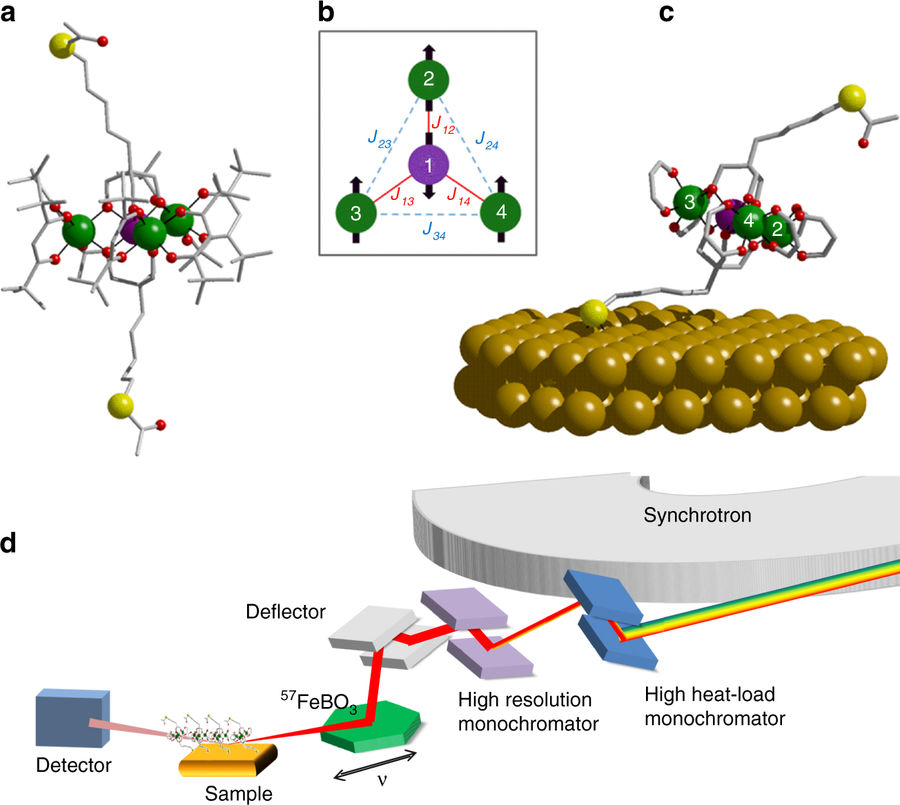
| The use of single molecule magnets (SMMs) as cornerstone elements in spintronics and quantum computing applications demands that magnetic bistability is retained when molecules are interfaced with solid conducting surfaces. Here, the authors employ synchrotron Mössbauer spectroscopy to investigate a monolayer of a tetrairon(III) (Fe4) SMM chemically grafted on a gold substrate. At low temperature and zero magnetic field, the authors observe the magnetic pattern of the Fe4 molecule, indicating slow spin fluctuations compared to the Mössbauer timescale. Significant structural deformations of the magnetic core, induced by the interaction with the substrate, as predicted by ab initio molecular dynamics, are also observed. However, the effects of the modifications occurring at the individual iron sites partially compensate each other, so that slow magnetic relaxation is retained on the surface. Interestingly, these deformations escaped detection by conventional synchrotron-based techniques, like X-ray magnetic circular dichroism, thus highlighting the power of synchrotron Mössbauer spectroscopy for the investigation of hybrid interfaces. |
Alberto Cini, Matteo Mannini, Federico Totti, Maria Fittipaldi,
Gabriele Spina, Aleksandr Chumakov, Rudolf Rüffer, Andrea
Cornia, Roberta Sessoli,
Mössbauer spectroscopy of a monolayer of single molecule magnets,
Nature Communications 9, 480 (2018)
Myriam Sarachik looks back in Annual Review of Condensed Matter Physics

| This autobiographical narrative offers a brief account of Prof. Sarachik's journey and adventures in condensed matter physics (a.k.a. solid state physics) and some of the personal events that shaped her life and career: early years in Europe, family's escape from the Nazis, growing up in Cuba, the difficult road into a field that was essentially closed to women, a personal disaster that knocked the wind out of her sails for more than a decade, and her return to a successful career in physics. In closing, she argues that, although we have made remarkable progress, we know but a thimble-full in our inexhaustible search for an understanding of the laws of nature. |
Myriam P. Sarachik,
Pushing Boundaries: My Personal and Scientific Journey,
Annual Review of Condensed Matter Physics 9, 1-15 (2018)
Effects of uniaxial pressure on the quantum tunneling of magnetization in a high-symmetry Mn12 single-molecule magnet
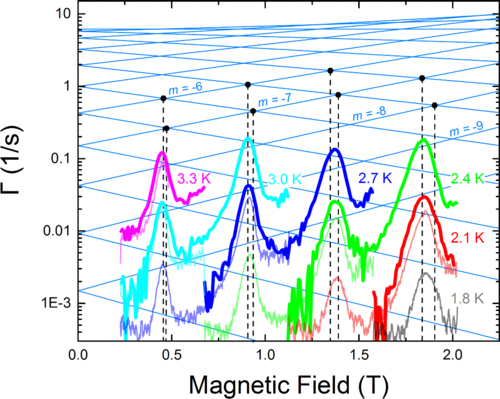
| The symmetry of single-molecule magnets dictates their spin quantum dynamics, influencing how such systems relax via quantum tunneling of magnetization (QTM). By reducing a system's symmetry, through the application of a magnetic field or uniaxial pressure, these dynamics can be modified. The authors report measurements of the magnetization dynamics of a crystalline sample of a high-symmetry Mn12 single-molecule magnet as a function of uniaxial pressure applied either parallel or perpendicular to the sample's "easy" magnetization axis. At temperatures between 1.8 and 3.3 K, magnetic hysteresis loops exhibit the characteristic steplike features that signal the occurrence of QTM. After applying uniaxial pressure to the sample in situ, both the magnitude and field position of the QTM steps changed. The step magnitudes were observed to grow as a function of pressure in both arrangements of pressure, while pressure applied along (perpendicular to) the sample's easy axis caused the resonant-tunneling fields to increase (decrease). These observations were compared with simulations in which the system's Hamiltonian parameters were changed. From these comparisons, we determined that parallel pressure induces changes to the second-order axial anisotropy parameter as well as either the fourth-order axial or fourth-order transverse parameter, or to both. In addition, we find that pressure applied perpendicular to the easy axis induces a rhombic anisotropy that can be understood as deriving from a symmetry-breaking distortion of the molecule. |
James H. Atkinson, Adeline D. Fournet, Lakshmi Bhaskaran, Yuri
Myasoedov, Eli Zeldov, Enrique del Barco, Stephen Hill, George
Christou, and Jonathan R. Friedman,
Effects of uniaxial pressure on the quantum tunneling of magnetization in a high-symmetry
Mn12 single-molecule magnet,
Phys. Rev. B 95, 184403 (2017)
High spin cycles: topping the spin record for a single molecule verging on quantum criticality
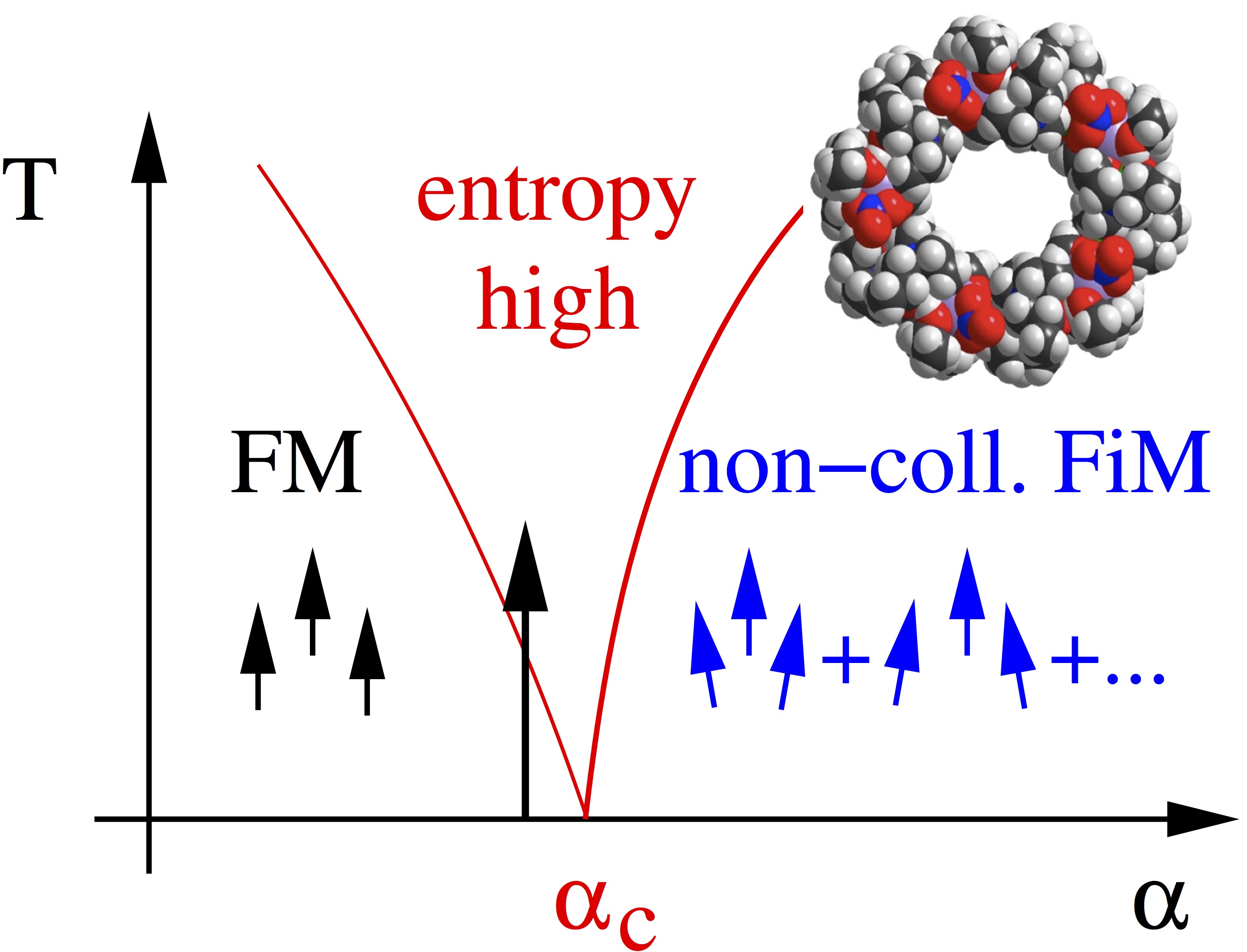
| The cyclisation of a short chain into a ring provides fascinating scenarios in terms of transforming a finite array of spins into a quasi-infinite structure. If frustration is present, theory predicts interesting quantum critical points, where the ground state and thus low-temperature properties of a material change drastically upon even a small variation of appropriate external parameters. This can be visualised as achieving a very high and pointed summit where the way down has an infinity of possibilities, which by any parameter change will be rapidly chosen, in order to reach the final ground state. The authors of the article in the new Nature journal npj Quantum Materials report a mixed 3d/4f cyclic coordination cluster that turns out to be very near or even at such a quantum critical point. It has a ground state spin of S=60, the largest ever observed for a molecule (120 times that of a single electron). The molecule forms a nano-torus with alternating gadolinium and iron ions with a nearest neighbour Fe-Gd coupling and a frustrating next-nearest neighbour Fe-Fe coupling. Such a spin arrangement corresponds to a cyclic delta or saw-tooth chain, which can exhibit unusual frustration effects. In the present case, the quantum critical point bears a 'flatland' of tens of thousands of energetically degenerate states between which transitions are possible at no energy costs with profound caloric consequences. Entropy-wise the energy flatland translates into the pointed summit overlooking the entropy landscape. Going downhill several target states can be reached depending on the applied physical procedure which offers new prospects for addressability. |
Amer Baniodeh, Nicola Magnani, Yanhua Lan, Gernot Buth,
Christopher E. Anson, Johannes Richter, Marco Affronte, Jürgen
Schnack, Annie K. Powell,
High spin cycles: topping the spin record for a single molecule verging on quantum criticality,
npj Quantum Materials 3 (2018) 10
For a structurally related compound see also:
Lei Qin, Jared Singleton, Wei-Peng Chen, Hiroyuki Nojiri, Larry
Engelhardt, Richard E. P. Winpenny, Yan-Zhen Zheng,
Quantum Monte Carlo Simulations and High-Field Magnetization Studies of Antiferromagnetic Interactions in a Giant Hetero-Spin Ring,
Angew. Chem. Int. Ed. 56, 2017, 16571-16574
Dynamical spin accumulation in large-spin magnetic molecules
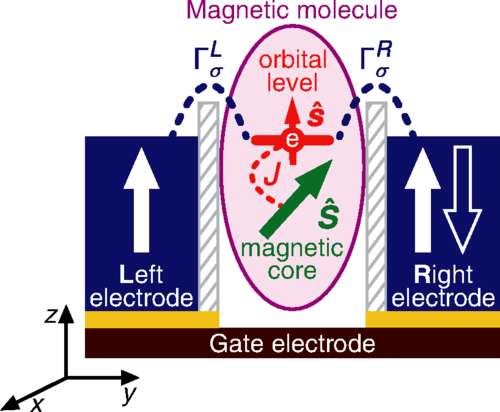
| The frequency-dependent transport through a nanodevice containing a large-spin magnetic molecule is studied theoretically in the Kondo regime. Specifically, the effect of magnetic anisotropy on dynamical spin accumulation is of primary interest. Such accumulation arises due to finite components of frequency-dependent conductance that are off diagonal in spin. Here, employing the Kubo formalism and the numerical renormalization group method, the authors demonstrate that the dynamical transport properties strongly depend on the relative orientation of spin moments in electrodes of the device, as well as on intrinsic parameters of the molecule. In particular, the effect of dynamical spin accumulation is found to be greatly affected by the type of magnetic anisotropy exhibited by the molecule, and it develops for frequencies corresponding to the Kondo temperature. For the parallel magnetic configuration of the device, the presence of dynamical spin accumulation is conditioned by the interplay of ferromagnetic-lead-induced exchange field and the Kondo correlations. |
Anna Plominska, Ireneusz Weymann, Maciej Misiorny,
Dynamical spin accumulation in large-spin magnetic molecules,
Phys. Rev. B 97, 035415 (2018)
Correlating electronic and magnetic coupling in large magnetic molecules via scanning tunneling microscopy
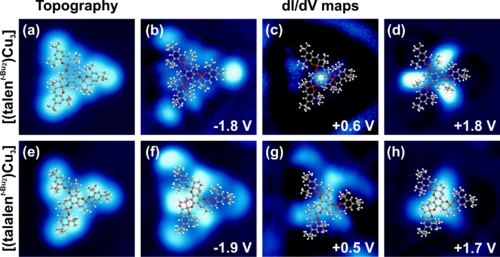
| In an effort to improve the spin coupling in single-molecule magnets, the authors rationally designed a new building-block molecule with significantly enhanced spin coupling compared to a previously established molecule. The authors relate this to a stabilization of aromaticity in the central connecting carbon ring, promoting the spin-polarization mechanism. This correlation between magnetic and electronic properties is supported by bulk measurements as well as submolecularly resolved scanning tunneling microscopy and spectroscopy experiments, where the authors found distinct differences in the local density of states distribution of the two molecules, especially at the central carbon ring. While the established molecule exhibits localized, spatially decoupled and even switchable states, the improved building block exhibits symmetric local density of states delocalized over the entire molecule, also revealing that this main characteristic electronic property is preserved upon adsorption on a metal surface. Due to their planar geometry, these molecules can serve as model systems for scanning-probe based studies of molecular magnetism. |
Judith Donner, Jan-Philipp Broschinski, Bastian Feldscher, Anja
Stammler, Hartmut Bögge, Thorsten Glaser, Daniel Wegner,
Correlating electronic and magnetic coupling in large magnetic molecules via scanning tunneling microscopy,
Phys. Rev. B 95, 165441 (2017)
The Mn12-story goes on
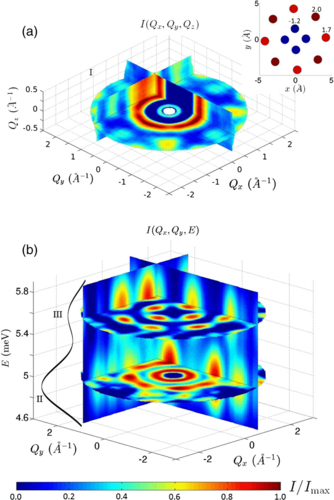
| The discovery of magnetic bistability in Mn12 more than 20 years ago marked the birth of molecular magnetism, an extremely fertile interdisciplinary field and a powerful route to create tailored magnetic nanostructures. However, the difficulty to determine interactions in complex polycentric molecules often prevents their understanding. Mn12 is an outstanding example of this difficulty: although it is the forefather and most studied of all molecular nanomagnets, an unambiguous determination of even the leading magnetic exchange interactions is still lacking. Here the authors exploit four-dimensional inelastic neutron scattering to portray how individual spins fluctuate around the magnetic ground state, thus fixing the exchange couplings of Mn12 for the first time. The results demonstrate the power of four-dimensional inelastic neutron scattering as an unrivaled tool to characterize magnetic clusters. |
A. Chiesa, T. Guidi, S. Carretta, S. Ansbro, G.A. Timco,
I. Vitorica-Yrezabal, E. Garlatti, G. Amoretti,
R.E.P. Winpenny, and P. Santini,
Magnetic Exchange Interactions in the Molecular Nanomagnet Mn12,
Phys. Rev. Lett. 119, 217202 (2017)
Operating Quantum States in Single Magnetic Molecules: Implementation of Grover's Quantum Algorithm
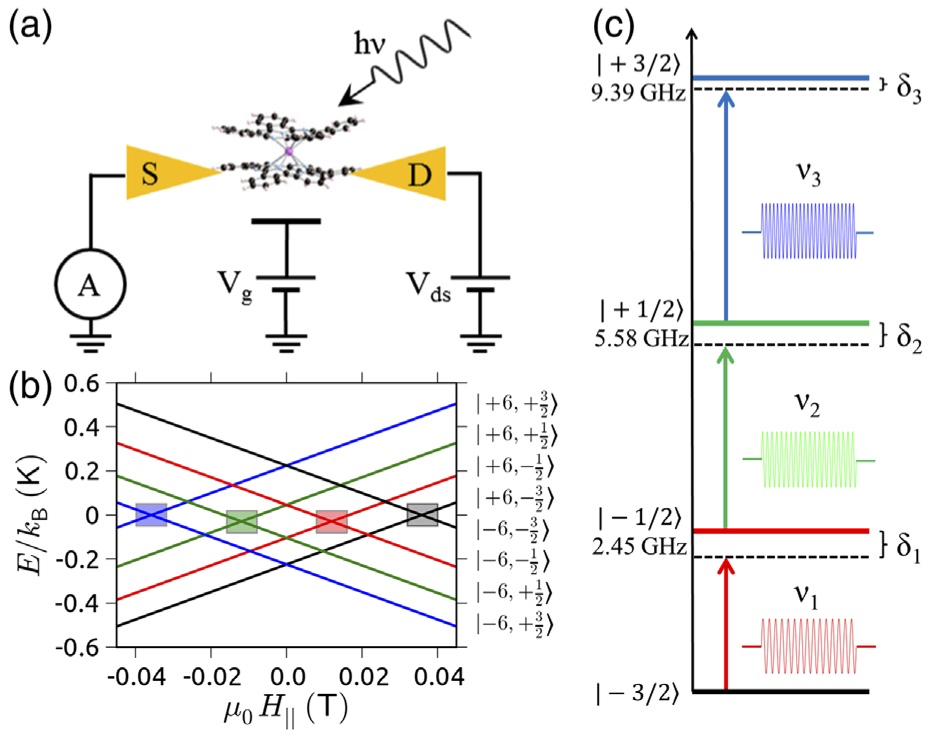
| Quantum algorithms use the principles of quantum mechanics, such as, for example, quantum superposition, in order to solve particular problems outperforming standard computation. They are developed for cryptography, searching, optimization, simulation, and solving large systems of linear equations. In this publication the authors implement Grover's quantum algorithm, proposed to find an element in an unsorted list, using a single nuclear spin 3/2 carried by a Tb ion sitting in a single molecular magnet transistor. The coherent manipulation of this multilevel quantum system (qudit) is achieved by means of electric fields only. Grover's search algorithm is implemented by constructing a quantum database via a multilevel Hadamard gate. The Grover sequence then allows us to select each state. The presented method is of universal character and can be implemented in any multilevel quantum system with nonequal spaced energy levels, opening the way to novel quantum search algorithms. |
C. Godfrin, A. Ferhat, R. Ballou, S. Klyatskaya, M. Ruben,
W. Wernsdorfer, and F. Balestro,
Operating Quantum States in Single Magnetic Molecules: Implementation of Grover's Quantum Algorithm,
Phys. Rev. Lett. 119, 187702
Topological Self-Assembly of Highly-Symmetric Lanthanide Clusters: A Magnetic Study of Exchange-Coupling "Fingerprints" in Giant Gadolinium(III) Cages
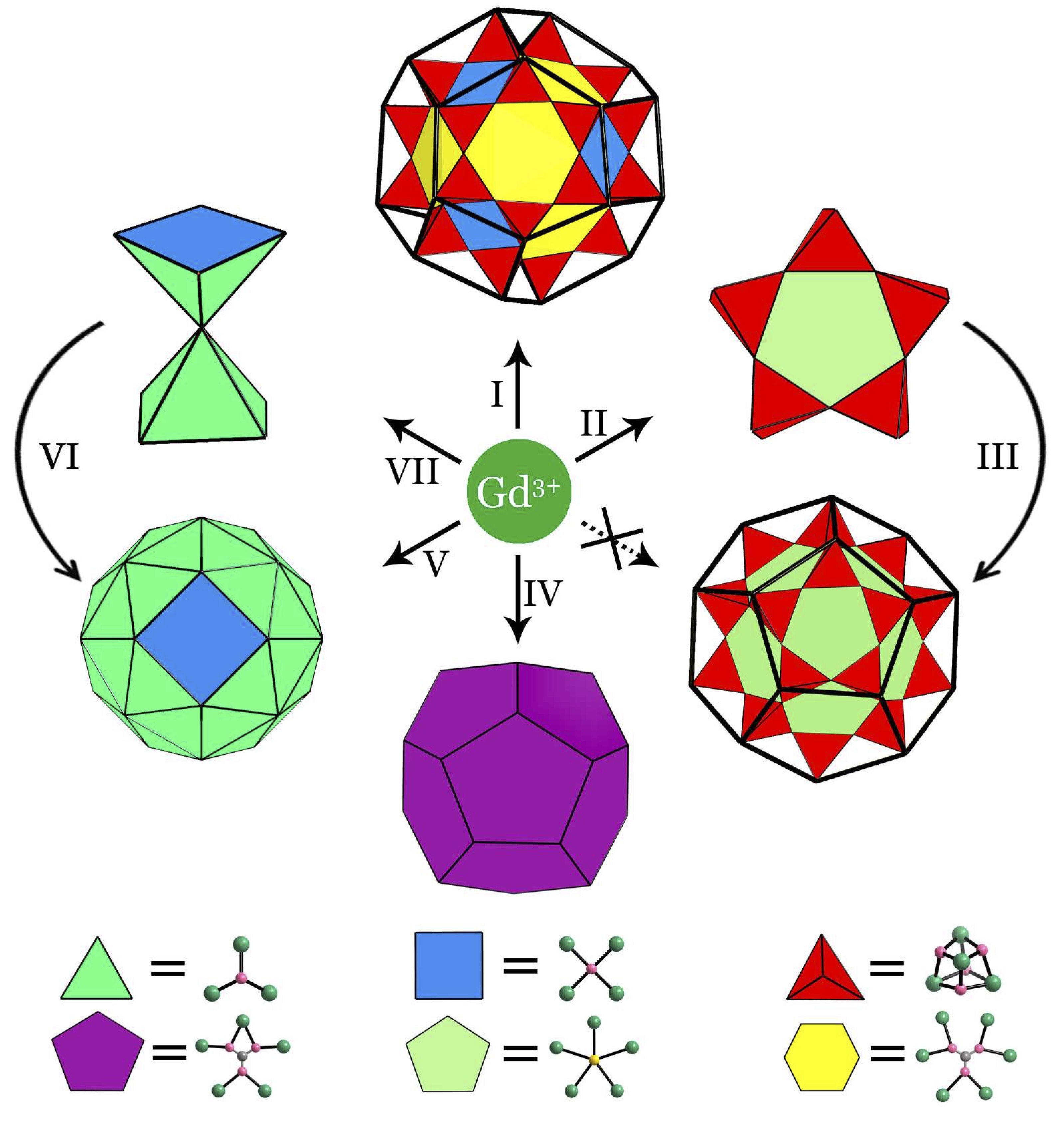
| The creation of a perfect hollow nanoscopic sphere of metal centres is clearly an unrealisable synthetic challenge. It is however an inspirational challenge, from the viewpoint of chemical architecture and also as finite molecular species may provide unique microscopic insight into the origin and onset of phenomena such as topological spin-frustration effects found in infinite 2D and 3D systems. Herein, we report a series of high symmetry gadolinium(III) (S = 7/2) polyhedra, Gd20, Gd32, Gd50 and Gd60, to test an approach based on assembling polymetallic fragments that contain different polygons. Structural analysis reveals the Gd20 cage resembles a dodecahedron; the vertices of the Gd32 polyhedron exactly reveal symmetry Oh; Gd50 displays an unprecedented polyhedron in which an icosidodecahedron Gd30 core is encapsulated by an outer Gd20 dodecahedral shell with approximate Ih symmetry; and the Gd60 shows a truncated octahedron geometry. Experimental and theoretical magnetic studies show that this series produces the expected antiferromagnetic interaction that can be modelled based on classical spins at the Gd sites. From the magnetization analyses we can roughly correlate the derivative bands to the Gd-O-Gd angles. Such a magneto-structural correlation may be used as "fingerprints" to identify these cages. |
Lei Qin, Guo-Jun Zhou, You-Zhu Yu, Hiroyuki Nojiri, Christian
Schröder, Richard E. P. Winpenny, and Yan-Zhen Zheng,
Topological Self-Assembly of Highly-Symmetric Lanthanide Clusters: A Magnetic Study of Exchange-Coupling "Fingerprints" in Giant Gadolinium(III) Cages,
J. Am. Chem. Soc. 139, 16405 (2017)
Molecular magnetic hysteresis at 60 Kelvin in dysprosocenium
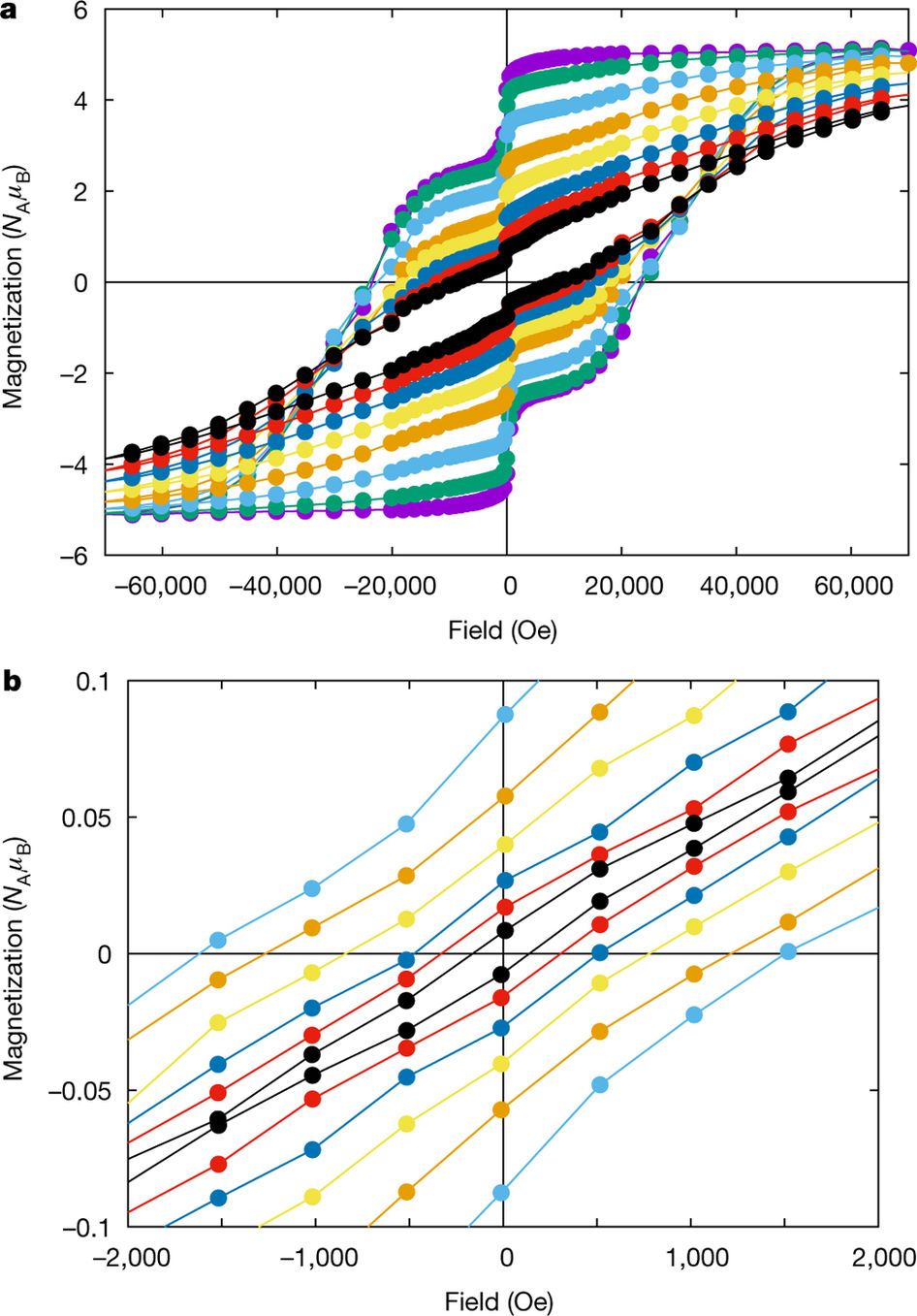
| Lanthanides have been investigated extensively for potential applications in quantum information processing and high-density data storage at the molecular and atomic scale. Experimental achievements include reading and manipulating single nuclear spins, exploiting atomic clock transitions for robust qubits and, most recently, magnetic data storage in single atoms. Single-molecule magnets exhibit magnetic hysteresis of molecular origin - a magnetic memory effect and a prerequisite of data storage - and so far lanthanide examples have exhibited this phenomenon at the highest temperatures. However, in the nearly 25 years since the discovery of single-molecule magnets, hysteresis temperatures have increased from 4 Kelvin to only about 14 Kelvin using a consistent magnetic field sweep rate of about 20 oersted per second, although higher temperatures have been achieved by using very fast sweep rates (for example, 30 Kelvin with 200 oersted per second). Here the authors report a hexa-tert-butyldysprosocenium complex which exhibits magnetic hysteresis at temperatures of up to 60 Kelvin at a sweep rate of 22 oersted per second. We observe a clear change in the relaxation dynamics at this temperature, which persists in magnetically diluted samples, suggesting that the origin of the hysteresis is the localized metal-ligand vibrational modes that are unique to dysprosocenium. Ab initio calculations of spin dynamics demonstrate that magnetic relaxation at high temperatures is due to local molecular vibrations. These results indicate that, with judicious molecular design, magnetic data storage in single molecules at temperatures above liquid nitrogen should be possible. |
Conrad A. P. Goodwin, Fabrizio Ortu, Daniel Reta, Nicholas
F. Chilton, David P. Mills,
Molecular magnetic hysteresis at 60 Kelvin in dysprosocenium,
Nature 548, 439-442 (2017)
Roberta Sessoli,
Materials science: Magnetic molecules back in the race,
Nature 548, 400-401 (2017)
Narrowing the Zero-Field Tunneling Resonance by Decreasing the Crystal Symmetry of Mn12 Acetate
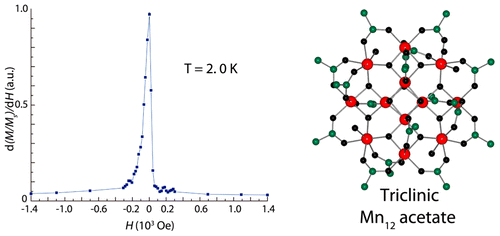
| The authors report the discovery of a less symmetric crystalline phase of Mn12 acetate, a triclinic phase, resulting from recrystallizing the original tetragonal phase reported by Lis in acetonitrile and toluene. This new phase exhibits the same structure of Mn12 acetate clusters and the same positions of tunneling resonances on the magnetic field as the conventional tetragonal phase. However, the width of the zero-field resonance is at least 1 order of magnitude smaller, can be as low as 50 Oe, indicating very small inhomogeneous broadening due to dipolar and nuclear fields. |
Jordi Espin, Ricardo Zarzuela, Nahuel Statuto, Jordi
Juanhuix, Daniel Maspoch, Inhar Imaz, Eugene Chudnovsky, Javier Tejada,
Narrowing the Zero-Field Tunneling Resonance by Decreasing the Crystal Symmetry of Mn12 Acetate,
J. Am. Chem. Soc., 2016, 138, 9065-9068
Put the spin in a cage
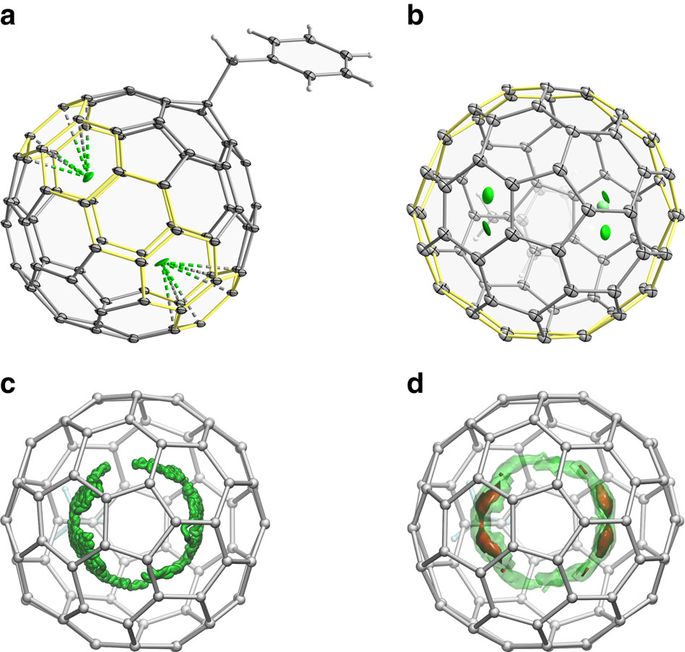
| To increase the temperature at which molecules behave as single-molecule magnets (SMM) is a serious challenge in molecular magnetism. One of the ways to address this problem is to create molecules with strongly coupled lanthanide ions. In the presented work, endohedral metallofullerenes Y2@C80 and Dy2@C80 are obtained in the form of air-stable benzyl monoadducts. Both feature an unpaired electron trapped between metal ions, thus forming a single-electron metal-metal bond. Giant exchange interactions between lanthanide ions and the unpaired electron result in single-molecule magnetism of Dy2@C80(CH2Ph) with a record-high 100 seconds blocking temperature of 18 K. All magnetic moments in Dy2@C80(CH2Ph) are parallel and couple ferromagnetically to form a single spin unit of 21 Bohr magnetons with a dysprosium-electron exchange constant of 32 cm-1. The barrier of the magnetization reversal of 613 K is assigned to the state in which the spin of one Dy centre is flipped. |
Fupin Liu, Denis S. Krylov, Lukas Spree, Stanislav
M. Avdoshenko, Nataliya A. Samoylova, Marco Rosenkranz, Aram
Kostanyan, Thomas Greber, Anja U. B. Wolter, Bernd Büchner, Alexey A. Popov,
Single molecule magnet with an unpaired electron trapped between two lanthanide ions inside a fullerene,
Nature Communications 8, 16098 (2017)
D. S. Krylov, F. Liu, S. M. Avdoshenko, L. Spree,
B. Weise, A. Waske, A. U. B. Wolter, B. Büchner, A. A. Popov,
Record-high thermal barrier of the relaxation of magnetization in the nitride clusterfullerene Dy2ScN@C80-Ih,
Chem. Commun., 2017, 53, 7901-7904
A microscopic refrigeration process triggered through spin-crossover mechanism
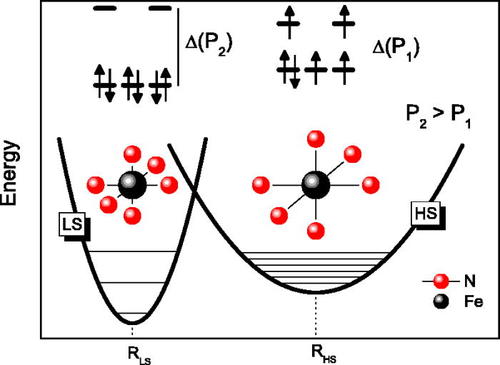
| The author reports the giant barocaloric effect determined in a spin-crossover system using a microscopic model. Compared with the widely used gas compression-expansion refrigeration technology, field induced refrigeration in solid materials reduces environmental damages and improves the energy efficiency. The origin of the giant effect was ascribed to the entropic phonon contribution arising from low spin to high spin phase transition, induced by a pressure change. Here, the author shows that for the applied pressure variation from 1 bar to 4.1 kbar, the isothermal entropy change in a one-dimensional spin crossover system [Fe(hyptrz)3](4-chlorophenylsulfonate)2H2O achieves a maximum value of 55.8 J/(mol K) at 191 K, leading to a huge refrigerant capacity of 2160 J/mol. The results were compared with the results of other giant solid refrigerant materials such as (NH4)2SO4, Gd5Si2Ge2, and Gd5[Si0.43Ge0.57]4. The potential of a solid refrigerant material is characterized by the isothermal entropy change upon controlled external field variations. If this quantity is obtained upon magnetic field variations, a magnetocaloric effect occurs; upon an electrical field change or a pressure change, electrocaloric or barocaloric effects occur, respectively. |
P. J. von Ranke,
A microscopic refrigeration process triggered through spin-crossover mechanism,
Appl. Phys. Lett. 110, 181909 (2017)
Recent progress in synchrotron-based frequency-domain Fourier-transform THz-EPR
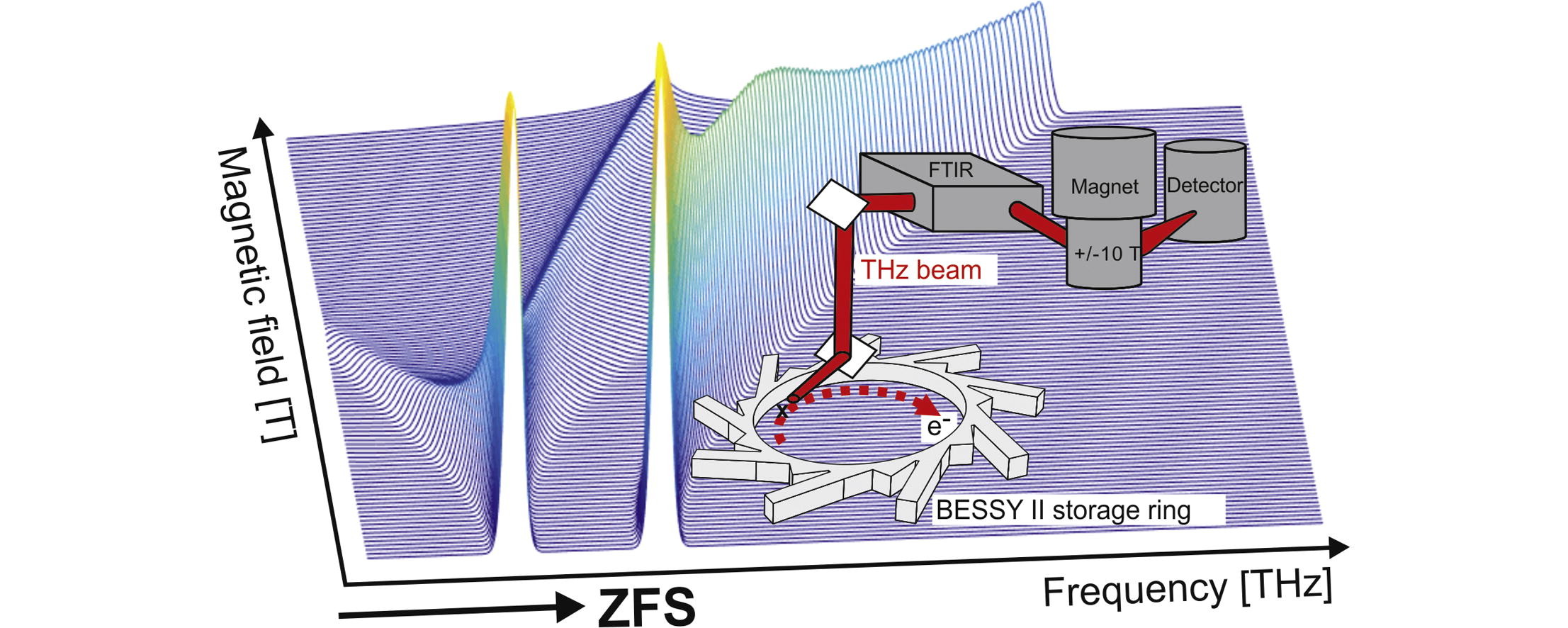
| We describe frequency-domain Fourier-transform THz-EPR as a method to assign spin-coupling parameters of high-spin (S > 1/2) systems with very large zero-field splittings. The instrumental foundations of synchrotron-based FD-FT THz-EPR are presented, alongside with a discussion of frequency-domain EPR simulation routines. The capabilities of this approach is demonstrated for selected mono- and multinuclear HS systems. Finally, we discuss remaining challenges and give an outlook on the future prospects of the technique. |
Joscha Nehrkorn, Karsten Holldack, Robert Bittl, Alexander
Schnegg,
Recent progress in synchrotron-based frequency-domain Fourier-transform THz-EPR,
Journal of Magnetic Resonance 280, 10-19 2017
Long-range ferrimagnetic order in a two-dimensional supramolecular Kondo lattice
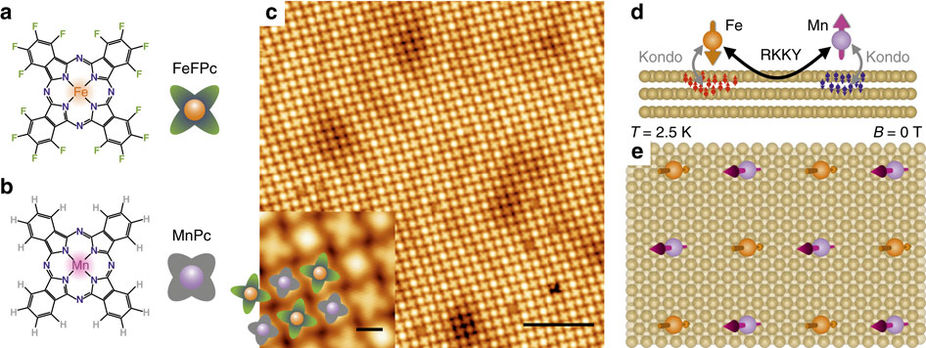
| Realization of long-range magnetic order in surface-supported two-dimensional systems has been challenging, mainly due to the competition between fundamental magnetic interactions as the short-range Kondo effect and spin-stabilizing magnetic exchange interactions. Spin-bearing molecules on conducting substrates represent a rich platform to investigate the interplay of these fundamental magnetic interactions. Here we demonstrate the direct observation of long-range ferrimagnetic order emerging in a two-dimensional supramolecular Kondo lattice. The lattice consists of paramagnetic hexadeca-fluorinated iron phthalocyanine (FeFPc) and manganese phthalocyanine (MnPc) molecules co-assembled into a checkerboard pattern on single-crystalline Au(111) substrates. Remarkably, the remanent magnetic moments are oriented in the out-of-plane direction with significant contribution from orbital moments. |
Jan Girovsky, Jan Nowakowski, Md. Ehesan Ali, Milos Baljozovic,
Harald R. Rossmann, Thomas Nijs, Elise A. Aeby, Sylwia
Nowakowska, Dorota Siewert, Gitika Srivastava, Christian
Wäckerlin, Jan Dreiser, Silvio Decurtins, Shi-Xia Liu, Peter
M. Oppeneer, Thomas A. Jung, Nirmalya Ballav,
Long-range ferrimagnetic order in a two-dimensional supramolecular Kondo lattice,
Nature Communications 8, 15388 (2017)
A chimeric design of heterospin 2p-3d, 2p-4f, and 2p-3d-4f complexes using a novel family of paramagnetic dissymmetric compartmental ligands
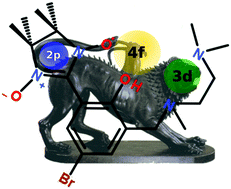
| End-off bicompartmental ligands bearing a nitronyl-nitroxide arm have been designed for synthesizing various heterospin molecular systems. These ligands can selectively interact with 3d and 4f metal ions, leading to 2p-4f, 2p-3d, and 2p-3d-4f complexes. The magnetic properties of the 2p-4f and 2p-3d-4f complexes have been investigated and rationalized by theoretical calculations. |
Andrei A. Patrascu, Sergiu Calancea, Matteo Briganti,
Stephane Soriano, Augustin M. Madalan, Rafael A. Allao
Cassaro, Andrea Caneschi, Federico Totti, Maria
G. F. Vaz and Marius Andruh,
A chimeric design of heterospin 2p-3d, 2p-4f, and 2p-3d-4f complexes using a novel family of paramagnetic dissymmetric compartmental ligands,
Chem. Commun., 2017, 53, 6504
Portraying entanglement between molecular qubits with four-dimensional inelastic neutron scattering
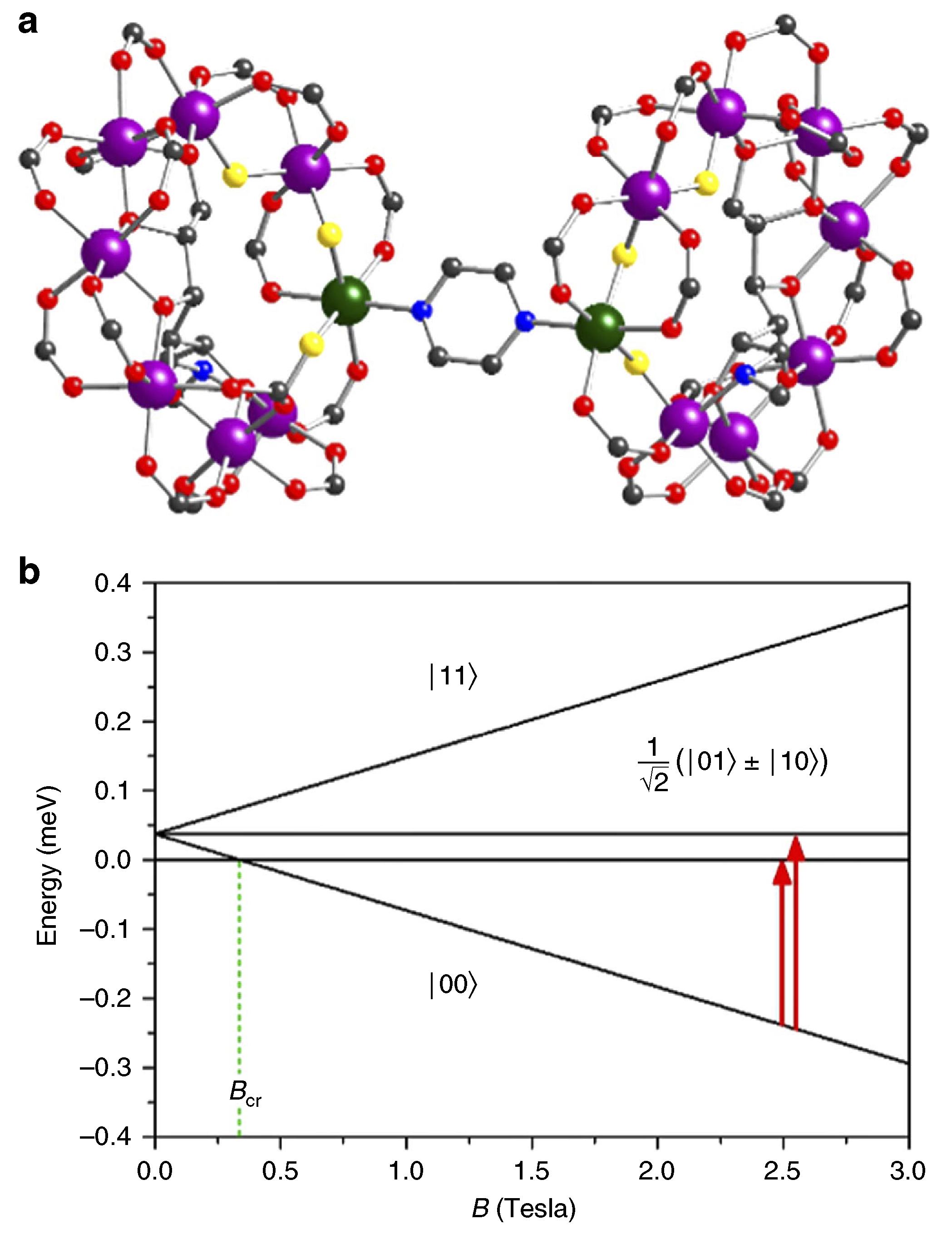
| Entanglement is a crucial resource for quantum information processing and its detection and quantification is of paramount importance in many areas of current research. Weakly coupled molecular nanomagnets provide an ideal test bed for investigating entanglement between complex spin systems. However, entanglement in these systems has only been experimentally demonstrated rather indirectly by macroscopic techniques or by fitting trial model Hamiltonians to experimental data. Here the authors show that four-dimensional inelastic neutron scattering enables one to portray entanglement in weakly coupled molecular qubits and to quantify it. To this end a prototype (Cr7Ni)2 supramolecular dimer is exploited as a benchmark to demonstrate the potential of this approach, which allows one to extract the concurrence in eigenstates of a dimer of molecular qubits without diagonalizing its full Hamiltonian. |
E. Garlatti, T. Guidi, S. Ansbro, P. Santini,
G. Amoretti, J. Ollivier, H. Mutka, G. Timco,
I.J. Vitorica-Yrezabal, G.F.S. Whitehead, R.E.P. Winpenny, S. Carretta,
Portraying entanglement between molecular qubits with four-dimensional inelastic neutron scattering,
Nature Communications 8, 14543 (2017)
Molecular magnetism, quo vadis? A historical perspective from a coordination chemist viewpoint
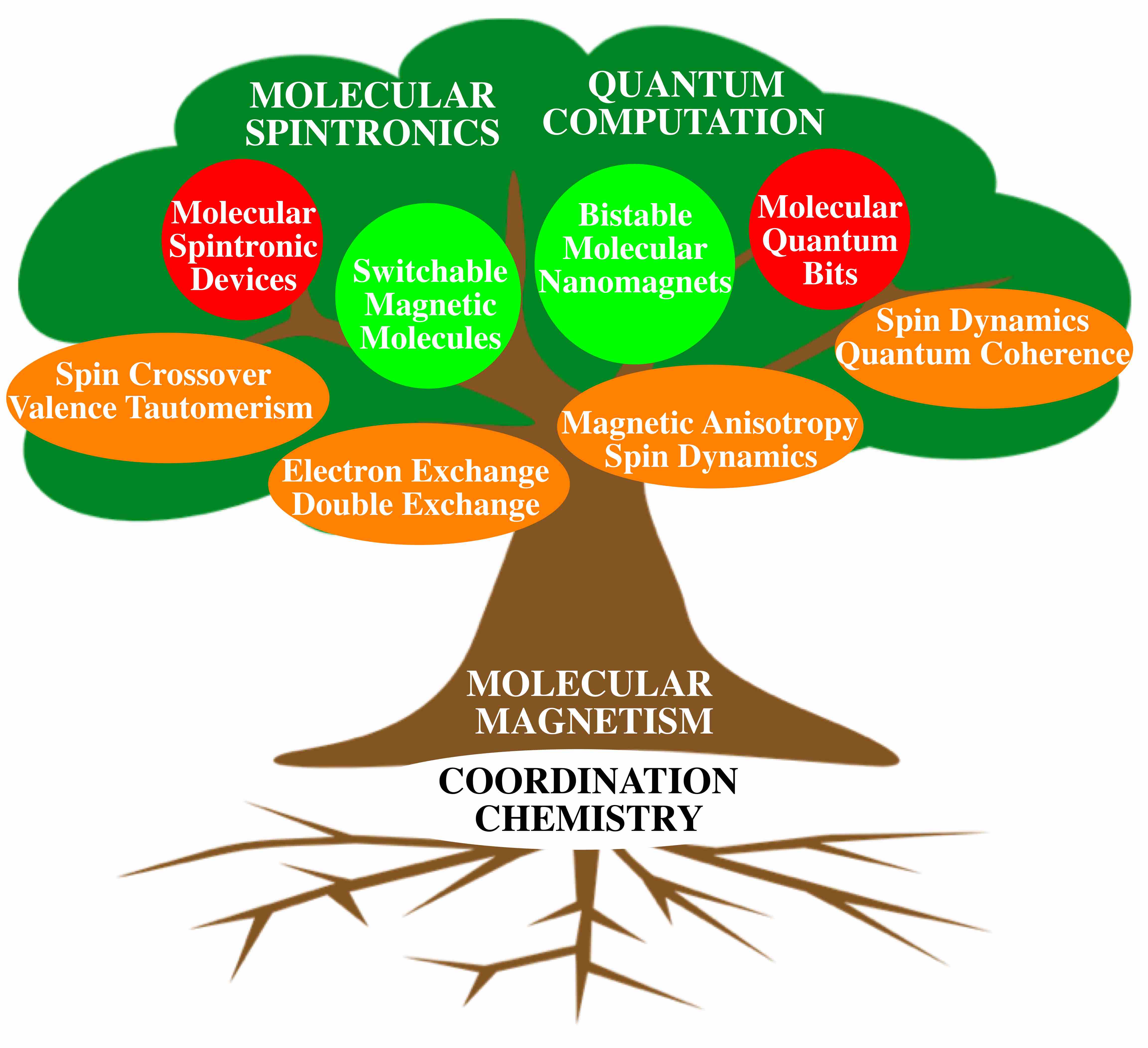
| Molecular magnetism has travelled a long way from the pioneering studies on electron exchange and double exchange or spin crossover and valence tautomerism in small oligonuclear complexes, from mono- to di- and tetranuclear species, to the current investigations about magnetic anisotropy and spin dynamics or quantum coherence of simple mono- or large polynuclear complexes, behaving as switchable bistable molecular nanomagnets for potential applications in information data storage and processing. In this review, the authors focus on the origin and development of the research in the field of molecular magnetism from a coordination chemistry viewpoint, which dates back to the establishment of magnetochemistry as a novel discipline among the molecular sciences. This overview is conceived as an attempt to orientate coordination chemists regarding their role in the future direction that molecular magnetism will undergo in its further evolution toward molecular spintronics and quantum computation. A particular emphasis will be given to some selected recent advances in single-molecule spintronic circuitry and quantum computing devices based on the large class of multiresponsive and multifunctional magnetic metal complexes to stimulate the progress in the field of molecular magnetism. |
Jesús Ferrando-Soria,
Julia Vallejo,
María Castellano,
José Martínez-Lillo,
Emilio Pardo,
Joan Cano,
Isabel Castro,
Francesc Lloret,
Rafael Ruiz-García,
Miguel Julve,
Molecular magnetism, quo vadis? A historical perspective from a coordination chemist viewpoint,
Coordination Chemistry Reviews 339 (2017) 17-103
Room Temperature Magnetoresistance in Single-Molecule Devices
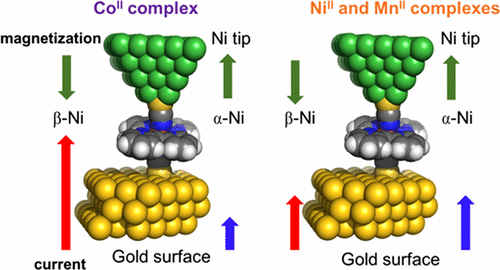
| Two recent publications show that the appropriate choice of the transition metal complex and metal surface electronic structure opens the possibility to control the spin of the charge carriers through the resulting hybrid molecule/metal spinterface in a single-molecule electrical contact at room temperature. |
Albert C. Aragones, Daniel Aravena, Francisco
J. Valverde-Munoz, Jose Antonio Real, Fausto Sanz, Ismael
Diez-Perez, Eliseo Ruiz,
Metal-Controlled Magnetoresistance at Room Temperature in Single-Molecule Devices,
J. Am. Chem. Soc., 2017, 139 (16), pp 5768-5778
Albert C. Aragones, Daniel Aravena, Jorge I. Cerda, Zulema
Acis-Castillo, Haipeng Li, Jose Antonio Real, Fausto Sanz,
Josh Hihath, Eliseo Ruiz, Ismael Diez-Perez,
Large Conductance Switching in a Single-Molecule Device through Room Temperature Spin-Dependent Transport,
Nano Lett., 2016, 16 (1), pp 218-226
Recent Development in Clusters of Rare Earths and Actinides: Chemistry and Materials
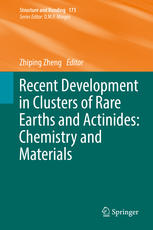
| With contributions by Zhonghao Zhang, Yanan Zhang, Zhiping Zheng, Xiu-Ying Zheng, Xiang-Jian Kong, La-Sheng Long, Jian-Wen Cheng, Guo-Yu Yang, Sarah Hickam, Peter C. Burns, Xiaoping Yang, Shiqing Wang, Chengri Wang, Shaoming Huang, Richard A. Jones, Yan-Cong Chen, Jun-Liang Liu, Ming-Liang Tong, Tian Han, You-Song Ding, Yan-Zhen Zheng, Takanori Shima, Zhaomin Hou |
Recent Development in Clusters of Rare Earths and Actinides: Chemistry and Materials, Editors: Zhiping Zheng, Structure and Bonding, Volume 173 2017Springer, ISBN: 978-3-662-53301-7 (Print) 978-3-662-53303-1 (Online), online
Spin Dynamics and Low Energy Vibrations: Insights from Vanadyl-Based Potential Molecular Qubits
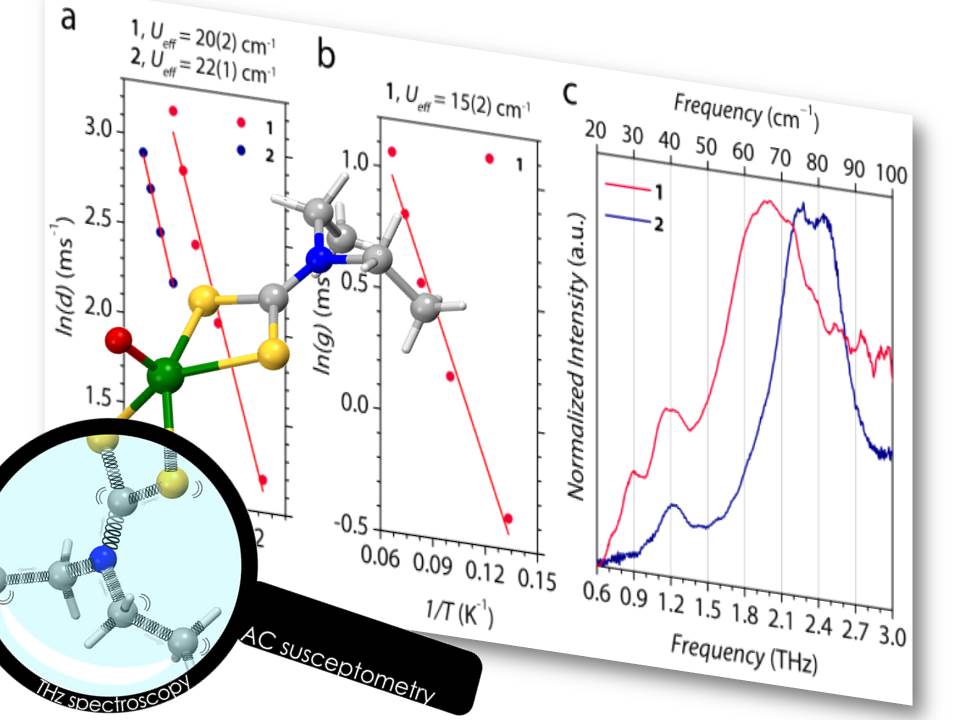
| In this communication the authors report the investigation of the magnetization dynamics of a vanadyl complex with diethyldithiocarbamate (Et2dtc-) ligands in both solid-state and frozen solution. The investigation showed an anomalous and unprecedentedly observed field dependence of the relaxation time, which was modeled with three contributions to the relaxation mechanism. The temperature dependence of the weight of the two processes dominating at low fields was found to well correlate with the low energy vibrations as determined by THz spectroscopy. This detailed experimental comparative study represents a fundamental step to understand the spin dynamics of potential molecular quantum bits and enriches the guidelines to design molecule-based systems with enhanced quantum coherence. |
Matteo Atzori, Lorenzo Tesi, Stefano Benci, Alessandro Lunghi,
Roberto Righini, Andrea Taschin, Renato Torre, Lorenzo Sorace,
Roberta Sessoli,
Spin Dynamics and Low Energy Vibrations: Insights from Vanadyl-Based Potential Molecular Qubits,
J. Am. Chem. Soc., 2017, 139 (12), pp 4338-4341
The role of anharmonic phonons in under-barrier spin relaxation of single molecule magnets
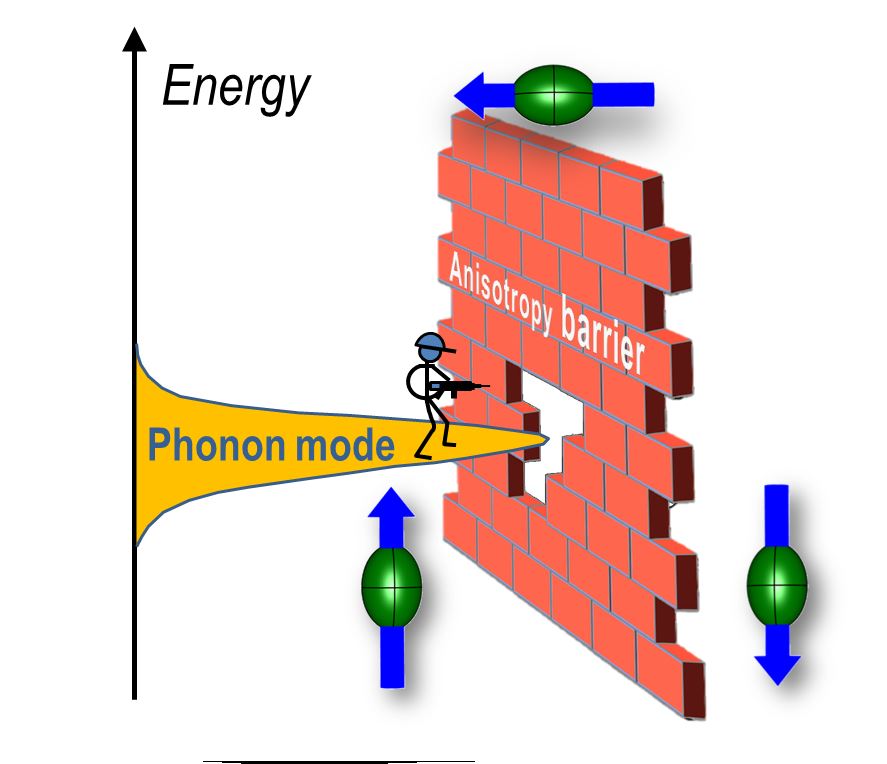
| The use of single molecule magnets in mainstream electronics requires their magnetic moment to be stable over long times. One can achieve such a goal by designing compounds with spin-reversal barriers exceeding room temperature, namely with large uniaxial anisotropies. Such strategy, however, has been defeated by several recent experiments demonstrating under-barrier relaxation at high temperature, a behaviour today unexplained. Here the authors propose spin-phonon coupling to be responsible for such anomaly. With a combination of electronic structure theory and master equations the authors show that, in the presence of phonon dissipation, the relevant energy scale for the spin relaxation is given by the lower-lying phonon modes interacting with the local spins. These open a channel for spin reversal at energies lower than that set by the magnetic anisotropy, producing fast under-barrier spin relaxation. The findings rationalize a significant body of experimental work and suggest a possible strategy for engineering room temperature single molecule magnets. |
Alessandro Lunghi, Federico Totti, Roberta Sessoli, Stefano
Sanvito,
The role of anharmonic phonons in under-barrier spin relaxation of single molecule magnets,
Nature Communications 8, 14620 (2017)
Pressure induced enhancement of the magnetic ordering temperature in rhenium(IV) monomers
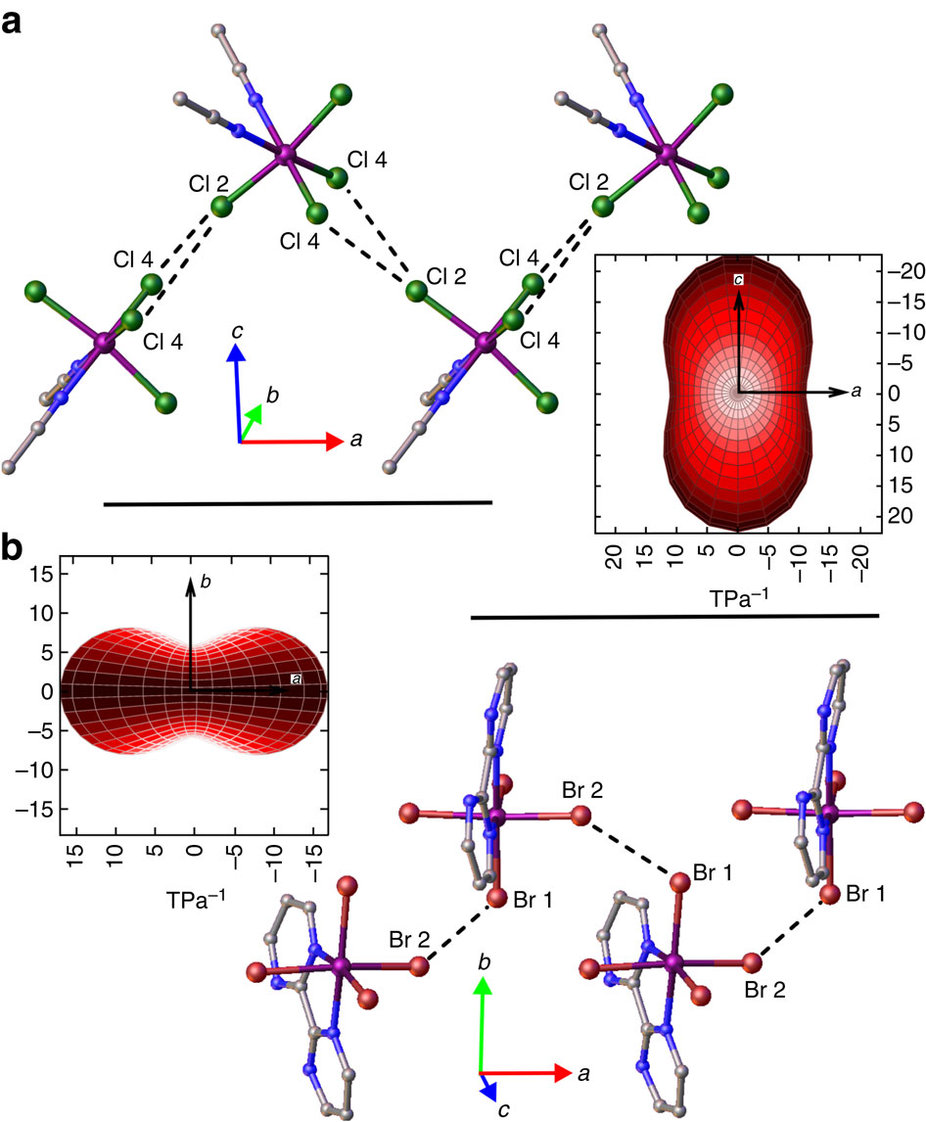
| Materials that demonstrate long-range magnetic order are synonymous with information storage and the electronics industry, with the phenomenon commonly associated with metals, metal alloys or metal oxides and sulfides. A lesser known family of magnetically ordered complexes are the monometallic compounds of highly anisotropic d-block transition metals; the 'transformation' from isolated zero-dimensional molecule to ordered, spin-canted, three-dimensional lattice being the result of through-space interactions arising from the combination of large magnetic anisotropy and spin-delocalization from metal to ligand which induces important intermolecular contacts. Here the authors report the effect of pressure on two such mononuclear rhenium(IV) compounds that exhibit long-range magnetic order under ambient conditions via a spin canting mechanism, with Tc controlled by the strength of the intermolecular interactions. As these are determined by intermolecular distance, 'squeezing' the molecules closer together generates remarkable enhancements in ordering temperatures, with a linear dependence of Tc with pressure. |
Christopher H. Woodall, Gavin A. Craig, Alessandro Prescimone,
Martin Misek, Joan Cano, Juan Faus, Michael R. Probert, Simon
Parsons, Stephen Moggach, Jose Martinez-Lillo, Mark Murrie,
Konstantin V. Kamenev, Euan K. Brechin,
Pressure induced enhancement of the magnetic ordering temperature in rhenium(IV) monomers,
Nature Communications 7, 13870 (2016)
Precision ESR measurements of transverse anisotropy in the single-molecule magnet Ni4
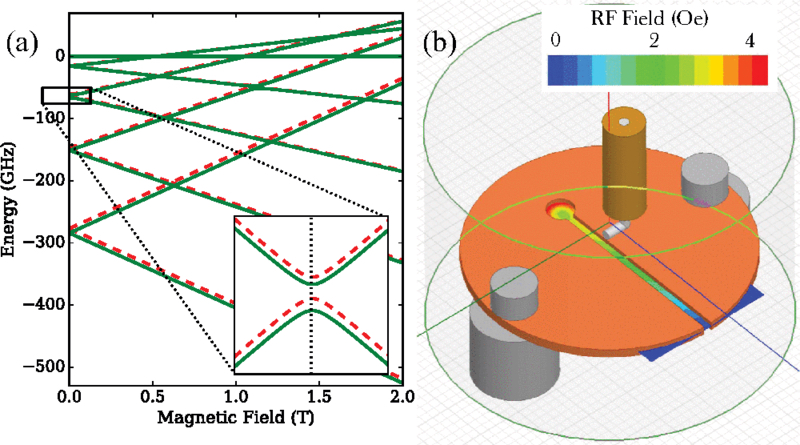
| The authors present a method for precisely measuring the tunnel splitting in single-molecule magnets (SMMs) using electron-spin resonance, and use these measurements to precisely and independently determine the underlying transverse anisotropy parameter, given a certain class of transitions. By diluting samples of the SMM Ni4 via cocrystallization in a diamagnetic isostructural analog we obtain markedly narrower resonance peaks than are observed in undiluted samples. Using custom loop-gap resonators we measure the transitions at several frequencies, allowing a precise determination of the tunnel splitting. Because the transition under investigation occurs at zero field, and arises due to a first-order perturbation from the transverse anisotropy, we can determine the magnitude of this anisotropy independent of any other Hamiltonian parameters. This method can be applied to other SMMs with tunnel splittings arising from first-order transverse anisotropy perturbations. |
Charles A. Collett, Rafael A. Allao Cassaro, and Jonathan
R. Friedman,
Precision ESR measurements of transverse anisotropy in the single-molecule magnet Ni4,
Phys. Rev. B 94, 220402(R) (2016)
First cage-like pentanuclear Co(II)-silsesquioxane
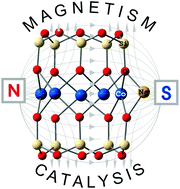
| A new pentanuclear cylinder-like cobalt(II) phenylsilsesquioxane exhibits a slow relaxation of the magnetization and a high catalytic activity and stereoselectivity in the oxidation of alkanes and alcohols. |
A. N. Bilyachenko, A. I. Yalymov, M. M. Levitsky,
A. A. Korlyukov, M. A. Es'kova, J. Long,
J. Larionova, Y. Guari, L. S. Shul'pina,
N. S. Ikonnikov, A. L. Trigub, Y. V. Zubavichus,
I. E. Golub, E. S. Shubina and G. B. Shul'pin,
First cage-like pentanuclear Co(II)-silsesquioxane,
Dalton Trans., 2016,45, 13663-13666
Molecular Magnetic Materials: Concepts and Applications
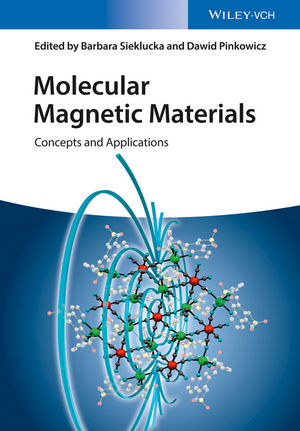
|
A comprehensive overview of this rapidly expanding interdisciplinary field of research.
After a short introduction to the basics of magnetism and
molecular magnetism, the text goes on to cover specific
properties of molecular magnetic materials as well as their
current and future applications. Design strategies for acquiring
molecular magnetic materials with desired physical properties
are discussed, as are such multifunctional materials as high Tc
magnets, chiral and luminescent magnets, magnetic sponges as
well as photo- and piezo-switching magnets.
The result is an excellent resource for materials scientists,
chemists, physicists and crystal engineers either entering or
already working in the field.
With contributions of: Maria Balanda, Robert Pelka, Michael Shatruk, Silvia Gomez-Coca, Kim R. Dunbar, Zhao-Ping Ni, Ming-Liang Tong, Masahiro Yamashita, Keiichi Katoh, Paolo Santini, Stefano Carretta, Giuseppe Amoretti, Kasper S. Pedersen, Alessandro Vindigni, Roberta Sessoli, Claude Coulon, Rodolphe Clerac, Joel S. Miller, Shin-ichi Ohkoshi, Andrea Cornia, Daniel R. Talham, Marco Affronte, Ana B. Gaspar, Birgit Weber, Wei-Xiong Zhang, Ming-Hua Zeng, Xiao-Ming Chen, Dawid Pinkowicz, Robet Podgajny, Barbara Sieklucka, Cyrille Train, Geert Rikken, Michel Verdaguer, Corine Mathoniere, Hiroko Tokoro, Shin-ichi Ohkoshi , Mauro Perfetti, Fabrice Pointillart, Olivier Cador, Lorenzo Sorace, Lahcene Ouahab, Yoshihiro Sekine, Wataru Kosaka, Kouji Taniguchi, Hitoshi Miyasaka, Thomas T. M. Palstra, Alexey O. Polyakov, Jordi Cirera, Eliseo Ruiz, Jürgen Schnack and Coen de Graaf. |
Barbara Sieklucka (Editor), Dawid Pinkowicz (Editor),
Molecular Magnetic Materials: Concepts and Applications,
WILEY, 2016, ISBN: 978-3-527-33953-2
On Approaching the Limit of Molecular Magnetic Anisotropy: A Near-Perfect Pentagonal Bipyramidal Dysprosium(III) Single-Molecule Magnet
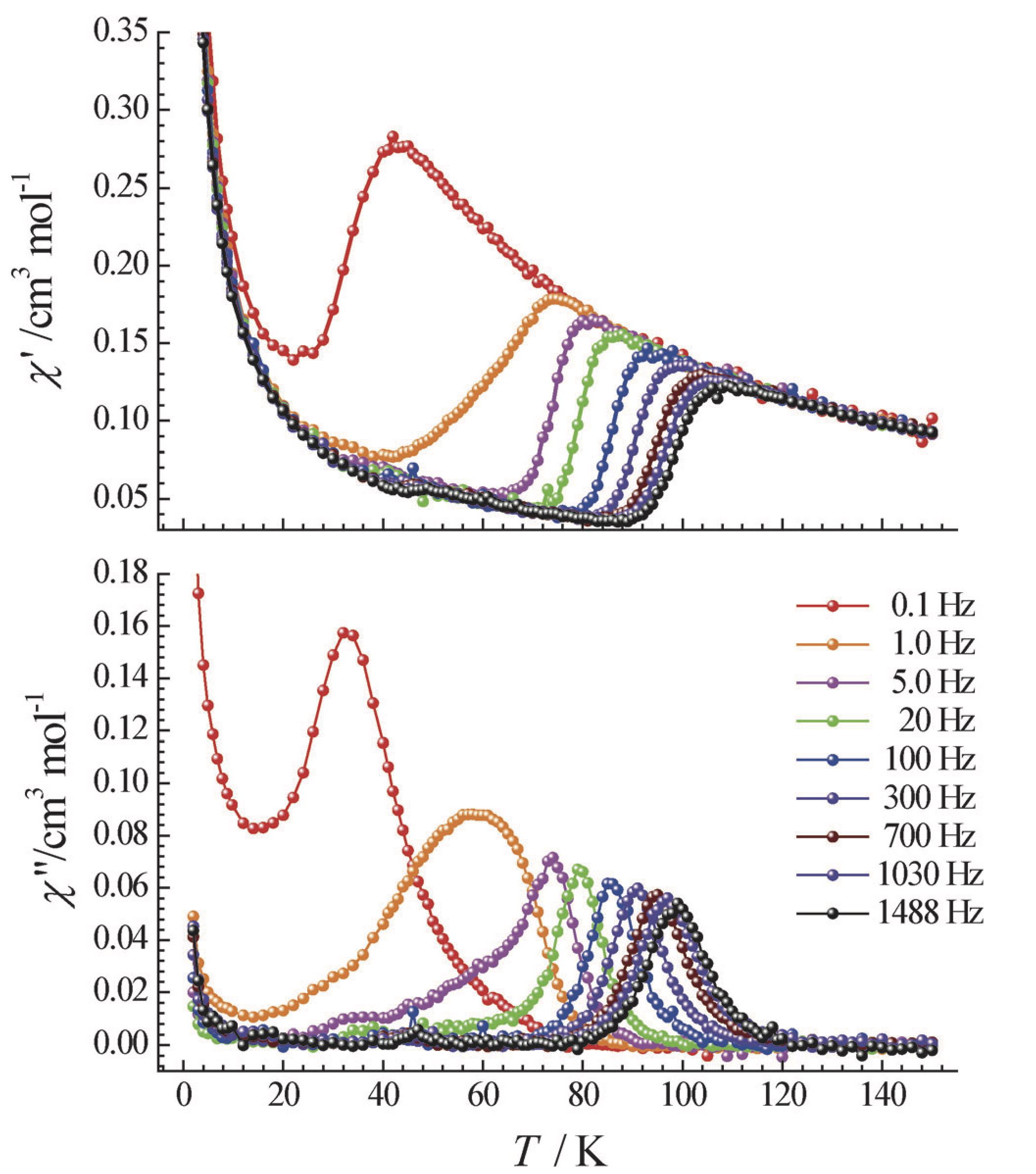
| The authos report a monometallic dysprosium complex, that shows the largest effective energy barrier to magnetic relaxation of Ueff=1815 K. The massive magnetic anisotropy is due to bis-trans-disposed tert-butoxide ligands with weak equatorial pyridine donors, approaching proposed schemes for high-temperature single-molecule magnets (SMMs). The blocking temperature is 14 K, defined by zero-field-cooled magnetization experiments, and is the largest for any monometallic complex. |
You-Song Ding,
Nicholas F. Chilton,
Richard E. P. Winpenny,
Yan-Zhen Zheng,
On Approaching the Limit of Molecular Magnetic Anisotropy: A Near-Perfect Pentagonal Bipyramidal Dysprosium(III) Single-Molecule Magnet,
Angew. Chem. Int. Ed. 55, 16071 (2016)
Research Update: The mechanocaloric potential of spin crossover compounds

| The author presents a first evaluation of the potential for spin crossover (SCO) compounds to be considered as a new class of giant mechanocaloric effect materials. From literature data on the variation of the spin crossover temperature with pressure, we estimate the maximum available adiabatic temperature change for several compounds and the relatively low pressures that may be required to observe these effects. |
Karl G. Sandeman,
Research Update: The mechanocaloric potential of spin crossover compounds,
APL Mater. 4, 111102 (2016)
Observation of Tunneling-Assisted Highly Forbidden Single-Photon Transitions in a Ni4 Single-Molecule Magnet
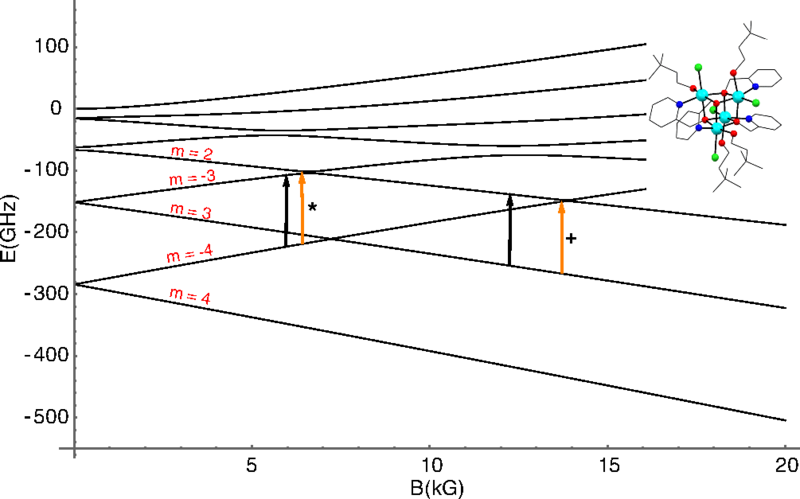
| Forbidden transitions between energy levels typically involve violation of selection rules imposed by symmetry and/or conservation laws. A nanomagnet tunneling between up and down states violates angular momentum conservation because of broken rotational symmetry. Here the authors report observations of highly forbidden transitions between spin states in a Ni4 single-molecule magnet in which a single photon can induce the spin to change by several times hbar, nearly reversing the direction of the spin. These observations are understood as tunneling-assisted transitions that lift the standard Delta m=+/-1 selection rule for single-photon transitions. These transitions are observed at low applied fields, where tunneling is dominated by the molecule's intrinsic anisotropy and the field acts as a perturbation. Such transitions can be exploited to create macroscopic superposition states that are not typically accessible through single-photon Delta m=+/-1 transitions. |
Yiming Chen, Mohammad D. Ashkezari, Charles A. Collett, Rafael A. Allao Cassaro, Filippo Troiani, Paul M. Lahti, and Jonathan R. Friedman,
Observation of Tunneling-Assisted Highly Forbidden Single-Photon Transitions in a Ni4 Single-Molecule Magnet,
Phys. Rev. Lett. 117, 187202 (2016)
Experimental and theoretical investigation of the magnetization dynamics of an artificial square spin ice cluster
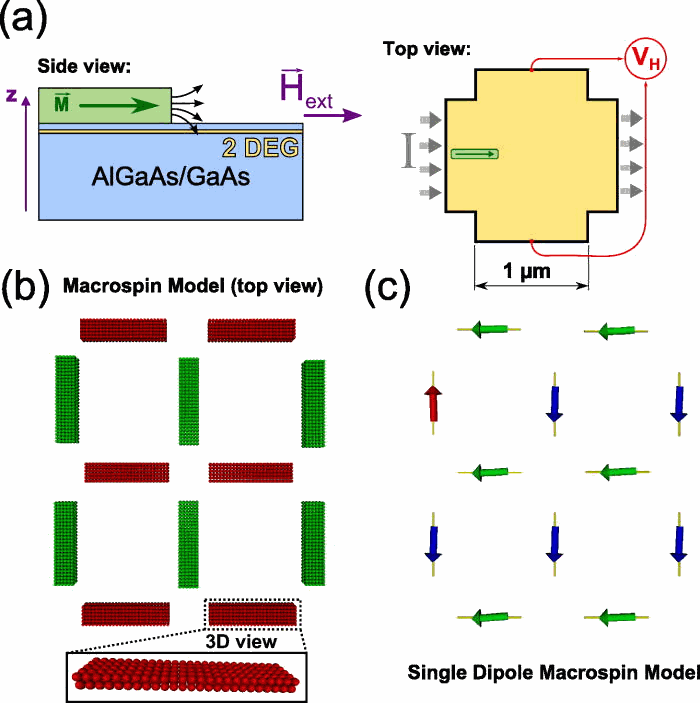
| The authors study the magnetization dynamics of a spin ice cluster which is a building block of an artificial square spin ice fabricated by focused electron-beam-induced deposition both experimentally and theoretically. The spin ice cluster is composed of twelve interacting Co nanoislands grown directly on top of a high-resolution micro-Hall sensor. By employing micromagnetic simulations and a macrospin model, we calculate the magnetization and the experimentally investigated stray field emanating from a single nanoisland. The parameters determined from a comparison with the experimental hysteresis loop are used to derive an effective single-dipole macrospin model that allows us to investigate the dynamics of the spin ice cluster. Our model reproduces the experimentally observed non-deterministic sequences in the magnetization curves as well as the distinct temperature dependence of the hysteresis loop. |
Merlin Pohlit, Irina Stockem, Fabrizio Porrati, Michael Huth, Christian Schröder and Jens Müller,
Experimental and theoretical investigation of the magnetization dynamics of an artificial square spin ice cluster,
J. Appl. Phys. 120, 142103 (2016)
Understanding Thermodynamic and Spectroscopic Properties of Tetragonal Mn12 Single-Molecule Magnets from Combined Density Functional Theory/Spin-Hamiltonian Calculations
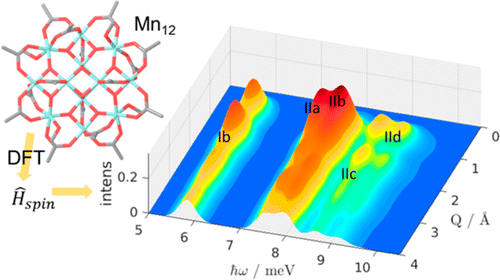
| The authors apply broken-symmetry density functional theory to determine isotropic exchange-coupling constants and local zero-field splitting (ZFS) tensors for the tetragonal Mn12tBuAc single-molecule magnet. The obtained parametrization of the many-spin Hamiltonian (MSH), taking into account all 12 spin centers, is assessed by comparing theoretical predictions for thermodynamic and spectroscopic properties with available experimental data. The magnetic susceptibility (calculated by the finite-temperature Lanczos method) is well approximated, and the intermultiplet excitation spectrum from inelastic neutron scattering (INS) experiments is correctly reproduced. In these respects, the present parametrization of the 12-spin model represents a significant improvement over previous theoretical estimates of exchange-coupling constants in Mn12, and additionally offers a refined interpretation of INS spectra. Treating anisotropic interactions at the third order of perturbation theory, the MSH is mapped onto the giant-spin Hamiltonian describing the S = 10 ground multiplet. Although the agreement with high-field EPR experiments is not perfect, the results clearly point in the right direction and for the first time rationalize the angular dependence of the transverse-field spectra from a fully microscopic viewpoint. Importantly, transverse anisotropy of the effective S = 10 manifold is explicitly shown to arise largely from the ZFS-induced mixing of exchange multiplets. This effect is given a thorough analysis in the approximate D2d spin-permutational symmetry group of the exchange Hamiltonian. |
Shadan Ghassemi Tabrizi, Alexei V. Arbuznikov, and Martin Kaupp,
Understanding Thermodynamic and Spectroscopic Properties of Tetragonal Mn12 Single-Molecule Magnets from Combined Density Functional Theory/Spin-Hamiltonian Calculations,
J. Phys. Chem. A, 2016, 120 (34), pp 6864-6879
Electron paramagnetic resonance of individual atoms on a surface
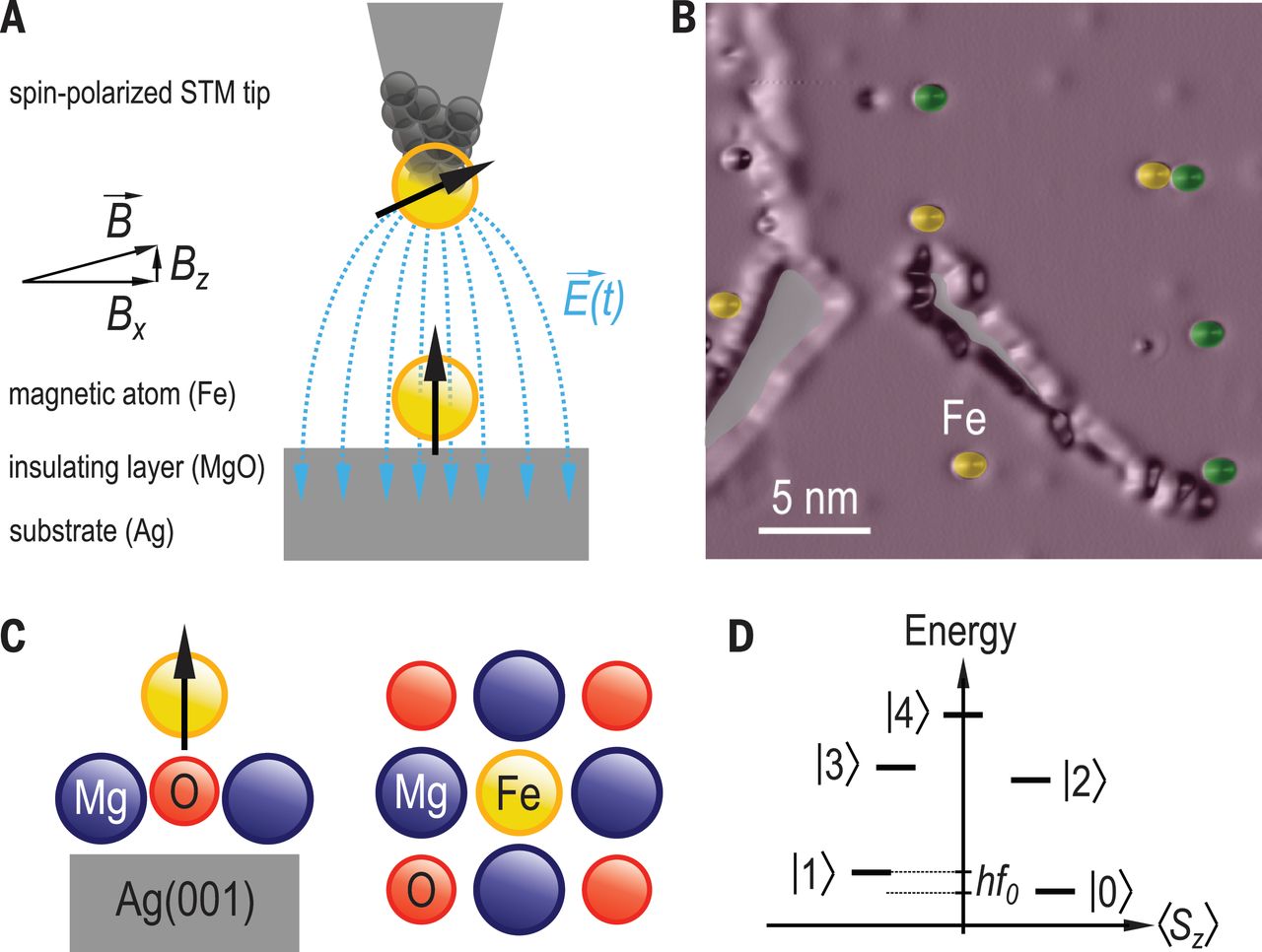
| Electron paramagnetic resonance (EPR) usually detects atoms with unpaired electrons as ensemble averages. The authors employed a spin-polarized scanning tunneling microscope tip to measure EPR spectra of single iron atoms adsorbed on a magnesium oxide surface at cryogenic temperatures. The high-energy resolution of conventional spin resonance was combined with scanning tunneling microscopy to measure electron paramagnetic resonance of individual iron (Fe) atoms placed on a magnesium oxide film. The spin resonance was driven with an oscillating electric field between tip and sample. The readout of the Fe atom's quantum state was performed by spin-polarized detection of the atomic-scale tunneling magnetoresistance. T1 and T2 times were determined. The spin resonance signals of different Fe atoms differ by much more than their resonance linewidth; in a traditional ensemble measurement, this difference would appear as inhomogeneous broadening. |
Susanne Baumann, William Paul, Taeyoung Choi,
Christopher P. Lutz, Arzhang Ardavan, Andreas J. Heinrich,
Electron paramagnetic resonance of individual atoms on a surface,
Science 23 Oct 2015, Vol. 350, Issue 6259, pp. 417-420
Quantum Einstein-de Haas effect
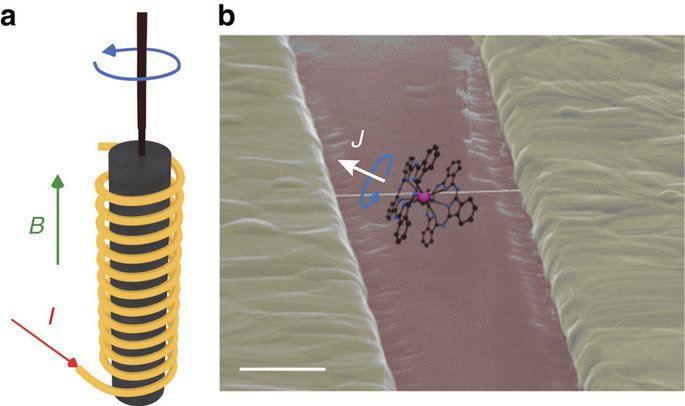
| The classical Einstein-de Haas experiment demonstrates that a change of magnetization in a macroscopic magnetic object results in a mechanical rotation of this magnet. This experiment can therefore be considered as a macroscopic manifestation of the conservation of total angular momentum and energy of electronic spins. Since the conservation of angular momentum is a consequence of a system's rotational invariance, it is valid for an ensemble of spins in a macroscopic ferromaget as well as for single spins. Here we propose an experimental realization of an Einstein-de Haas experiment at the single-spin level based on a single-molecule magnet coupled to a nanomechanical resonator. We demonstrate that the spin associated with the single-molecule magnet is then subject to conservation of total angular momentum and energy, which results in a total suppression of the molecule's quantum tunnelling of magnetization. |
Marc Ganzhorn, Svetlana Klyatskaya, Mario Ruben, Wolfgang
Wernsdorfer,
Quantum Einstein-de Haas effect,
Nature Communications 7, 11443 (2016)
The classical and quantum dynamics of molecular spins on graphene
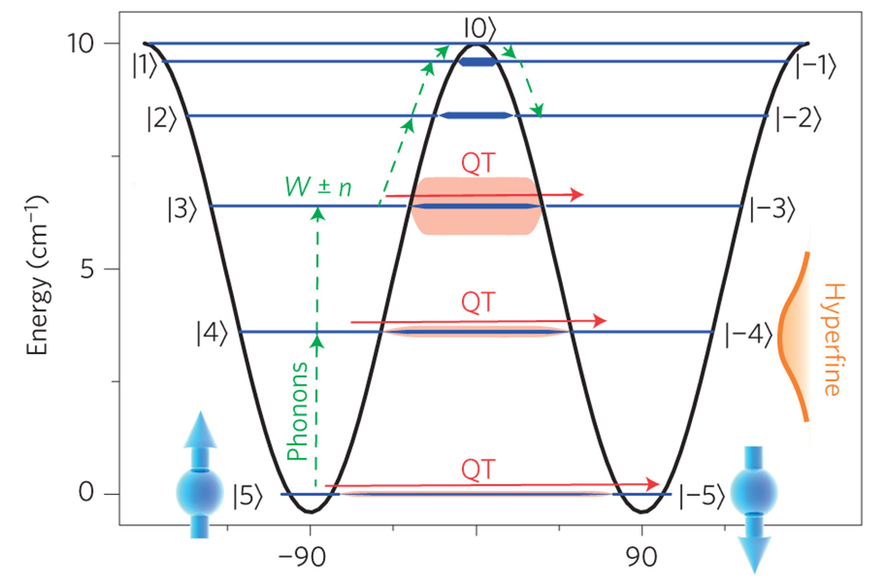
| Controlling the dynamics of spins on surfaces is pivotal to the design of spintronic and quantum computing devices. Proposed schemes involve the interaction of spins with graphene to enable surface-state spintronics and electrical spin manipulation. However, the influence of the graphene environment on the spin systems has yet to be unravelled. Here we explore the spin-graphene interaction by studying the classical and quantum dynamics of molecular magnets on graphene. Whereas the static spin response remains unaltered, the quantum spin dynamics and associated selection rules are profoundly modulated. The couplings to graphene phonons, to other spins, and to Dirac fermions are quantified using a newly developed model. Coupling to Dirac electrons introduces a dominant quantum relaxation channel that, by driving the spins over Villain's threshold, gives rise to fully coherent, resonant spin tunnelling. Our findings provide fundamental insight into the interaction between spins and graphene, establishing the basis for electrical spin manipulation in graphene nanodevices. |
Christian Cervetti, Angelo Rettori, Maria Gloria Pini,
Andrea Cornia, Ana Repolles, Fernando Luis, Martin Dressel,
Stephan Rauschenbach, Klaus Kern, Marko Burghard, Lapo
Bogani,
The classical and quantum dynamics of molecular spins on graphene,
Nature Materials 15, 164-168 (2016)
Making hybrid [n]-rotaxanes as supramolecular arrays of molecular electron spin qubits
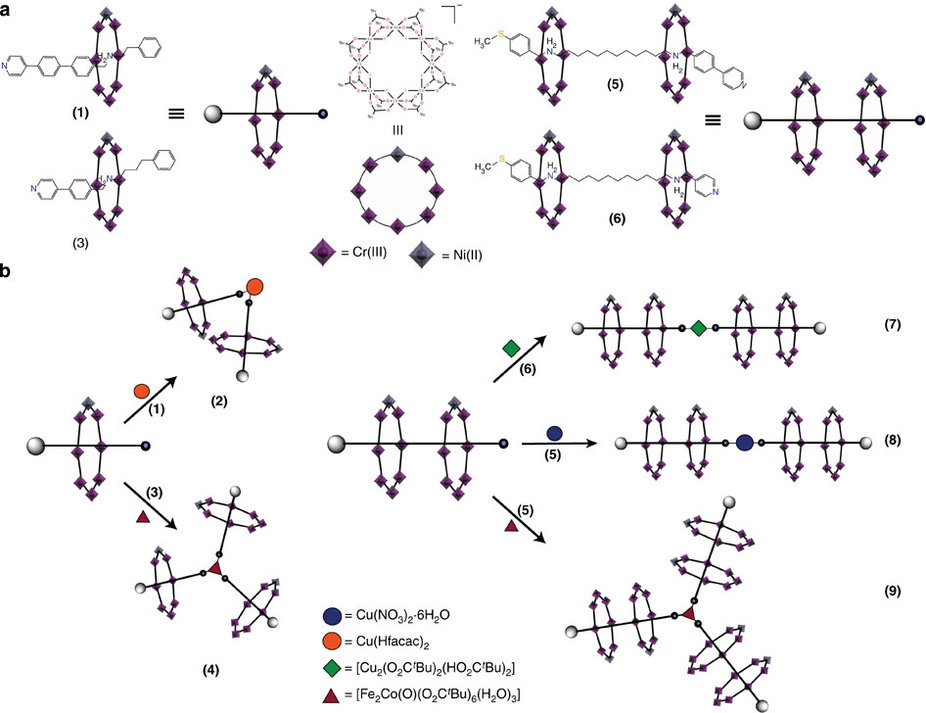
| Quantum information processing (QIP) would require that the individual units involved-qubits-communicate to other qubits while retaining their identity. In many ways this resembles the way supramolecular chemistry brings together individual molecules into interlocked structures, where the assembly has one identity but where the individual components are still recognizable. Here a fully modular supramolecular strategy has been to link hybrid organic-inorganic [2]- and [3]-rotaxanes into still larger [4]-, [5]- and [7]-rotaxanes. The ring components are heterometallic octanuclear Cr7Ni coordination cages and the thread components template the formation of the ring about the organic axle, and are further functionalized to act as a ligand, which leads to large supramolecular arrays of these heterometallic rings. As the rings have been proposed as qubits for QIP, the strategy provides a possible route towards scalable molecular electron spin devices for QIP. Double electron-electron resonance experiments demonstrate inter-qubit interactions suitable for mediating two-qubit quantum logic gates. |
Antonio Fernandez, Jesus Ferrando-Soria, Eufemio Moreno Pineda, Floriana Tuna, Inigo J. Vitorica-Yrezabal,
Christiane Knappke, Jakub Ujma, Christopher A. Muryn, Grigore A. Timco, Perdita E. Barran,
Arzhang Ardavan, Richard E.P. Winpenny,
Making hybrid [n]-rotaxanes as supramolecular
arrays of molecular electron spin qubits,
NATURE COMMUNICATIONS 7, 10240 (2016)
Studies on the Magnetic Ground State of a Spin Möbius Strip

| The authors report the synthesis, structure and detailed characterisation of three n-membered oxovanadium rings. Their alternating heterometallic vanadium/sodium cyclic core structures were sandwiched between two CD moieties such that O-Na-O groups separated the neighbouring vanadyl ions. Antiferromagnetic interactions between the S=1/2 vanadyl ions led to S=0 ground states for the even-membered rings, but to two quasi-degenerate S=1/2 states for the spin-frustrated heptanuclear cluster. This is one of the rather rare examples of odd membered antiferromagnetic spin rings. |
Graham N. Newton, Norihisa Hoshino, Takuto Matsumoto, Takuya Shiga,
Motohiro Nakano, Hiroyuki Nojiri, Wolfgang Wernsdorfer, Yuji Furukawa, and
Hiroki Oshio,
Studies on the Magnetic Ground State of a Spin Möbius Strip,
Chemistry - A European Journal 22 (2016) 14205
Dynamical effects on the magnetic properties of dithiazolyl bistable materials
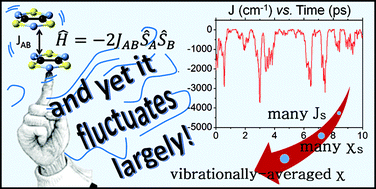
| The magnetic properties of molecule-based magnets are commonly rationalized by considering only a single nuclear configuration of the system under study (usually an X-ray crystal structure). Here, by means of a computational study, we compare the results obtained using such a static approach with those obtained by explicitly accounting for thermal fluctuations, and uncover the serious limitations of the static perspective when dealing with magnetic crystals whose radicals undergo wide-amplitude motions. As a proof of concept, these limitations are illustrated for the magnetically bistable 1,3,5-trithia-2,4,6-triazapentalenyl (TTTA) material. For its high-temperature phase at 300 K, we show that nuclear dynamics induce large fluctuations in the magnetic exchange interactions (J) between spins (up to 1000% of the average value). These deviations result in a about 20% difference between the 300 K magnetic susceptibility computed by explicitly considering the nuclear dynamics and that computed using the X-ray structure, the former being in better agreement with the experimental data. The unveiled strong coupling between J interactions and intermolecular vibrations reveals that considering J as a constant value at a given temperature (as always done in molecular magnetism) leads to a flawed description of the magnetism of TTTA. Instead, the physically relevant concept in this case is the statistical distribution of J values. |
Sergi Vela, Merce Deumal, Motoyuki Shiga, Juan J. Novoa, Jordi Ribas-Arino,
Dynamical effects on the magnetic properties of dithiazolyl bistable materials,
Chem. Sci., 2015, 6, 2371-2381
Enhancing coherence in molecular spin qubits via atomic clock transitions
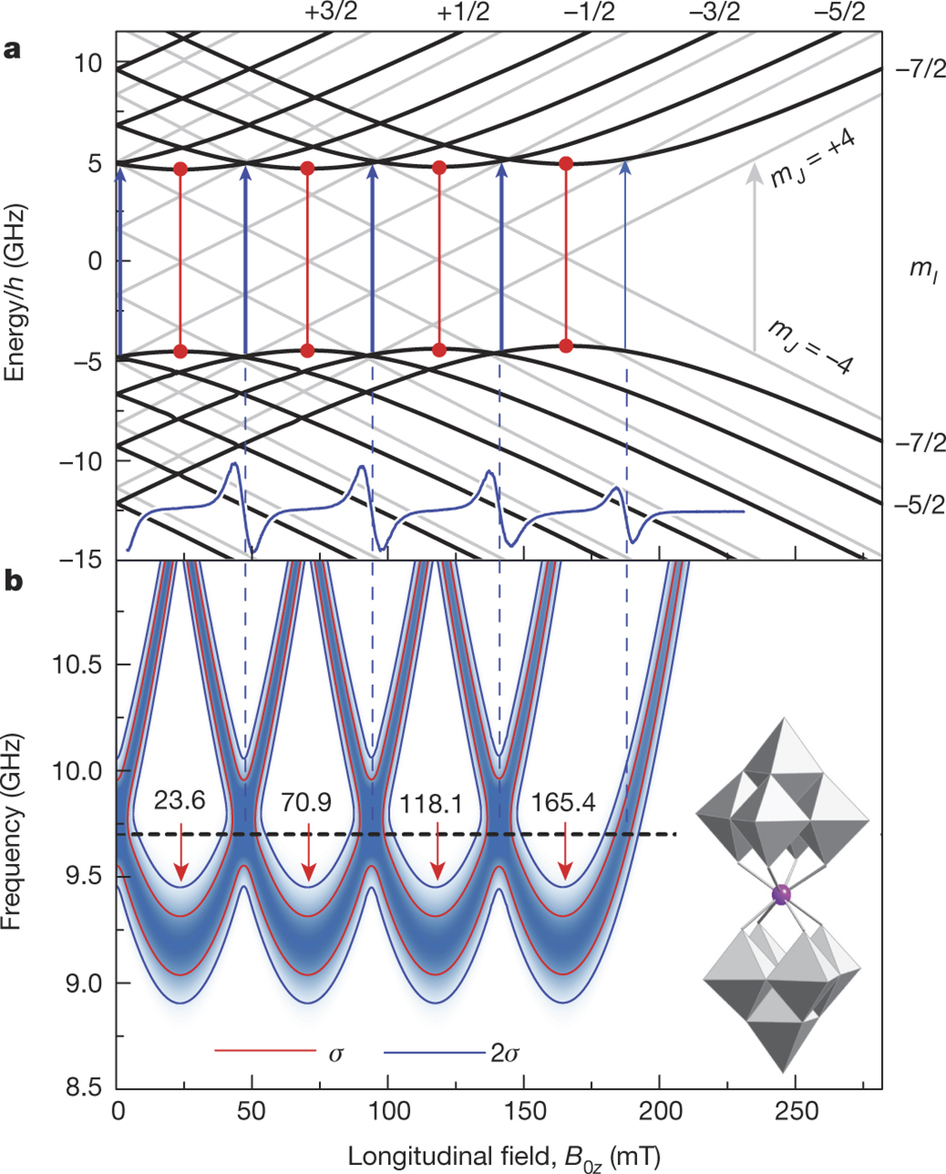
| Quantum computing is an emerging area within the information sciences revolving around the concept of quantum bits (qubits). A major obstacle is the extreme fragility of these qubits due to interactions with their environment that destroy their quantumness. This phenomenon, known as decoherence, is of fundamental interest. When dealing with spin qubits, the strongest source of decoherence is the magnetic dipolar interaction. In This publication the authors present a way of enhancing coherence in solid-state molecular spin qubits without resorting to extreme dilution. It is based on the design of molecular structures with crystal field ground states possessing large tunnelling gaps that give rise to optimal operating points, or atomic clock transitions, at which the quantum spin dynamics become protected against dipolar decoherence. This approach is illustrated with a holmium molecular nanomagnet in which long coherence times (up to 8.4 microseconds at 5 kelvin) are obtained at unusually high concentrations. |
Muhandis Shiddiq, Dorsa Komijani, Yan Duan, Alejandro
Gaita-Arino, Eugenio Coronado, Stephen Hill,
Enhancing coherence in molecular spin qubits via atomic clock transitions,
Nature 531, 348-351 (2016)
A Mixed-Ligand Approach for a Gigantic and Hollow Heterometallic Cage {Ni64RE96} for Gas Separation and Magnetic Cooling Applications
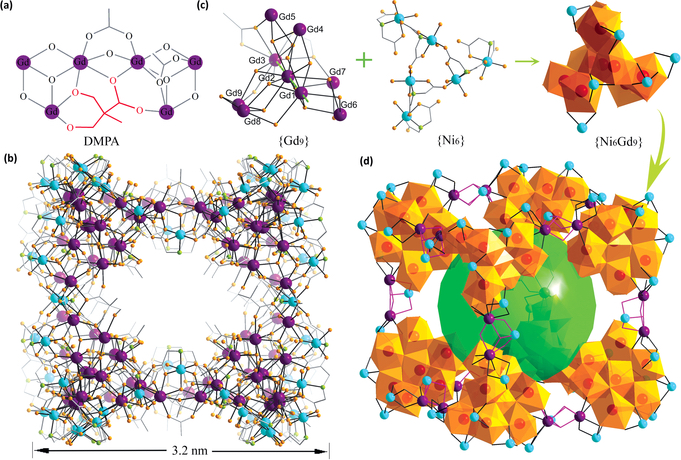
| Nanosized aggregations of metal ions shielded by organic ligands possessing both exquisite structural aesthetics and intriguing properties are fundamentally interesting. Three isostructural gigantic transition-metal-rare-earth heterometallic coordination cages are reported, abbreviated as {Ni64RE96} (RE=Gd, Dy, and Y) and obtained by a mixed-ligand approach, each possessing a cuboidal framework made of 160 metal ions and a nanosized spherical cavity in the center. Along with the structural novelty, these hollow cages show highly selective adsorptions for CO2 over CH4 or N2 at ambient temperatures. Moreover, the gadolinium analogue exhibits large magnetocaloric effect at ultralow temperatures. |
Wei-Peng Chen,
Pei-Qin Liao,
Youzhu Yu,
Zhiping Zheng,
Xiao-Ming Chen,
Yan-Zhen Zheng
A Mixed-Ligand Approach for a Gigantic and Hollow Heterometallic Cage {Ni64RE96} for Gas Separation and Magnetic Cooling Applications,
Angew. Chem. Int. Ed. 2016, 55, 9375-9379
Modelling spin Hamiltonian parameters of molecular nanomagnets
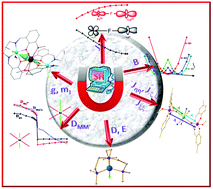
| Molecular nanomagnets encompass a wide range of coordination complexes possessing several potential applications. A formidable challenge in realizing these potential applications lies in controlling the magnetic properties of these clusters. Microscopic spin Hamiltonian (SH) parameters describe the magnetic properties of these clusters, and viable ways to control these SH parameters are highly desirable. Computational tools play a proactive role in this area, where SH parameters such as isotropic exchange interaction (J), anisotropic exchange interaction (Jx, Jy, Jz), double exchange interaction (B), zero-field splitting parameters (D, E) and g-tensors can be computed reliably using X-ray structures. In this feature article the authors have attempted to provide a holistic view of the modelling of these SH parameters of molecular magnets. The determination of J includes various class of molecules, from di- and polynuclear Mn complexes to the {3d-Gd}, {Gd-Gd} and {Gd-2p} class of complexes. The estimation of anisotropic exchange coupling includes the exchange between an isotropic metal ion and an orbitally degenerate 3d/4d/5d metal ion. The double-exchange section contains some illustrative examples of mixed valance systems, and the section on the estimation of zfs parameters covers some mononuclear transition metal complexes possessing very large axial zfs parameters. The section on the computation of g-anisotropy exclusively covers studies on mononuclear DyIII and ErIII single-ion magnets. The examples depicted in this article clearly illustrate that computational tools not only aid in interpreting and rationalizing the observed magnetic properties but possess the potential to predict new generation MNMs. |
Tulika Gupta, Gopalan Rajaraman,
Modelling spin Hamiltonian parameters of molecular nanomagnets,
Chem. Commun., 2016, 52, 8972-9008
A modular design of molecular qubits to implement universal quantum gates
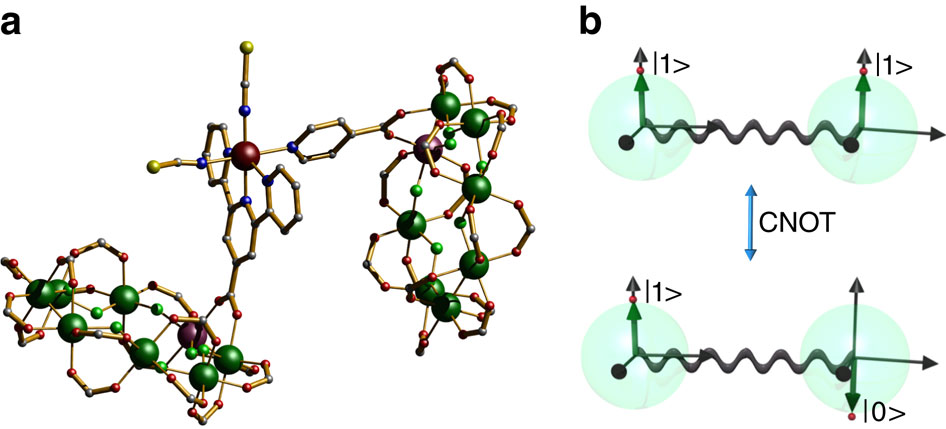
| The physical implementation of quantum information processing relies on individual modules - qubits - and operations that modify such modules either individually or in groups, i.e. quantum gates. Two examples of gates that entangle pairs of qubits are the controlled NOT-gate (CNOT) gate, which flips the state of one qubit depending on the state of another, and the SQRT(iSWAP) gate that brings a two-qubit product state into a superposition involving partially swapping the qubit states. Here we show that through supramolecular chemistry a single simple module, molecular {Cr7Ni} rings, which act as the qubits, can be assembled into structures suitable for either the CNOT or SQRT(iSWAP) gate by choice of linker, and we characterize these structures by electron spin resonance spectroscopy. We introduce two schemes for implementing such gates with these supramolecular assemblies and perform detailed simulations, based on the measured parameters including decoherence, to demonstrate how the gates would operate. |
Jesus Ferrando-Soria, Eufemio Moreno Pineda, Alessandro Chiesa, Antonio Fernandez, Samantha A. Magee, Stefano Carretta, Paolo Santini, Inigo J. Vitorica-Yrezabal, Floriana Tuna, Grigore A. Timco, Eric J.L. McInnes & Richard E.P. Winpenny,
A modular design of molecular qubits to implement
universal quantum gates,
NATURE COMMUNICATIONS | 7:11377 (2016)
see also:
Alessandro Chiesa, George F. S. Whitehead, Stefano Carretta, Laura Carthy, Grigore A. Timco, Simon J. Teat, Giuseppe Amoretti, Eva Pavarini, Richard E. P. Winpenny, Paolo Santini, Molecular nanomagnets with switchable coupling for quantum simulation, SCIENTIFIC REPORTS | 4:7423 (2014)
D5h makes the difference
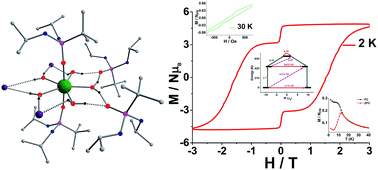
|
Two more SIMs with record energy barrier and
record magnetic hysteresis temperature have been reported
recently.
Air-stable Dy(III) and Er(III) single-ion magnets (SIMs) with pseudo-D5h symmetry, where the Dy(III)-SIM exhibits a magnetization blocking (TB) up to 12 K, defined from the maxima of the zero-field cooled magnetization curve, with an anisotropy barrier (Ueff) as high as 735.4 K have been reported. The Dy(III)-SIM exhibits a magnetic hysteresis up to 12 K (30 K) with a large coercivity of ~0.9 T (~1.5 T) at a sweep rate of ~0.0018 T/s (0.02 T/s). These high values combined with persistent stability under ambient conditions, render this system as one of the best-characterized SIMs. Ab initio calculations have been used to establish the connection between the higher-order symmetry of the molecule and the quenching of quantum tunnelling of magnetization (QTM) effects. The relaxation of magnetization is observed via the second excited Kramers doublet owing to pseudo-high-order symmetry, which quenches the QTM. This study highlights fine-tuning of symmetry around the lanthanide ion to obtain new-generation SIMs and offers further scope for pushing the limits of Ueff and TB using this approach. |
Sandeep K. Gupta, Thayalan Rajeshkumar, Gopalan Rajaraman, Ramaswamy Murugavel,
An air-stable Dy(III) single-ion magnet with high anisotropy barrier and blocking temperature,
Chem. Sci., 2016, Advance Article
Sandeep K. Gupta, Thayalan Rajeshkumar, Gopalan Rajaraman, Ramaswamy Murugavel, An unprecedented zero field neodymium(III) single-ion magnet based on a phosphonic diamide, Chem. Commun., 2016,52, 7168-7171
Symmetry-Supported Magnetic Blocking at 20 K in Pentagonal Bipyramidal Dy(III) Single-Ion Magnets
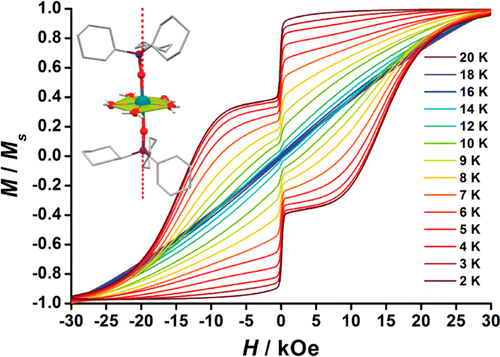
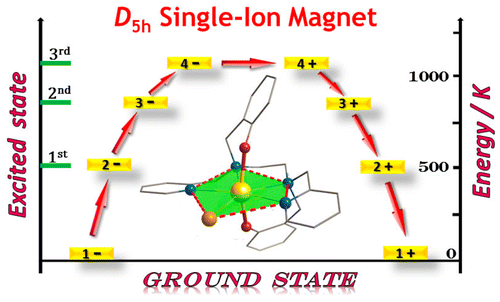
|
Two SIMs with record energy barrier and
record magnetic hysteresis temperature up to 20 K, respectively,
in two pentagonal bipyramidal Dy(III) SIMs have been reported
recently.
Single-molecule magnets (SMMs) that can be trapped in one of the bistable magnetic states separated by an energy barrier are among the most promising candidates for high-density information storage, quantum processing, and spintronics. To date, a considerable series of achievements have been made. However, the presence of fast quantum tunnelling of magnetization (QTM) in most SMMs, especially in single-ion magnets (SIMs), provides a rapid relaxation route and often sets up a limit for the relaxation time. Here, we pursue the pentagonal bipyramidal symmetry to suppress the QTM. Magnetic characterizations reveal fascinating SMM properties with high energy barriers along with a record magnetic hysteresis temperature up to 20 K. These results, combined with the ab initio calculations, offer an illuminating insight into the vast possibility and potential of what the symmetry rules can achieve in molecular magnetism. |
Yan-Cong Chen, Jun-Liang Liu, Liviu Ungur, Jiang Liu,
Quan-Wen Li, Long-Fei Wang, Zhao-Ping Ni, Liviu
F. Chibotaru, Xiao-Ming Chen, and Ming-Liang Tong,
Symmetry-Supported Magnetic Blocking at 20 K in Pentagonal Bipyramidal Dy(III) Single-Ion Magnets,
J. Am. Chem. Soc., 2016, 138 (8), pp 2829-2837
Jiang Liu, Yan-Cong Chen, Jun-Liang Liu, Veacheslav Vieru, Liviu Ungur, Jian-Hua Jia, Liviu F. Chibotaru, Yanhua Lan, Wolfgang Wernsdorfer, Song Gao, Xiao-Ming Chen, and Ming-Liang Tong, A Stable Pentagonal Bipyramidal Dy(III) Single-Ion Magnet with a Record Magnetization Reversal Barrier over 1000 K, J. Am. Chem. Soc., 2016, 138 (16), pp 5441-5450
Giant Hysteresis of Single-Molecule Magnets Adsorbed on a Nonmagnetic Insulator
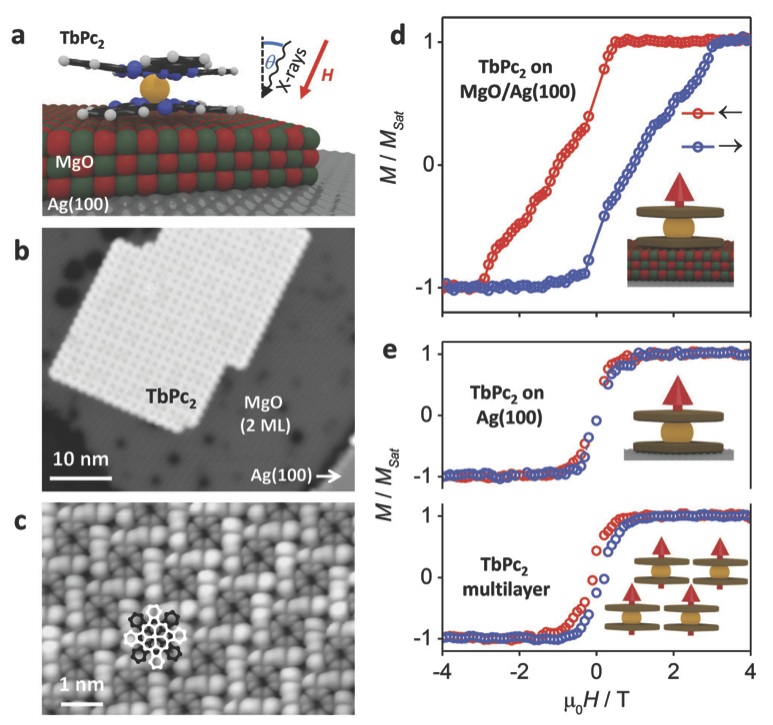
| It is demonstrated that TbPc2 single-molecule magnets adsorbed on a magnesium oxide tunnel barrier exhibit record magnetic remanence, record hysteresis opening, perfect out-of-plane alignment of the magnetic easy axes, and self-assembly into a well-ordered layer. |
Christian Wäckerlin, Fabio Donati, Aparajita Singha, Romana Baltic, Stefano Rusponi, Katharina Diller, Francois Patthey, Marina Pivetta, Yanhua Lan, Svetlana Klyatskaya, Mario Ruben, Harald Brune, Jan Dreiser, Giant Hysteresis of Single-Molecule Magnets Adsorbed on a Nonmagnetic Insulator, Adv. Mater. 28 (2016) 5195-5199
Deciphering the origin of giant magnetic anisotropy and fast quantum tunnelling in Rhenium(IV) single-molecule magnets
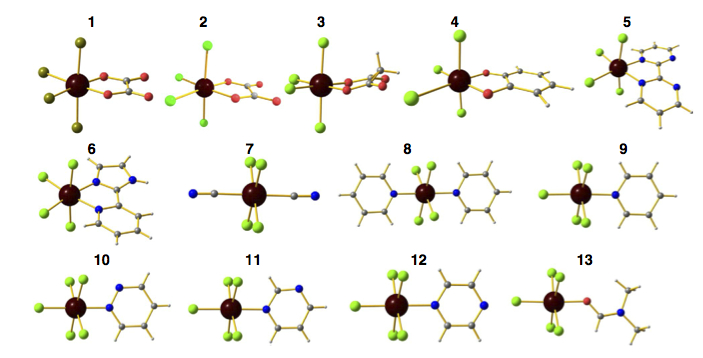
| Single-molecule magnets represent a promising route to achieve potential applications such as high-density information storage and spintronics devices. Among others, 4d/5d elements such as Re(IV) ion are found to exhibit very large magnetic anisotropy, and inclusion of this ion-aggregated clusters yields several attractive molecular magnets. Here, using ab intio calculations, the authors unravel the source of giant magnetic anisotropy associated with the Re(IV) ions by studying a series of mononuclear Re(IV) six coordinate complexes. The low-lying doublet states are found to be responsible for large magnetic anisotropy and the sign of the axial zero-field splitting parameter (D) can be categorically predicted based on the position of the ligand coordination. Large transverse anisotropy along with large hyperfine interactions opens up multiple relaxation channels leading to a fast quantum tunnelling of the magneti- zation (QTM) process. Enhancing the Re-ligand covalency is found to significantly quench the QTM process. |
Saurabh Kumar Singh, Gopalan Rajaraman, Deciphering the origin of giant magnetic anisotropy and fast quantum tunnelling in Rhenium(IV) single-molecule magnets, NATURE COMMUNICATIONS 7, 10669 (2016)
Rotating Magnetocaloric Effect in an Anisotropic Molecular Dimer
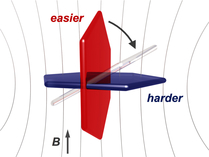
| In contrast to the mainstream research on molecular refrigerants that seeks magnetically isotropic molecules, we show that the magnetic anisotropy of dysprosium acetate tetrahydrate, can be efficiently used for cooling below liquid-helium temperature. This is attained by rotating aligned single-crystal samples in a constant applied magnetic field. The envisioned advantages are fast cooling cycles and potentially compact refrigerators. |
Dr. Giulia Lorusso, Dr. Olivier Roubeau, Dr. Marco Evangelisti Rotating Magnetocaloric Effect in an Anisotropic Molecular Dimer, Angew. Chem. Int. Ed. 55 (2016) 3360-3363
Theoretical Modeling of the Magnetic Behavior of Thiacalix[4]arene Tetranuclear MnII2GdIII2 and CoII2EuIII2 Complexes
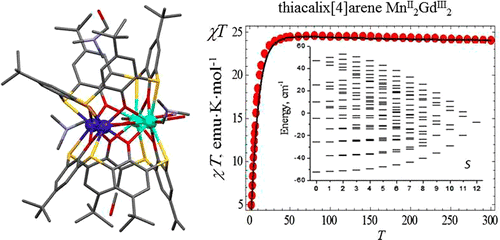
| In view of a wide perspective of 3d-4f complexes in single-molecule magnetism, here we propose an explanation of the magnetic behavior of the two thiacalix[4]arene tetranuclear heterometallic complexes MnII2GdIII2 and CoII2EuIII2. The energy pattern of the MnII2GdIII2 complex evaluated in the framework of the isotropic exchange model exhibits a rotational band of the low-lying spin excitations within which the Lande intervals are affected by the biquadratic spin-spin interactions. The nonmonotonic temperature dependence of the Chi*T product observed for the MnII2GdIII2 complex is attributed to the competitive influence of the ferromagnetic Mn-Gd and antiferromagnetic Mn-Mn exchange interactions, the latter being stronger. The model for the CoII2EuIII2 complex includes uniaxial anisotropy of the seven-coordinate Co ions and an isotropic exchange interaction in the Co pair, while the Eu ions are diamagnetic in their ground states. Best-fit analysis of Chi*T versus T showed that the anisotropic contribution (arising from a large zero-field splitting in Co ions) dominates (weak-exchange limit) in the CoII2EuIII2. This complex is concluded to exhibit an easy plane of magnetization (arising from the Co pair). It is shown that the low-lying part of the spectrum can be described by a highly anisotropic effective spin-1/2 Hamiltonian that is deduced for the CoII2 pair in the weak-exchange limit. |
Sergey M. Aldoshin, Nataliya A. Sanina, Andrew V. Palii, Boris S. Tsukerblat, Theoretical Modeling of the Magnetic Behavior of Thiacalix[4]arene Tetranuclear MnII2GdIII2 and CoII2EuIII2 Complexes, Inorg. Chem. (2016) Article ASAP
Molecular Nanomagnets and Related Phenomena
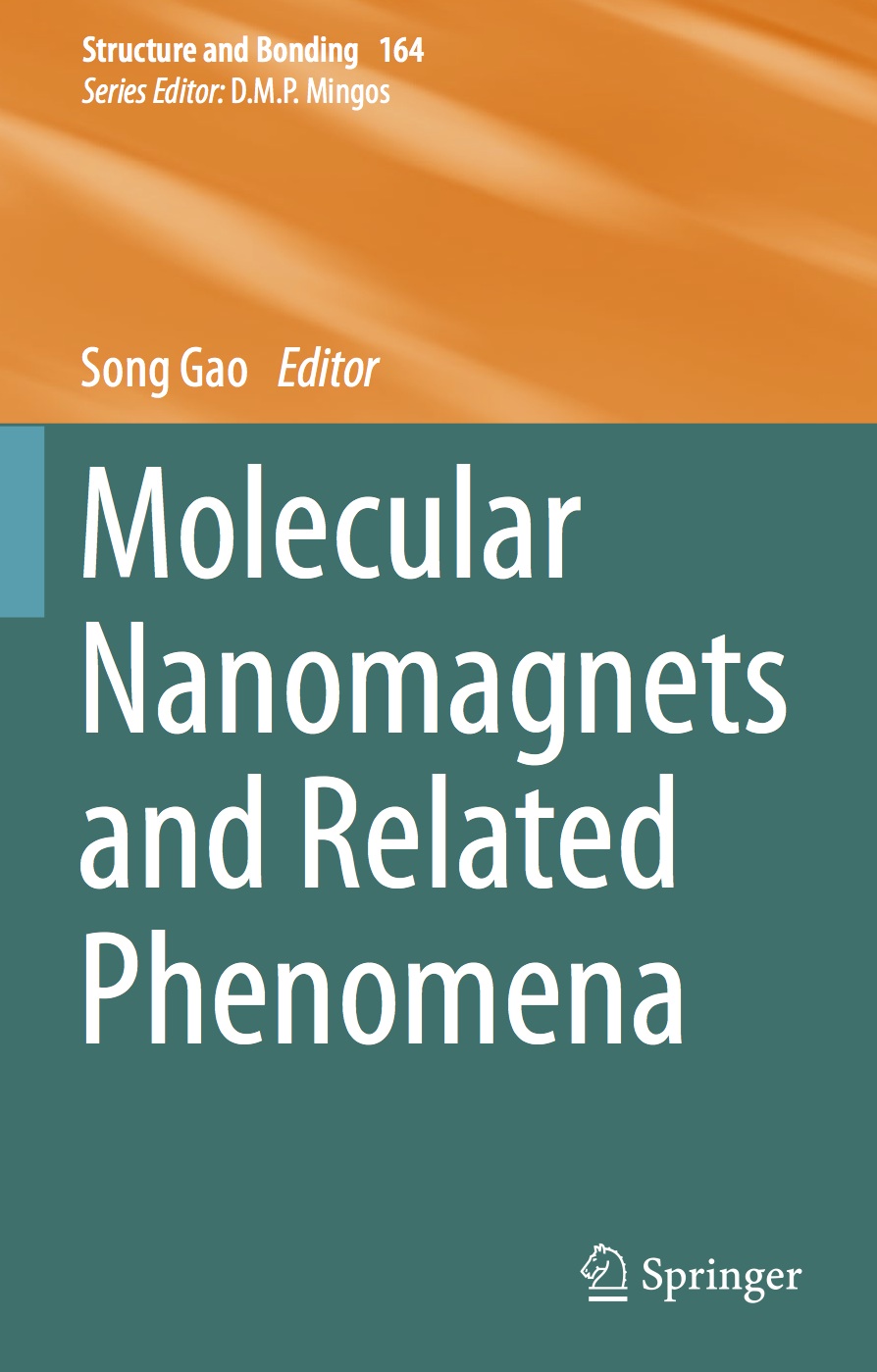
| With contributions by M. Affronte, M.L. Baker, S.J. Blundell, L. Bogani, L.F. Chibotaru, R. Clerac, A. Cornia, C. Coulon, N. Domingo, M. Evangelisti, S. Gao, A. Ghirri, S. Hill, S.-D. Jiang, F. Luis, M. Mannini, C.J. Milios, V. Pianet, F. Troiani, M. Urdampilleta, R.E.P. Winpenny, B.-W. Wang, |
Song Gao (Ed.), Molecular Nanomagnets and Related Phenomena, Structure and Bonding 164 (2015)
New single-ion magnets
| | Single-molecule magnets display magnetic bistability of molecular origin, which may one day be exploited in magnetic data storage devices. Recently it was realised that increasing the magnetic moment of polynuclear molecules does not automatically lead to a substantial increase in magnetic bistability. Attention has thus increasingly focussed on ions with large magnetic anisotropies. In spite of large effective energy barriers towards relaxation of the magnetic moment, this has so far not led to a big increase in magnetic bistability. Here we present a comprehensive study of a mononuclear, tetrahedrally coordinated cobalt(II) single-molecule magnet, which has a very high effective energy barrier and displays pronounced magnetic bistability. The combined experimental-theoretical approach enables an in-depth understanding of the origin of these favourable properties, which are shown to arise from a strong ligand field in combination with axial distortion. Our findings allow formulation of clear design principles for improved materials. |
Yvonne Rechkemmer, Frauke D. Breitgoff, Margarethe van der Meer, Mihail Atanasov, Michael Hakl, Milan Orlita, Petr Neugebauer, Frank Neese, Biprajit Sarkar, Joris van Slageren A four-coordinate cobalt(II) single-ion magnet with coercivity and a very high energy barrier, Nature Communications 7, 10467 (2016)
More on single-ion magnets:
Yvonne Rechkemmer, Julia E. Fischer, Raphael Marx, MariÌa DoÌrfel,
Petr Neugebauer, Sebastian Horvath, Maren Gysler, Theis
Brock-Nannestad, Wolfgang Frey, Michael F. Reid, Joris van Slageren,
Comprehensive Spectroscopic Determination of the Crystal Field Splitting in an Erbium Single-Ion Magnet,
JACS 137, 13114 (2015)
Supramolecular aggregates of single-molecule magnets: exchange-biased quantum tunneling of magnetization in a rectangular [Mn3]4 tetramer
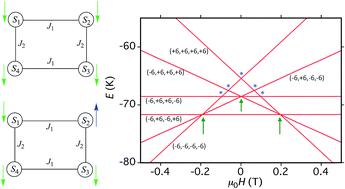
| The syntheses and properties of four magnetically-supramolecular oligomers of triangular Mn3 units are reported. Magnetization vs. dc field sweeps on a single crystal of the tetrameric [Mn12O4(O2CR)12(pdpd)6](ClO4)4 (R = Me) gave hysteresis loops below 1 K that exhibit exchange-biased quantum tunneling of magnetization (QTM) steps with a bias field of 0.19 T. Simulation of the loops determined that each Mn3 unit is exchange-coupled to the two neighbors. The work demonstrates a rational approach to synthesizing magnetically-supramolecular aggregates of SMMs as potential multi-qubit systems for quantum computing. |
Tu N. Nguyen, Wolfgang Wernsdorfer, Muhandis Shiddiq, Khalil A. Abboud, Stephen Hill, George Christou, Supramolecular aggregates of single-molecule magnets: exchange-biased quantum tunneling of magnetization in a rectangular [Mn3]4 tetramer, Chem. Sci. 7, 1156 (2016)
Thematic Issue: Phase Transition and Dynamical Properties of Spin Transition Materials
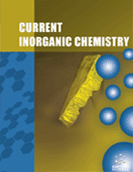
|
Great attention in the area of spin transition materials has been paid to the investigation of their
various phase transitions and dynamical properties which can be modulated by external parameters,
including temperature, pressure, photo-irradiation, or presence
of guest molecules.
The topics collected in the issue are focused on the four types
of spin transition materials: (1) Fe(II)-based spin crossover
compounds, (2) Dithiooxalato-bridged Fe-based charge transfer
systems, (3) Charge transfer active Prussian Blue Analogues, and
(4) Copper(II)-octacyanidomolybdate(IV) photomagnetic
materials.
The download of this thematic issue is free of charge. |
Norimichi Kojima, Shin-ichi Ohkoshi and Seiji Miyashita (Eds.), Thematic Issue: Phase Transition and Dynamical Properties of Spin Transition Materials, Current Inorganic Chemistry, vol. 6, issue 1 (2016)
Millisecond Coherence Time in a Tunable Molecular Electronic Spin Qubit
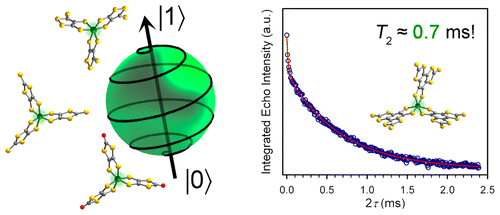
| Millisecond coherence time for a coordination complex qubit was observed, surpassing the previous record for such a system by an order of magnitude. The results illuminate a path forward in synthetic design principles, which should unite CS2 solubility with nuclear spin free ligand fields to develop a new generation of molecular qubits. |
Joseph M. Zadrozny, Jens Niklas, Oleg G. Poluektov, and Danna E. Freedman, Millisecond Coherence Time in a Tunable Molecular Electronic Spin Qubit, ACS Cent. Sci. 1, 488-492 (2015)
Ring, Ring
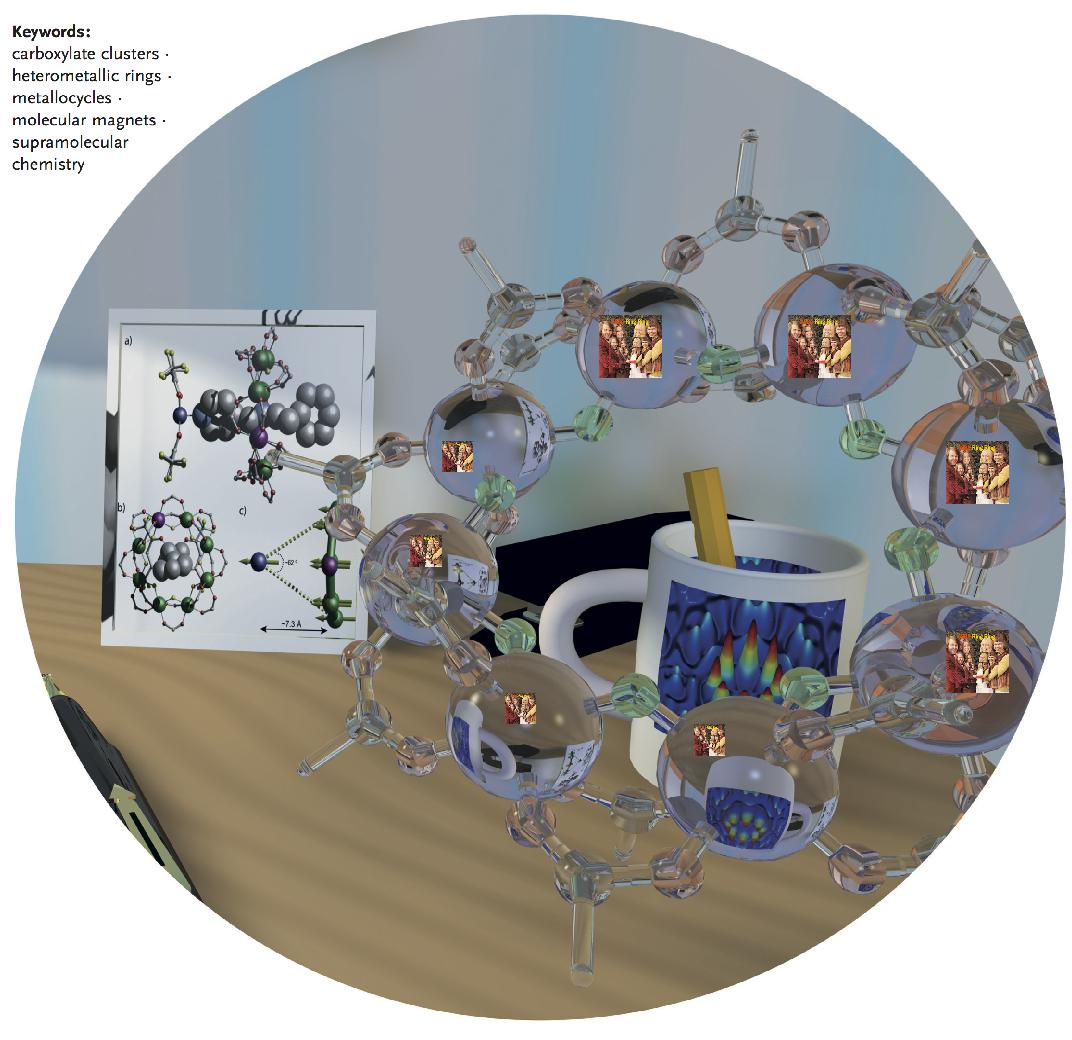
|
Long before molecular magnetism started, the advent of magnetic
molecular rings was announce in a prophetic publication (Björn
Benny & Agnetha Frida, Ring, Ring, Polar Music, 1973).
In the early days only even-membered rings could be synthesized,
odd rings were covered by strange theoretical prophecies (JMMM
220 (2000) 227; Phys. Rev. B 68 (2003) 054422). Ring, ring, why don't you give me a call? Ring, ring, the happiest sound of them all Ring, ring, I stare at the phone on the wall And I sit all alone impatiently Won't you please understand the need in me So, ring, ring, why don't you make an odd ring? 2016: here we go - an odd homometallic chromium ring is reported, which is the first regular Cr9 antiferromagnetic ring. Its electronic relaxation dynamics was probed by 1H-NMR, which allows to determine the spin-phonon coupling strength. At very low temperatures, the relaxation is characterized by a single dominating Arrhenius-type relaxation process, whereas several relevant processes emerge at higher temperatures. |
E. Garlatti, S. Bordignon, S. Carretta, G. Allodi, G. Amoretti, R. De Renzi, A. Lascialfari, Y. Furukawa, G. A. Timco, R. Woolfson, R. E. P. Winpenny, and P. Santini, Relaxation dynamics in the frustrated Cr9 antiferromagnetic ring probed by NMR, Phys. Rev. B 93, 024424 (2016)
More stories on rings (Tell me, are we really through?):
McInnes, E. J. L., Timco, G. A., Whitehead, G. F. S. and
Winpenny, R. E. P.
Heterometallic Rings: Their Physics and use as Supramolecular Building Blocks,
Angew. Chem. Int. Ed., 54, 14244-14269 (2015)
Alternative interpretation (R.W.: The ring was made by Alberich?!):